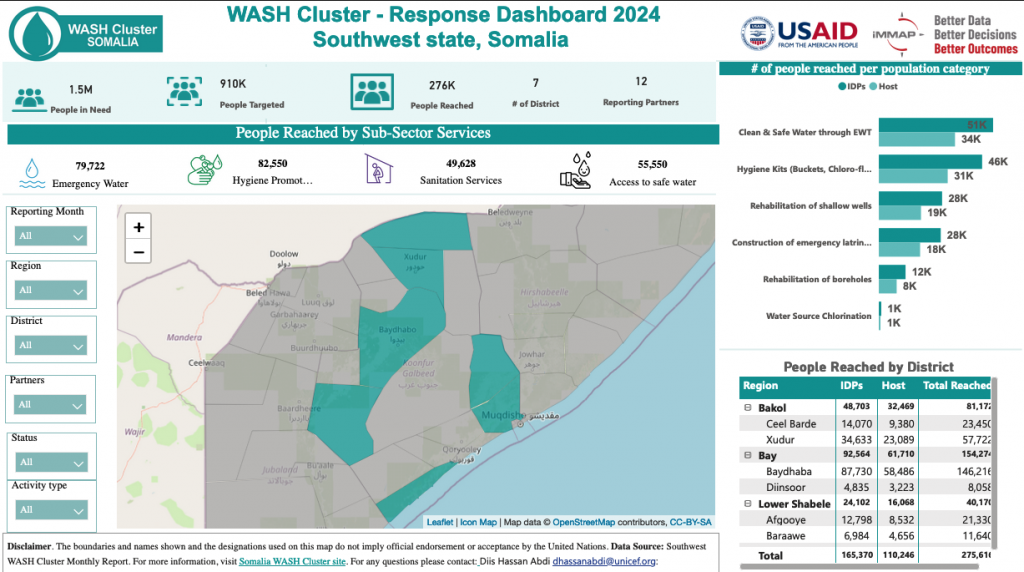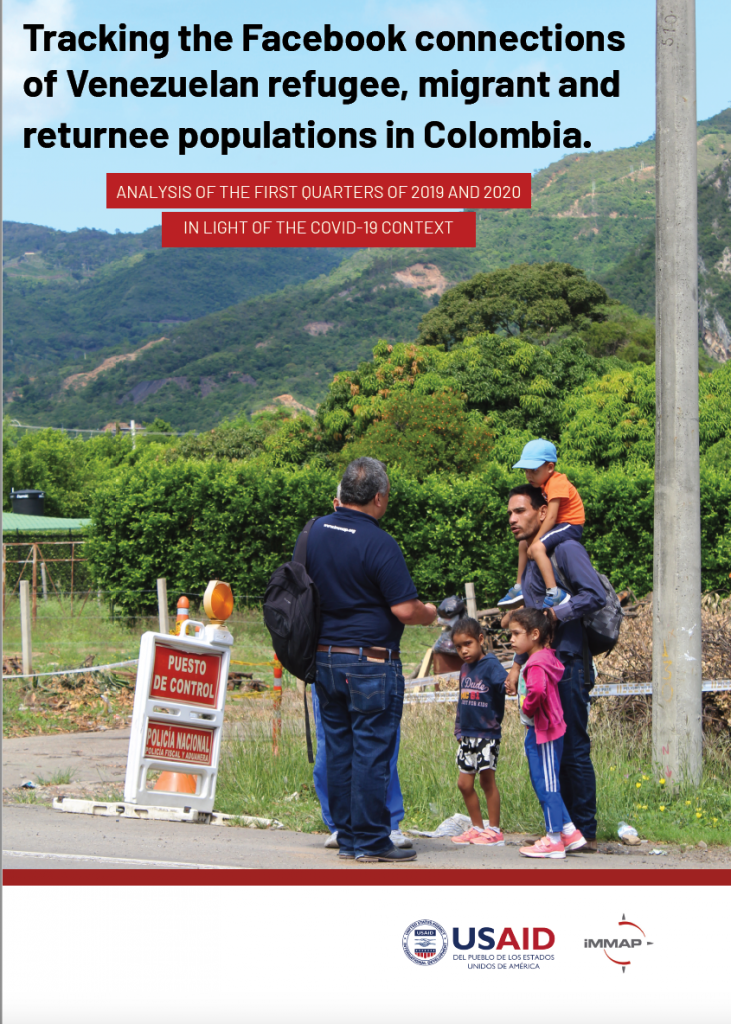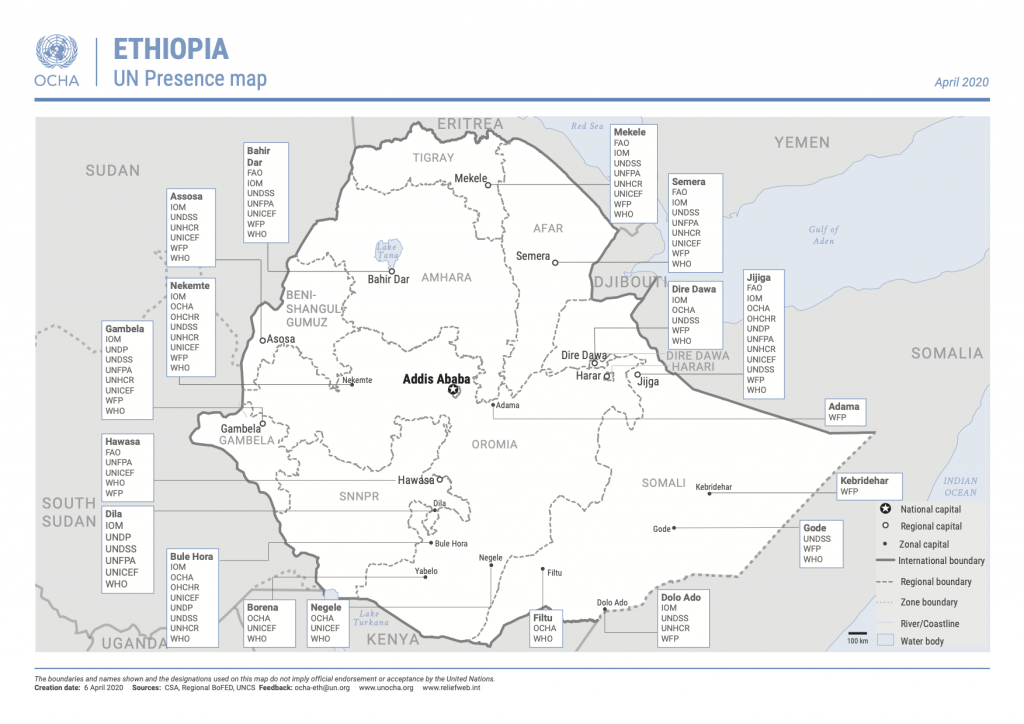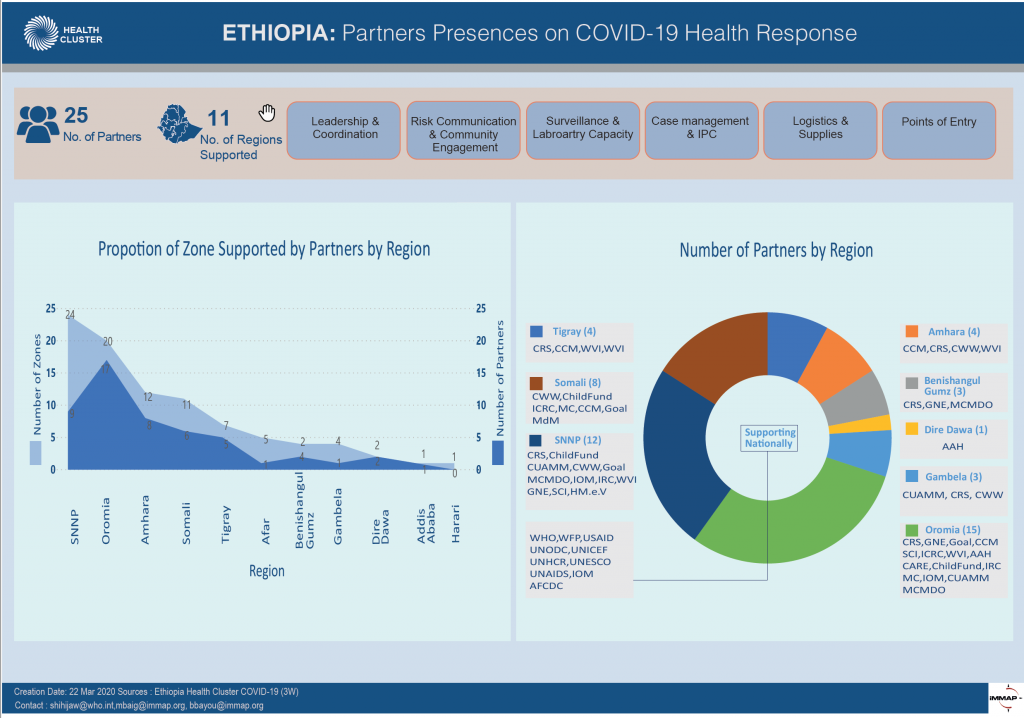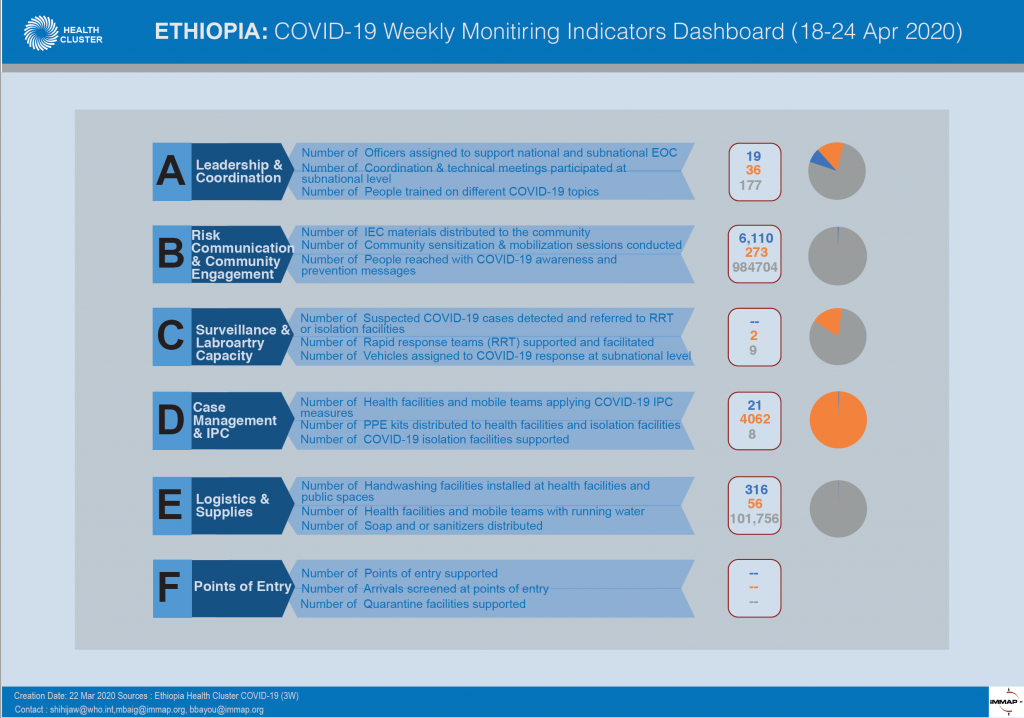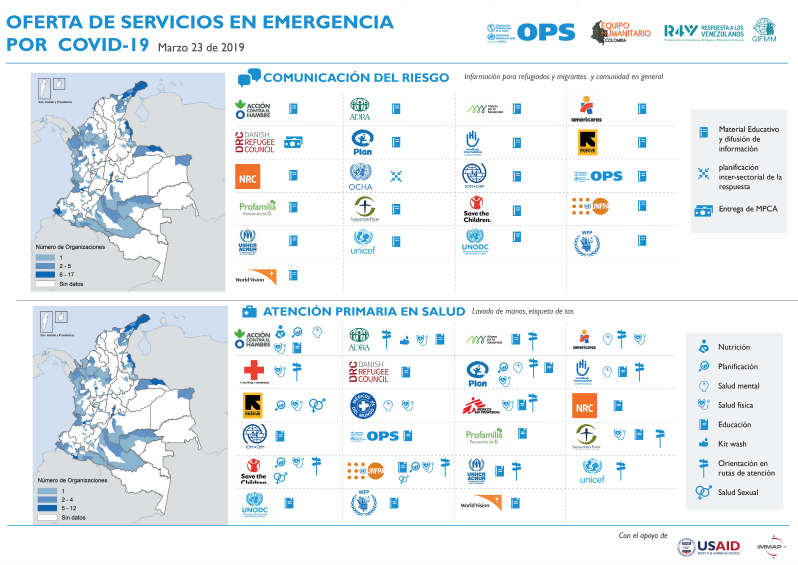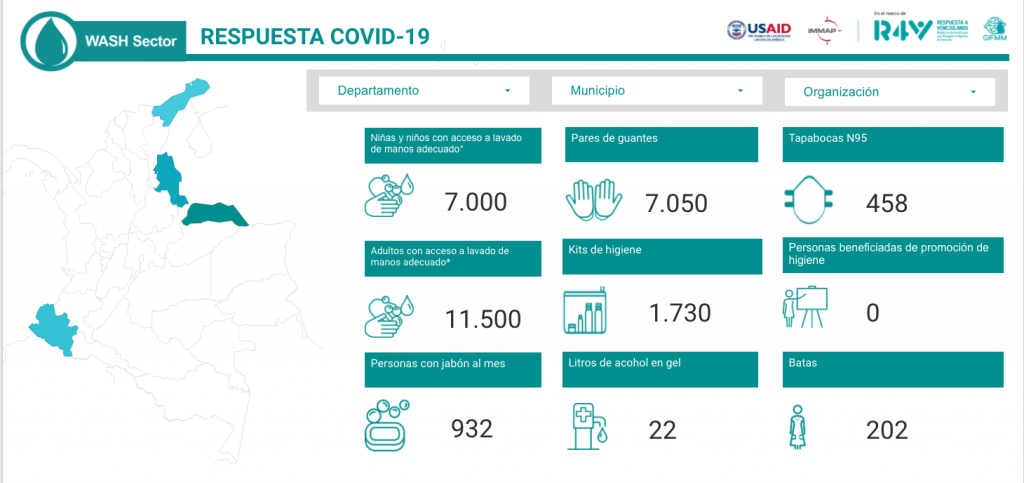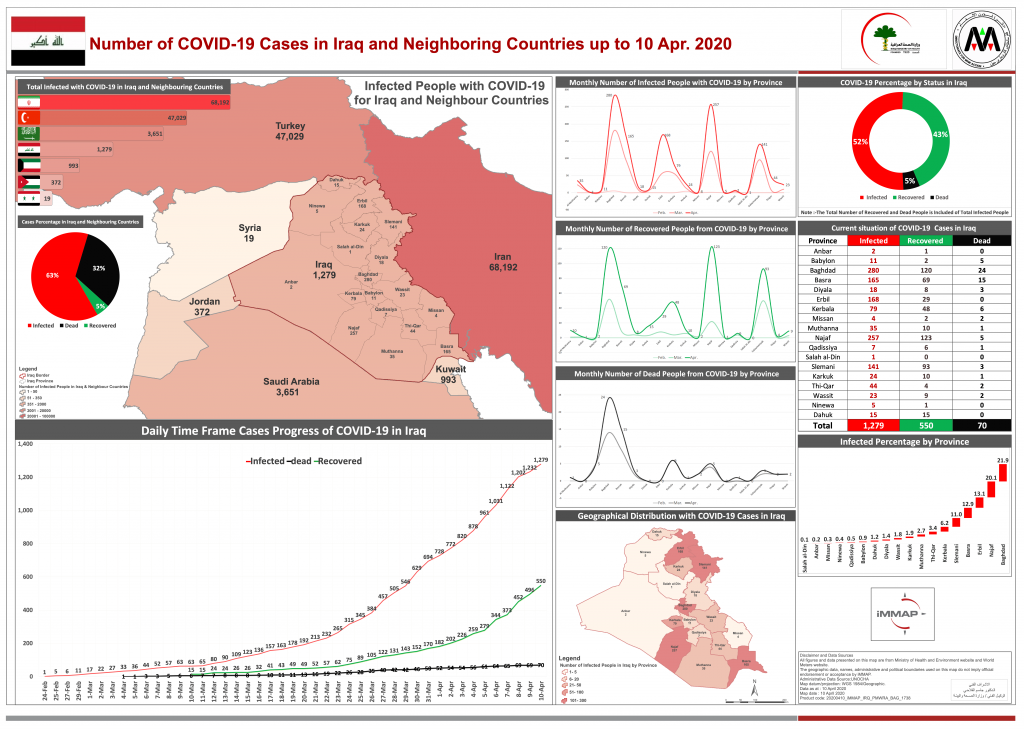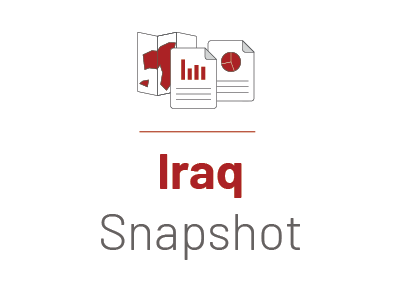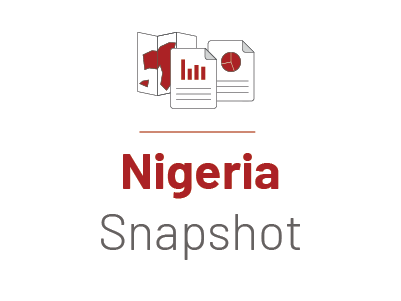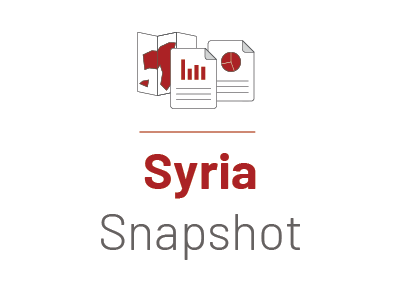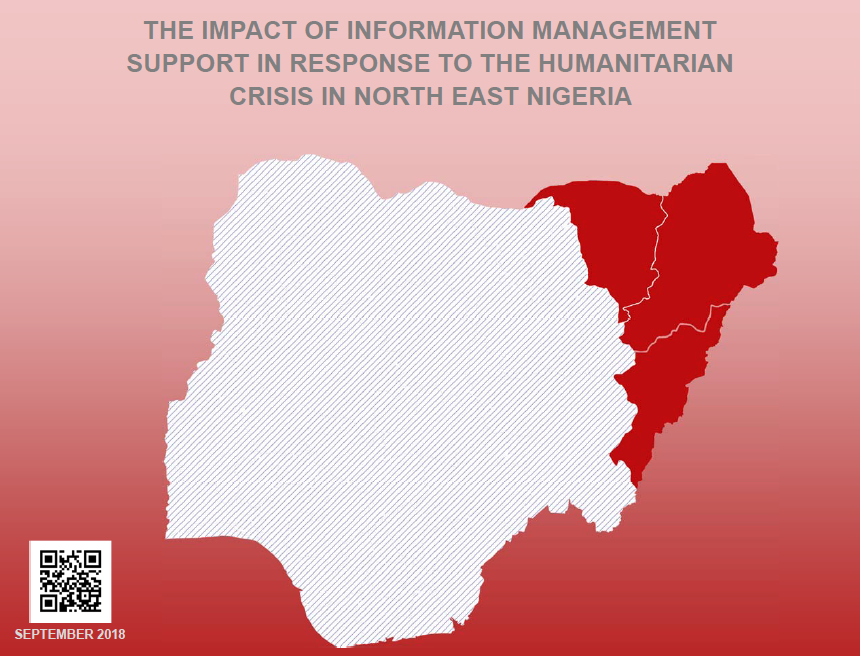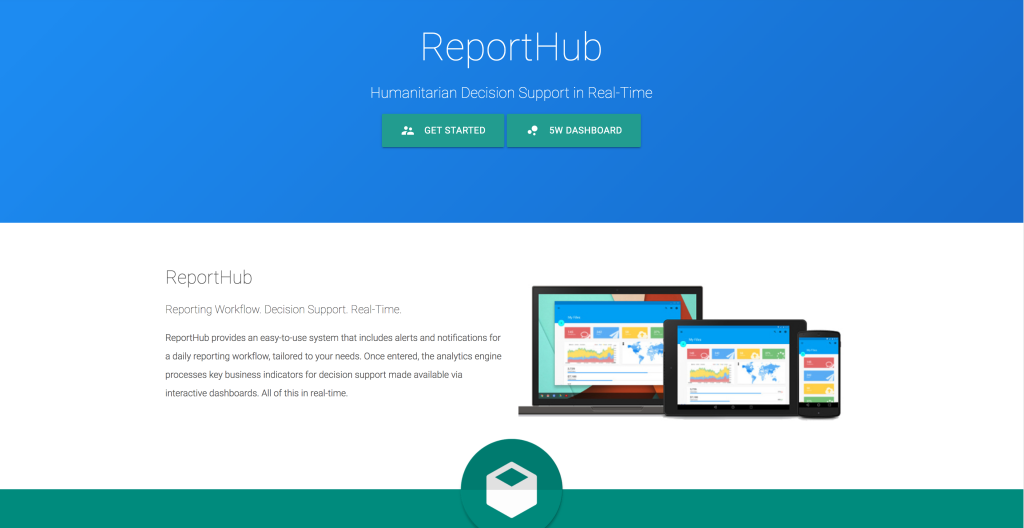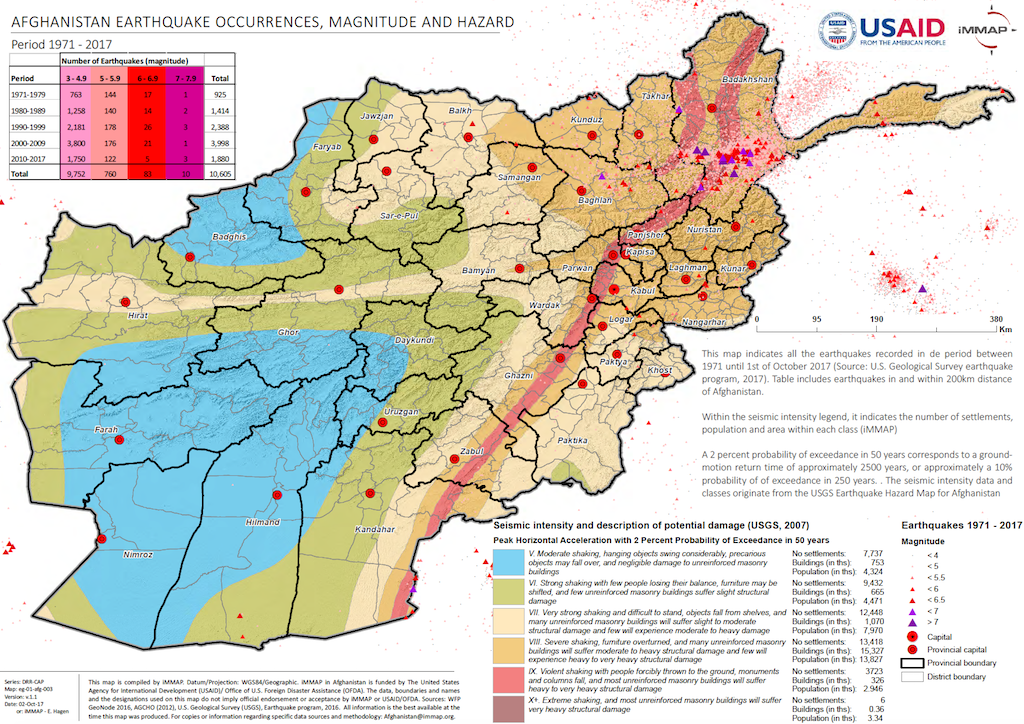Products
iMMAP Inc. Multimedia Production
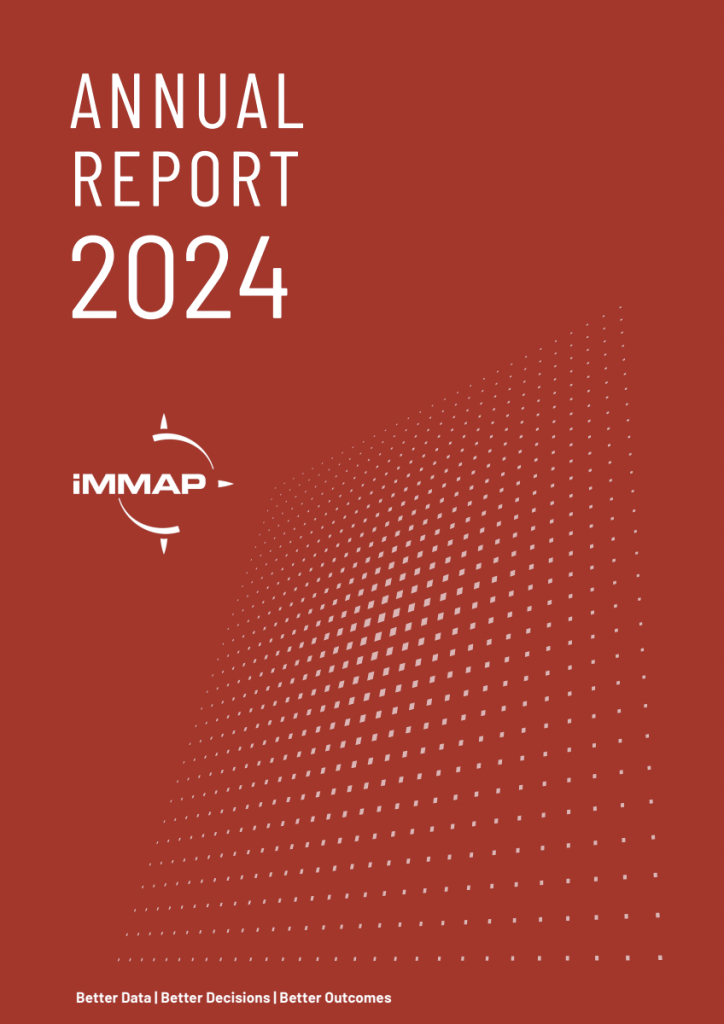
Annual Report 2024
In 2024, iMMAP Inc. stood firm amidst global crises, delivering vital information management services.
Read more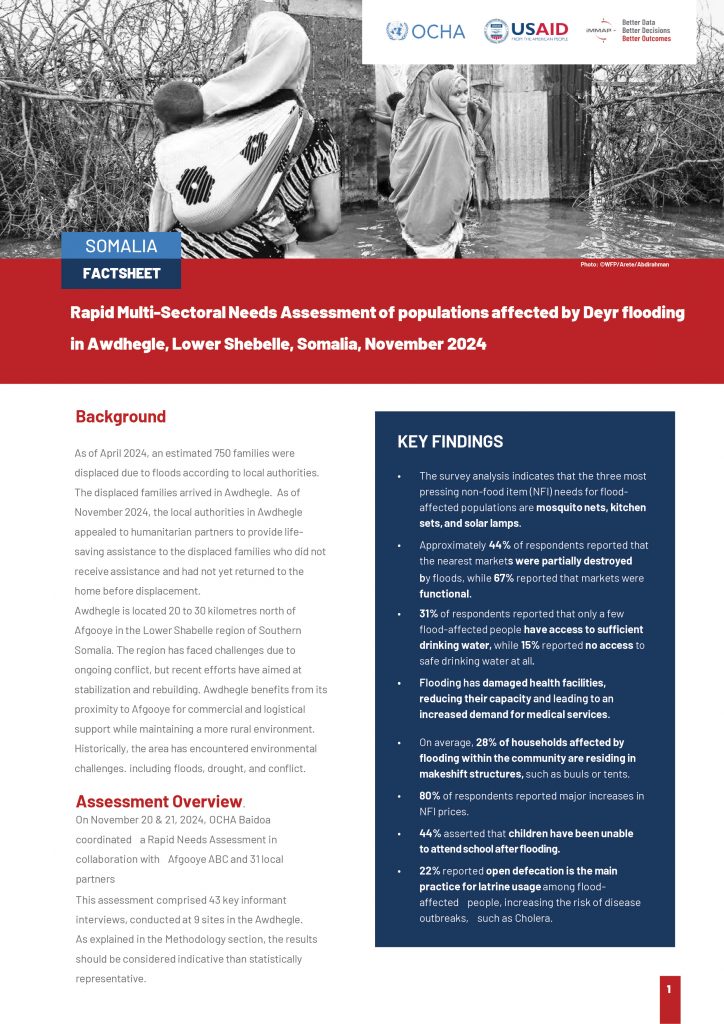
Somalia: Rapid Multi-Sector Needs Assessment of populations affected by Deyr flooding in Awdhegle, Lower Shebelle - November 2024
This Rapid Multi-Sectoral Needs Assessment Analyzes the needs of populations affected by Deyr flooding in Awdhegle, Lower Shebelle - November 2024
Read more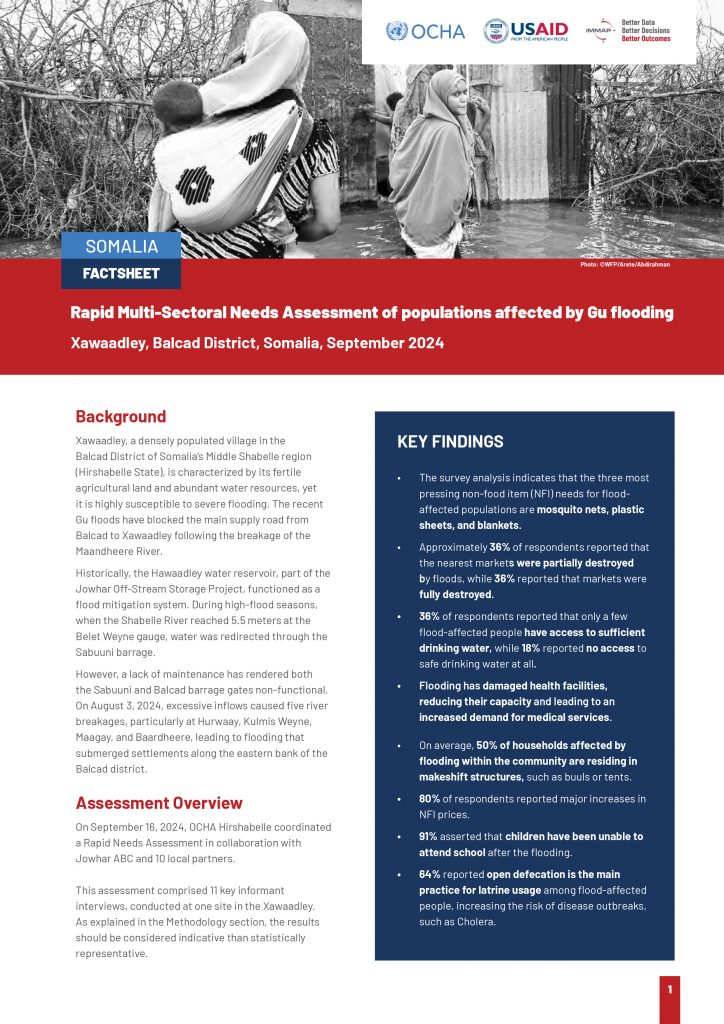
Somalia: Rapid Multi-Sector Needs Assessment of Riverine Flood-Affected Communities in Xawaadley, Balcad District - September 2024
This Rapid Multi-Sectoral Needs Assessment Analyzes the needs of Populations Affected by the Floods in the Xawaadley, Balcad District, Somalia, September 2024.
Read more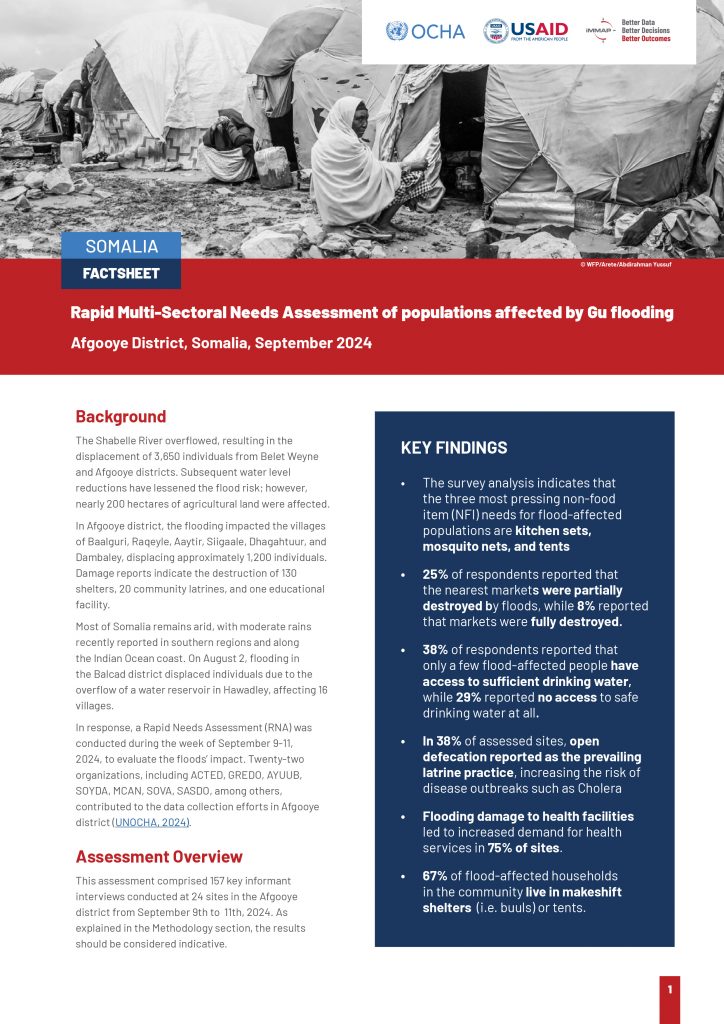
Somalia: Rapid Multi-Sector Needs Assessment of Riverine Flood-Affected Communities in Afgooye District - September 2024
This Rapid Multi-Sectoral Needs Assessment Analyzes the needs of Populations Affected by the Floods in the Afgooye District, Somalia, September 2024.
Read more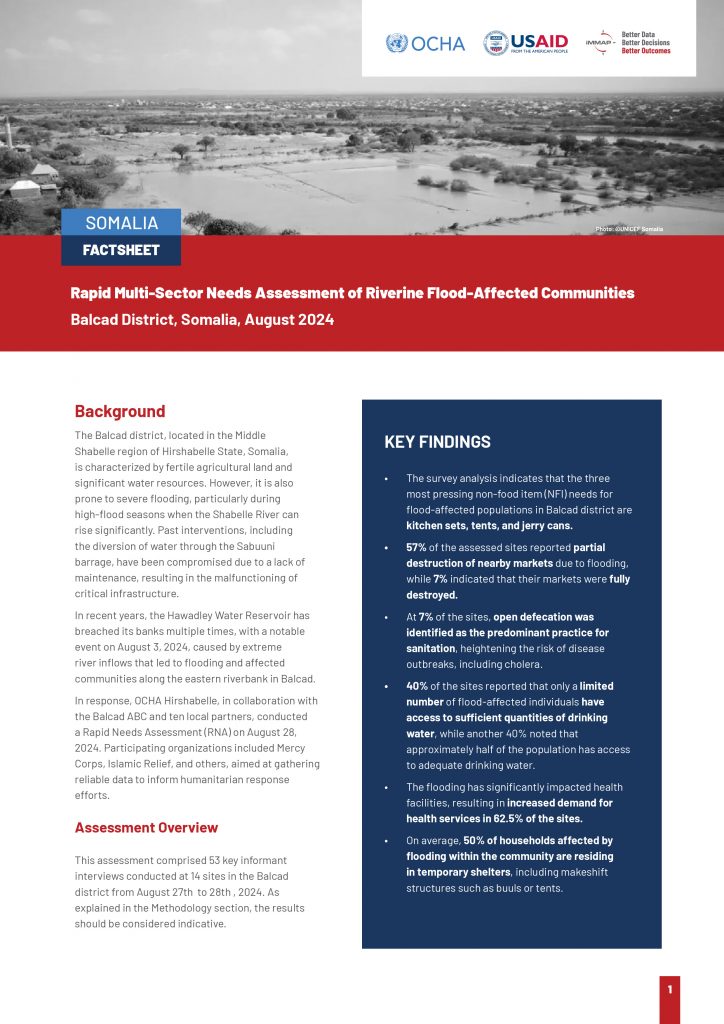
Somalia: Rapid Multi-Sector Needs Assessment of Riverine Flood-Affected Communities in Balcad District - August 2024
This Rapid Multi-Sectoral Needs Assessment Analyzes the needs of Populations Affected by the Floods in the Balcad District, Somalia, August 2024.
Read more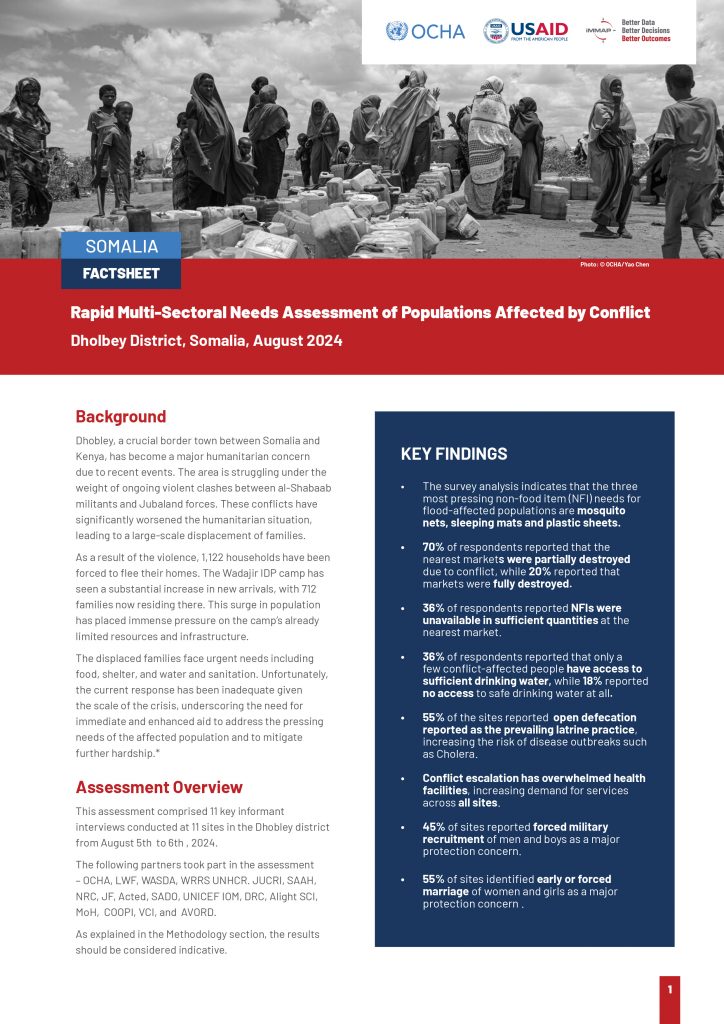
Somalia: Rapid Multi-Sectoral Needs Assessment of populations affected by conflict in Dholbey District - August 2024
This Rapid Multi-Sectoral Needs Assessment Analyzes the needs of Populations Affected by Conflict in the Dholbey District, Somalia, August 2024.
Read more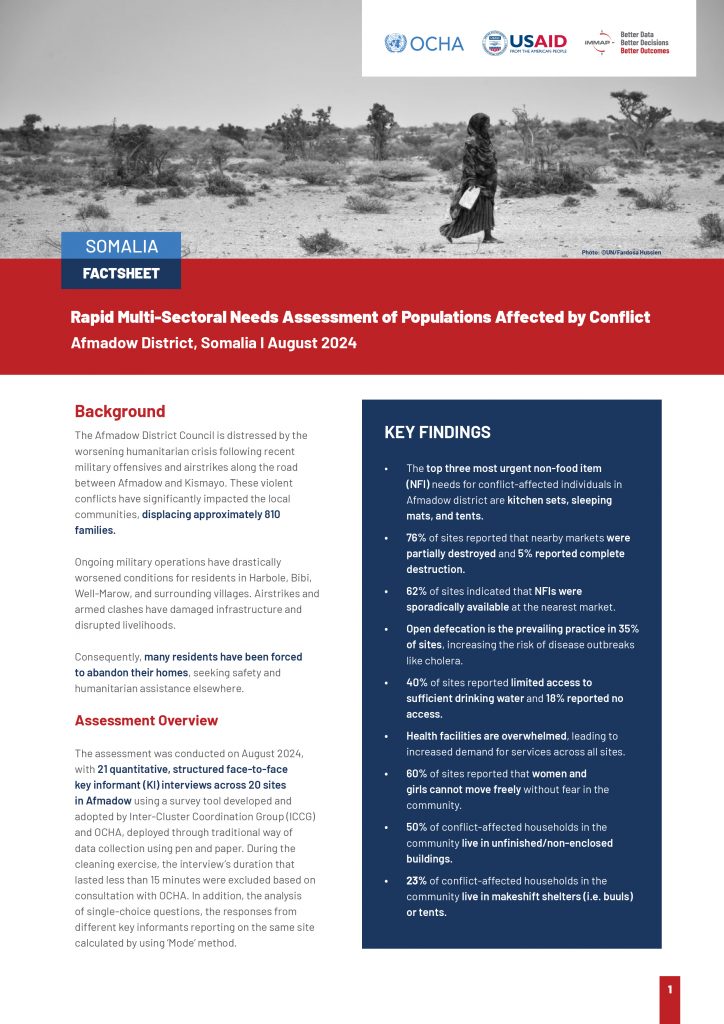
Somalia: Rapid Multi-Sectoral Needs Assessment of populations affected by conflict in Afmadow District - August 2024
The Afmadow District Council is distressed by the worsening humanitarian crisis following recent military offensives and airstrikes along the road between Afmadow and Kismayo.
Read more
Afghanistan Earthquake Events Snapshot - September 2024
This geographical visualization provides a snapshot of earthquake events in Afghanistan, including magnitude, epicenter locations, and dates of occurrence.
Read more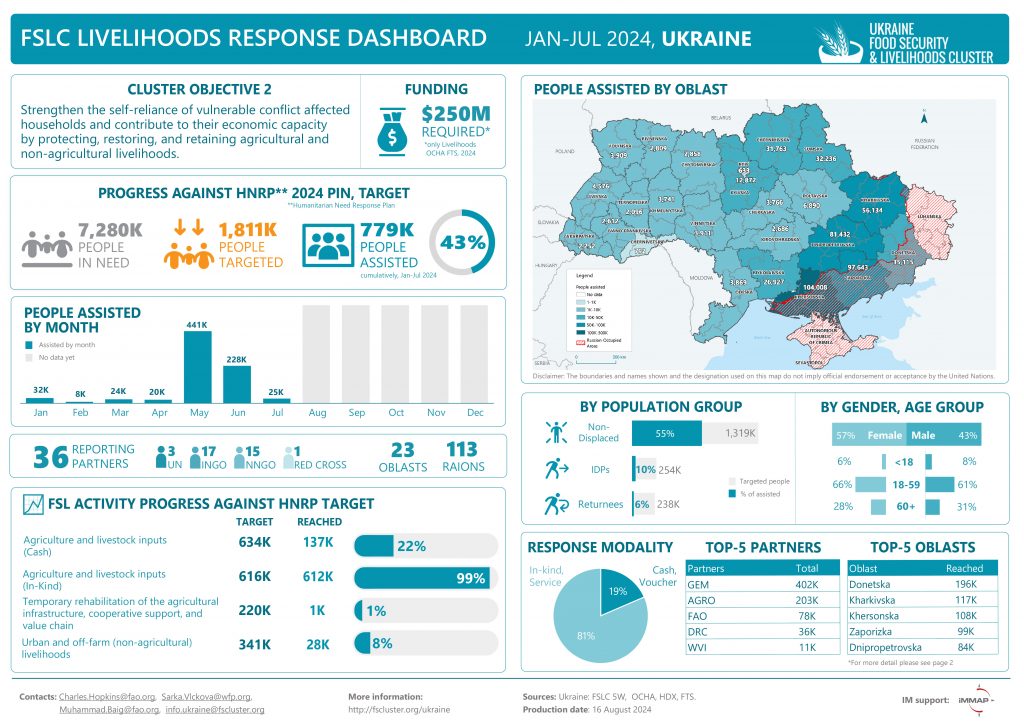
Ukraine: Food Security and Livelihoods Cluster Livelihoods Response, January - July 2024
The static dashboard presents comprehensive figures from the Food Security and Livelihoods (FSL) Cluster livelihoods response over the first six months of 2024.
Read more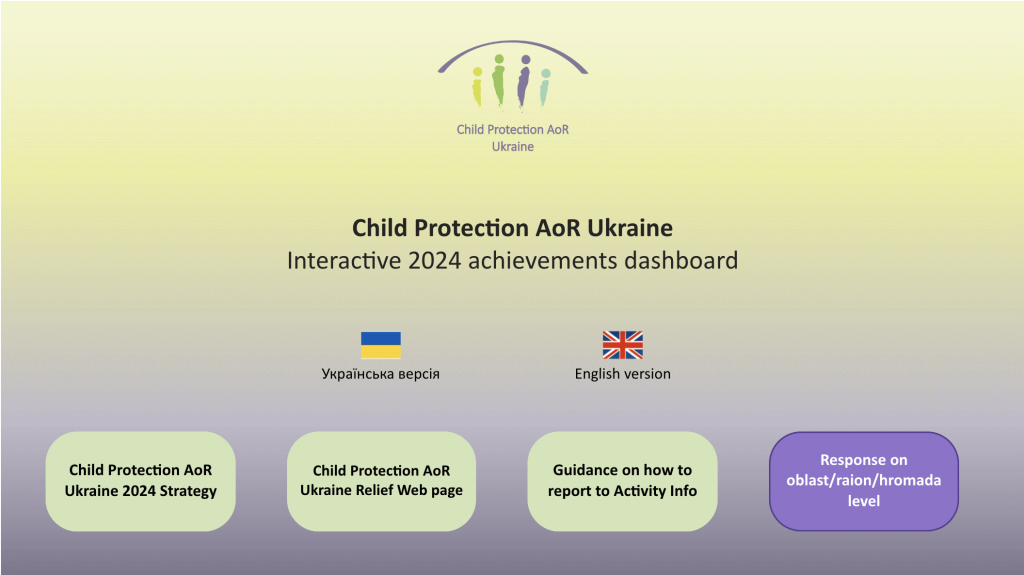
Ukraine: Child Protection Area of Responsibility - 2024 Achievements
The interactive dashboard developed for the Child Protection Area of Responsibility (AoR) highlights sub-cluster achievements for 2024.
Read more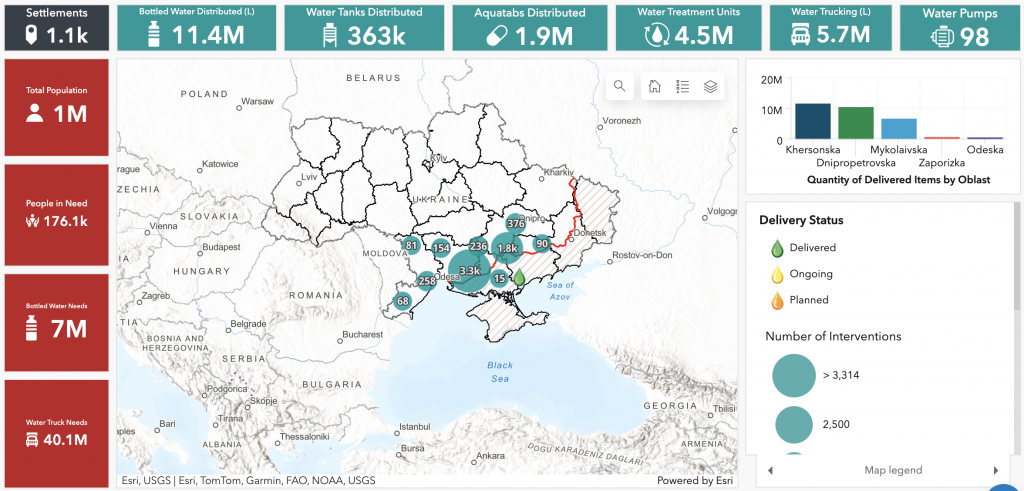
Ukraine: Kakhovka Dam Breach WASH Needs 2023 I Interactive Dashboard
The interactive map was developed for the WASH Cluster following the devastating destruction of the Kakhovka Dam in June 2023.
Read more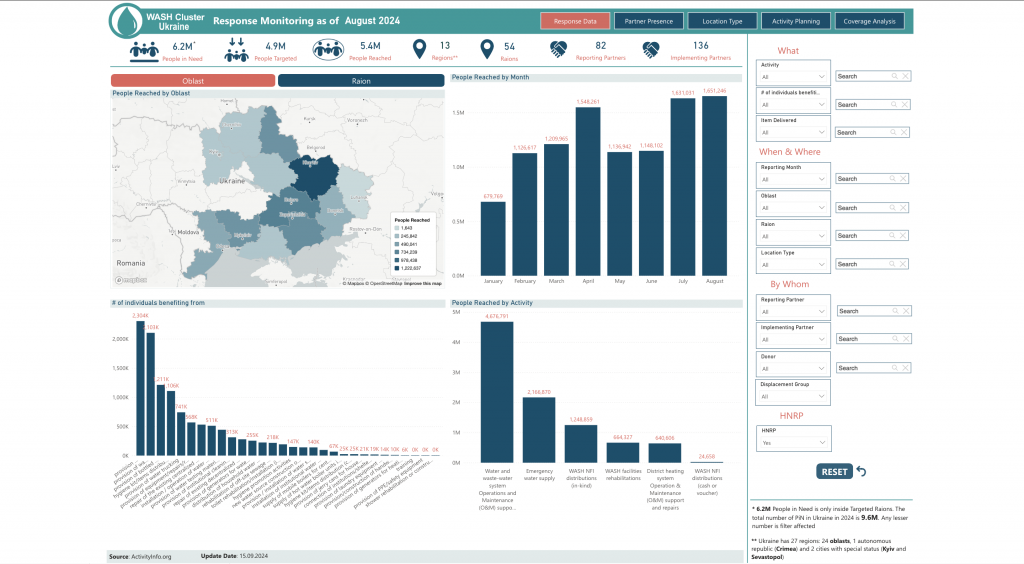
Ukraine: WASH Cluster Response Monitoring 2024
The interactive map displays response monitoring data for the WASH Cluster in Ukraine.
Read more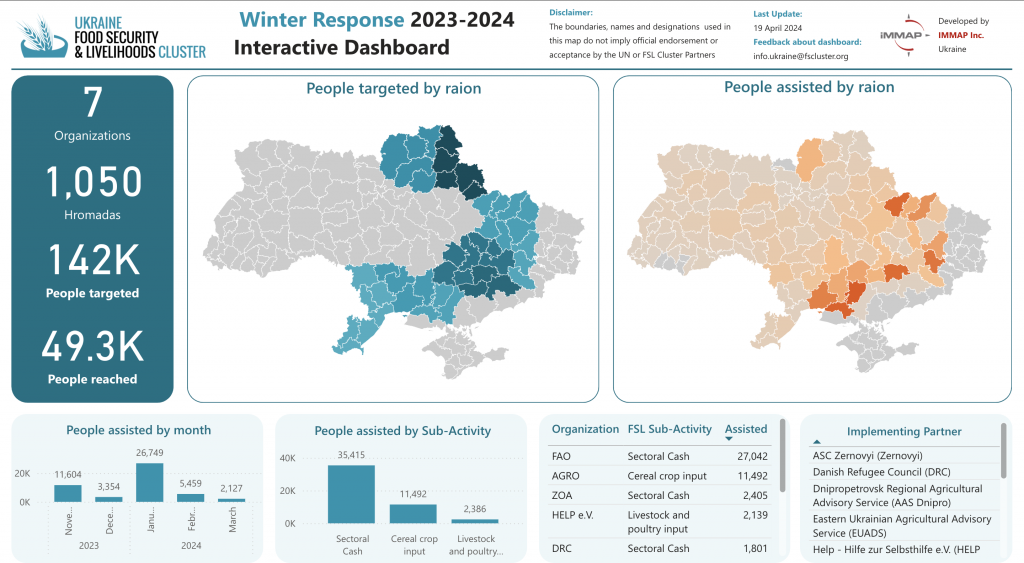
Ukraine: Winter Response 2023 - 2024 I Food Security and Livelihoods Cluster Interactive Dashboard
The interactive dashboard represents key figures from the Food Security and Livelihoods (FSL) Cluster winter response for 2023-2024.
Read more
Ukraine: People in Need 2024 I Food Security and Livelihoods Cluster Interactive Dashboard
This interactive dashboard, produced for the Food Security and Livelihoods (FSL) Cluster, shows the number of People in Need (PiN) at the oblast (region) level.
Read more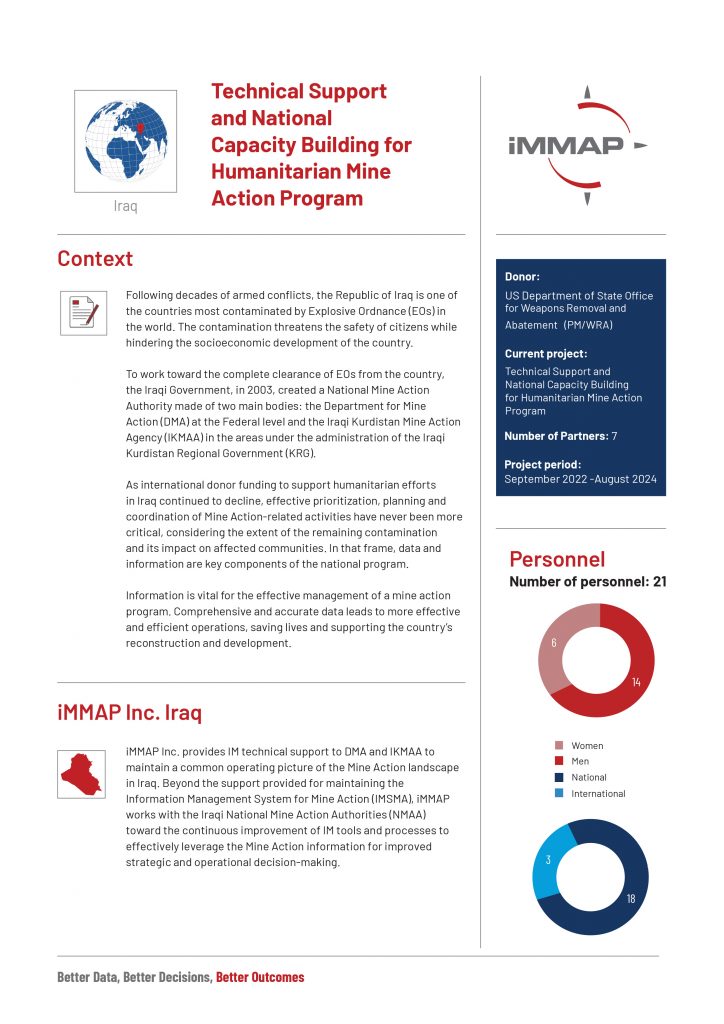
Technical Support and National Capacity Building for Humanitarian Mine Action Program
iMMAP Inc. provides IM technical support to DMA and IKMAA to maintain a common operating picture of the Mine Action landscape in Iraq. Beyond the support provided for maintaining the Information Management System for Mine Action (IMSMA), iMMAP works with the Iraqi National Mine Action Authorities (NMAA) toward the continuous improvement of IM tools and processes to effectively leverage the Mine Action information for improved strategic and operational decision-making.
Read more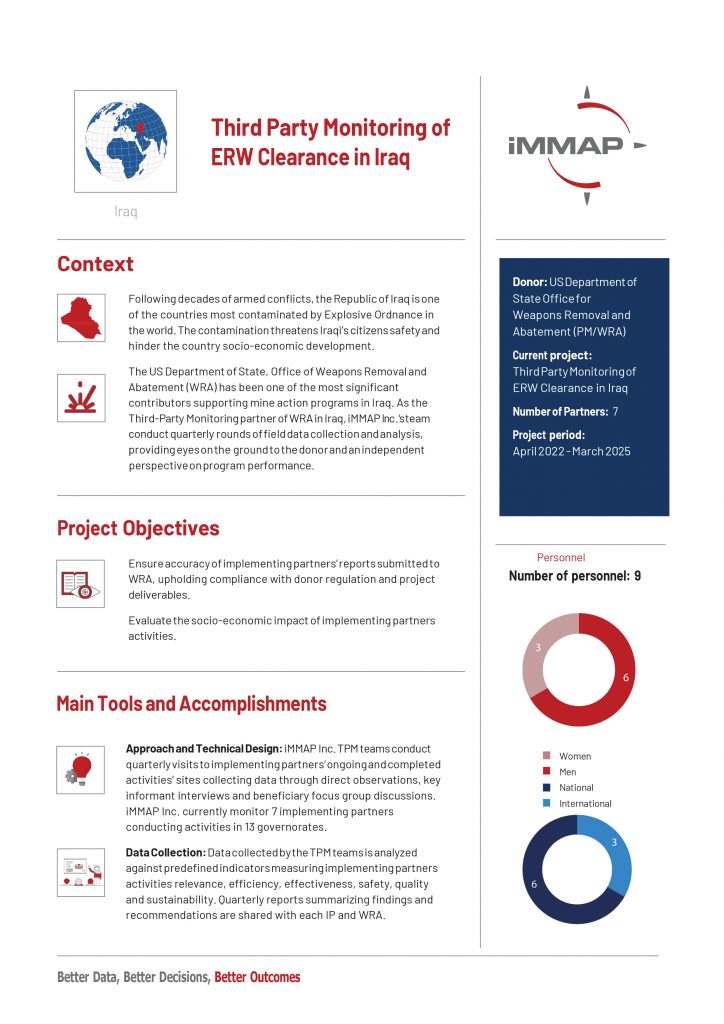
Third Party Monitoring of ERW Clearance in Iraq - August 2024 Snapshot
This product provides a snapshot on the objectives, accomplishments and areas of operation under the Third Party Monitoring of ERW Clearance in Iraq.
Read more
Afghanistan Earthquake Events Snapshot as of August 2024
This geographical visualization provides a snapshot of earthquake events in Afghanistan, including magnitude, epicenter locations, and dates of occurrence.
Read more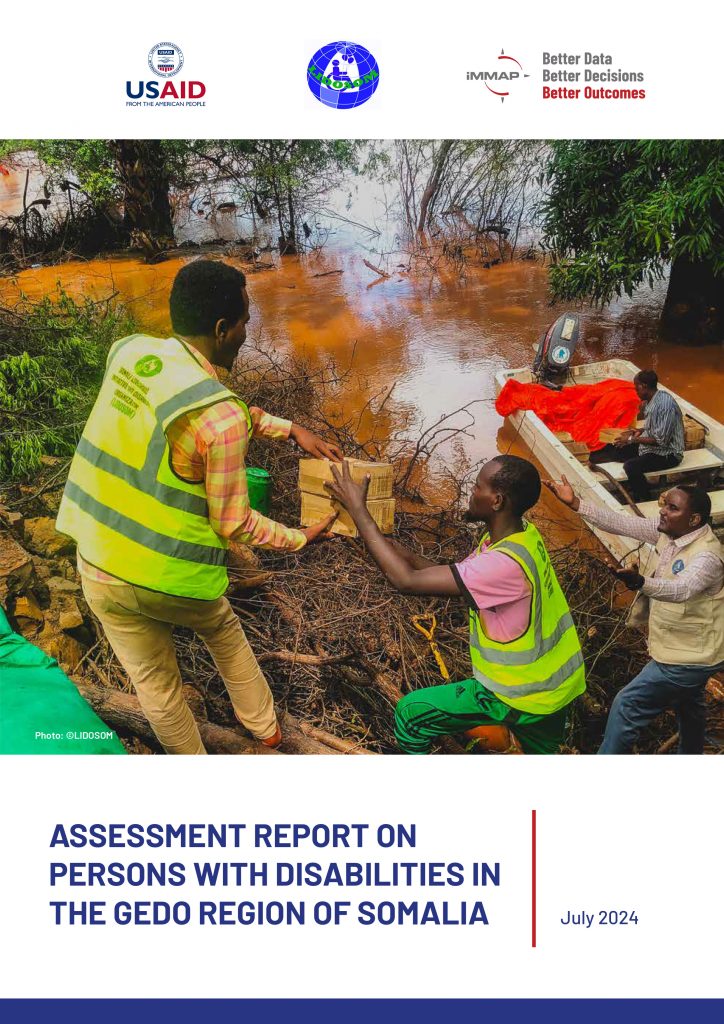
Assessment Report on Persons with Disabilities in the GEDO Region of Somalia
This report provides a detailed analysis of the disability-related issues in four key districts: Baardheere, Belet Xaawo, Ceel Waaq, and Luuq. It examines the prevalence and types of disabilities, access to healthcare and assistive devices, protection concerns, and food security challenges among the surveyed populations. The findings aim to inform targeted interventions and policymaking to improve the living conditions and support mechanisms for PwDs in these regions.
Read more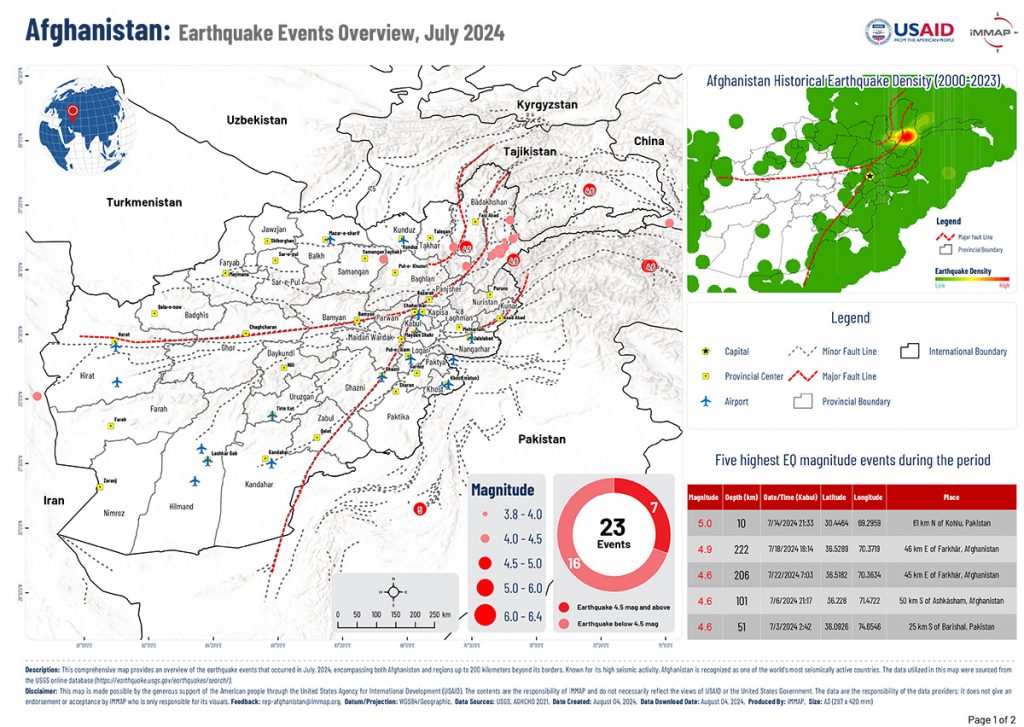
Afghanistan Earthquake Events Snapshot as of July 2024
This geographical visualization provides a snapshot of earthquake events in Afghanistan, including magnitude, epicenter locations, and dates of occurrence.
Read more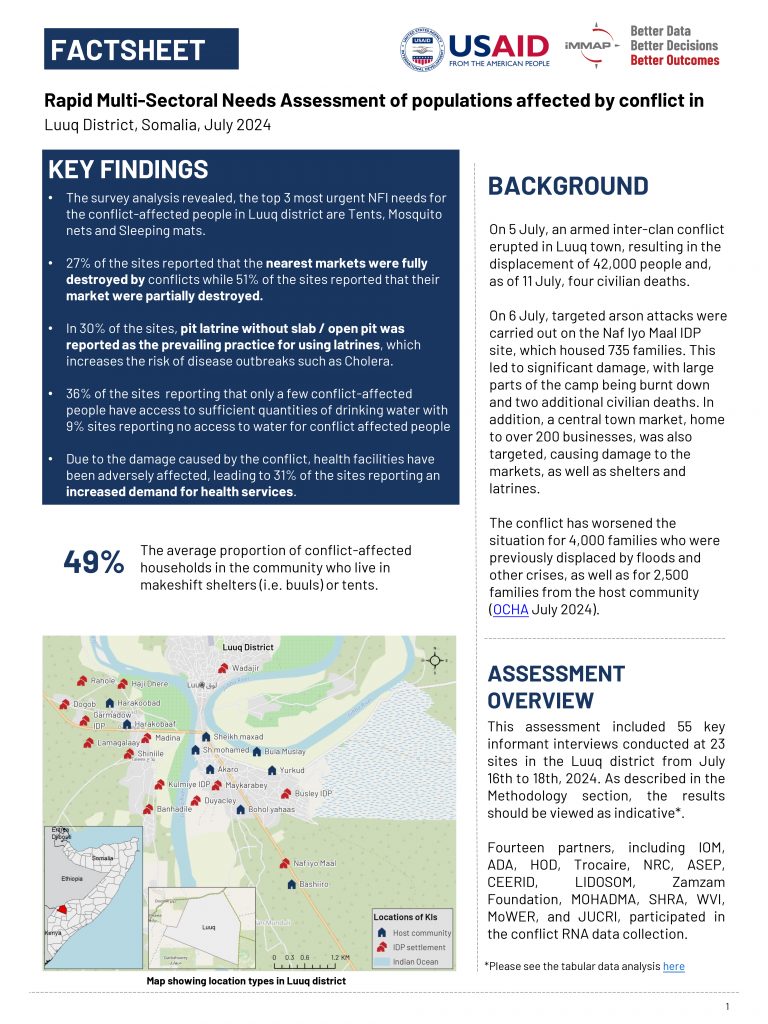
Somalia: Rapid Multi-Sectoral Needs Assessment of populations affected by conflict in Luuq District - July 2024
On 5 July, an armed inter-clan conflict erupted in Luuq town, resulting in the displacement of 42,000 people and, as of 11 July, four civilian deaths. This assessment included 55 key informant interviews conducted at 23 sites in the Luuq district from July 16th to 18th, 2024.
Read more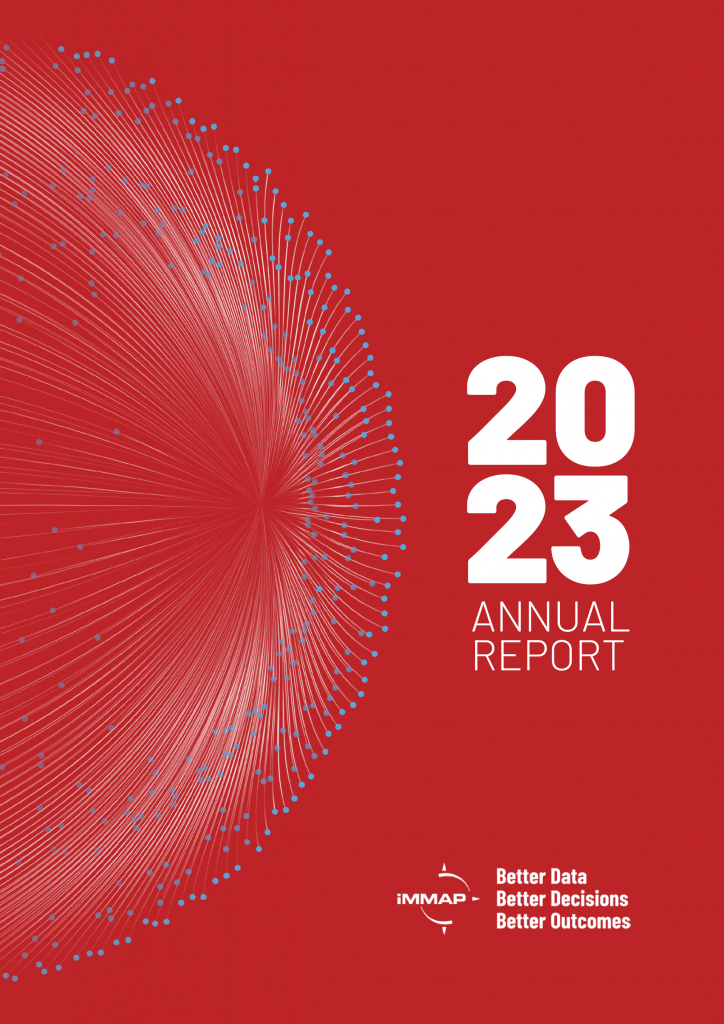
Annual Report 2023
In 2023, iMMAP Inc. reached new heights, delivering more profound impacts through innovation and collaboration.
Read more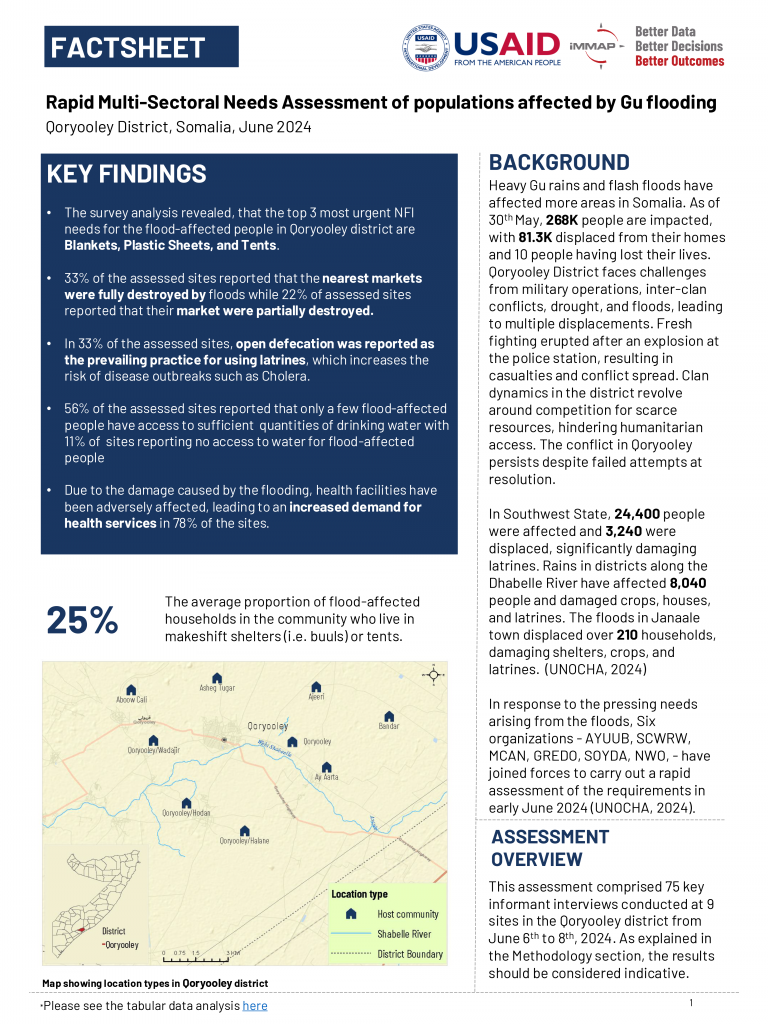
Somalia: Rapid Multi-Sectoral Needs Assessment of populations affected by Gu flooding, Qoryooley District - June 2024
This document assesses the needs of the population affected by Gu flooding in the Qoryooley District, Somalia.
Read more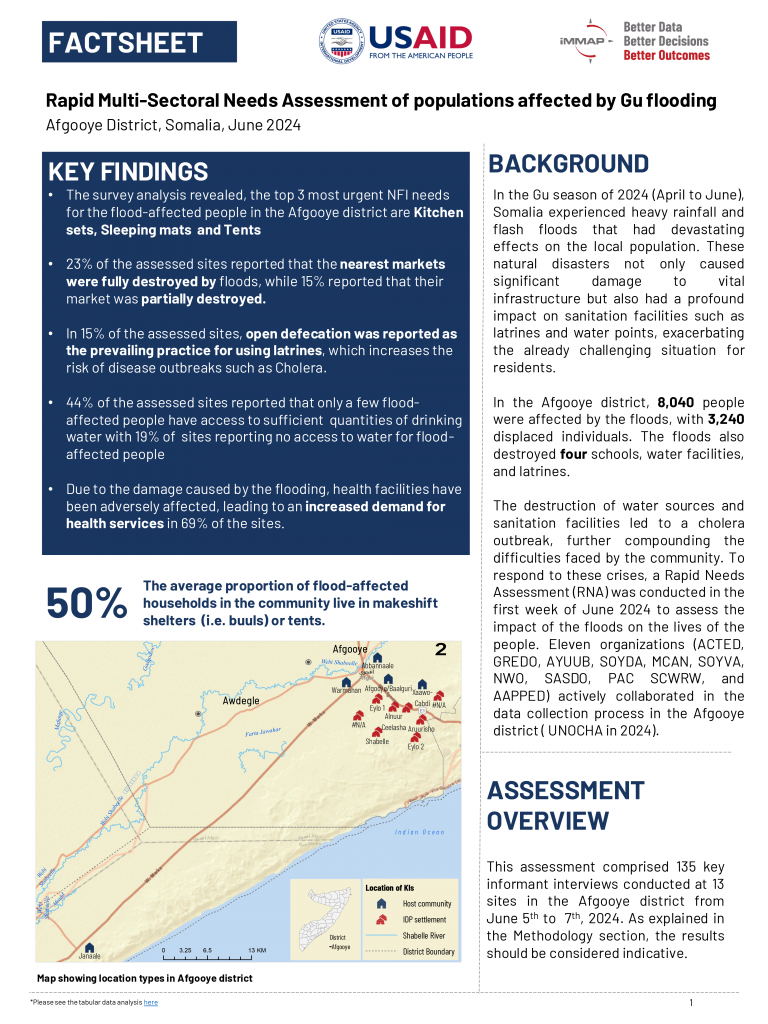
Somalia: Rapid Multi-Sectoral Needs Assessment of populations affected by Gu flooding, Afgooye District - June 2024
This document assesses the needs of the population affected by Gu flooding in the Afgooye District, Somalia.
Read more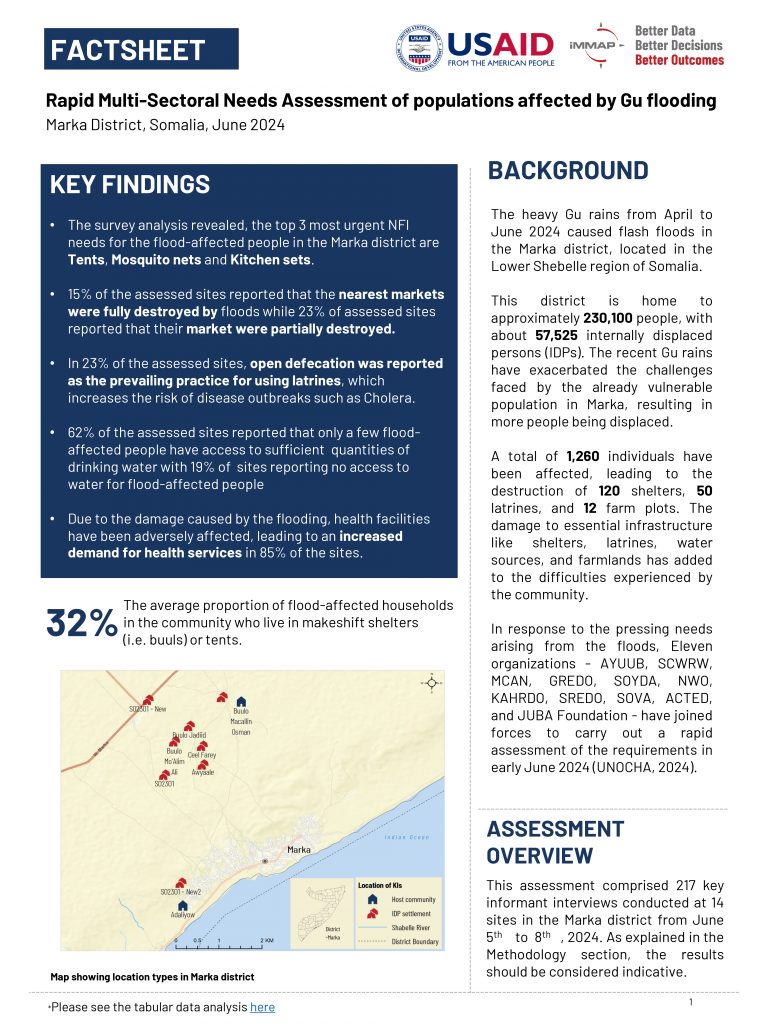
Somalia: Rapid Multi-Sectoral Needs Assessment of populations affected by Gu flooding, Marka District - June 2024
This document assesses the needs of the population affected by Gu flooding in the Marka District, Somalia.
Read more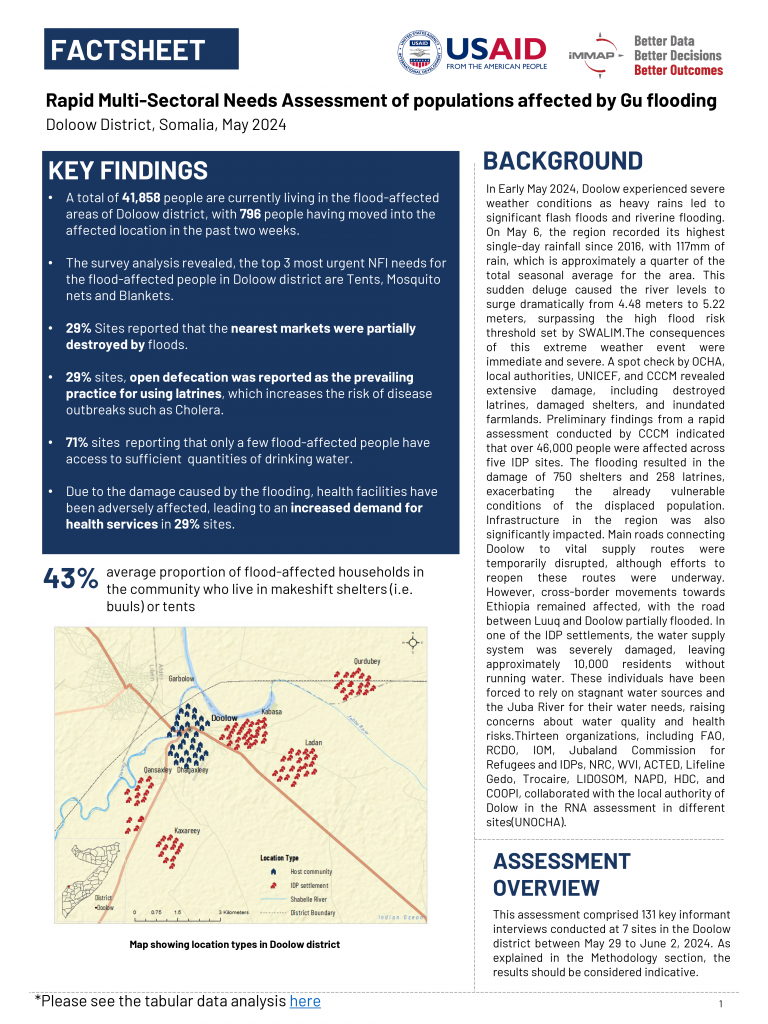
Somalia: Rapid Multi-Sectoral Needs Assessment of populations affected by Gu flooding, Doloow District - May 2024
This document assesses the needs of the population affected by Gu flooding in the Doloow District, Somalia.
Read more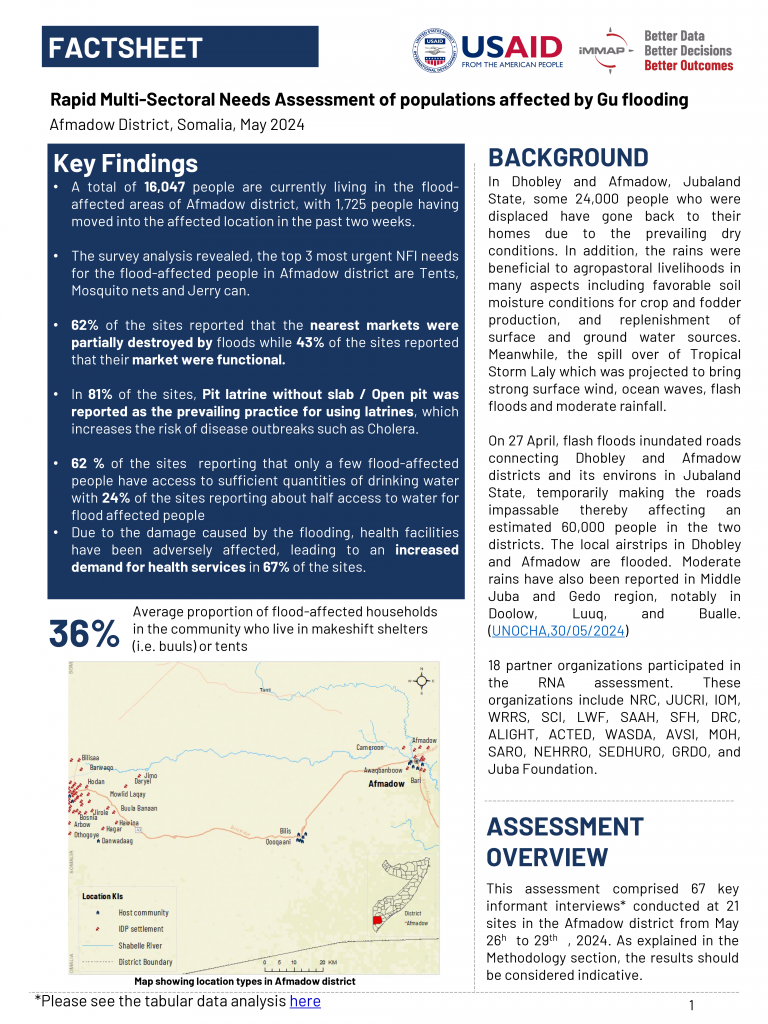
Somalia: Rapid Multi-Sectoral Needs Assessment of populations affected by Gu flooding, Afmadow District - May 2024
This document assesses the needs of the population affected by Gu flooding in the Afmadow District, Somalia.
Read more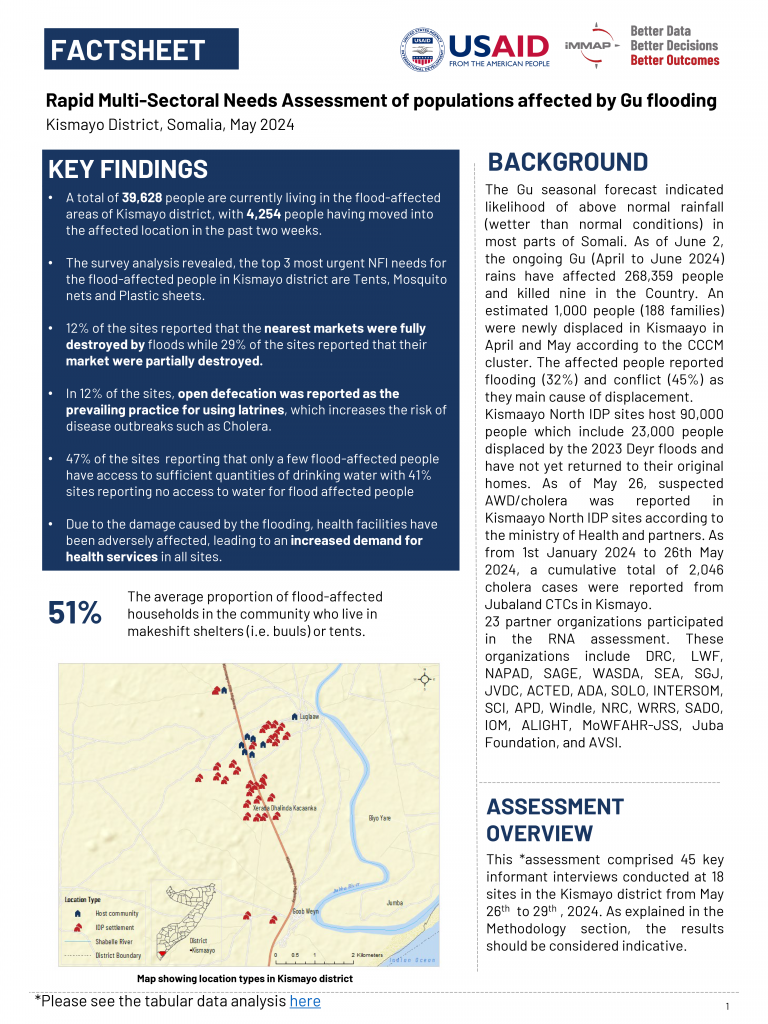
Somalia: Rapid Multi-Sectoral Needs Assessment of populations affected by Gu flooding, Kismayo District - May 2024
This document assesses the needs of the population affected by Gu flooding in the Kismayo District, Somalia.
Read more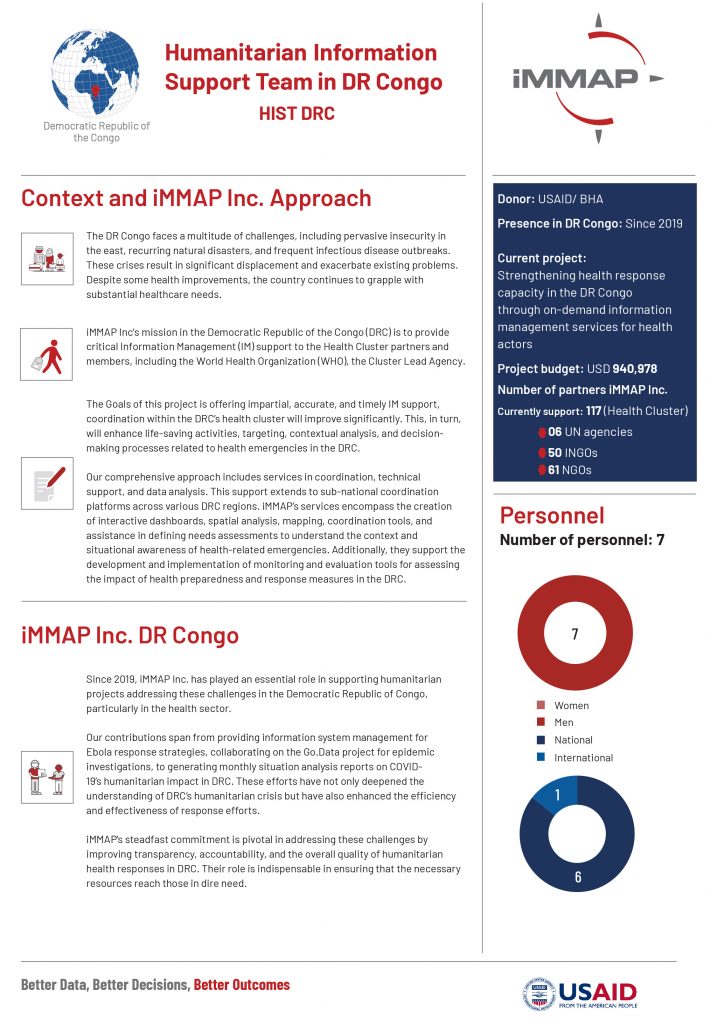
Humanitarian Information Support Team in Democratic Republic of the Congo (Project Snapshot, June 2024)
iMMAP Inc's mission in the Democratic Republic of the Congo (DRC) is to provide critical Information Management (IM) support to the Health Cluster partners and members.
Read more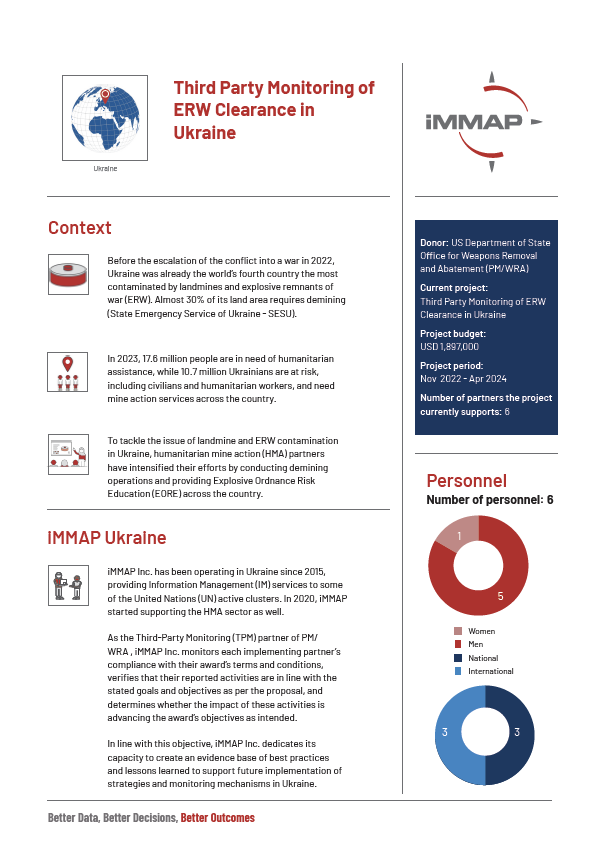
Third Party Monitoring of Explosive Remnants of War (ERW) Clearance in Ukraine (Project Snapshot, February 2024)
This project focuses on third-party monitoring (TPM) of Explosive Remnants of War (ERW) clearance activities in Ukraine as part of humanitarian mine action efforts. The objective of the project is to improve the accountability, transparency and quality control of the demining process while addressing implementation challenges.
Read more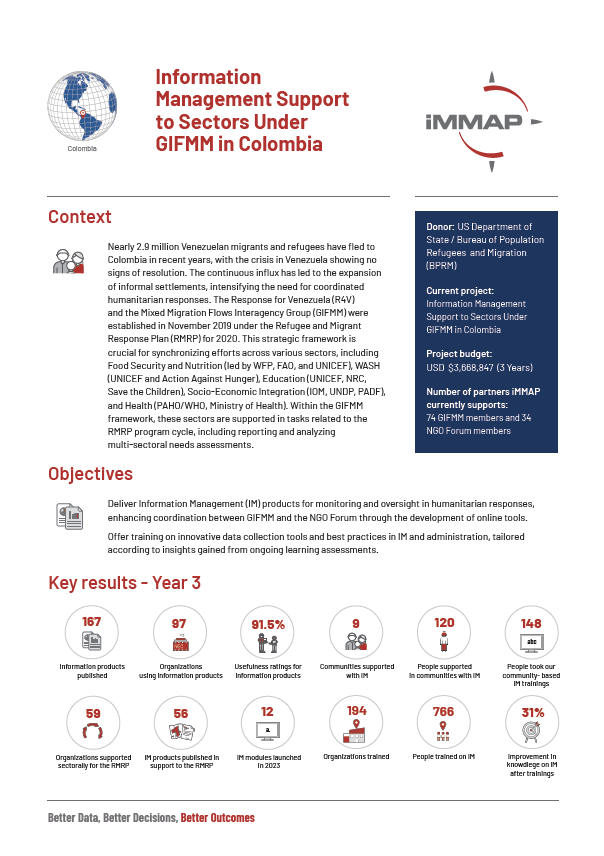
Information Management for Disaster Risk Reduction and Response in Colombia (Project Snapshot, April 2024)
iMMAP Inc. delivers Information Management (IM) products and services to key partners in humanitarian response under the the Mixed Migration Flows Interagency Group (GIFMM), including but not limited to the humanitarian clusters, UN agencies, USAID implementing partners, and NGOs.
Read more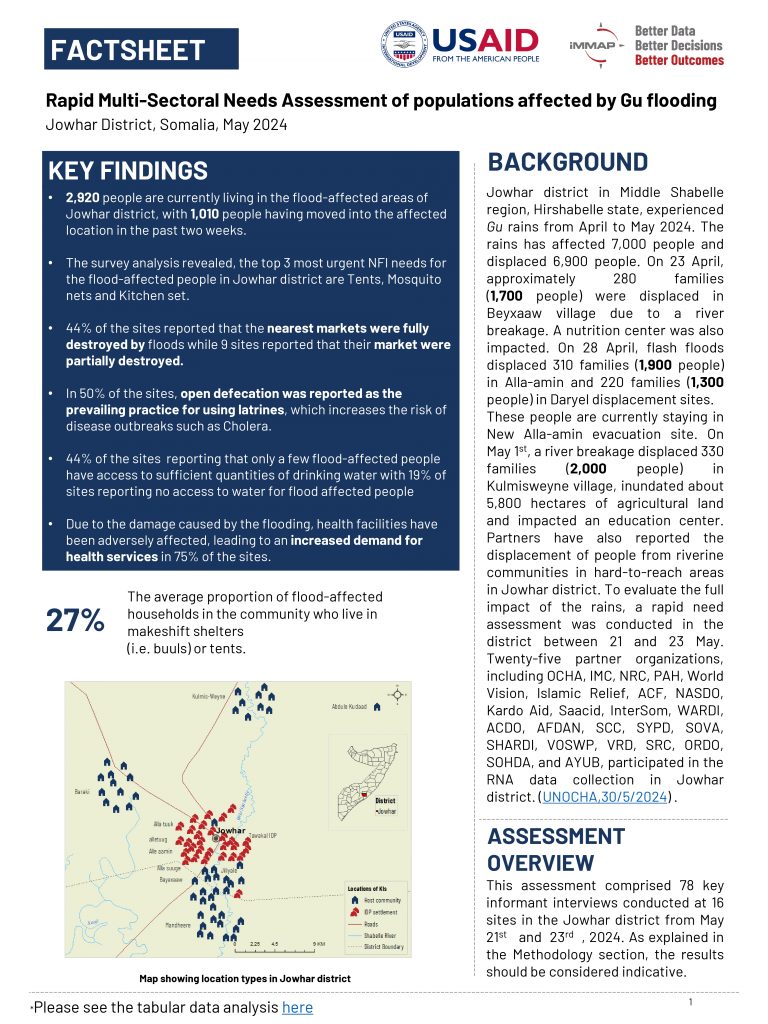
Rapid multi-sectoral needs assessment of populations affected by Gu flooding - Jowhar District, Somalia, May 2024
During April to June 2024, heavy rains in Somalia caused by El Niño and a positive Indian Ocean Dipole led to widespread flooding, affecting 268,359 people and resulting in 9 deaths. Destruction of farms, infrastructure, and livelihoods was reported.
Read more
Rapid multi-sectoral needs assessment of populations affected by Gu flooding - North Gaalkacyo and Jariiban District, Somalia, May 2024
During April to June 2024, heavy rains in Somalia caused by El Niño and a positive Indian Ocean Dipole led to widespread flooding, affecting 268,359 people and resulting in 9 deaths. Destruction of farms, infrastructure, and livelihoods was reported.
Read more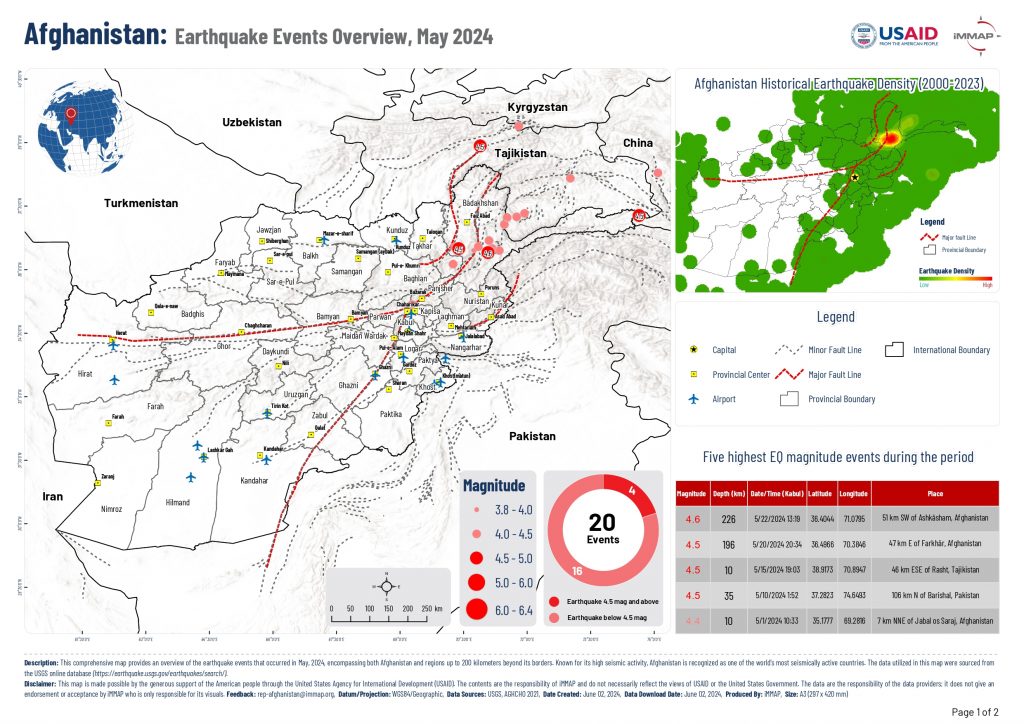
Afghanistan: Earthquake Events Overview (May 2024)
This map incorporates data from the USGS online database which provides a detailed overview of earthquake events, including magnitude, epicenter location and dates of occurrence.
Read more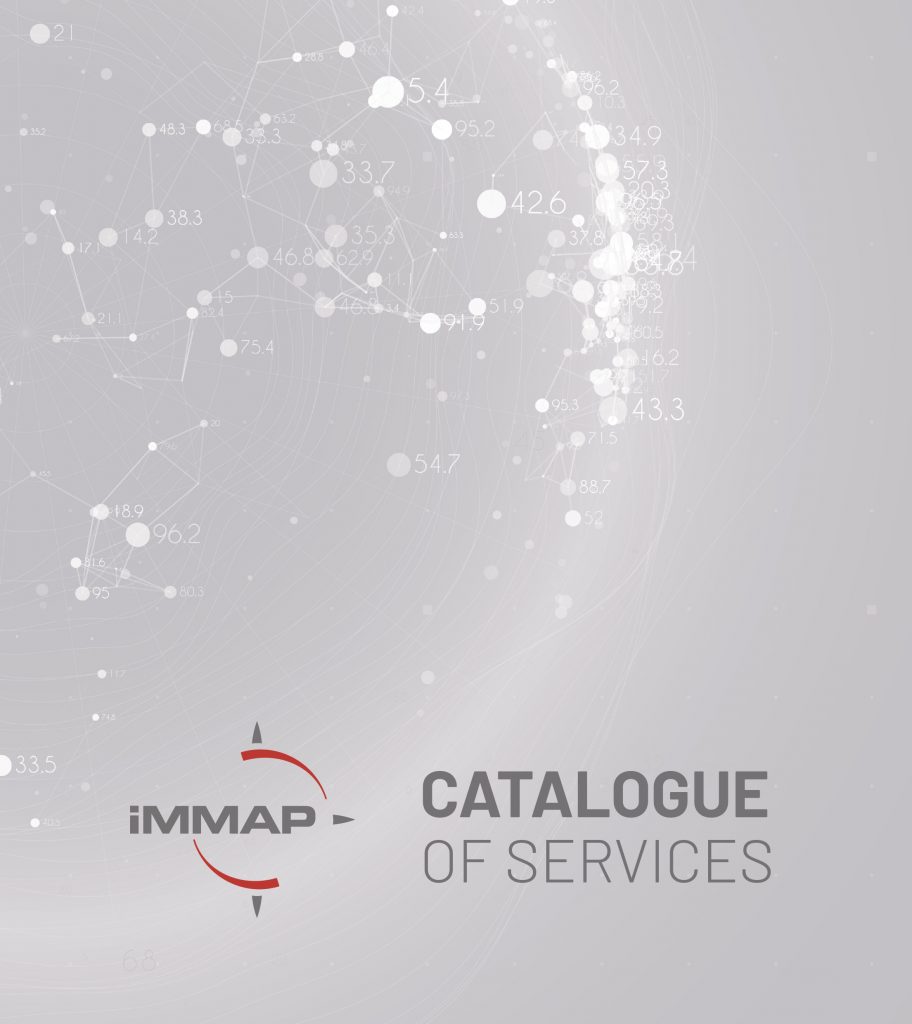
iMMAP Inc. Catalogue of Services
Our mission is to harness the power of information to facilitate evidence-based decisions to improve people’s lives.
Read more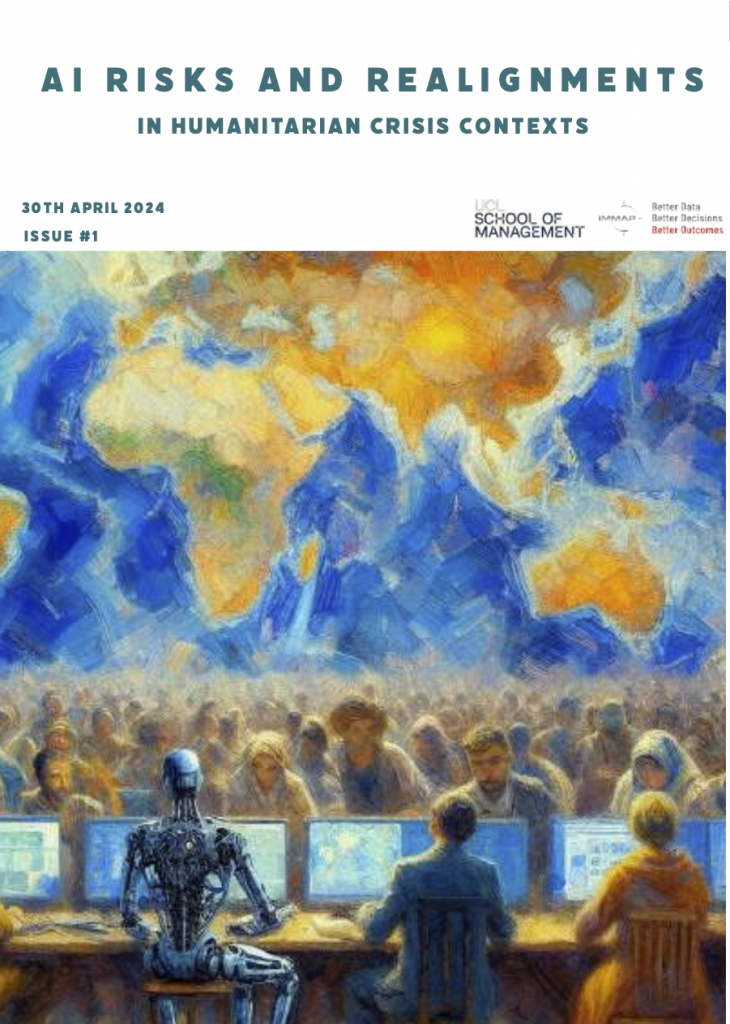
AI risks and realignment
The AI risks and realignment research series is a multi-stakeholder initiative by researchers and practitioners working at the intersection of AI and humanitarian crisis contexts.
Read more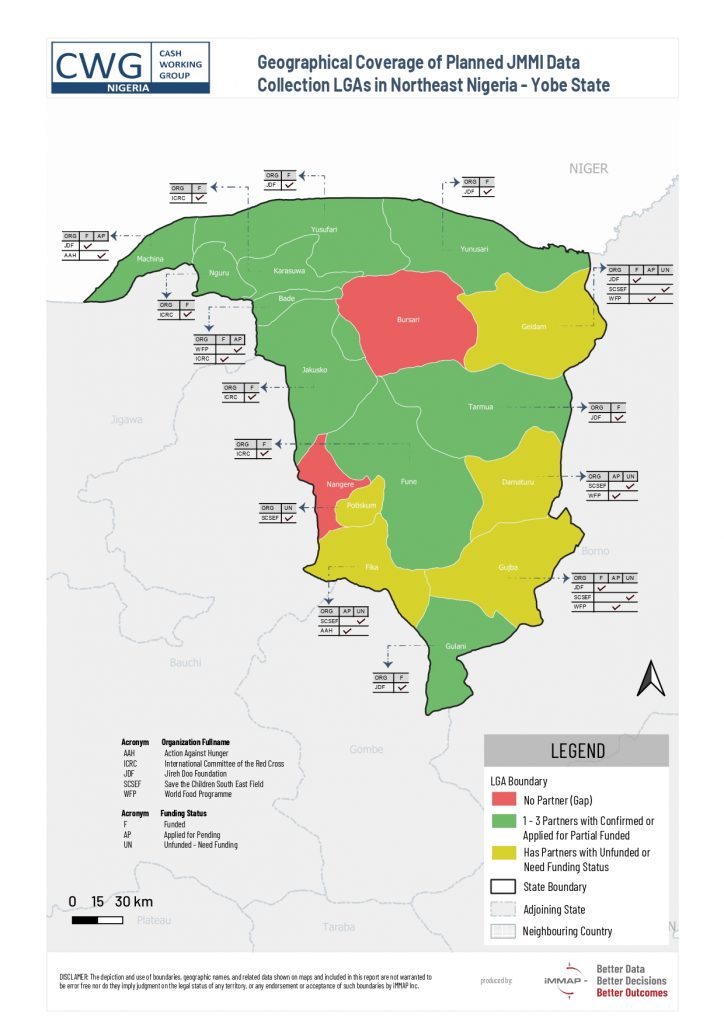
Nigeria: partner's coverage of the Joint Market Initiative in Yobe state
The map highlights partners' coverage of the Joint Market Monitoring Initiative in some LGAs in Yobe state. The map also features the partners/organizational presence, funding status, and identifies LGAs with no partners and LGAs with unfunded and/or underfunded activities.
Read more
Nigeria: Map of selected Wards in Mashi LGA, Katsina state
The reference map for Mashi LGA in Katsina State indicates the areas where PUI is supporting humanitarian efforts in northwest Nigeria.
Read more
Major Highways, Towns and Airports in Nigeria
The reference map showcases major highways, airports, and towns in Nigeria.
Read more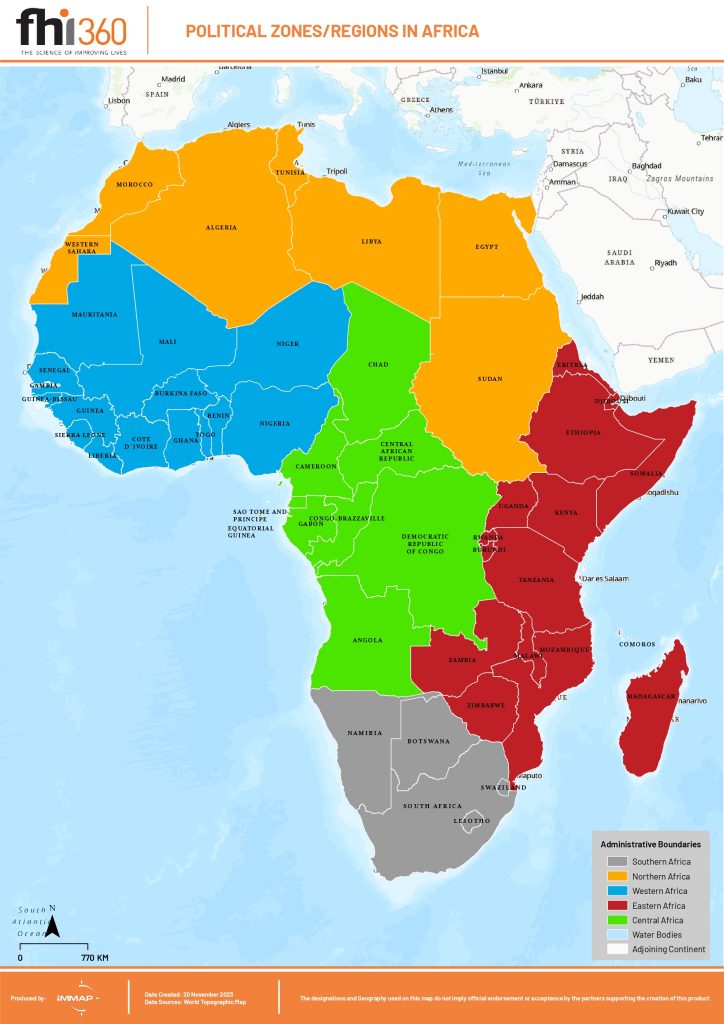
Political Zones and Regions in Africa
This map shows the different political zones of Africa.
Read more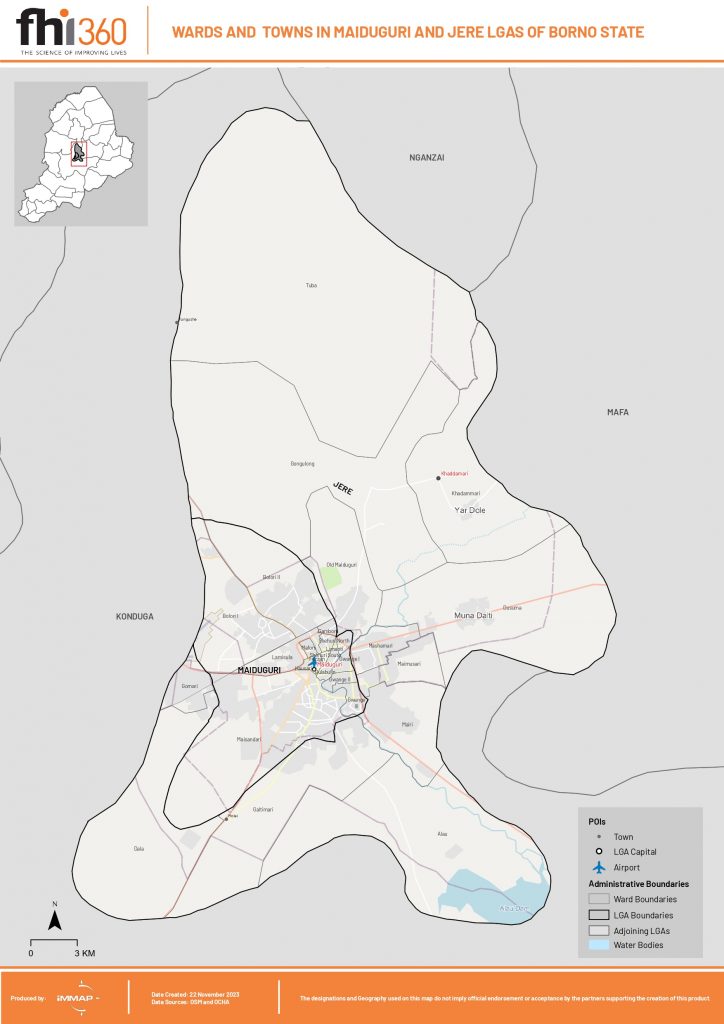
Nigeria: Reference Map of Wards and Towns in Maiduguri and Jere, Borno State
The reference map of Maiduguri and Jere LGAs in Borno state shows towns, wards, and key Points of Interest used for safety and security reasons.
Read more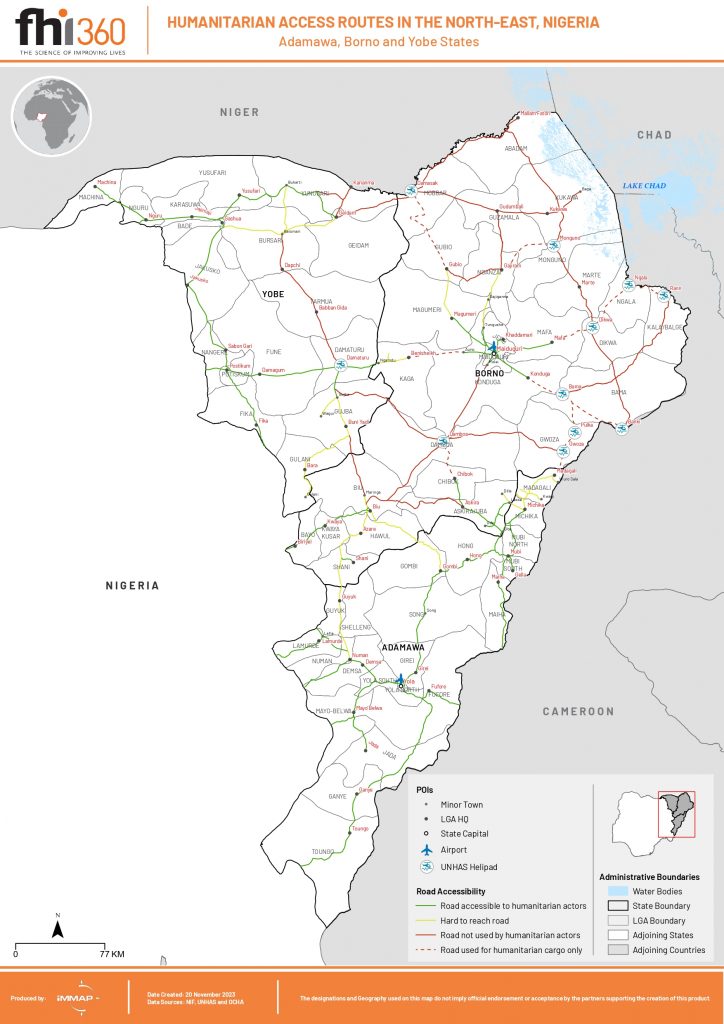
Nigeria: Humanitarian Access Routes in the BAY states
This map shows the humanitarian access routes in the northeast region of Nigeria: Borno, Adamawa, and Yobe (BAY) states.
Read more
Nigeria: partner's coverage of the Joint Market Initiative in Borno state
The map highlights partners' coverage of the Joint Market Monitoring Initiative in some LGAs in Borno state. The map also features the partners/organizational presence, funding status, and identifying LGAs with no partners and LGAs with unfunded and/or underfunded activities.
Read more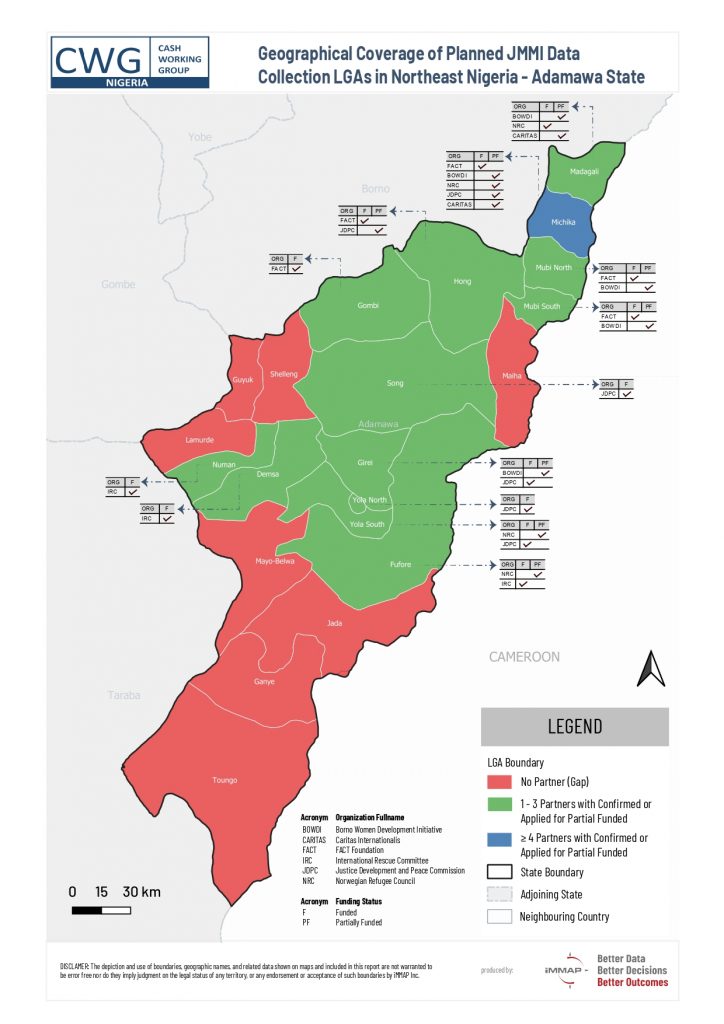
Nigeria: partner's coverage of the Joint Market Initiative in Adamawa state
The map highlights partners' coverage of the Joint Market Monitoring Initiative in some LGAs in Adamawa state. The map also features the partners/organizational presence, funding status, and identifies LGAs with no partners and LGAs with unfunded and/or underfunded activities.
Read more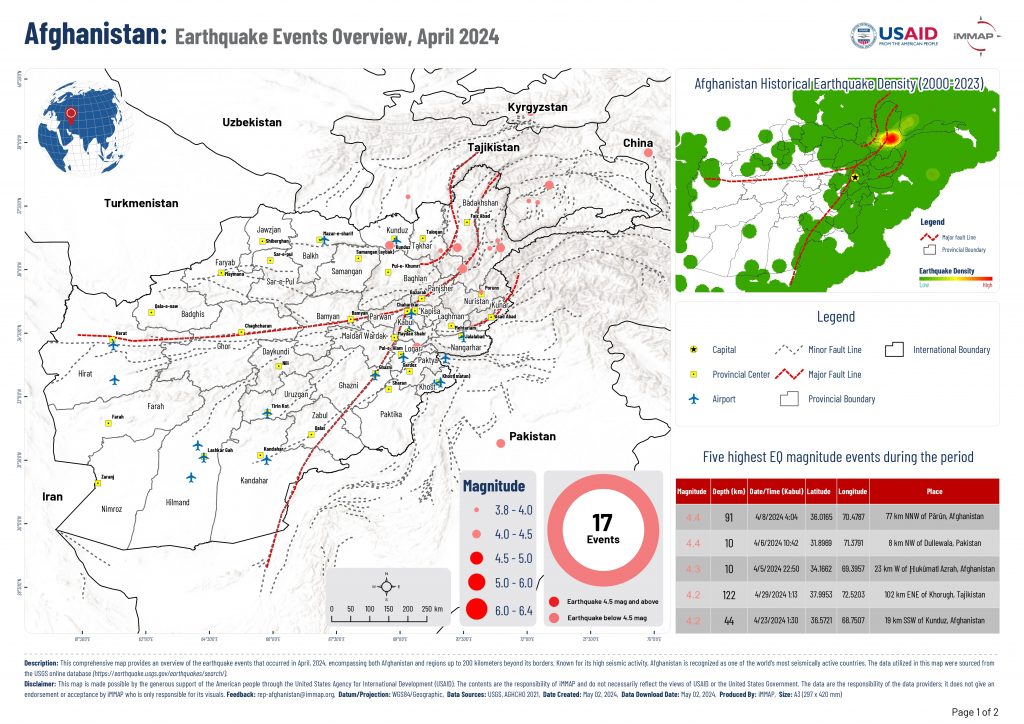
Afghanistan: Earthquake Events Overview (April 2024)
This map incorporates data from the USGS online database which provides a detailed overview of earthquake events, including magnitude, epicenter location and dates of occurrence. The geographical visualization aims to gaining a better understanding of the affected regions and the intensity of each seismic event. Furthermore, the first page provides a summary of earthquakes that took place in April 2024, while the second page illustrates a cumulative overview of earthquake events from January to April 2024.
Read more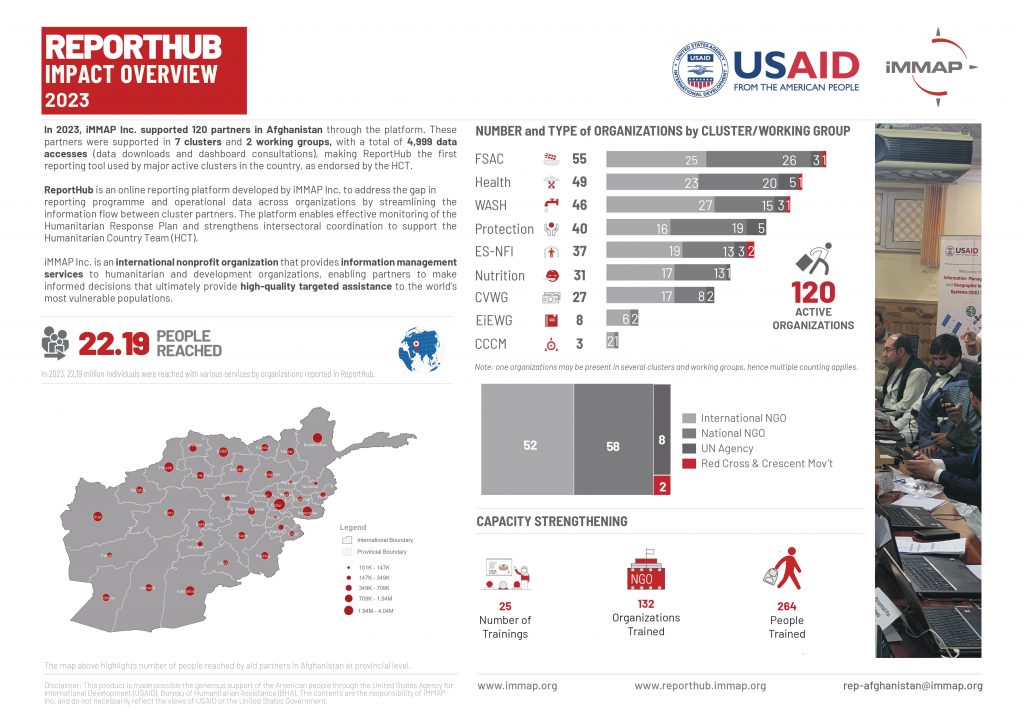
Afghanistan: ReportHub Impact Overview 2023
In 2023, ReportHub was the first reporting tool used by major active clusters in Afghanistan, as endorsed by the Humanitarian Country Team (HCT).
Read more
Exploring Perceptions and Opportunities for Agricultural Trainings in Afghanistan
The study "Exploring Perceptions and Opportunities for Agricultural Trainings in Afghanistan", conducted by the Afghanistan Food Security and Agriculture Cluster and iMMAP Inc., investigates the prospects for agricultural training in the context of Afghanistan's evolving social and economic environment. Concentrating on 405 households engaged in agriculture, the study seeks to understand their views on agricultural training programs.
Read more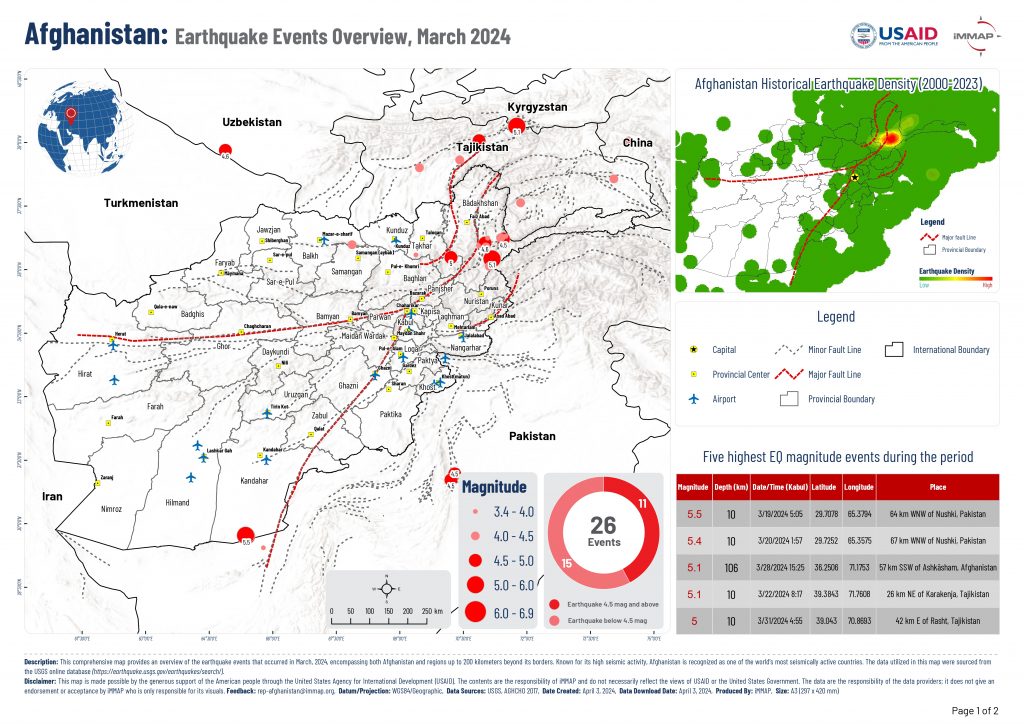
Afghanistan: Earthquake Events Overview (March 2024)
This map incorporates data from the USGS online database which provides a detailed overview of earthquake events, including magnitude, epicenter location and dates of occurrence. The geographical visualization is designed to provide a better understanding of the regions affected and the intensity of each seismic event. The first page summarizes earthquakes occurring in March 2024, while the second page presents a cumulative overview of earthquakes occurring between January and March 2024.
Read more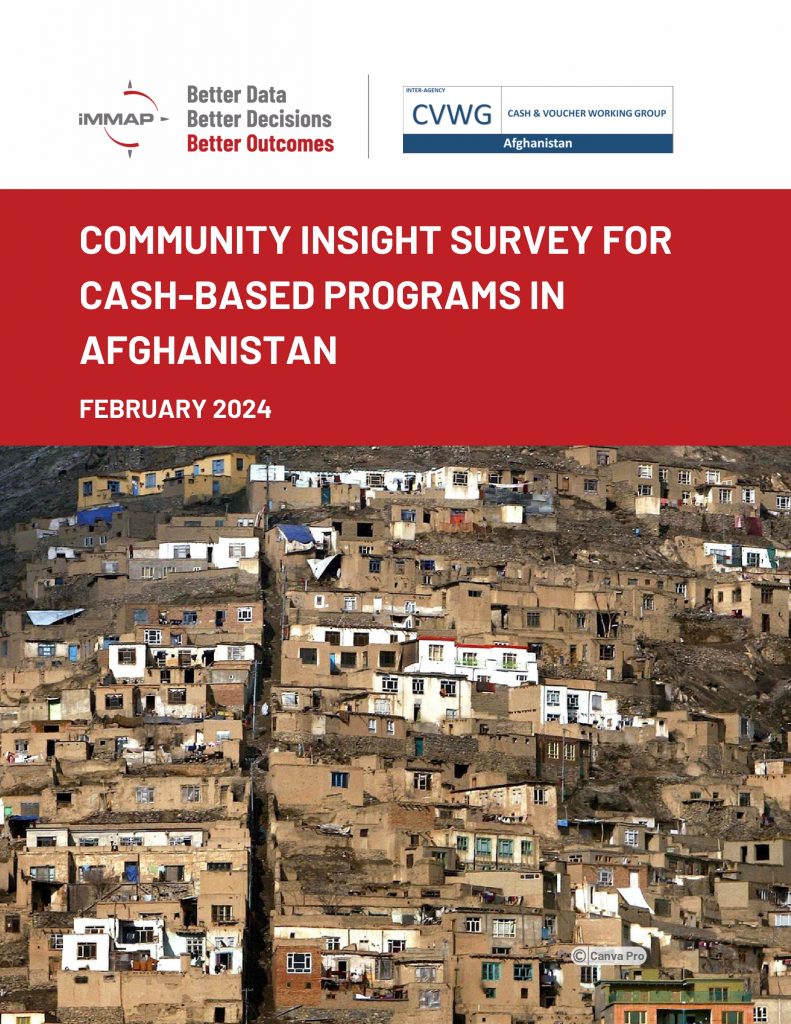
Afghanistan: Community Insight Survey for Cash-Based Programs (February 2024)
The Community Insight Survey for Cash-Based Programs by iMMAP Inc. in Afghanistan provides critical insights into the effectiveness of cash-based humanitarian assistance in the country.
Read more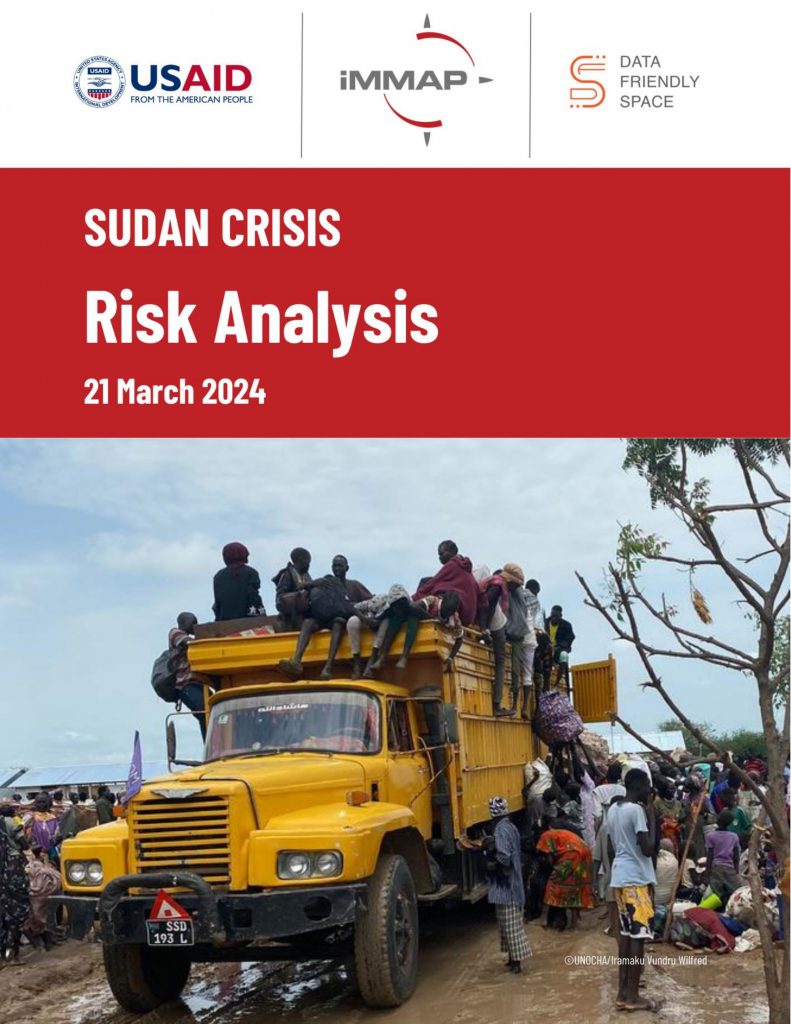
Sudan Crisis: Risk Analysis (March 2024)
The report highlights the urgent need for comprehensive humanitarian intervention in Sudan to address the multifaceted challenges faced by affected populations.
Read more
DRC: North Kivu Situation Overview
Since 2022, the eastern region of the Democratic Republic of Congo (DRC), in particular North-Kivu, has been gripped by a devastating conflict that has intensified and become increasingly complex over time, with the potential to reach alarming proportions. This crisis is characterized by a multitude of armed actors in conflict, a large displaced population and an even larger population in need of humanitarian aid.
Read more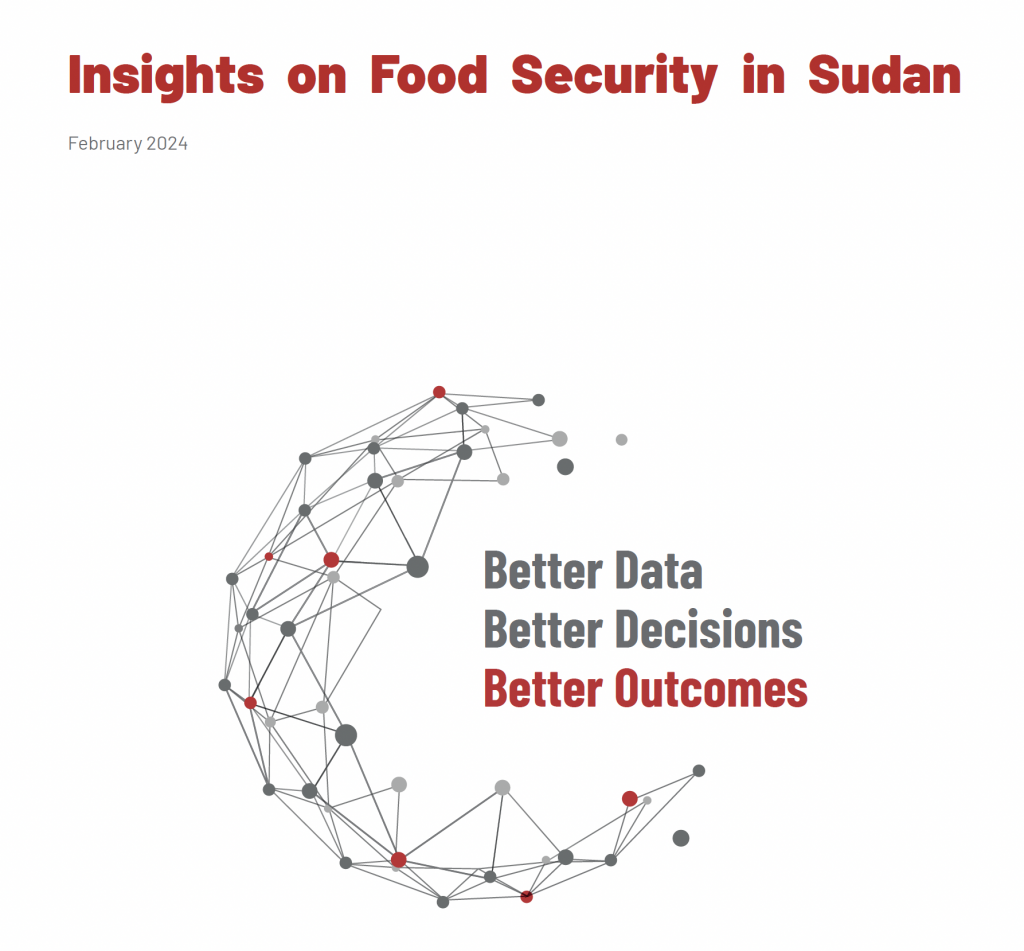
Insights on Food Security in Sudan (February 2024)
The food situation in Sudan is dire, with urban and rural areas both facing significant challenges.
Read more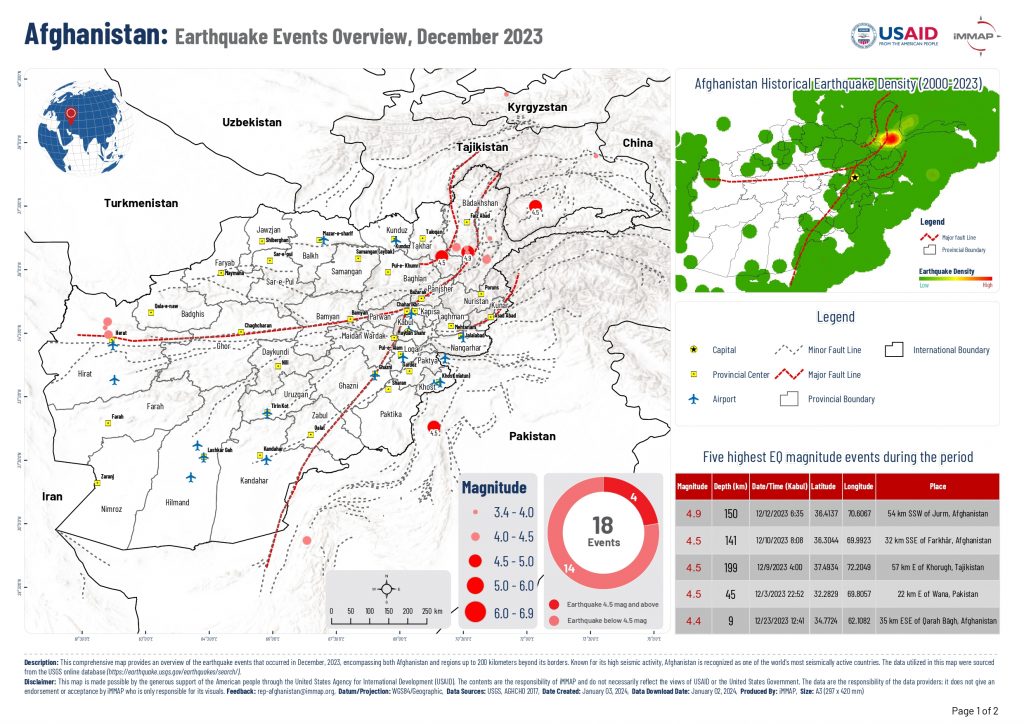
Afghanistan: Earthquake Events Overview (February 2024)
This map provides a detailed overview of earthquakes in Afghanistan and 200km beyond its borders. This includes magnitudes, epicenter locations, and dates of occurrences.
Read more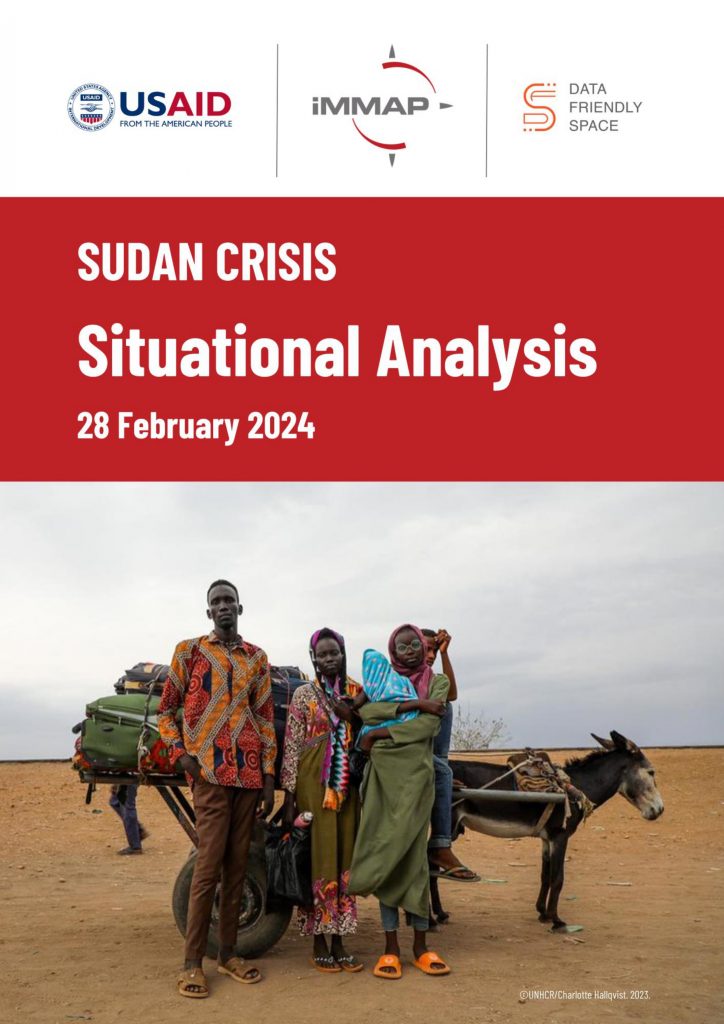
Situational Analysis of Sudan’s Crisis – February 2024
This report covers developments that occurred between December 2023 and January 2024. DFS and iMMAP Inc. follow a rigorous Secondary Data Review (SDR) process where all publicly available data on the humanitarian situation is consolidated into a database using an analytical framework based on the JIAF (see details on the DEEP platform in the Methodology Section). A comprehensive overview of the sources used to produce this report is provided in the Information sources section.
Read more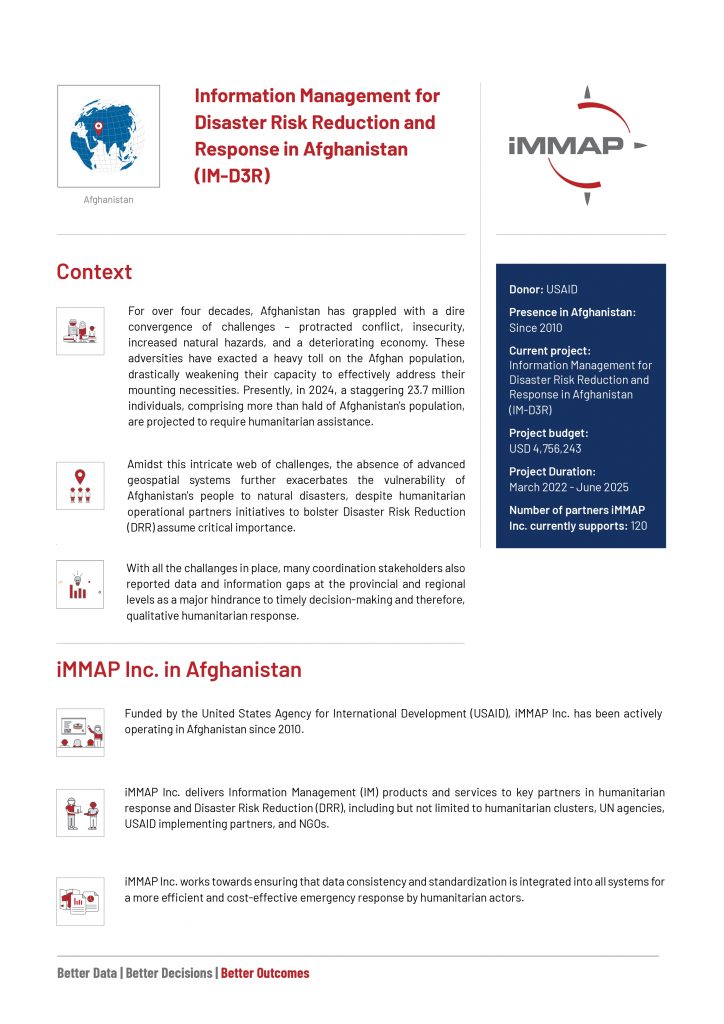
Information Management for Disaster Risk Reduction and Response in Afghanistan (Project Snapshot, February 2024)
iMMAP Inc. delivers Information Management (IM) products and services to key partners in humanitarian response and Disaster Risk Reduction (DRR), including but not limited to the humanitarian clusters, UN agencies, USAID implementing partners, and NGOs.
Read more
DRC: Situation Overview (December 2023)
The crisis in the Democratic Republic of Congo (DRC) is one of the world's most complex humanitarian situations. With 6.2 million people affected, the DRC is one of the countries with the highest number of internally displaced people in the world. In December, eastern DRC recorded the displacement of some 4,5689 households.
Read more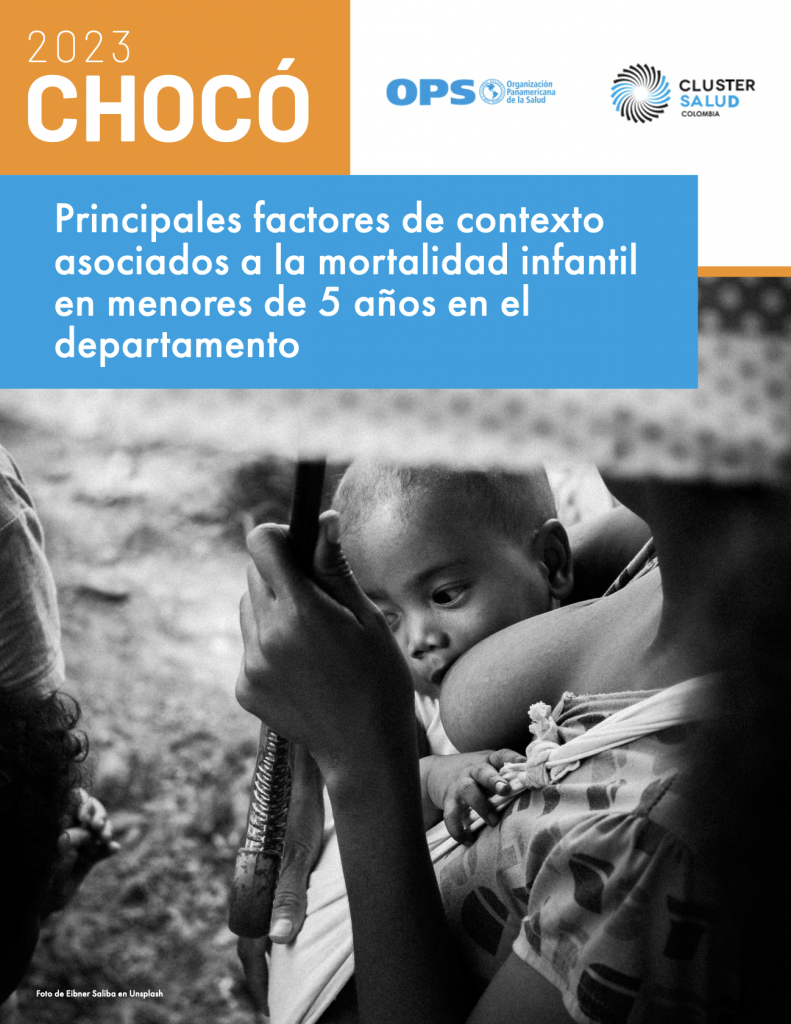
Chocó 2023: Principales factores de contexto asociados a la mortalidad infantil en menores de 5 años en el departamento
Este documento tiene como finalidad realizar un balance total de la situación de mortalidad infantil actual del departamento bajo el marco de los determinantes sociales de la salud.
Read more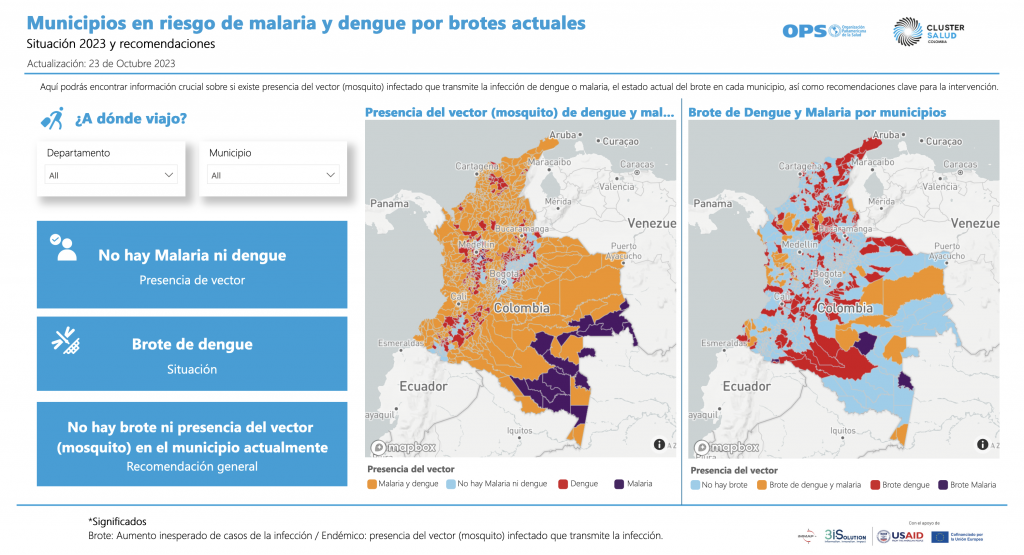
Colombia: Municipios colombianos con brotes de malaria y dengue 2023
Este tablero interactivo (dashboard) tiene como objetivo presentar la endemicidad para algunas enfermedades vectoriales y recomendaciones de precaución y signos de alerta.
Read more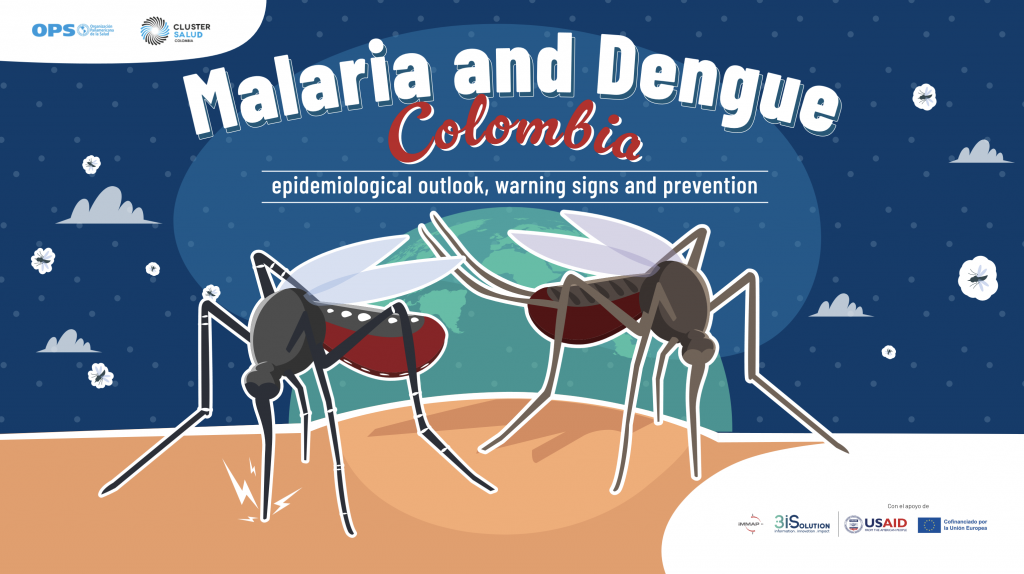
Epidemiological outlook, warning signs and prevention in Colombia 2023
Documento que tiene como objetivo informar la situación endémica, prevención y signos de alerta de malaria y dengue para personal que asiste a misiones y público en general.
Read more
Priorizacion departamental y municipal eventos de Salud Sexual y Reproductiva en el marco del Fenómeno de El Niño
Documento que tiene como objetivo estimar de forma cuantitativa una priorización departamental y municipal de los eventos en salud de salud sexual y reproductiva que de acuerdo a la evidencia científica podrían incrementar las tasas de incidencia y prevalencia durante el fenómeno de El Niño en Colombia 2023.
Read more
Capacidad instalada del Clúster Salud para atender emergencia del Fenómeno de El Niño en Colombia
Documento que tiene por objetivo socializar la capacidad instalada del Clúster de Salud para atención e intervenciones focalizadas en el marco del Fenómeno de El Niño en Colombia en 2023.
Read more
Análisis de posibles afectaciones directas en salud en el marco del Fenómeno de El Niño en Colombia
Documento que describe de forma resumida los impactos que tiene la variabilidad climática en la salud de las poblaciones. También presenta un pequeño apartado de algunas estimaciones basadas en modelos ARIMA utilizando regresores exógenos (temperatura)
Read moreInfografía análisis herramienta Emergency Response Tracker (ERT), Colombia Enero a Octubre 2023
Este documento tiene como objetivo proporcionar información de análisis, sobre la herramienta del Emergency Response Tracker (ERT), Colombia Enero a Octubre 2023.
Read more
Perspectivas de impacto: Afectaciones segunda temporada seca, evolución de segunda temporada de lluvias en el cuarto trimestre del año 2023
Este documento tiene como objetivo visibilizar los impactos en la segunda temporada de menos lluvias que comprenden los meses de julio, agosto y septiembre e indagar posibles afectaciones respecto a eventos de inundación y deslizamientos que pueden presentarse en los meses de octubre, noviembre y diciembre del 2023.
Read more
Colombia: Ranking de las entidades territoriales que presentan mayor recurrencia de eventos por tipo de fenómeno
Este tablero interactivo permite visualizar las entidades territoriales que han tenido mayores eventos por tipo de fenómeno hidrometereologico (temporada invernal (inundaciones, avenidas torrenciales y movimientos en masa) y temporada seca (sequía e incendios forestales))
Read more
Colombia: Análisis situacional de las condiciones del Caudal del Río Amazonas, oct 2023
Este mapa situacional tiene como objetivo mostrar el cauce mínimo histórico que experimentó el río Amazonas en los meses de oct y nov del 2023.
Read more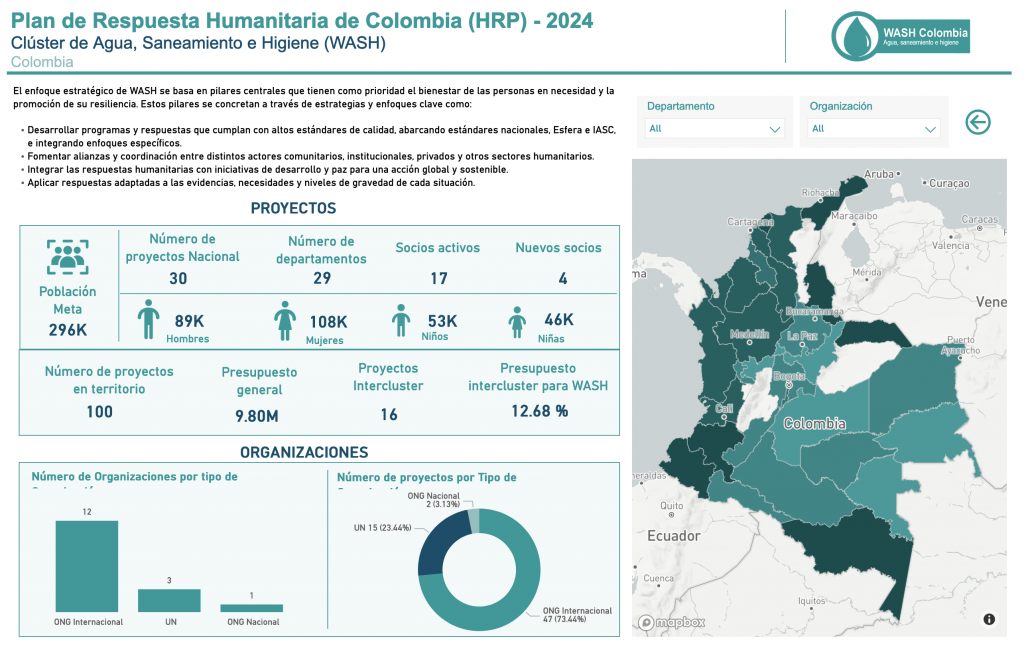
Plan de respuesta Humanitaria de Colombia (HRP)- 2024
Este tablero interactivo tiene como objetivo proporcionar un análisis de los proyectos aprobados por el clúster WASH para el año 2024 dentro del Plan de Respuesta Humanitaria (HRP). En el dashboard se pueden observar las diferencias entre los proyectos del año 2023 y 2024, así como un análisis más detallado del año 2024, donde se mostrará el presupuesto necesario, la proyección poblacional por indicadores y por territorio.
Read more
Análisis del Cálculo de Personas en Necesidad (PiN) para Necesidades WASH en el Departamento de Nariño para el Año 2024
Esta infografía ofrece un resumen general del cálculo de Personas en Necesidad (PiN) para el año 2024 en el departamento de Nariño, específicamente en relación con las necesidades de Agua, Saneamiento e Higiene (WASH).
Read more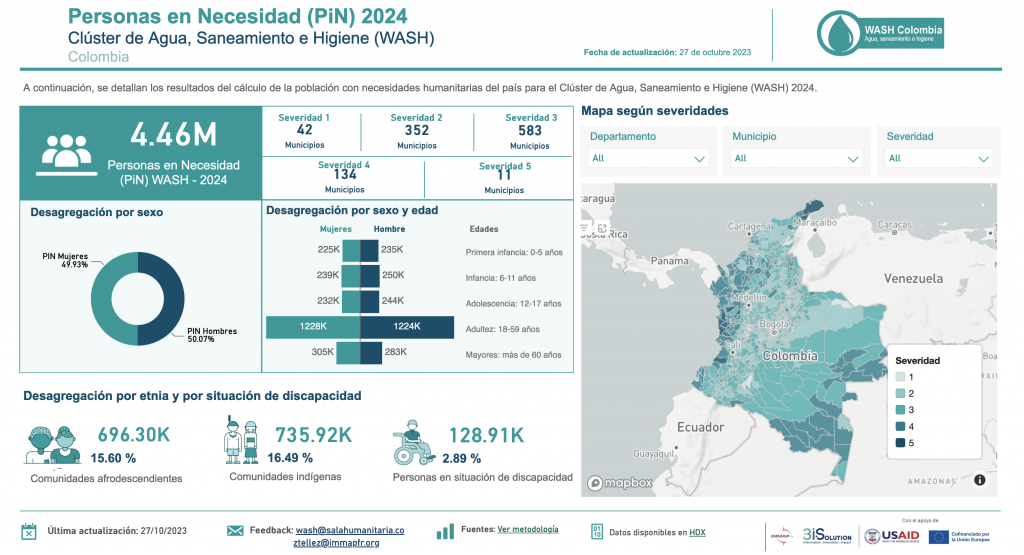
Colombia: Personas en necesidad (PiN) 2024 WASH
Este tablero interactivo tiene como objetivo visualizar los resultados del PiN WASH 2024.
Read more
Nota metodológica - Cálculo de Personas en Necesidad (PiN) WASH 2024, Colombia
Este documento tiene como objetivo detallar el ejercicio para obtener el cálculo final de las personas en necesidad (PiN) y las severidades para el clúster WASH 2024.
Read more
Reporte de actividades para Agua, Saneamiento e Higiene (WASH) para del Departamento de Choco del año 2023
Este documento tiene como objetivo describir las actividades que están en desarrollo o han sido ejecutadas en relación con el Clúster de Agua, Saneamiento e Higiene (WASH, por sus siglas en inglés) durante el año 2023, con datos recopilados hasta octubre del mismo año.
Read more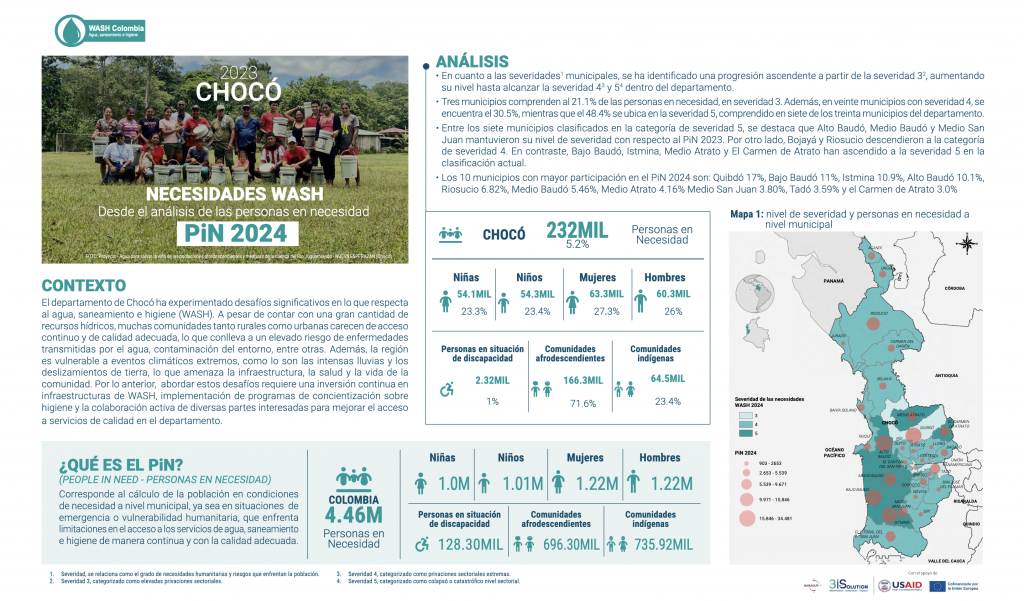
Colombia: Análisis del Cálculo de Personas en Necesidad (PiN) para Necesidades WASH en el Departamento de Chocó para el Año 2024
Colombia: Análisis del Cálculo de Personas en Necesidad (PiN) para Necesidades WASH en el Departamento de Chocó para el Año 2024
Read more
Seguimiento 345W Colombia - 2023 Clúster Agua, Saneamiento e Higiene (WASH)
Este tablero interactivo busca visibilizar la respuesta brindada en el año 2023 para el Clúster de Agua, Saneamiento e Higiene (WASH). Esta información es tomada del sistema 345W; el Sistema de Información 345W es una herramienta informática en línea que permite conocer las actividades de respuesta desarrolladas por organizaciones tales como agencias del Sistema de las Naciones Unidas y ONG's.
Read more
Colombia: Infografía de monitoreo a la respuesta arquitectura GIFMM - noviembre 2023
Documento que tiene como objetivo mostrar las cifras de repuesta humanitaria para el subsector de protección de la niñez de Enero a Octubre de 2023.
Read more
Colombia: Infografía análisis de la evaluación de necesidades de población migrante con Vocación de Permanencia
Documento que tiene como objetivo mostrar los resultados obtenidos de la identificación de riesgos de protección en niños, niñas y adolescentes en las evaluaciones de necesidades realizadas a población con vocación de permanencia.
Read more
Colombia: Identificación de riesgos de protección a partir de la evaluación de necesidades en población migrante en transito
Documento que tiene como objetivo mostrar los resultados obtenidos de la identificación de riesgos de protección en niños, niñas y adolescentes en las evaluaciones de necesidades realizadas a población en Tránsito.
Read more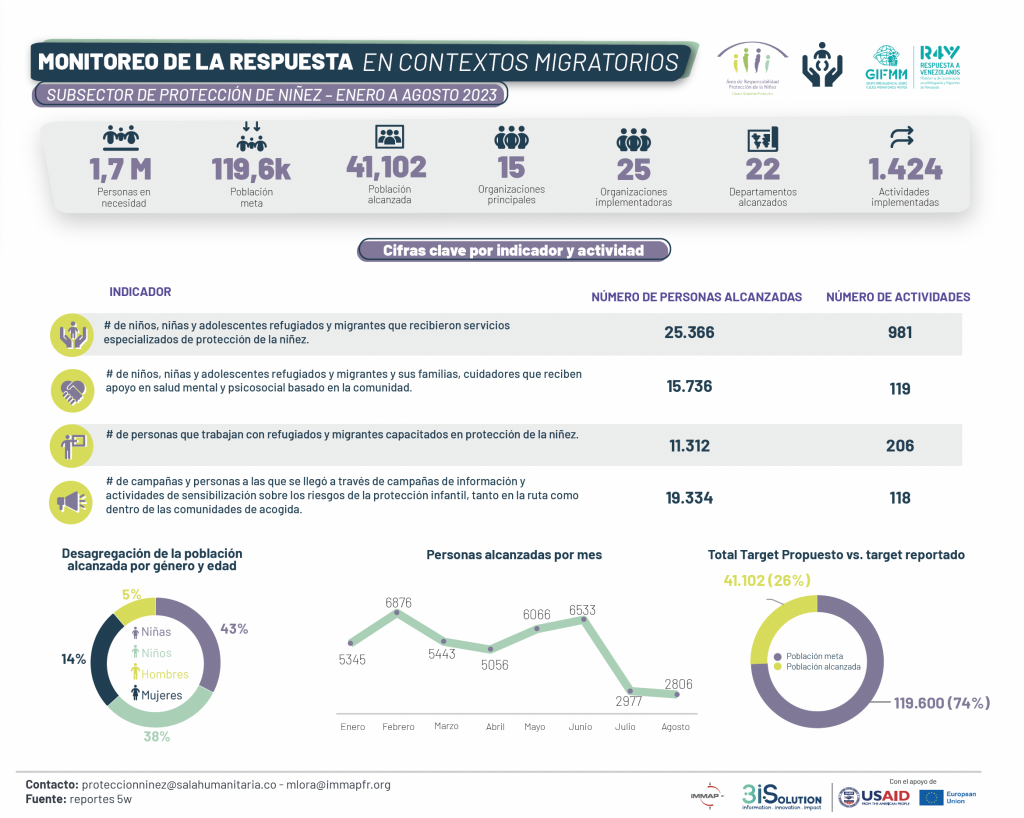
Infografía de monitoreo a la respuesta de la arquitectura humanitaria GIFMM - octubre 2023
Este documento tiene como objetivo mostrar el monitoreo a la respuesta de la arquitectura humanitaria GIFMM - octubre 2023.
Read more
Infografía de monitoreo a la respuesta de la arquitectura humanitaria OCHA - octubre 2023
Este documento tiene el objetivo de presentar el monitoreo a la respuesta de la arquitectura humanitaria OCHA - octubre 2023
Read more
Colombia: Infografía de situación de protección de niñez migrante octubre - 2023
Este documento tiene como objetivo presentar un resumen de las afectaciones por eventos de variabilidad climática, conflicto armado y niñez no acompañada a niños, niñas adolescentes. También, muestra un análisis y cifras de trata, tráfico y explotación sexual de niños niñas y adolescentes migrantes desde 2019 al 2023.
Read more
Infografía de monitoreo a la respuesta de la arquitectura humanitaria OCHA - septiembre 2023
En esta infografía se realiza el seguimiento a las actividades, beneficiarios alcanzados y organizaciones que implementan proyectos para niños, niñas y adolescentes dentro de la arquitectura humanitaria de OCHA.
Read more
Dashboard PiN Área de Responsabilidad de Niñez 2024, Colombia
En este dashboard se encuentran los datos obtenidos del cálculo de personas en necesidad o PiN para el año 2024 de acuerdo a los indicadores seleccionados por el Área de responsabilidad de la Niñez.
Read more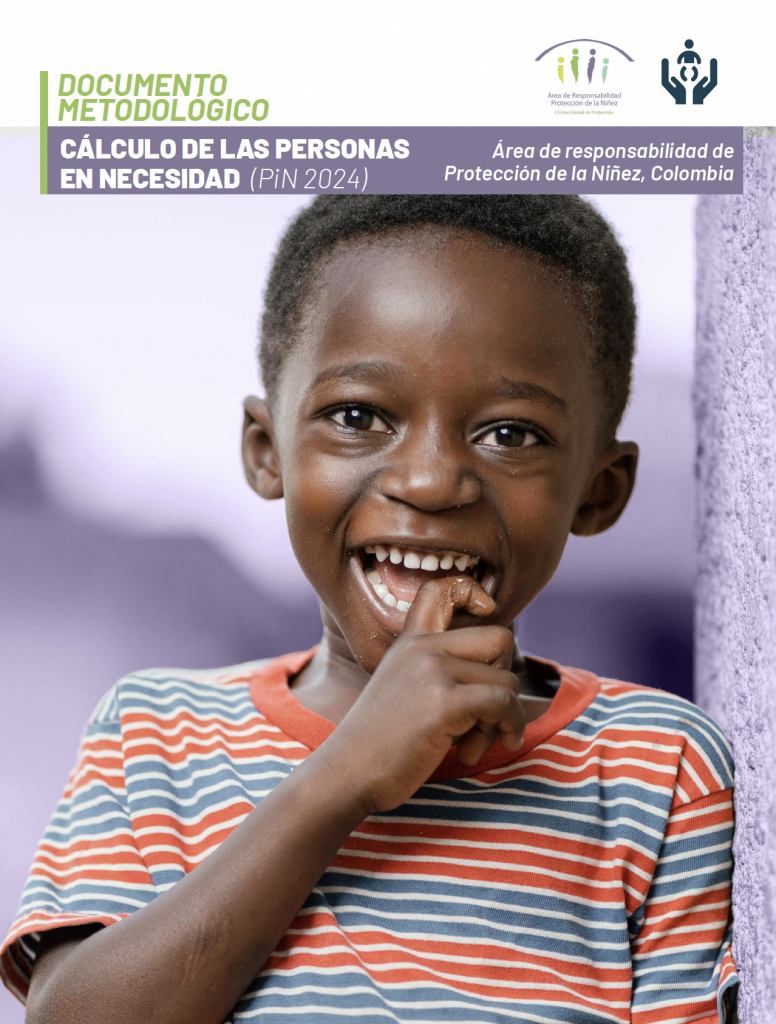
Nota metodológica del cálculo del PiN del Área de Responsabilidad de Protección Niñez 2024, Colombia
Documento que tiene como objetivo describir la metodología utilizada para realizar el cálculo de personas en necesidad o PiN para el año 2024 de acuerdo con los indicadores seleccionados por el Área de responsabilidad de la Niñez en Colombia.
Read more
Colombia: Situación de protección de niñez refugiada y migrante
Este documento tiene como objetivo describir la situación de protección de la niñez migrante afectada por conflicto armado, desastres naturales y los riesgos a la niñez no acompañada y/o separada de sus padres o cuidadores.
Read more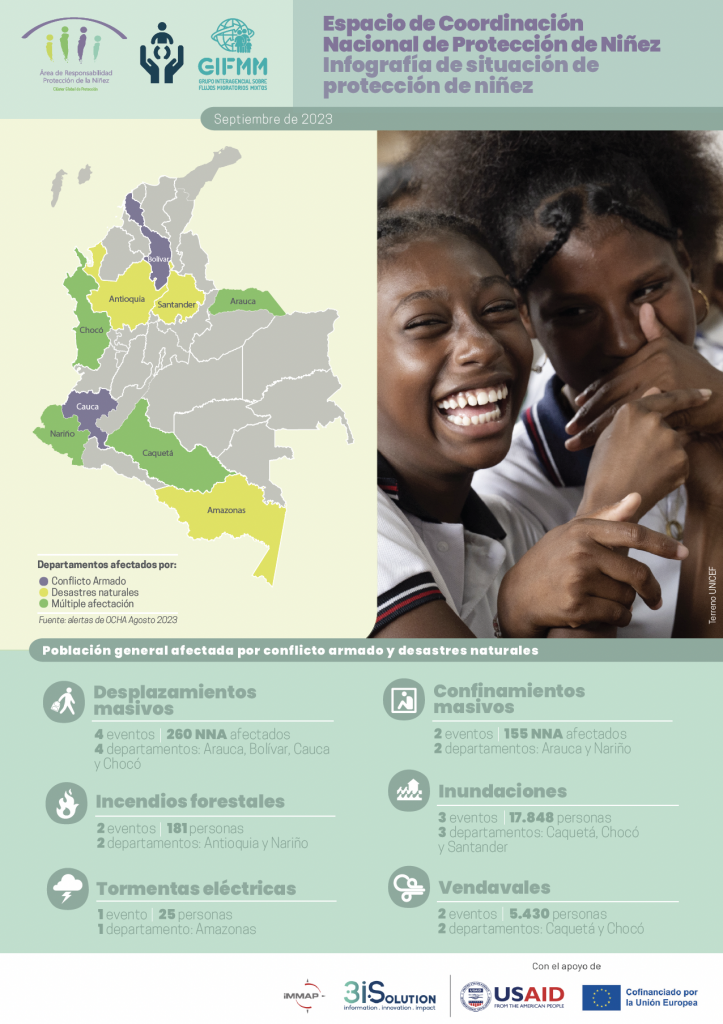
Colombia: Espacio de Coordinación Nacional de Protección de Niñez (septiembre 2023)
Documento que tiene como objetivo mostrar describir la situación de protección de la niñez general afectada por conflicto armado y desastres naturales.
Read more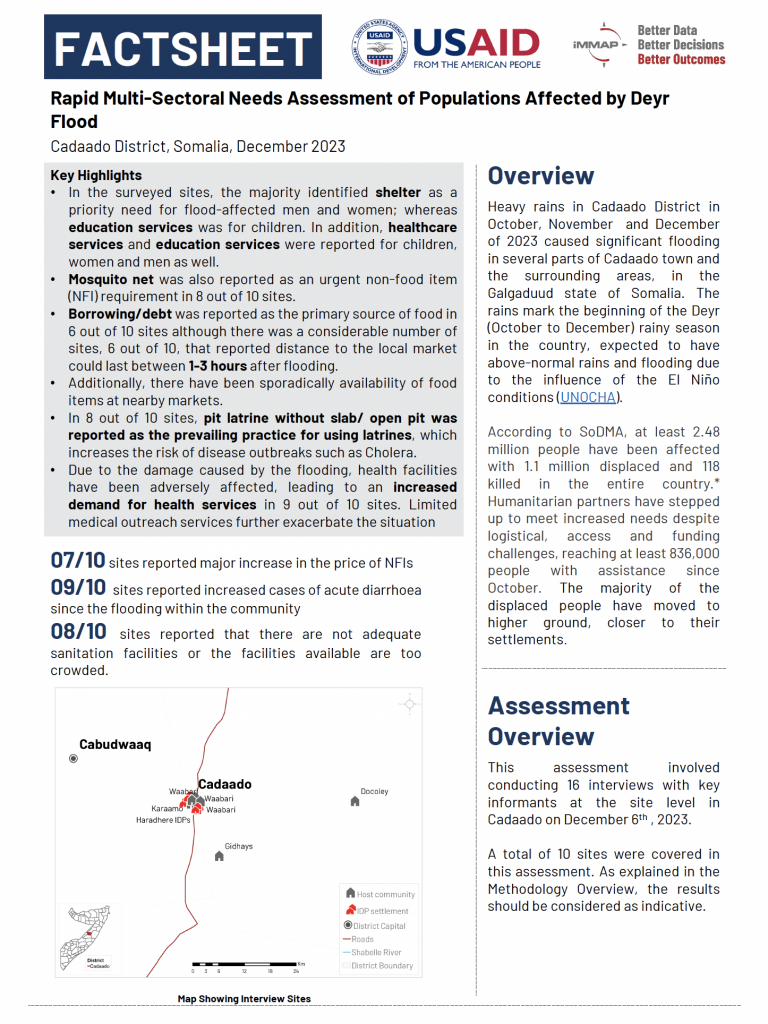
Somalia: Rapid Multi-sectoral Needs Assessment of populations affected by Deyr flooding - Cadaado district
This document assesses the needs of the population affected by the floods in Cadaado district and its surroundings, in the South West state of Somalia.
Read more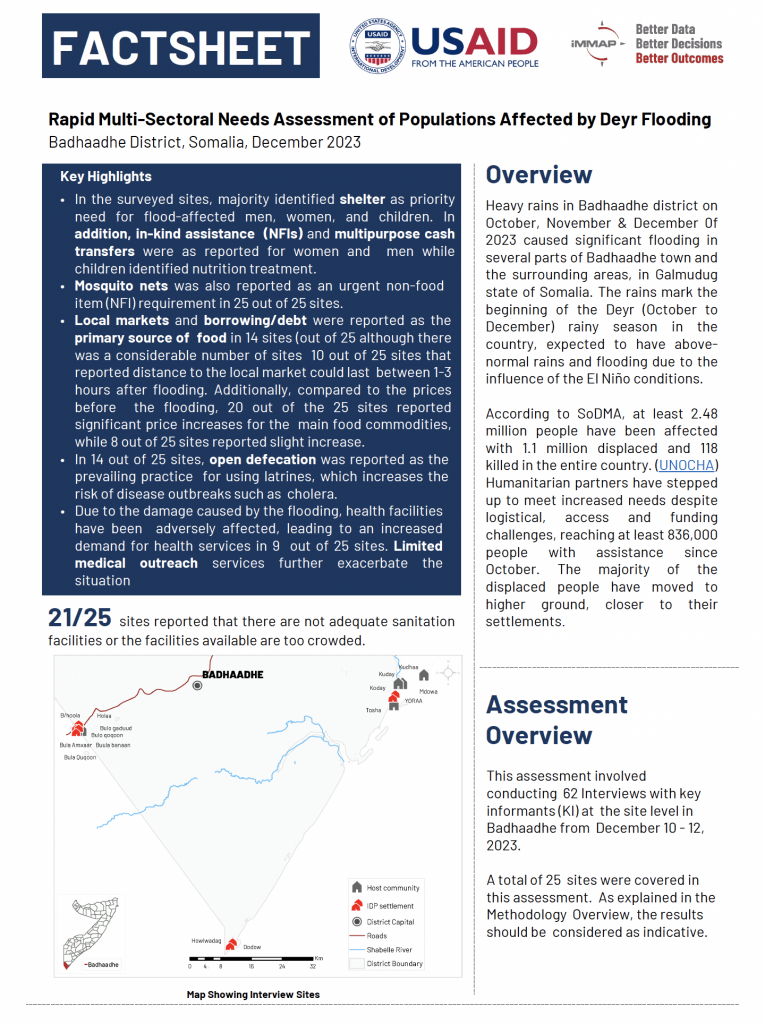
Somalia: Rapid Multi-sectoral Needs Assessment of populations affected by Deyr flooding - Badhaadhe district
This document assesses the needs of the population affected by the floods in Badhaadhe district and its surroundings, in the South West state of Somalia.
Read more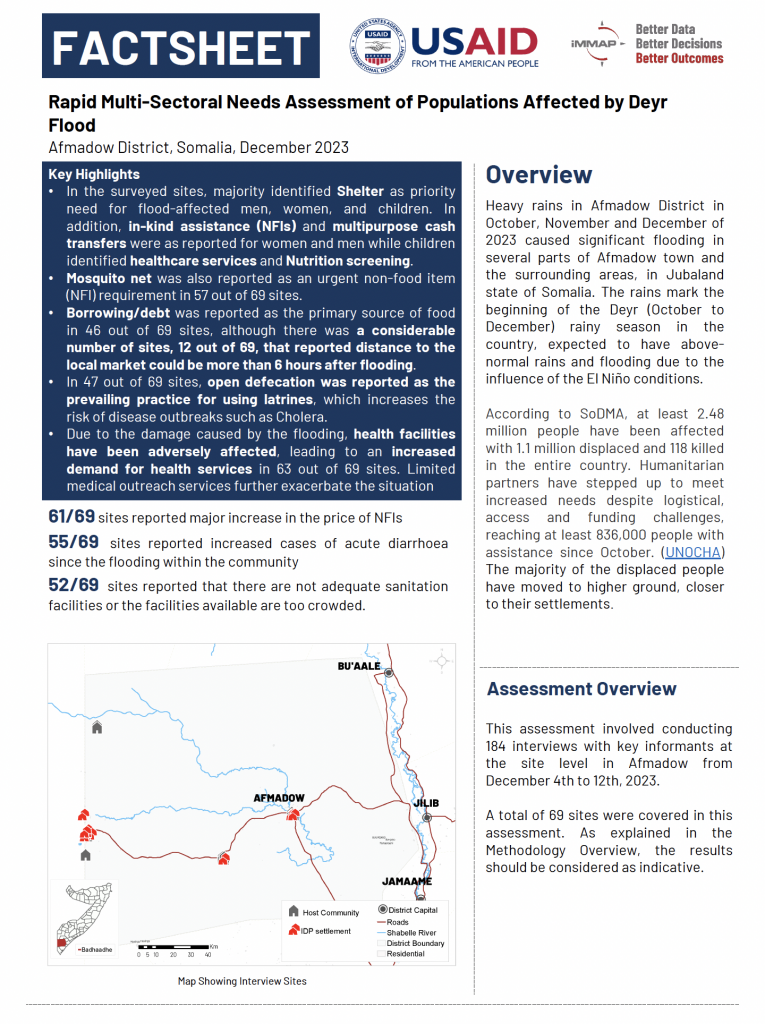
Somalia: Rapid Multi-sectoral Needs Assessment of populations affected by Deyr flooding - Afmadow district
This document assesses the needs of the population affected by the floods in Afmadow district and its surroundings, in the South West state of Somalia.
Read more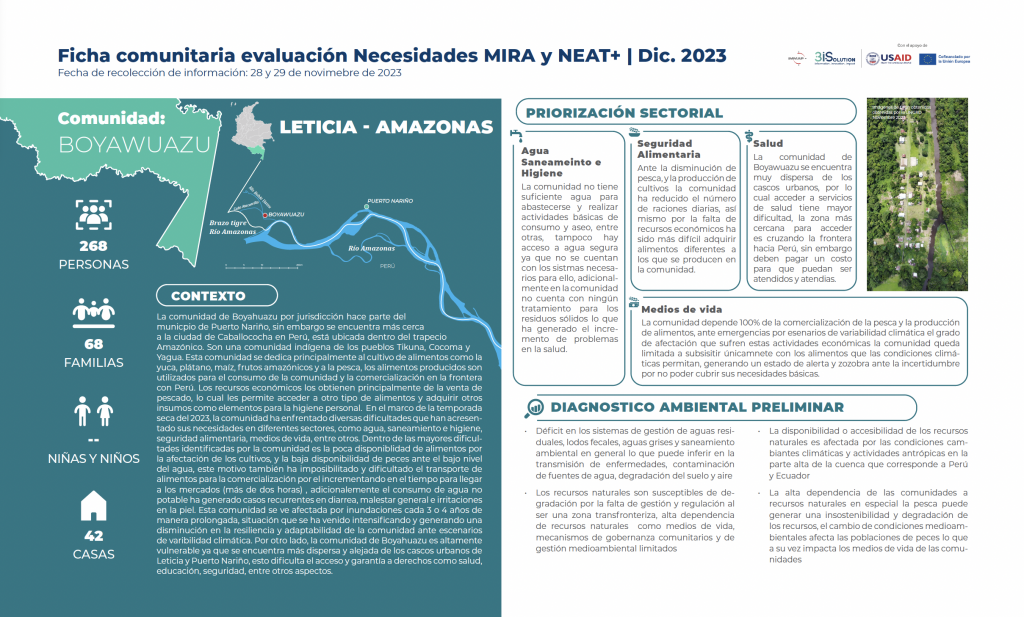
Colombia: Fichas comunitarias evaluación Necesidades MIRA y NEAT+ | Dic. 2023- Comunidad Boyawuazu
Este documento tiene como objetivo mostrar un análisis de las valuaciones y los principales hallazgos de las necesidades sectoriales identificadas en la comunidad de Boyawuazu.
Read more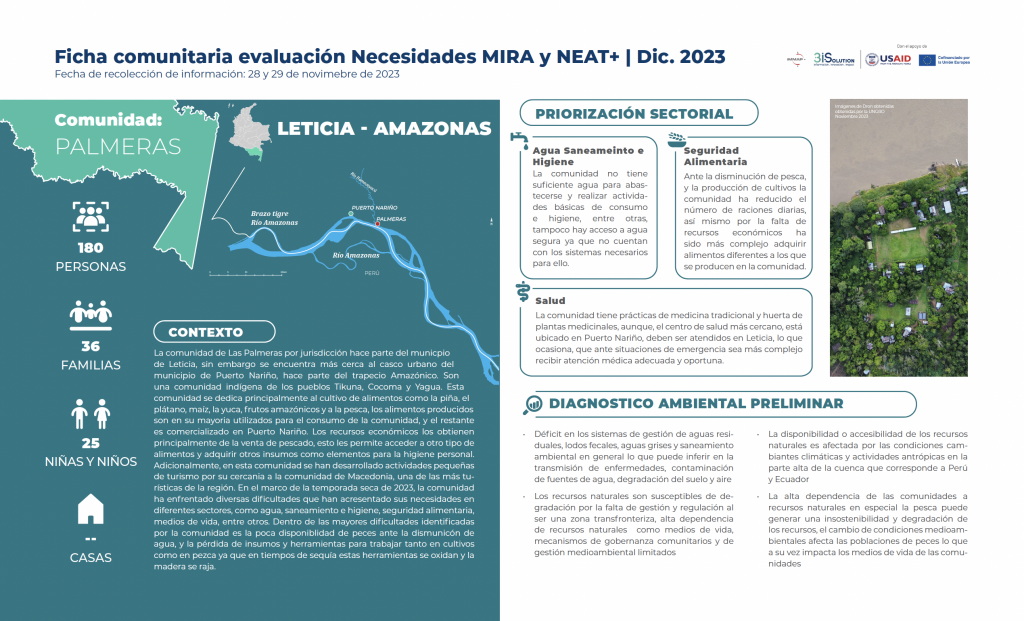
Colombia: Fichas comunitarias evaluación Necesidades MIRA y NEAT+ | Dic. 2023- Comunidad Palmeras
Este documento tiene como objetivo mostrar un análisis de las valuaciones y los principales hallazgos de las necesidades sectoriales identificadas en Palmeras, Amazonas.
Read more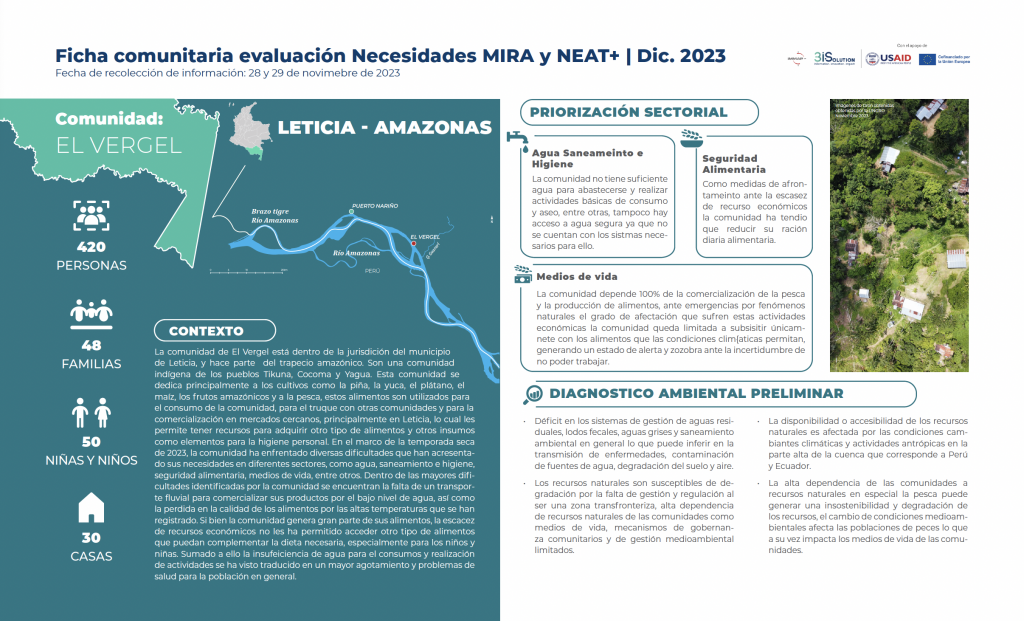
Colombia: Fichas comunitarias evaluación Necesidades MIRA y NEAT+ | Dic. 2023- Comunidad El Vergel
Este documento tiene como objetivo mostrar un análisis de las valuaciones y los principales hallazgos de las necesidades sectoriales identificadas en El Vergel, Amazonas.
Read more
Colombia: Evaluación Inicial y Rápida Multi-clúster/sectorial - MIRA
Este tablero interactivo tiene como objetivo mostrar La Evaluación Inicial y Rápida Multi-cluster/sectorial, en el cual se evidencia el marco para evaluaciones de necesidades que se realizan entre las primeras 72 horas (Fase I) y las primeras dos semanas (Fase 2) después de una crisis.
Read more
Colombia/Guainía: Evaluaciones de necesidades 2022 - 2023
Documento que tiene como objetivo mostrar un análisis cualitativo y cuantitativo con las cifras principales de evaluaciones y los principales hallazgos de las necesidades sectoriales identificadas en Guainía.
Read more
Colombia/Chocó: Evaluaciones de necesidades 2022 - 2023
Documento que tiene como objetivo mostrar un análisis cualitativo y cuantitativo con las cifras principales de evaluaciones y los principales hallazgos de las necesidades sectoriales identificadas en Chocó
Read more
Colombia/Nariño: Evaluaciones de necesidades 2022 - 2023
Documento que tiene como objetivo mostrar un análisis cualitativo y cuantitativo con las cifras principales de evaluaciones y los principales hallazgos de las necesidades sectoriales identificadas en Nariño.
Read more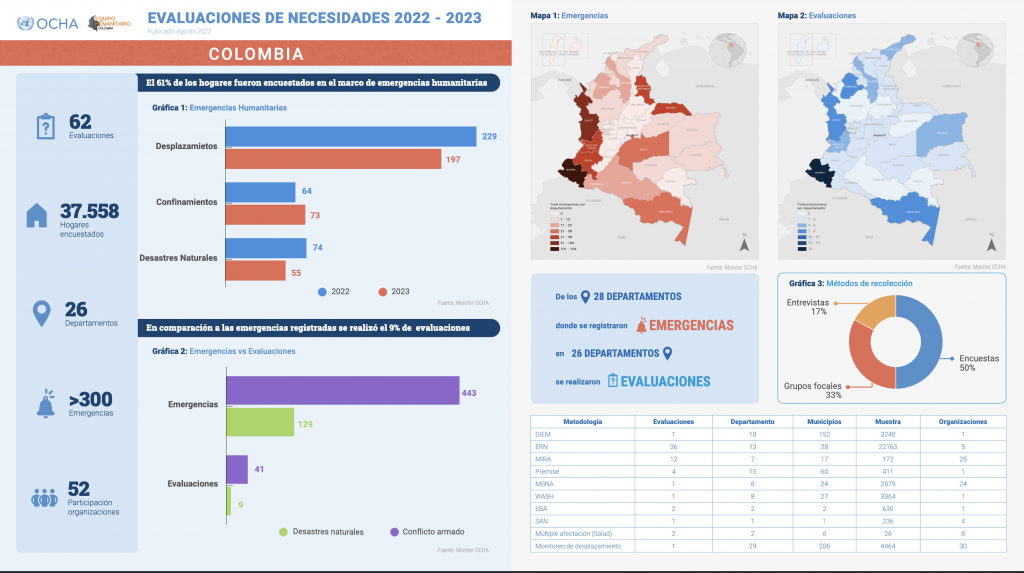
Colombia/La Guajira: Evaluaciones de necesidades 2022 - 2023
Documento que tiene como objetivo mostrar un análisis cualitativo y cuantitativo con las cifras principales de evaluaciones y los principales hallazgos de las necesidades sectoriales identificadas en La Guajira.
Read more
Colombia/Caquetá: Evaluaciones de necesidades 2022 - 2023
Documento que tiene como objetivo mostrar un análisis cualitativo y cuantitativo con las cifras principales de evaluaciones y los principales hallazgos de las necesidades sectoriales identificadas en el Caquetá.
Read more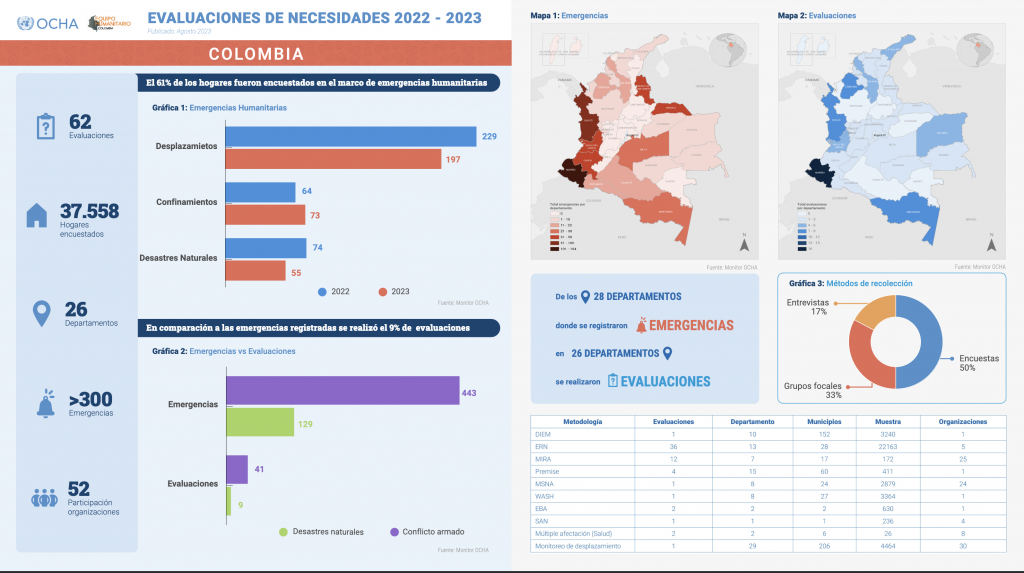
Colombia/Valle del Cauca: Evaluaciones de necesidades 2022 - 2023
Documento que tiene como objetivo mostrar un análisis cualitativo y cuantitativo con las cifras principales de evaluaciones y los principales hallazgos de las necesidades sectoriales identificadas en el Valle del Cauca.
Read more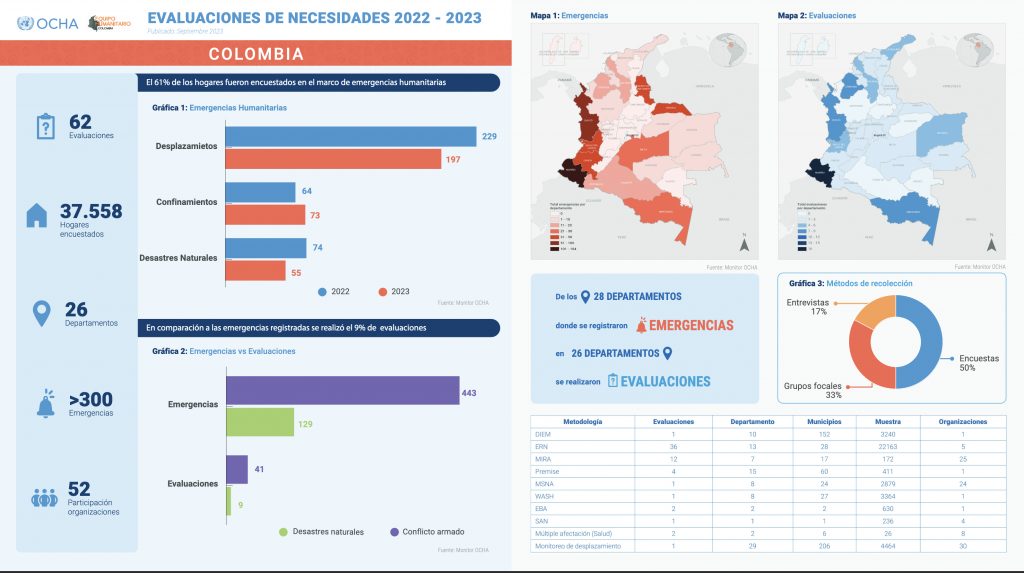
Colombia/Amazonas: Evaluaciones de necesidades 2022 - 2023
Documento que tiene como objetivo mostrar un análisis cualitativo y cuantitativo con las cifras principales de evaluaciones y los principales hallazgos de las necesidades sectoriales identificadas en el Amazonas.
Read more
Colombia/Cauca: Evaluaciones de necesidades 2022 - 2023
Documento que tiene como objetivo mostrar un análisis cualitativo y cuantitativo con las cifras principales de evaluaciones y los principales hallazgos de las necesidades sectoriales identificadas en el Cauca.
Read more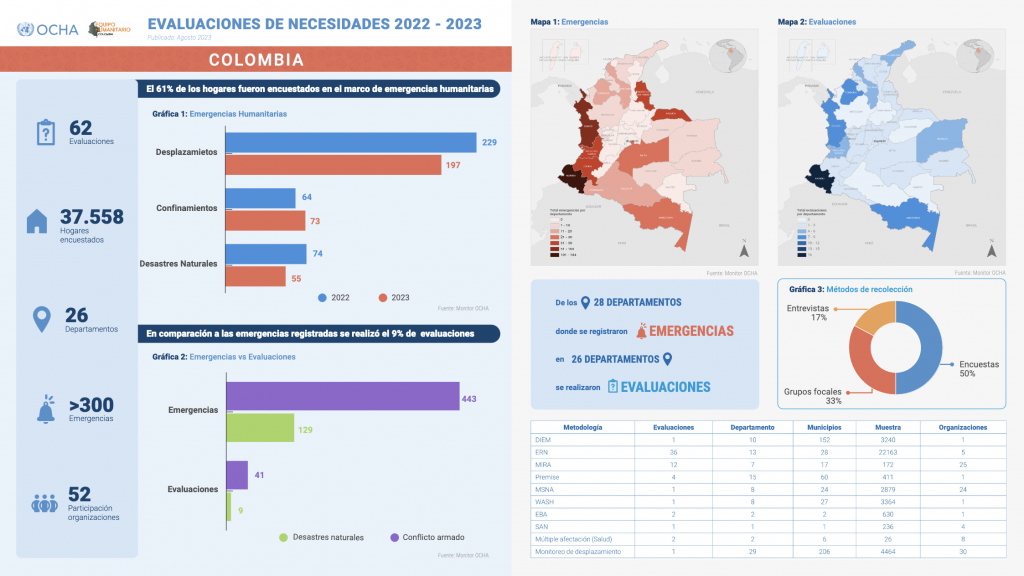
Colombia/Norte de Santander: Evaluaciones de necesidades 2022 - 2023
Documento que tiene como objetivo mostrar un análisis cualitativo y cuantitativo con las cifras principales de evaluaciones y los principales hallazgos de las necesidades sectoriales identificadas en Norte de Santander
Read more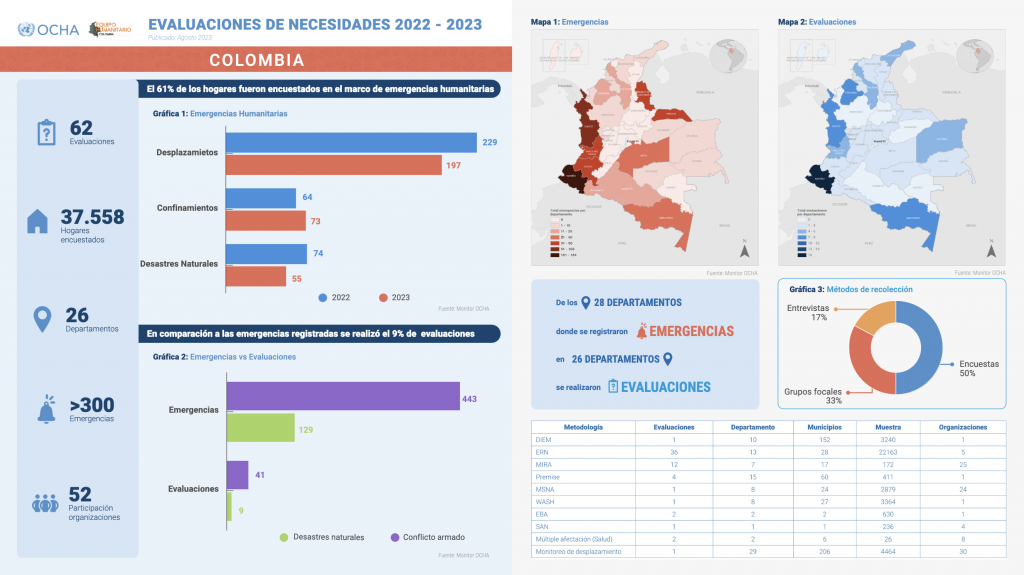
Colombia/Córdoba: Evaluaciones de necesidades 2022 - 2023
Documento para mostrar un análisis cualitativo y cuantitativo con las cifras principales de evaluaciones y los principales hallazgos de las necesidades sectoriales identificadas en Córdoba, socializada en el taller regional del HNO.
Read more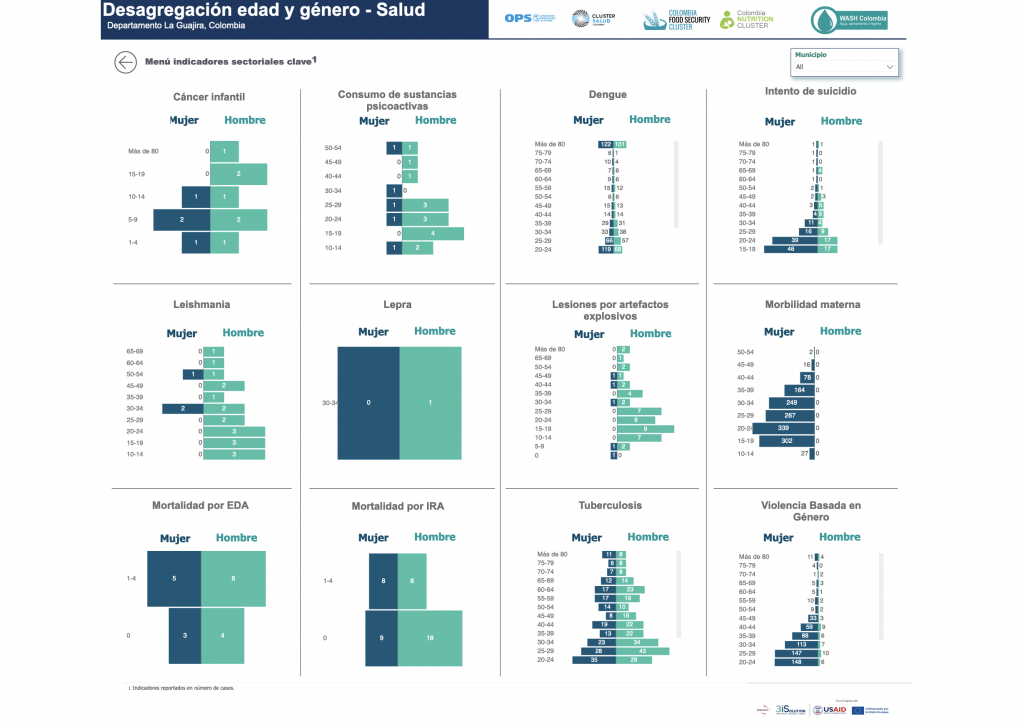
Colombia: Dashboard intersectorial La Guajira - Salud, WASH, SAN
Este tablero interactivo tiene como objetivo describir la proyección de la respuesta teniendo en cuenta el PiN, los proyectos de los socios para 2024, el target y las prioridades del del Clúster SAN.
Read more
Colombia: Proyección de la respuesta HRP 2024
Este tablero interactivo tiene como objetivo describir la proyección de la respuesta teniendo en cuenta el PiN, los proyectos de los socios para 2024, el target y las prioridades del del Clúster SAN.
Read more
Colombia: Resultados evaluación sectorial afectación por la incidencia del fenómeno meteorológico de el niño en comunidades indígenas de Amazonas
Este documento tiene como objetivo mostrar los resultados de la evaluación sectorial de SAN realizada en Amazonas en el marco de la alerta emitida por OCHA por la afectación de las comunidades indígenas ribereñas por la sequía.
Read more
Colombia: nota metodológica, estimación de las personas en necesidad
Documento que tiene como objetivo describir el cálculo del PiN de seguridad alimentaria y nutrición
Read more
Situación de seguridad alimentaria y nutricional de Vichada
Este documento tiene como objetivo describir la situación de seguridad alimentaria y nutricional de Vichada.
Read more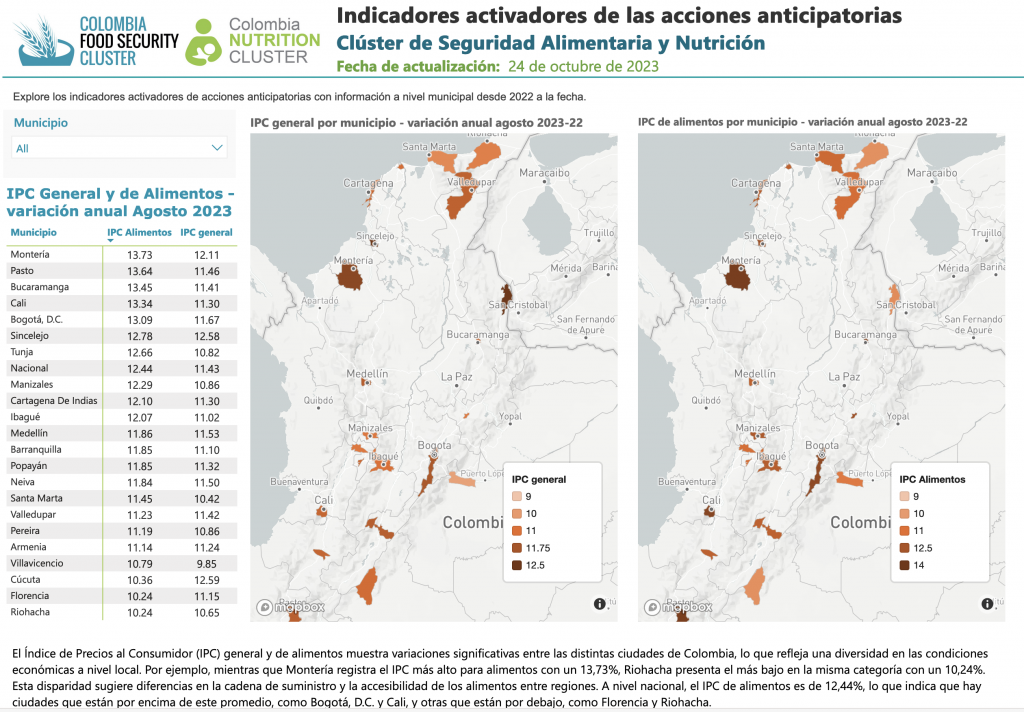
Indicadores activadores de las acciones anticipatorias de SAN
Este tablero interactivo tiene como objetivo monitorear los indicadores activadores de las acciones anticipatorias de SAN.
Read more
Colombia: Fenómeno de El Niño - Susceptibilidad y afectación en Seguridad alimentaria y Nutrición
Este documento tiene como objetivo mostrar mensajes claves cuantitativos y cualitativos del clúster SAN ante el Fenómeno de El Niño.
Read more
Mapeo de socios La Guajira: Clúster de Seguridad Alimentaria y Nutrición
Este dashboard tiene como objetivo mostrar el mapeo de la presencia territorial de las Organizaciones e Instituciones del clúster de SAN en La Guajira.
Read more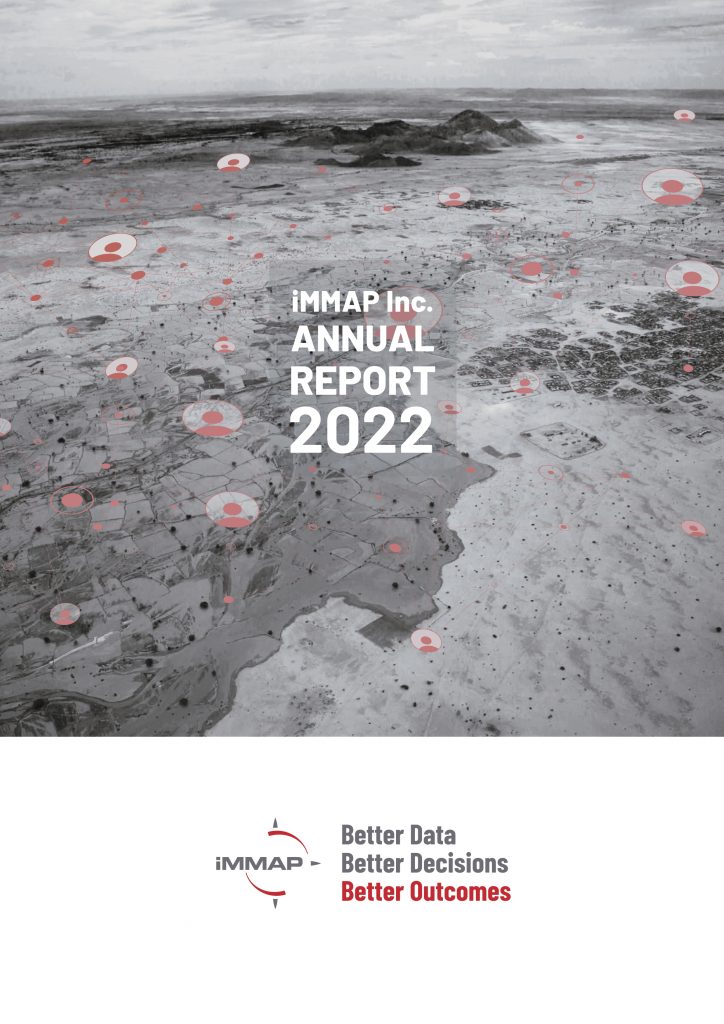
Annual Report 2022
In 2022, iMMAP Inc. continued its impactful journey in the humanitarian and development sectors, driving positive change through strategic information management and global partnerships.
Read more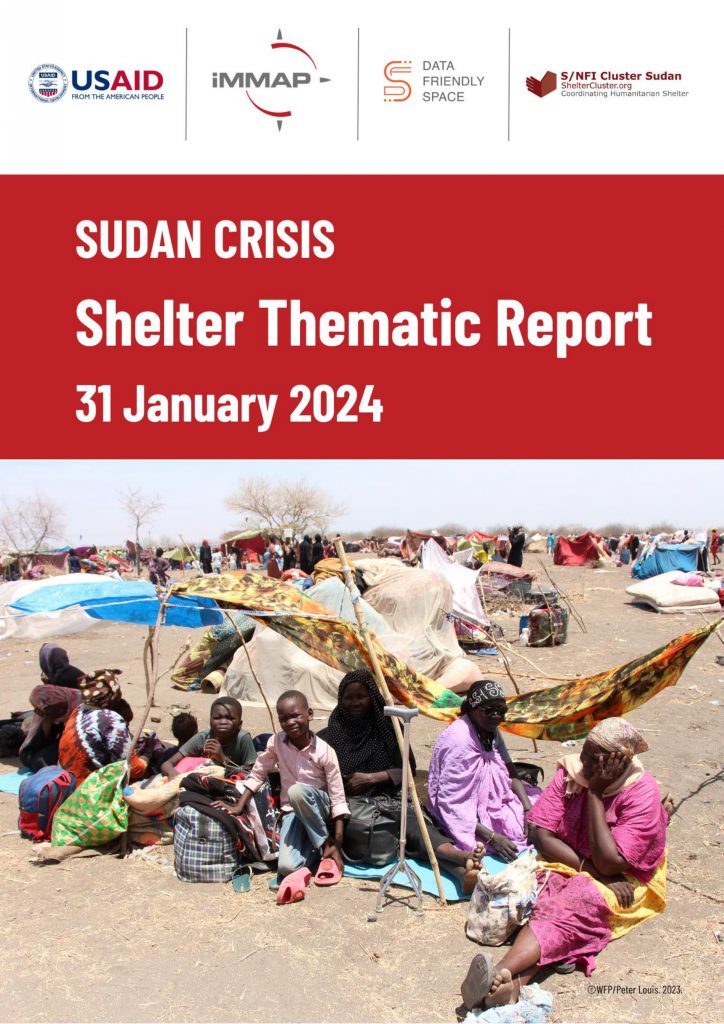
Sudan Crisis: Shelter Thematic Report (January 2024)
The report aims to analyze the secondary impacts of shelter issues in Sudan and discuss possible solutions leveraging existing capacities.
Read more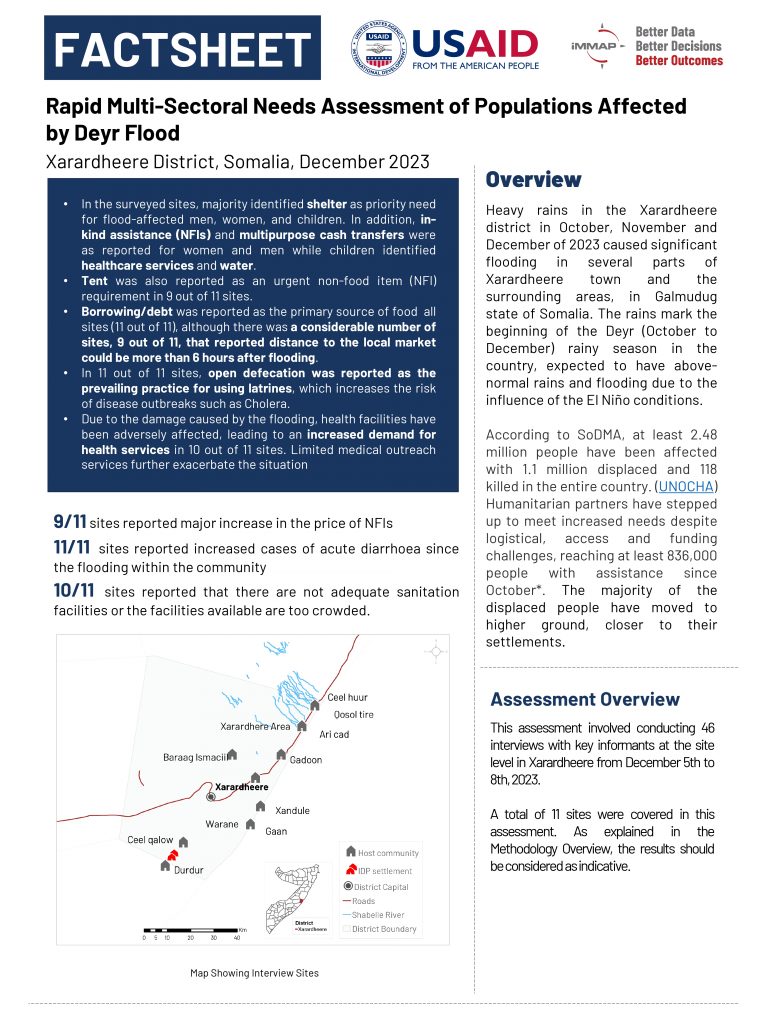
Somalia: Rapid Multi-sectoral Needs Assessment of populations affected by Deyr flooding - Xarardheere district
This document assesses the needs of the population affected by the floods in Xarardheere district and its surroundings, in the South West state of Somalia.
Read more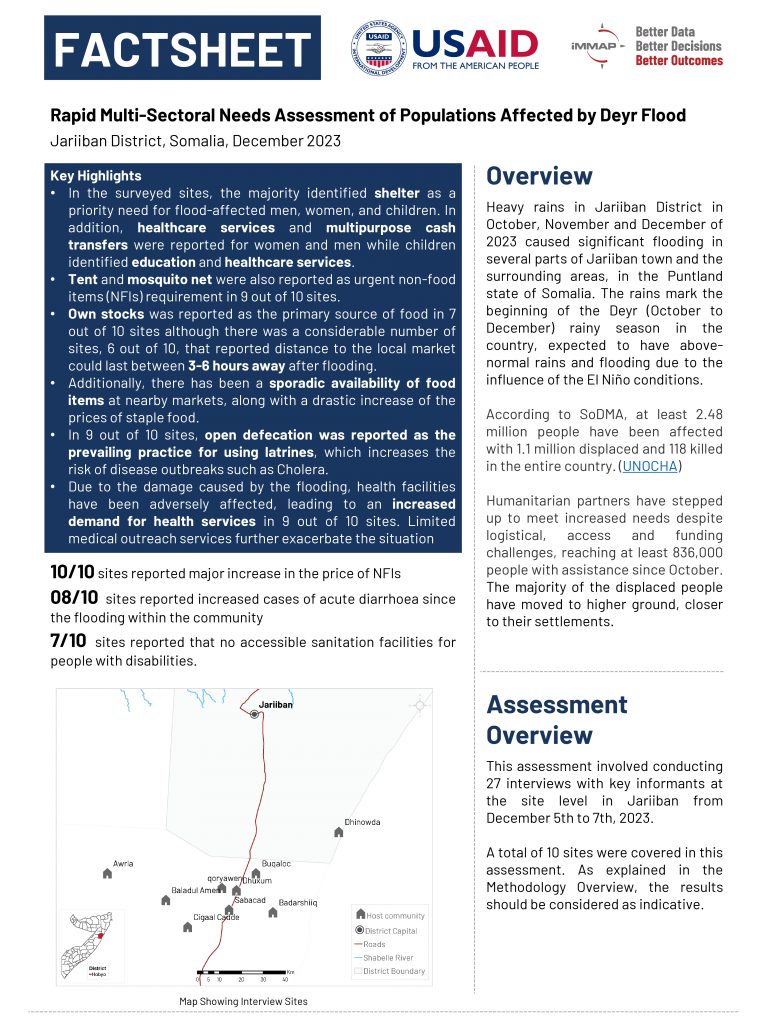
Somalia: Rapid Multi-sectoral Needs Assessment of populations affected by Deyr flooding - Jariiban district
This document assesses the needs of the population affected by the floods in Jariiban district and its surroundings, in the South West state of Somalia.
Read more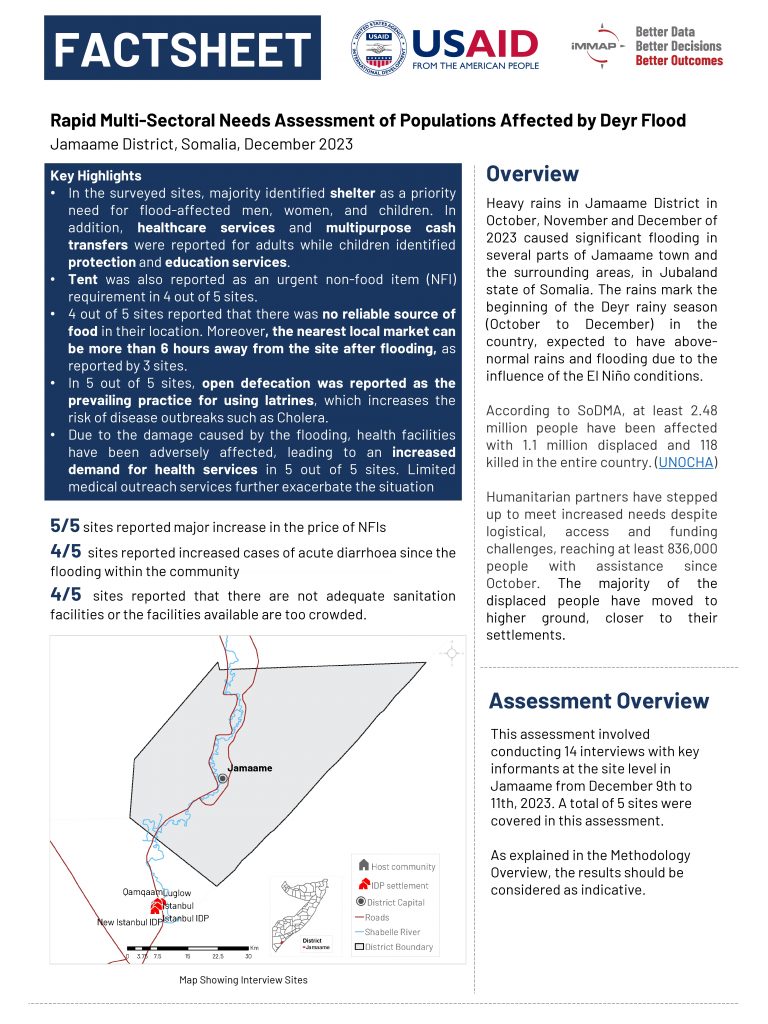
Somalia: Rapid Multi-sectoral Needs Assessment of populations affected by Deyr flooding - Jamaame district
This document assesses the needs of the population affected by the floods in Jamaame district and its surroundings, in the South West state of Somalia.
Read more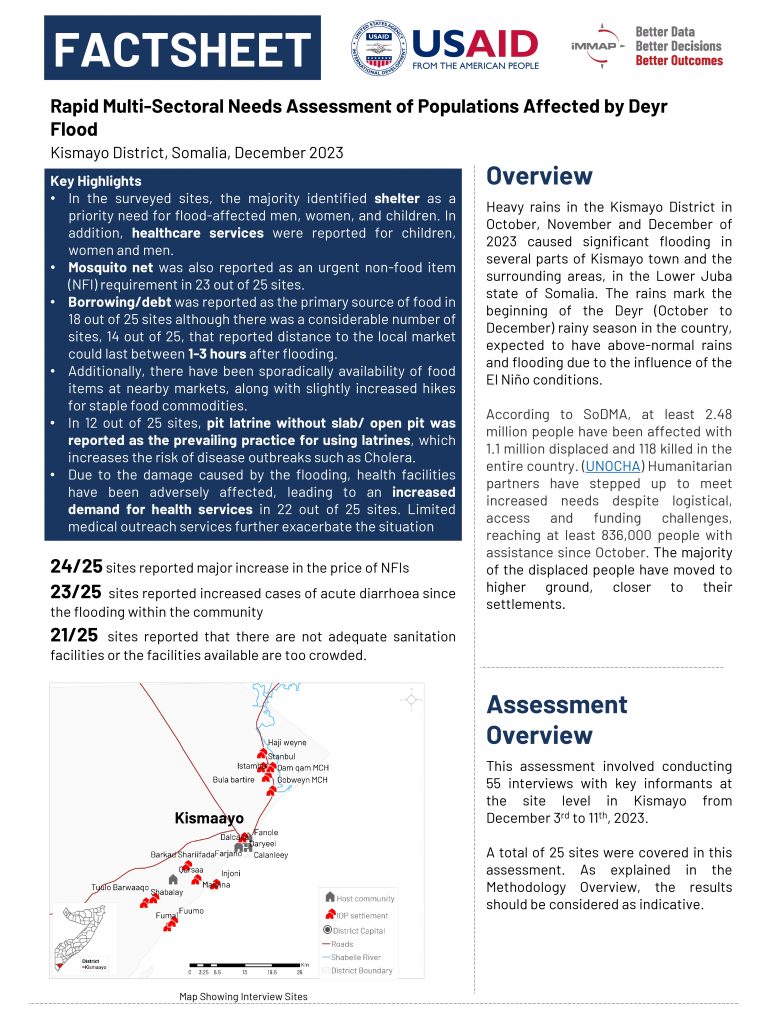
Somalia: Rapid Multi-sectoral Needs Assessment of populations affected by Deyr flooding - Kismayo district
This document assesses the needs of the population affected by the floods in Kismayo district and its surroundings, in the South West state of Somalia.
Read more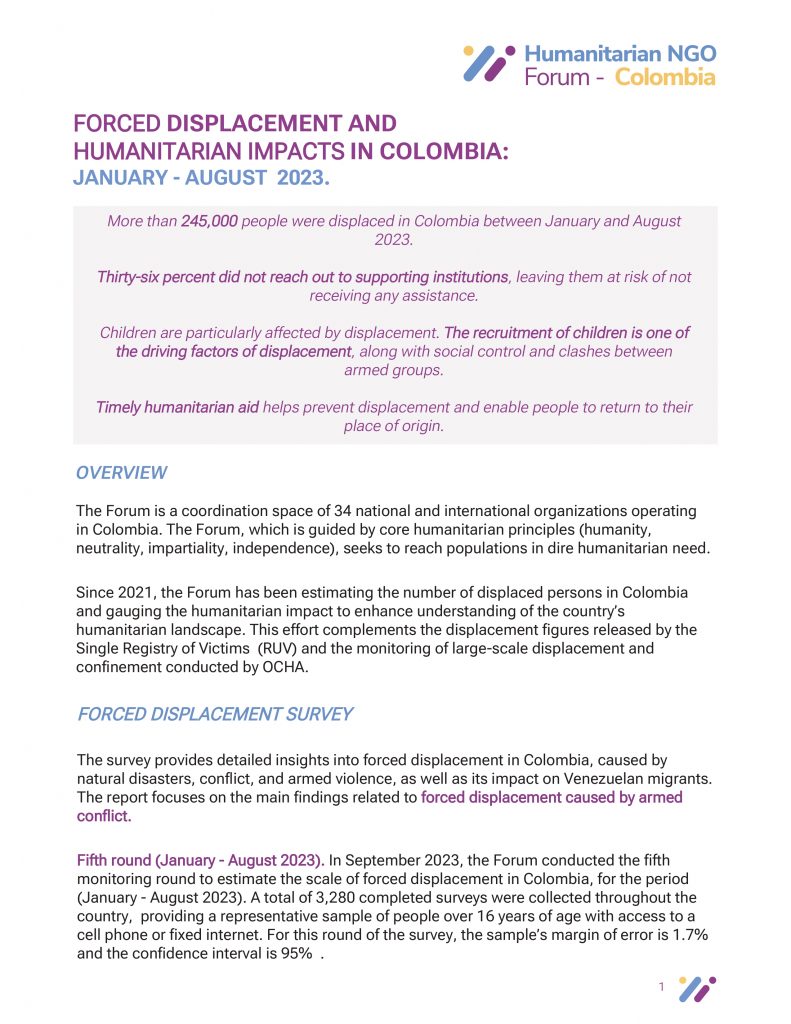
Forced Displacement and Humanitarian in Colombia
The survey provides detailed insights into forced displacement in Colombia, caused by natural disasters, conflict, and armed violence, as well as its impact on Venezuelan migrants.
Read more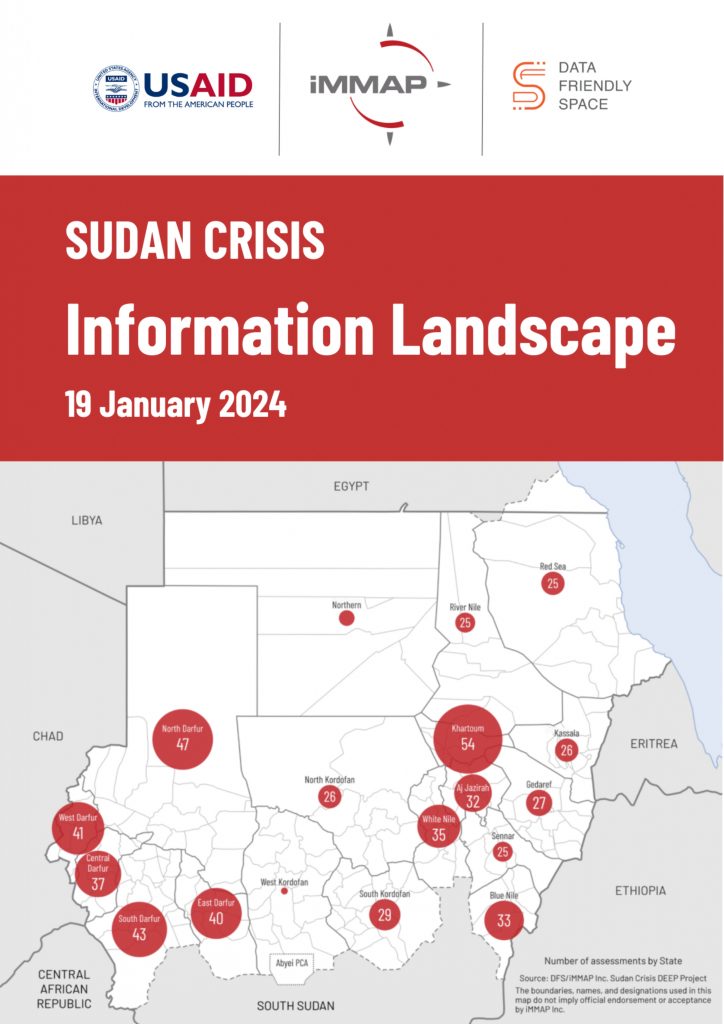
Sudan Crisis: Information Landscape (January 2024)
This report aims to provide an overview of the data landscape for the current humanitarian crisis in Sudan.
Read more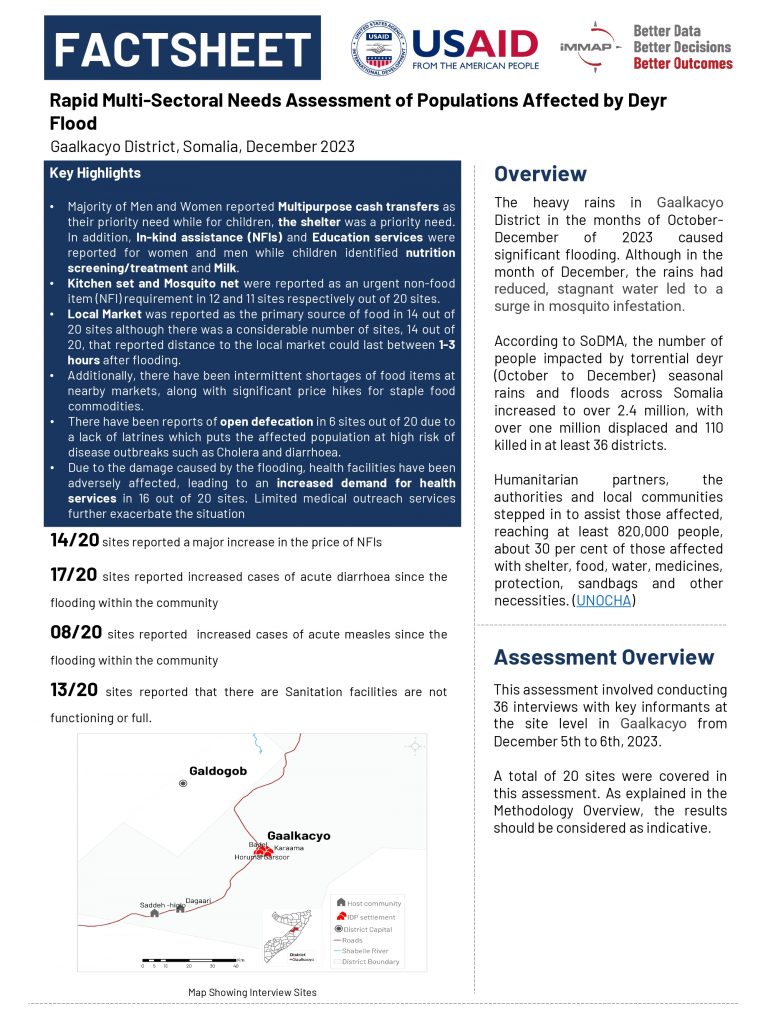
Somalia: Rapid Multi-sectoral Needs Assessment of populations affected by Deyr flooding - Gaalkacyo district
This document assesses the needs of the population affected by the floods in Gaalkacyo district and its surroundings, in the South West state of Somalia.
Read more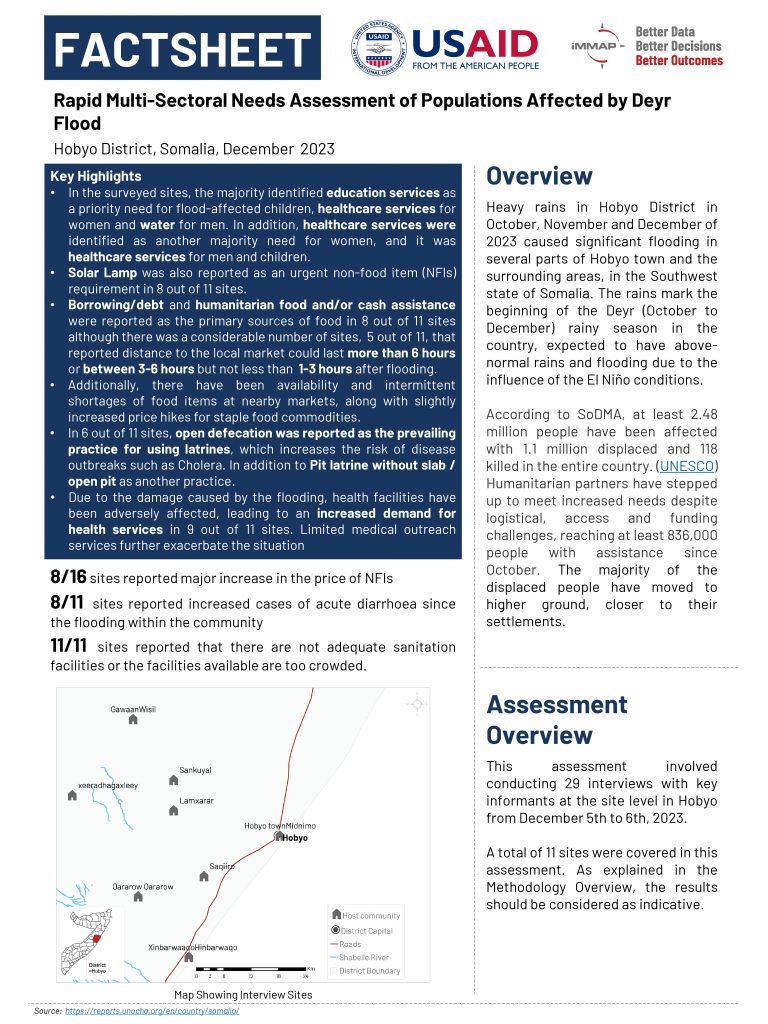
Somalia: Rapid Multi-sectoral Needs Assessment of populations affected by Deyr flooding - Hobyo district
This document assesses the needs of the population affected by the floods in Hobyo district and its surroundings, in the South West state of Somalia.
Read more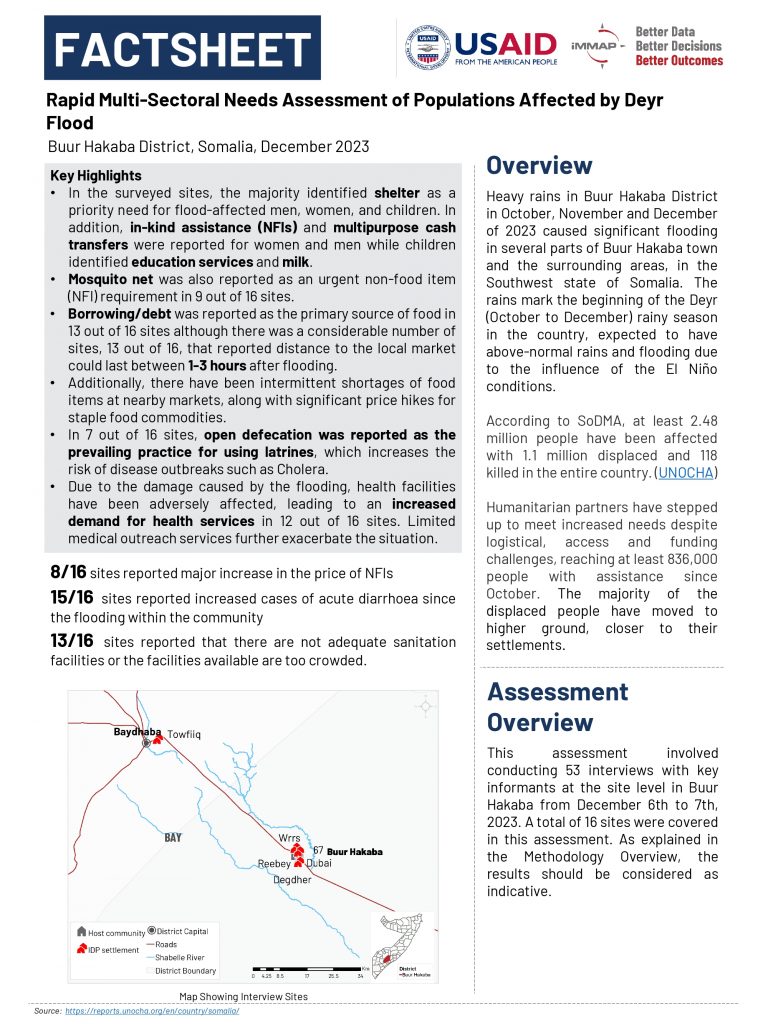
Somalia: Rapid Multi-sectoral Needs Assessment of populations affected by Deyr flooding - Buur Hakaba district
This document assesses the needs of the population affected by the floods in Buur Hakaba district and its surroundings, in the South West state of Somalia.
Read more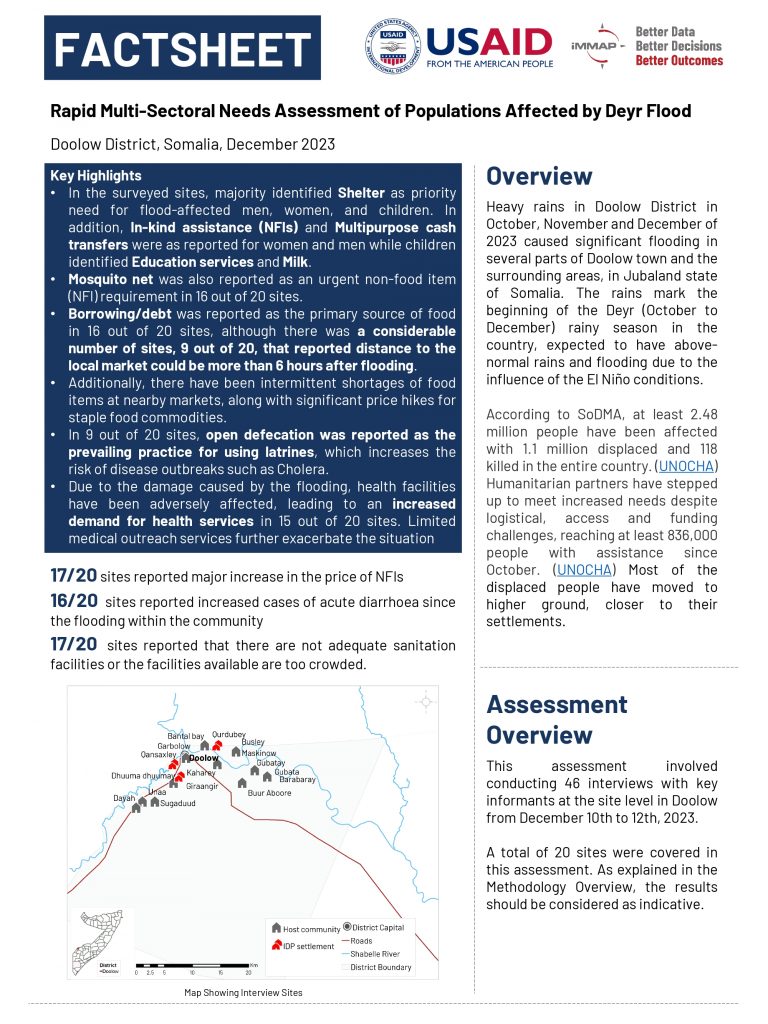
Somalia: Rapid Multi-sectoral Needs Assessment of populations affected by Deyr flooding - Doolow district
This document assesses the needs of the population affected by the floods in Doolow district and its surroundings, in the South West state of Somalia.
Read more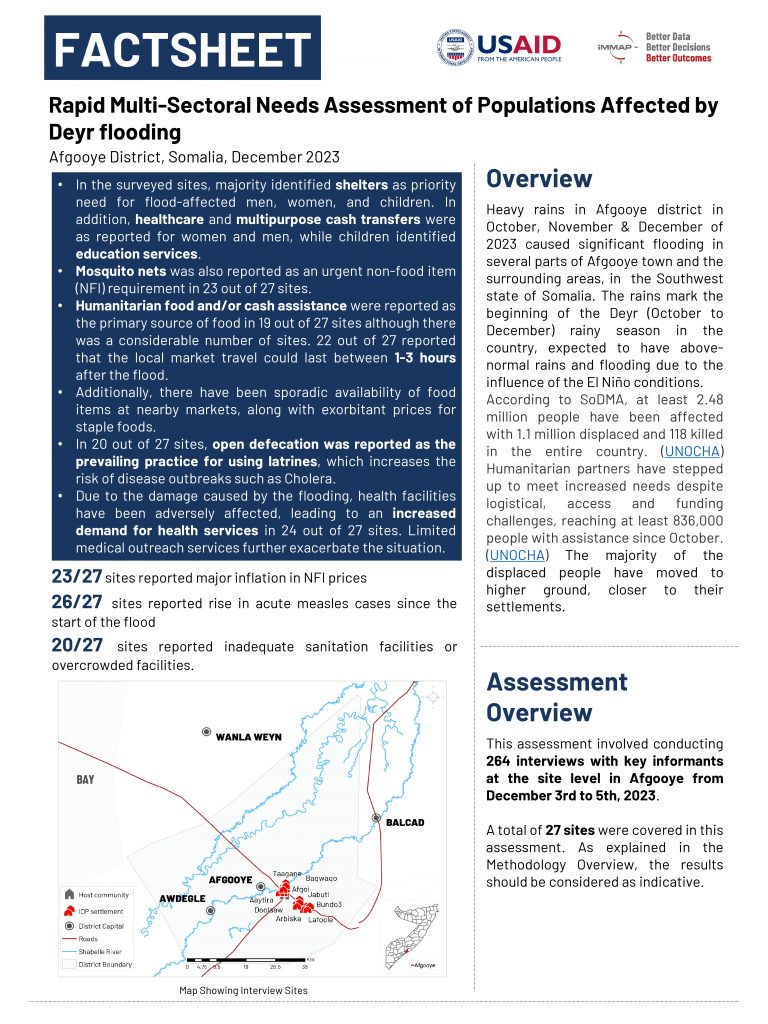
Somalia: Rapid Multi-sectoral Needs Assessment of populations affected by Deyr flooding - Afgooye district
This document assesses the needs of the population affected by the floods in Afgooye district and its surroundings, in the South West state of Somalia.
Read more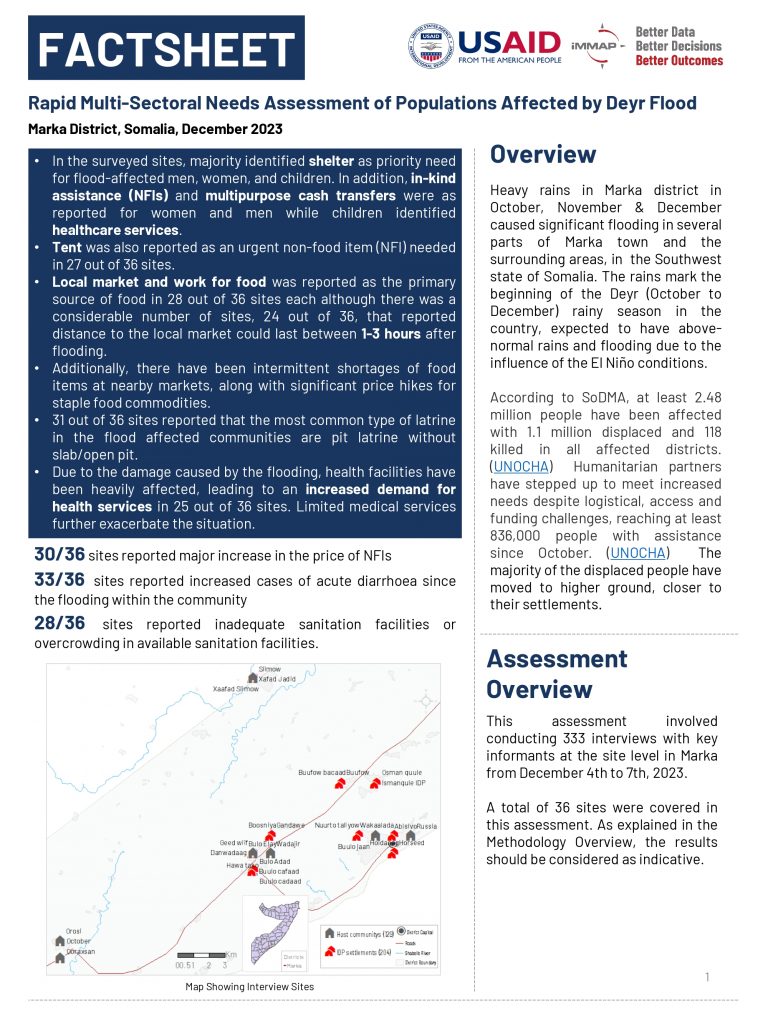
Somalia: Rapid Multi-sectoral Needs Assessment of populations affected by Deyr flooding - Marka district
This document assesses the needs of the population affected by the floods in Marka district and its surroundings, in the South West state of Somalia.
Read more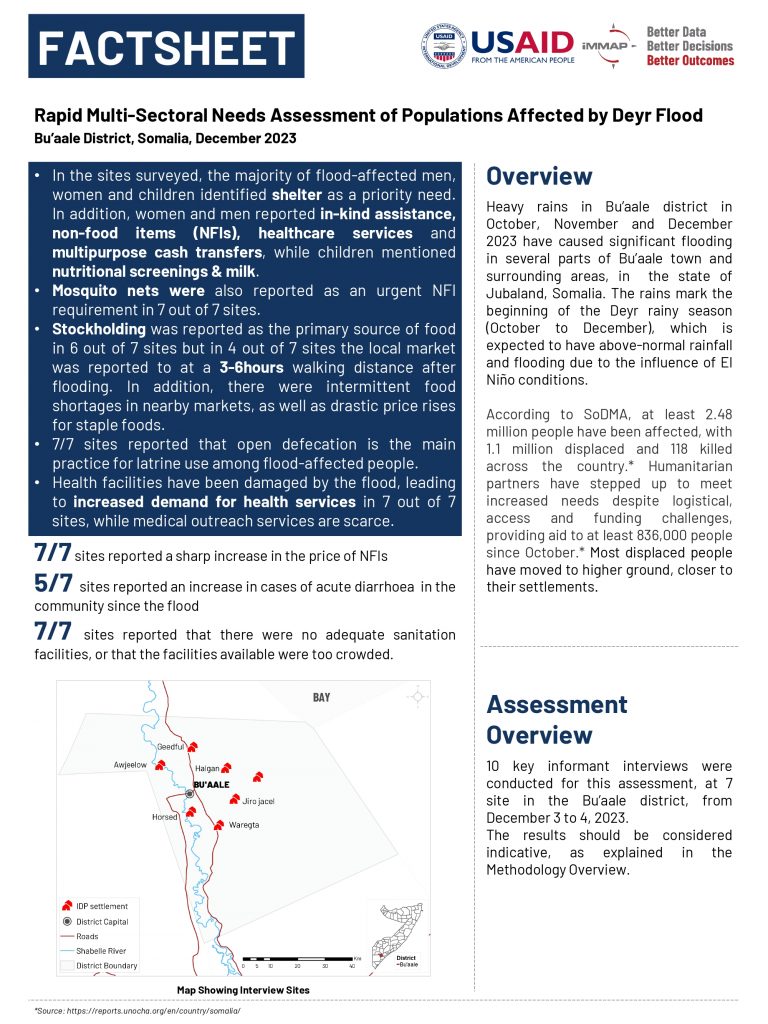
Somalia: Rapid Multi-sectoral Needs Assessment of populations affected by Deyr flooding - Bu'aale district
This document assesses the needs of the population affected by the floods in Bu'aale district and its surroundings, in the South West state of Somalia.
Read more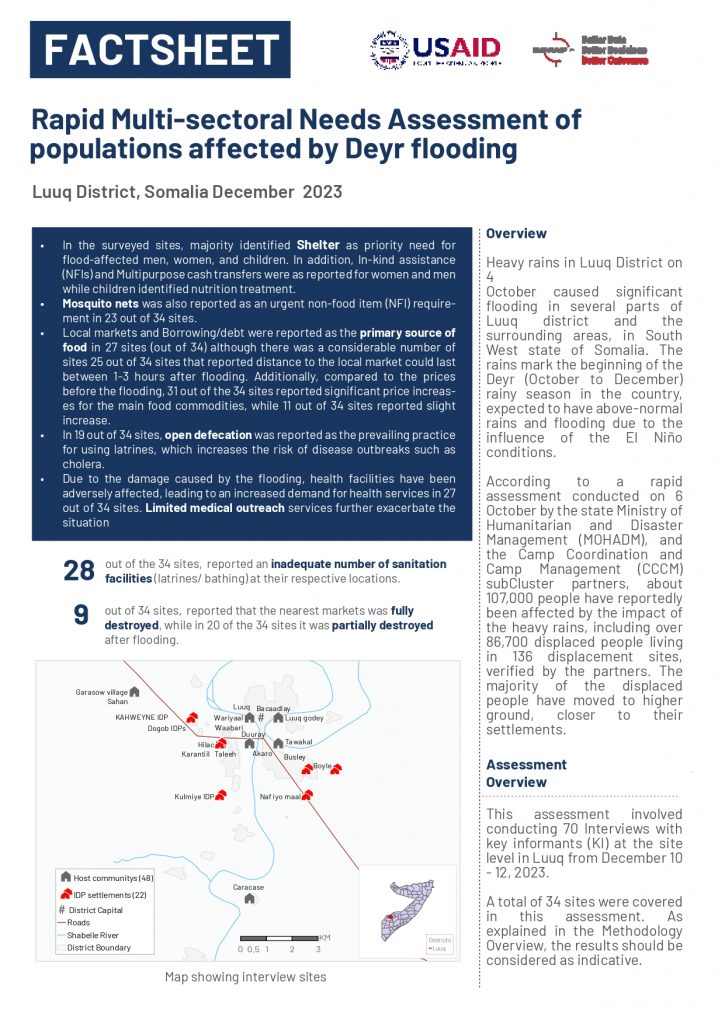
Somalia: Rapid Multi-sectoral Needs Assessment of populations affected by Deyr flooding - Luuq district
This document assesses the needs of the population affected by the floods in Luuq district and its surroundings, in the South West state of Somalia.
Read more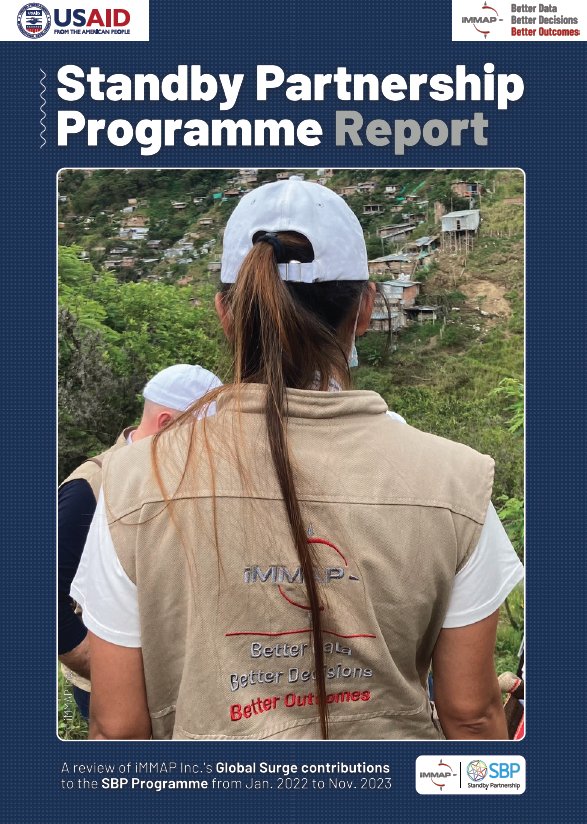
Standby Partnership Programme Report (January 2022 - November 2023)
A review of iMMAP Inc.'s Global Surge contributions to the Standby Partnership Programme from Jan. 2022 to Nov. 2023
Read more
Afghanistan: Earthquake Events Overview (December 2023)
This map provides a detailed overview of earthquakes in Afghanistan and 200km beyond its borders. This includes magnitudes, epicenter locations, and dates of occurrences.
Read more
Situational Analysis of Sudan’s Crisis – December 2023
This report, spanning October to November 2023, details sustained hostilities between the Rapid Support Forces (RSF) and Sudanese Armed Forces (SAF) across Sudan, particularly affecting Khartoum and Darfur.
Read more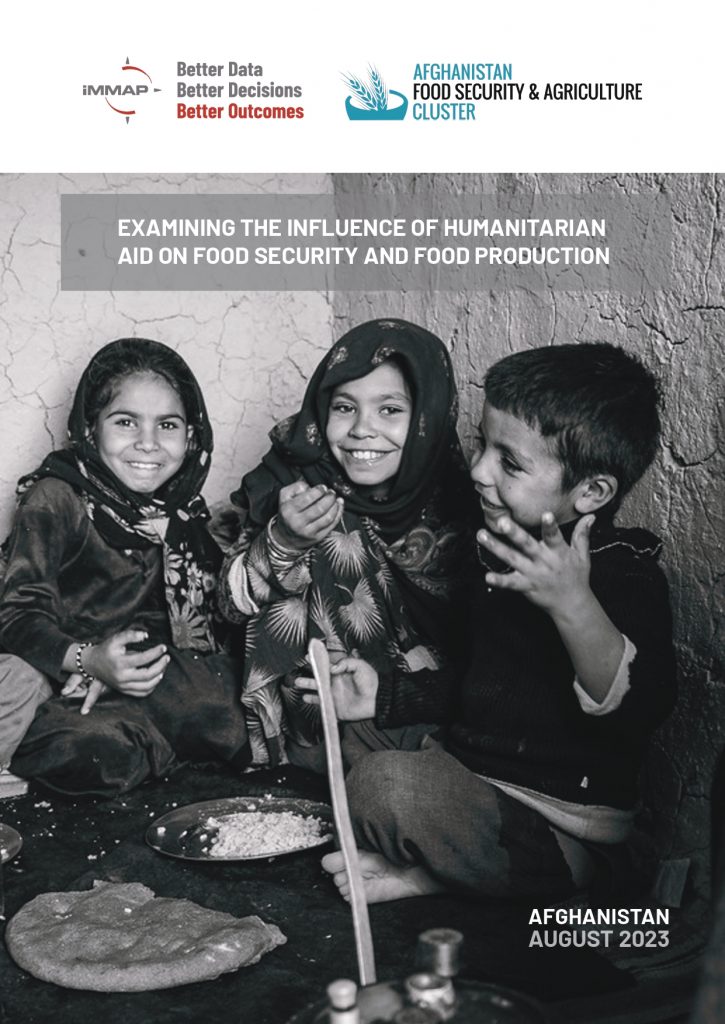
Afghanistan: Examining the Influence of Humanitarian Aid on Food Security and Food Production
The report examines the impact of humanitarian aid on food production and consumption in 4 provinces classified as food insecure, according to the results of the 2022 IPC on acute food insecurity.
Read more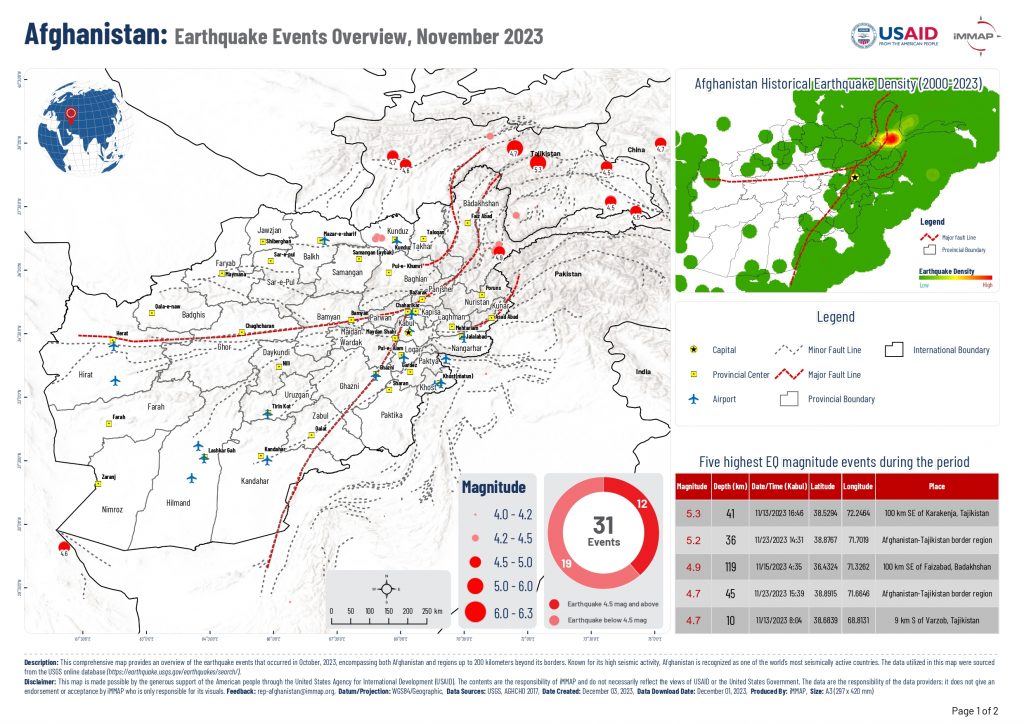
Afghanistan: Earthquake Events Overview (November 2023)
This map provides a detailed overview of earthquakes in Afghanistan and 200km beyond its borders. This includes magnitudes, epicenter locations, and dates of occurrences.
Read more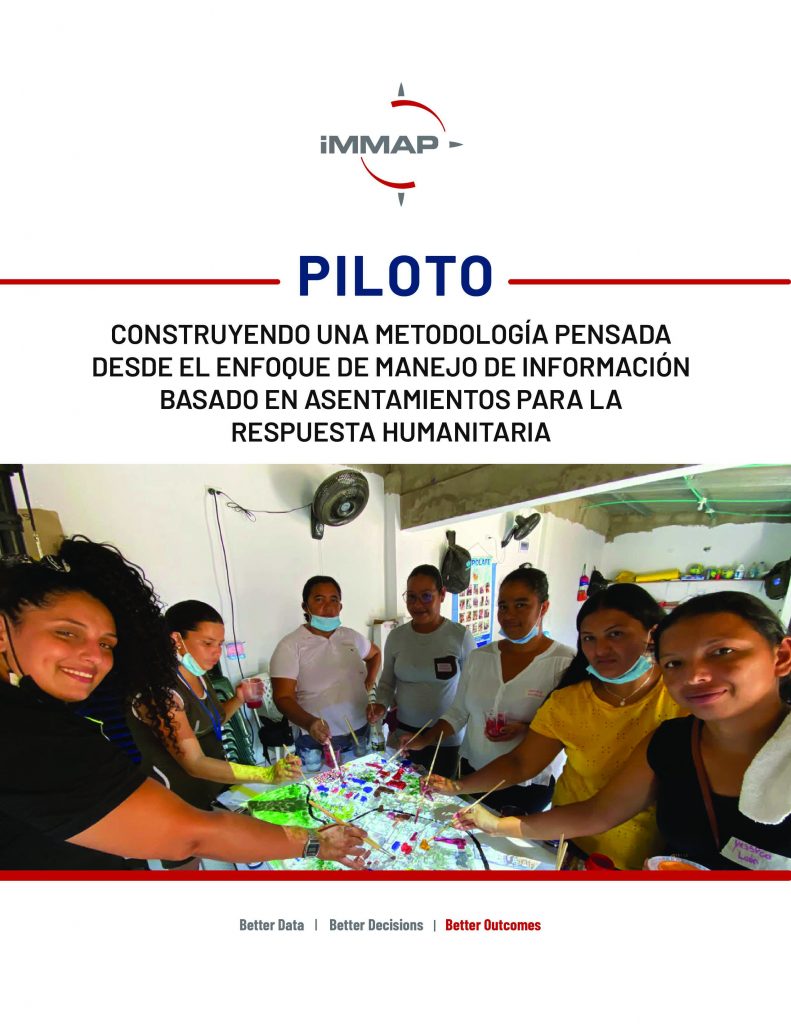
Colombia: New settlement prediction algorithm
The following document seeks firstly to explain the main steps necessary to run and thus replicate the settlement detection algorithm developed by the consulting company Thinking Machines of the Philippines. Secondly, it seeks to expose those good practices employed at the time of running the algorithm, which includes an explanation of the modifications made to the algorithm code according to the execution environment experienced when trying to adopt and test the developed model.
Read more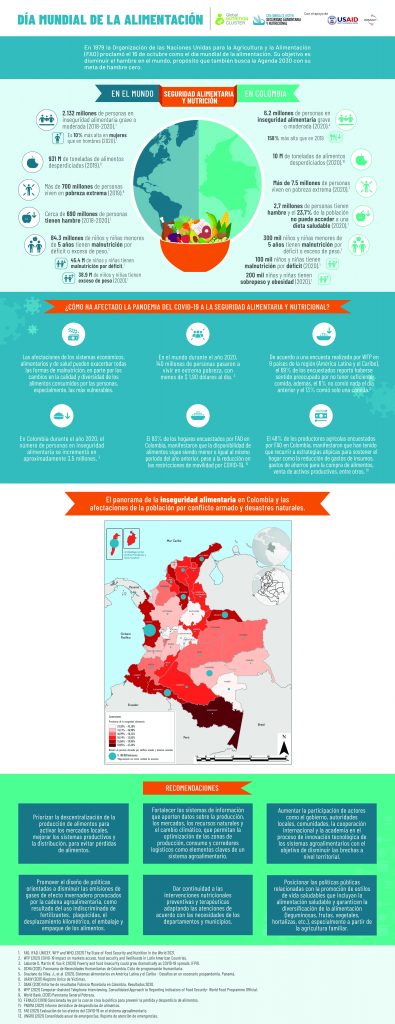
Colombia: World Food Day (2021)
In 1979, the Food and Agriculture Organization of the United Nations (FAO) proclaimed October 16 as World Food Day. Its objective is to reduce hunger in the world, a purpose also sought by the 2030 Agenda with its goal of zero hunger. Learn some facts about food security in Colombia and in the world.
Read more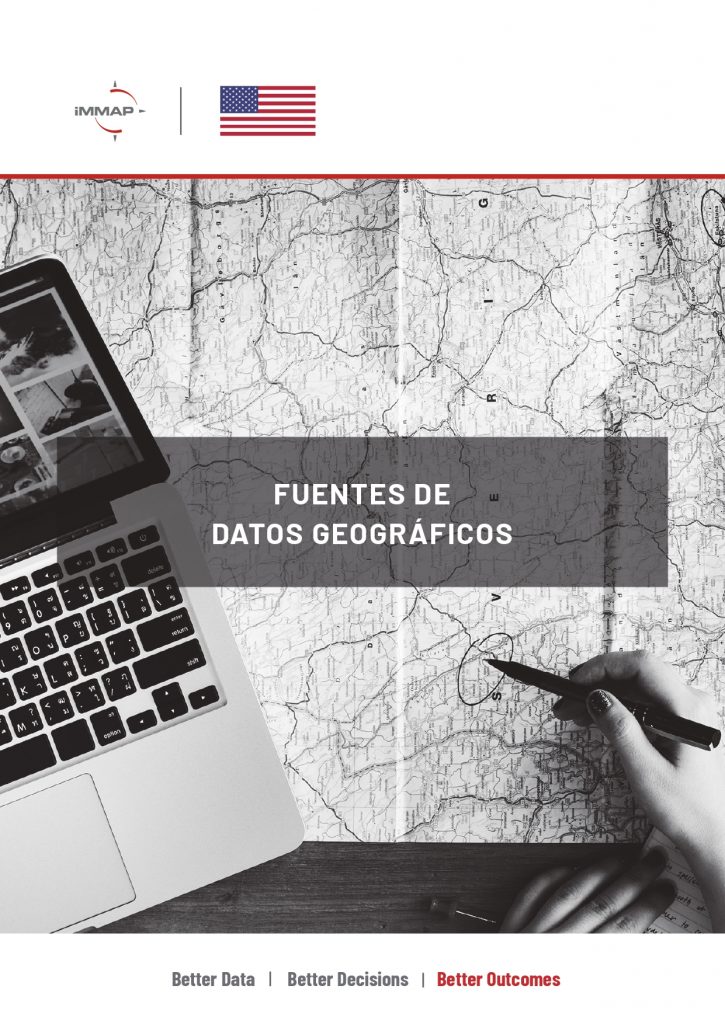
Colombia: Geographic data sources
Geographic Information Systems (GIS) are nowadays a fundamental tool for multipurpose management and planning tasks: resource management, urban planning, environmental impact assessment, environmental impact assessment, social, logistics, among others. GIS are integrated within the Information and Communication Technologies (ICT) as they are tools developed for information management and information exchange.
Read more
Colombia: Chronic and high-cost diseases in the refugee and migrant population - July 2023
The identification of the number of high-cost cases and pathologies attended by territorial entities in the health response to refugees and migrants in Colombia allows for better planning and protection of resources. Knowing the magnitude and nature of the diseases affecting both the migrant and host population facilitates informed public policy decisions and allows the design of appropriate strategies to ensure comprehensive and equitable care.
Read more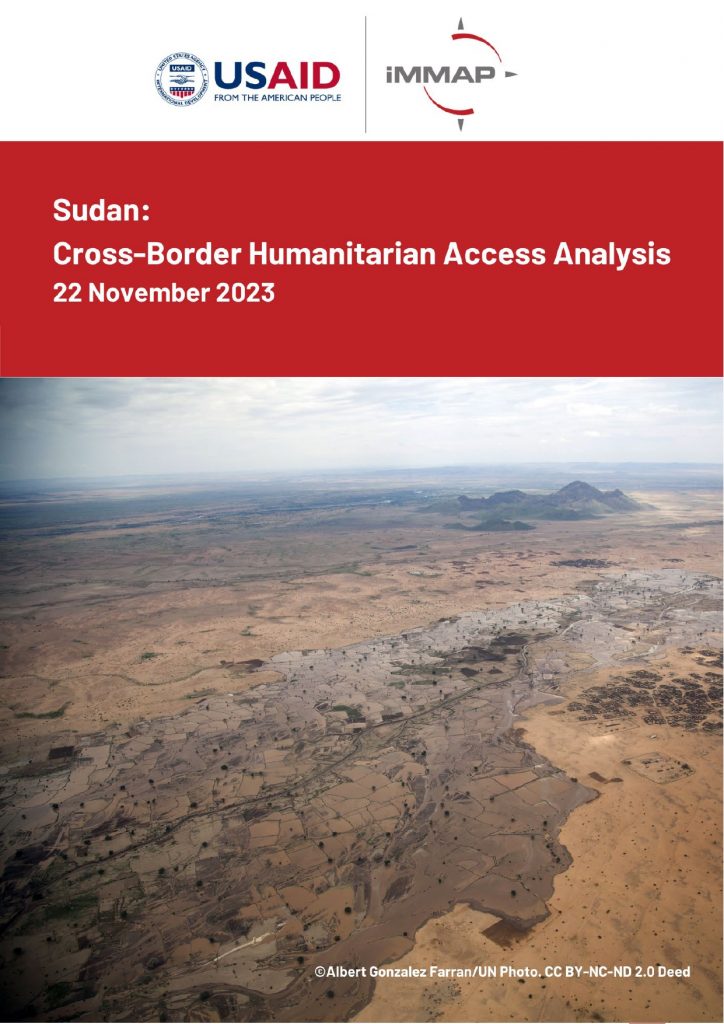
Sudan: Cross-Border Humanitarian Access Analysis - November 2023
This report provides an overview of the conflict dynamics around Chad–Sudan and South Sudan–Sudan Border Cross Points (BCPs) along with mapping the access routes into Sudan for humanitarian agencies. It also outlines the trajectory of the mentioned border areas.
Read more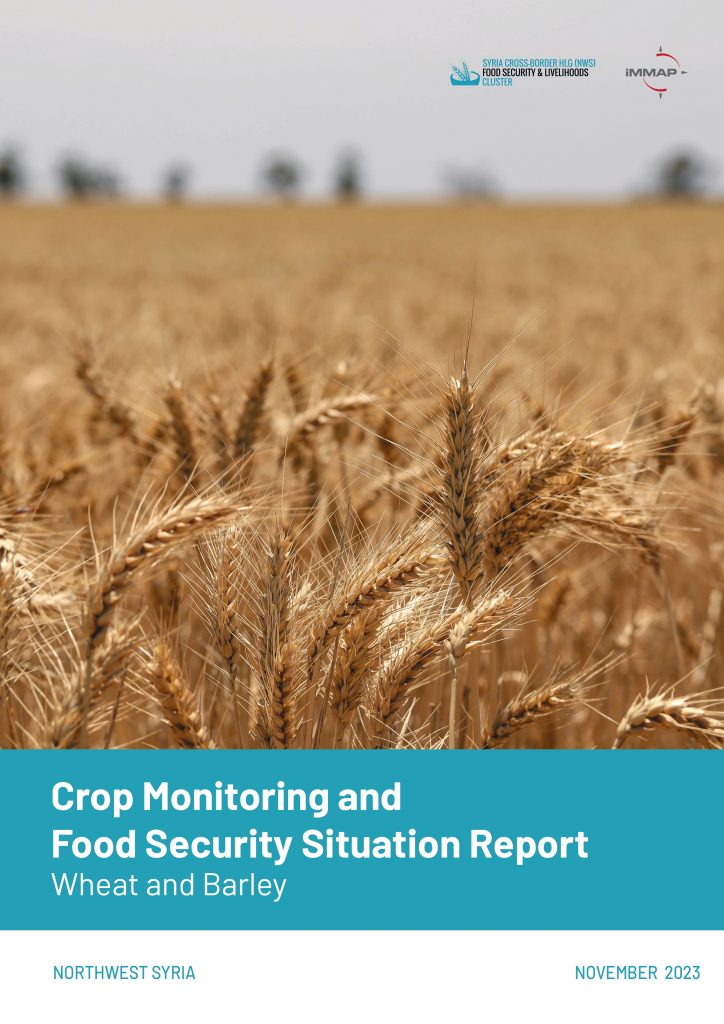
Crop Monitoring and Food Security Situation Update in Northwest Syria - November 2023
This report on Northwest Syria highlights challenges in wheat and barley production, exacerbated by crises and climate shocks.
Read more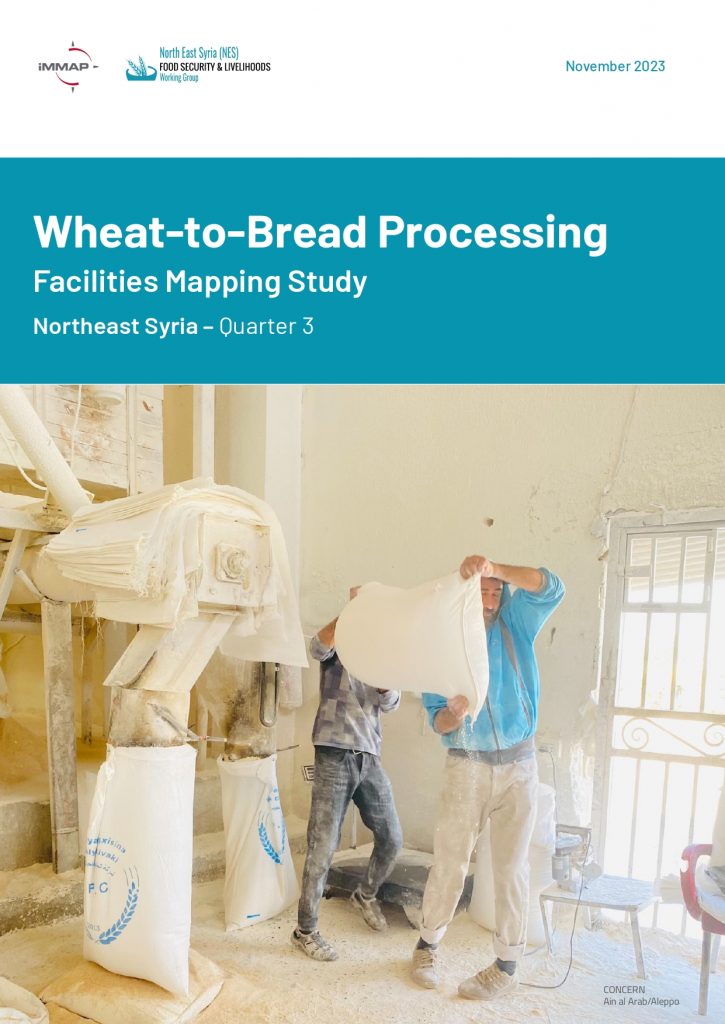
Wheat-to-Bread Processing Facilities Mapping – (Q3) October 2023, Northeast Syria
To inform the bread programs in Northeast Syria (NES), iMMAP, in collaboration with the Food Security and Livelihood (FSL) Cluster and the Bakeries and Bread Coordination Group (BBCG) in NES, conducts a regular mapping and monitoring exercise of the processing facilities in the wheat-flour to bread value chain in NES.
Read more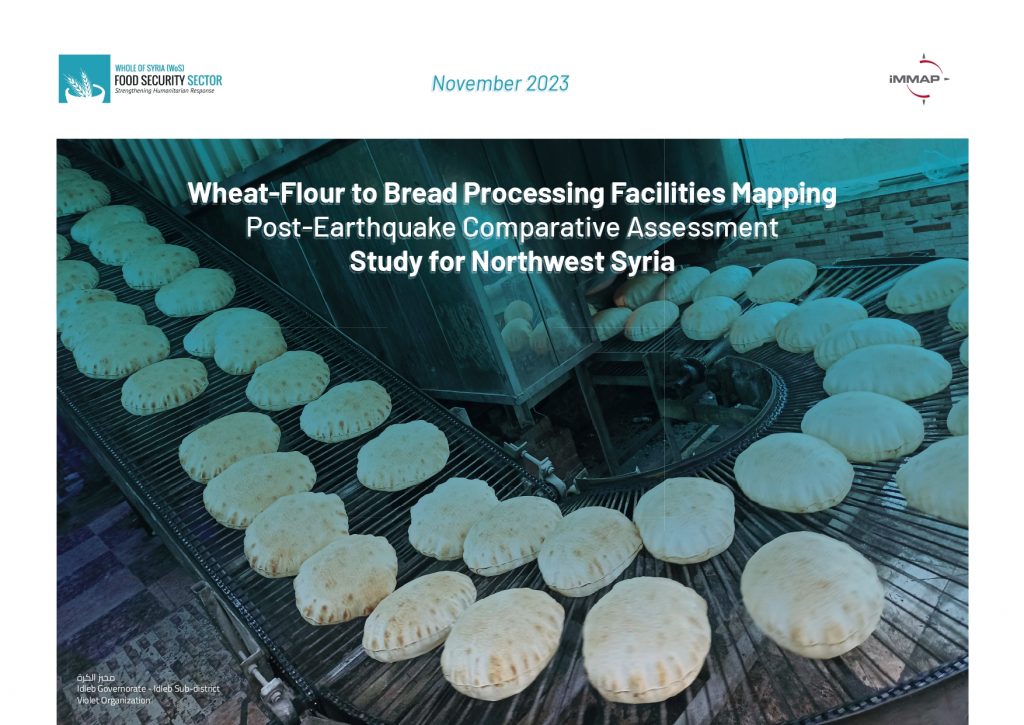
Post-Earthquake Mapping of Wheat-Flour to Bread Facilities in Northwest Syria - November 2023
This study maps and monitors wheat-flour to bread processing and production facilities in both public and private sectors across Northwest Syria (NWS).
Read more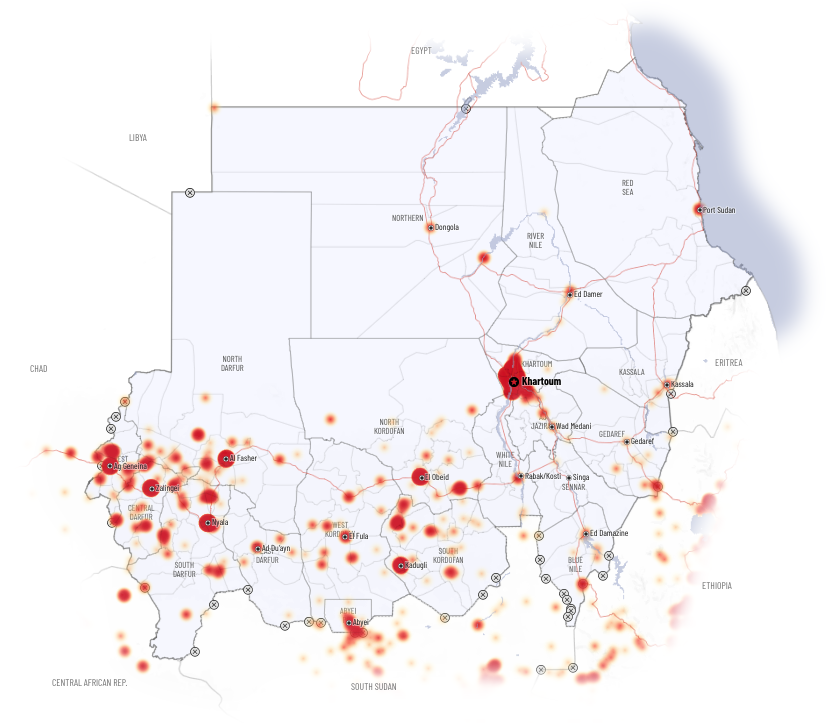
Sudan Situation Overview - Dashboard
This dashboard provides an overview of the situation in Sudan from January 2023 to the present day, and is regularly updated.
Read more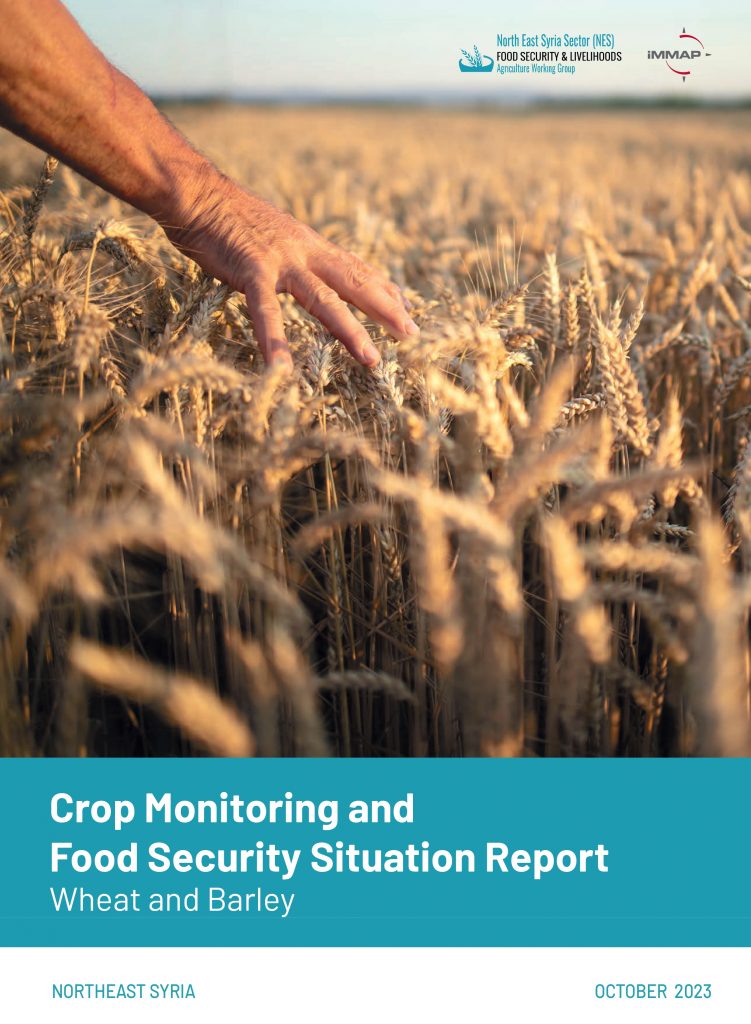
Crop Monitoring and Food Security Situation Update in Northeast Syria - October 2023
This report offers insights and recommendations for policymakers and humanitarian organizations to design effective measures to support Northeast Syria farmers, mitigate the impact of shocks, and alleviate food insecurity.
Read more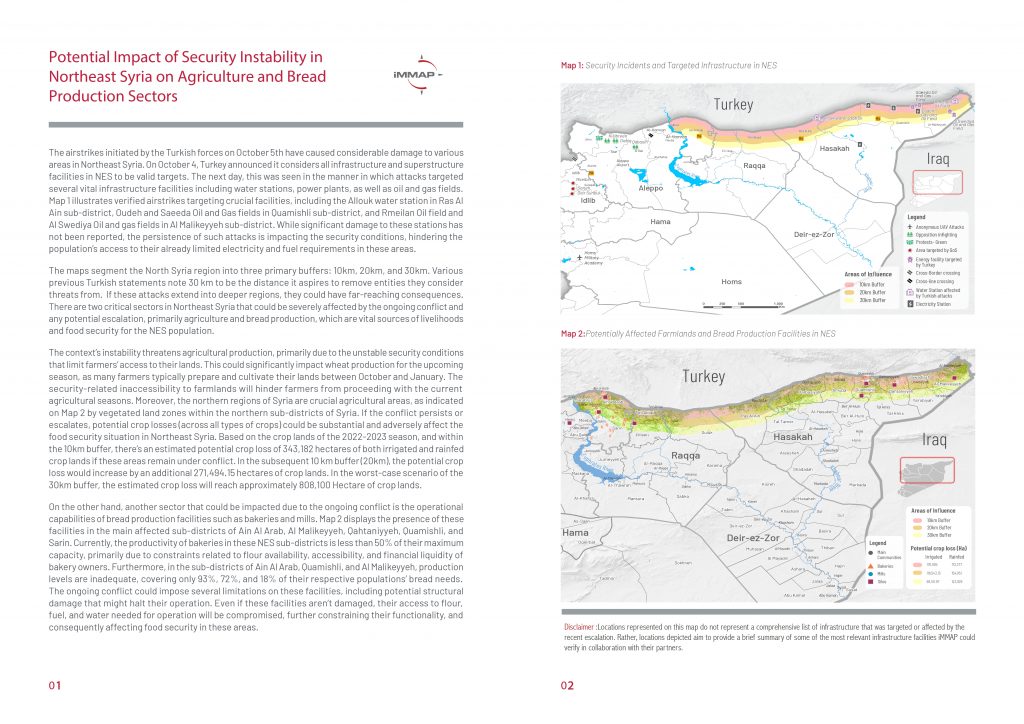
Potential Impact of Security Instability in Northeast Syria on Agriculture and Bread Production Sectors
These maps and report highlight the potential impact of security instability in north-eastern Syria on the agricultural and bread production sectors.
Read more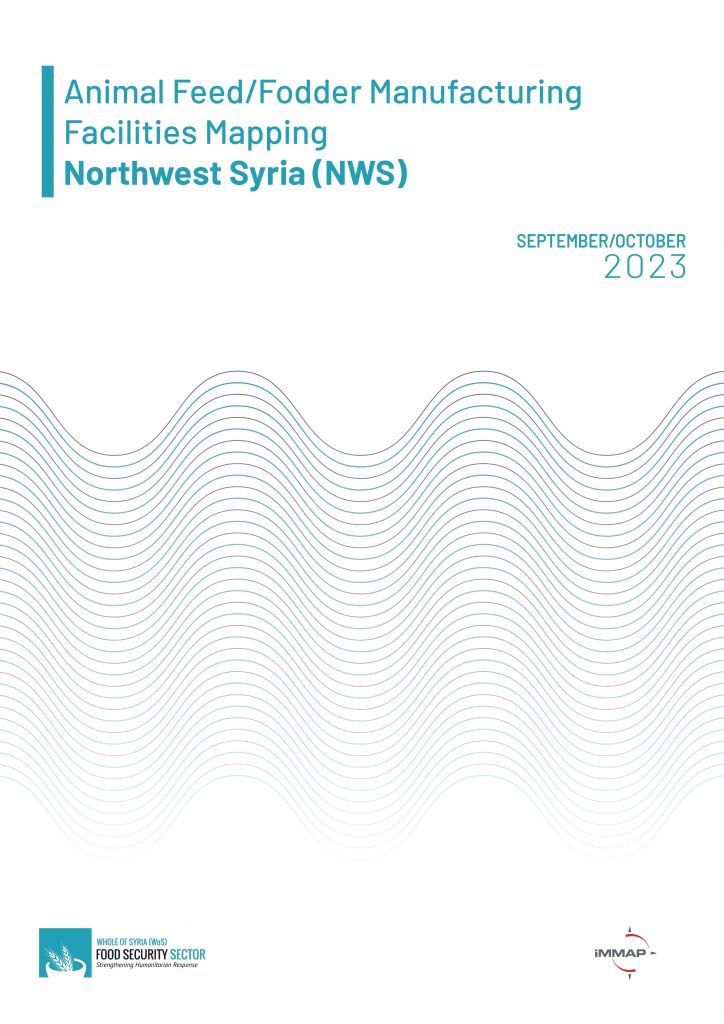
Northwest Syria: Animal Feed and Fodder Manufacturing Facilities Mapping Report
The study aimed to collect data on animal feed and fodder facilities in Northwest Syria. It explores the operational capacity and commercialization of the livestock feed and fodder sector. The interviews were conducted using a semi-structured questionnaire developed by iMMAP Inc. in coordination with various organizations.
Read more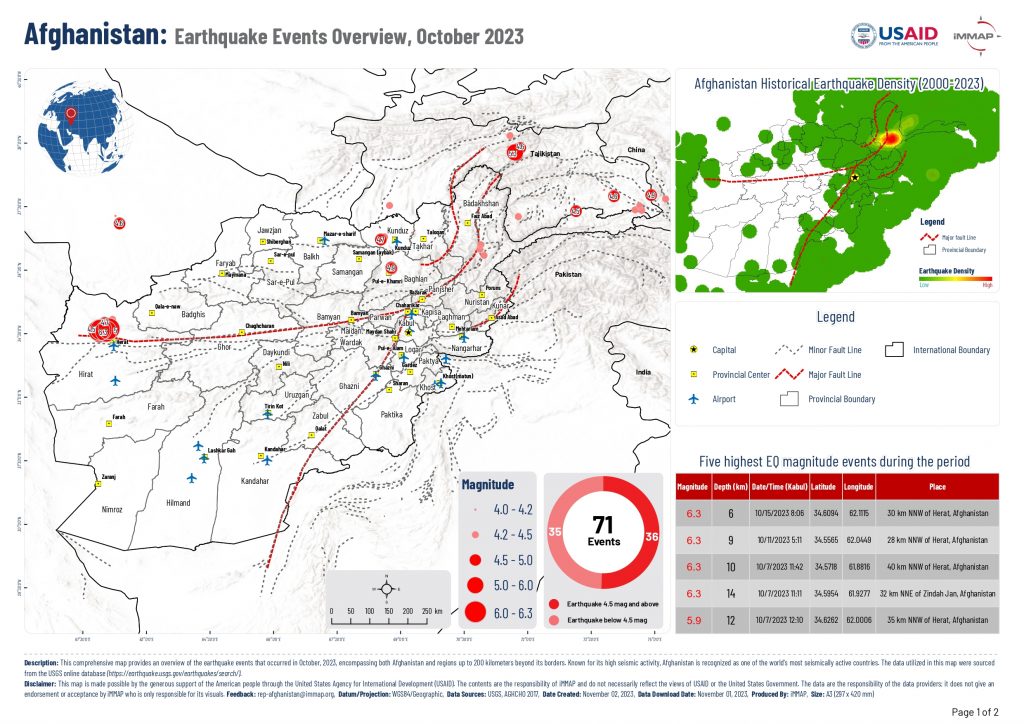
Afghanistan: Earthquake Events Overview (October 2023)
This map provides a detailed overview of earthquakes in Afghanistan and 200km beyond its borders. This includes magnitudes, epicenter locations, and dates of occurrences.
Read more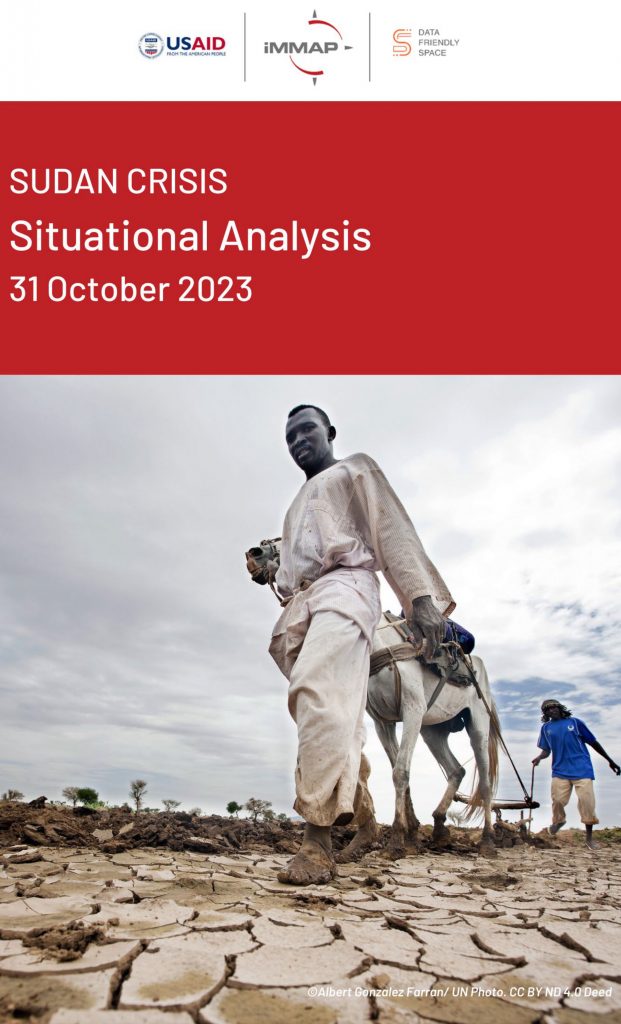
Situational Analysis of Sudan's Crisis - October 2023
The document presents a comprehensive overview of the situation in Sudan, where an ongoing conflict has led to a substantial loss of life, primarily attributed to devastating bombings in Khartoum. The report covers developments in the time period of August-September 2023, but provides background information since the conflict outbreak.
Read more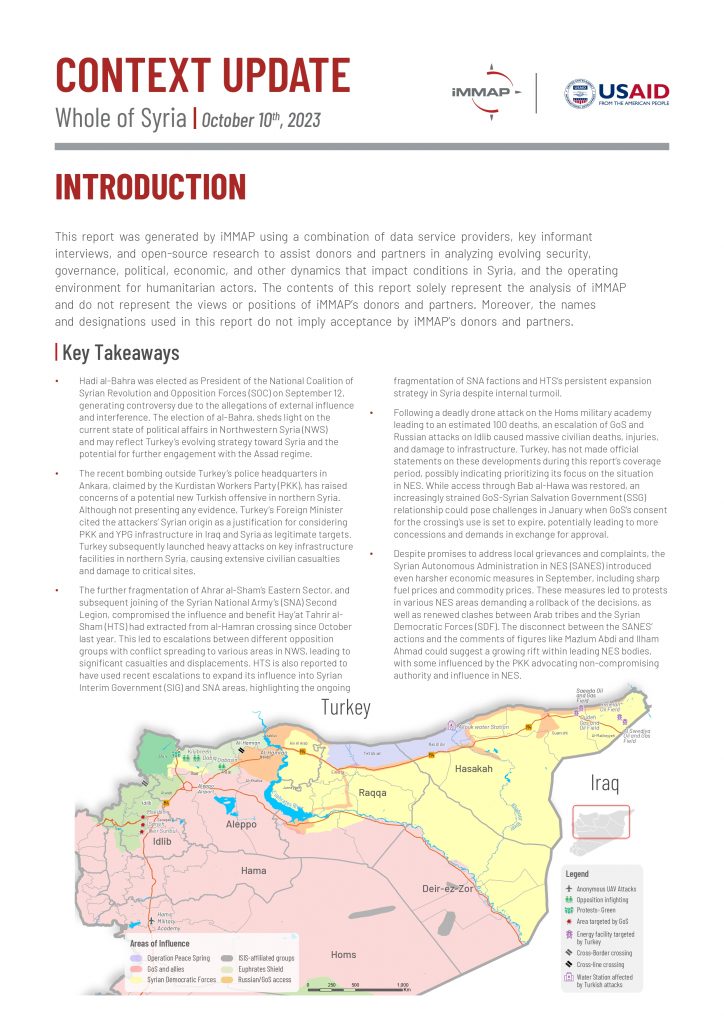
Context Update - Whole of Syria - October 2023
The period spanning the month of September and first days of October saw a worsening of stability, and humanitarian conditions across Syria’s various hubs. Developments during this period also highlighted some of the key issues Syrians face in terms of the different governing structures, and political conditions they live under.
Read more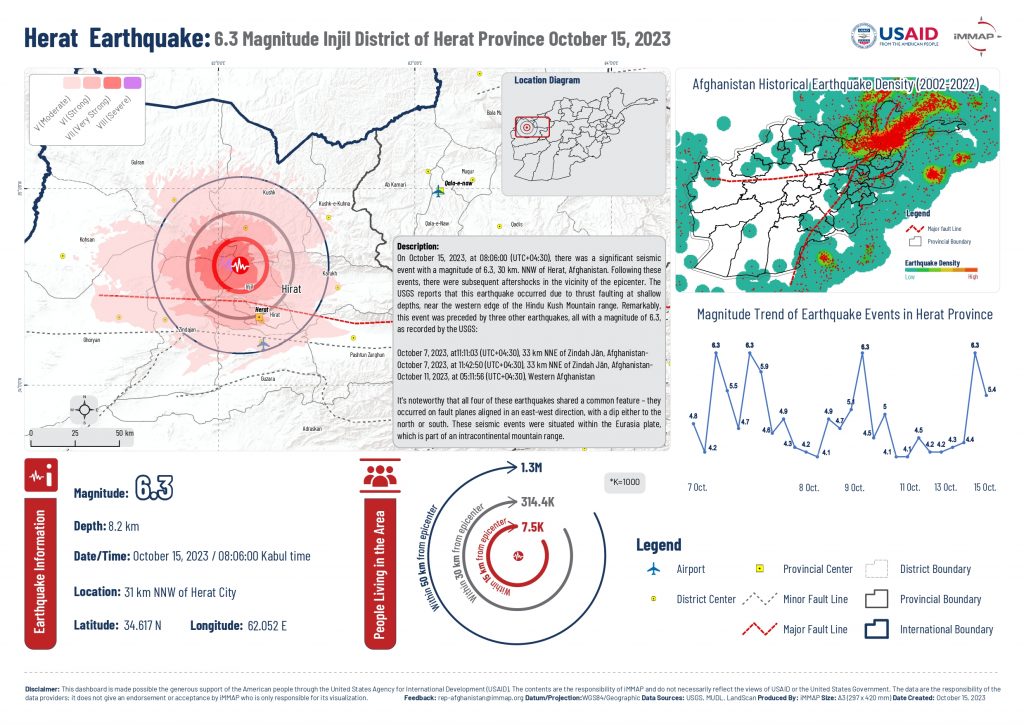
Herat Earthquake: Zindajan District Map (October 15th update)
On October 7, 2023, a devastating earthquake struck the Zindajan district of Herat province, Afghanistan.
Read more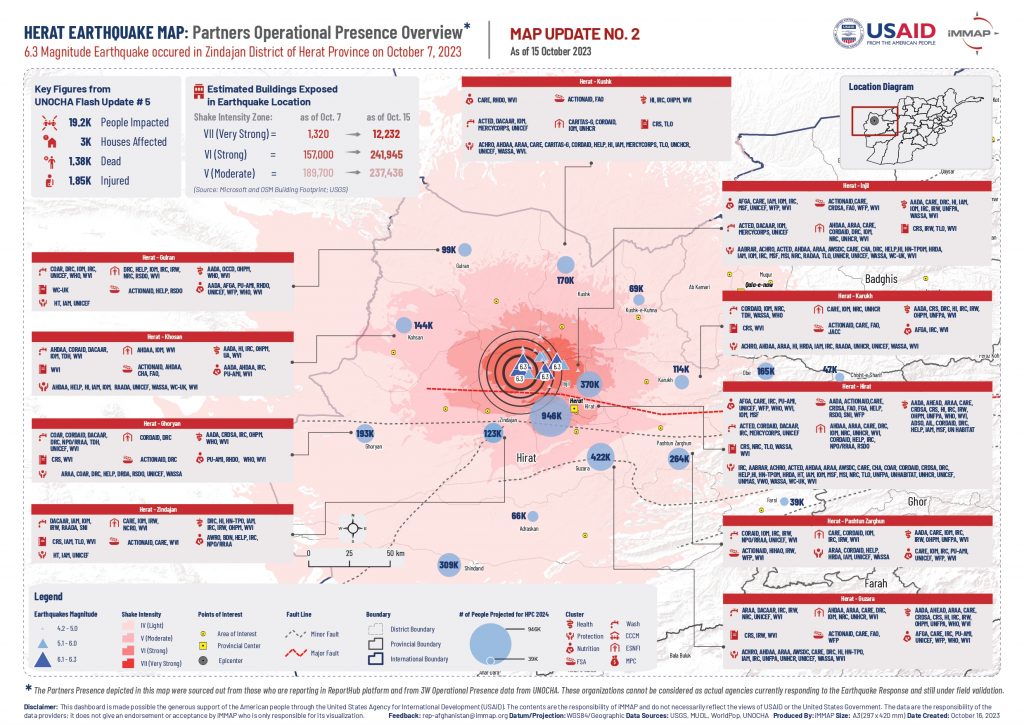
Herat Earthquake: Operational Partners Presence Map (October 15th update)
On October 7, 2023, a devastating earthquake struck the Zindajan district of Herat province, Afghanistan.
Read more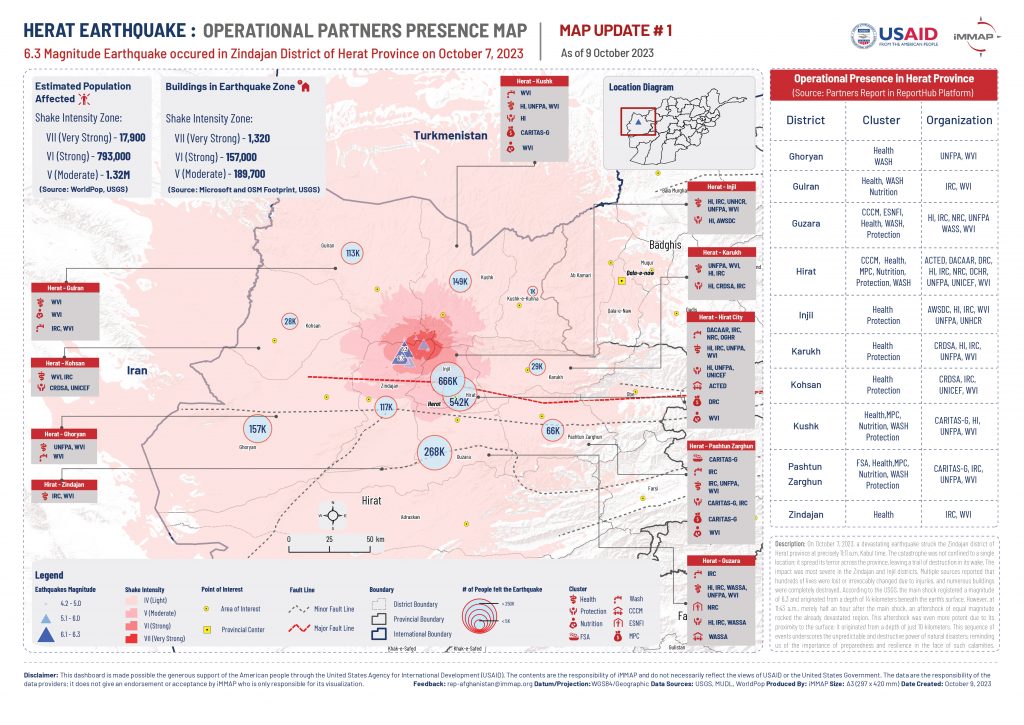
Herat Earthquake: Operational Partners Presence Map
On October 7, 2023, a devastating earthquake struck the Zindajan district of Herat province, Afghanistan.
Read more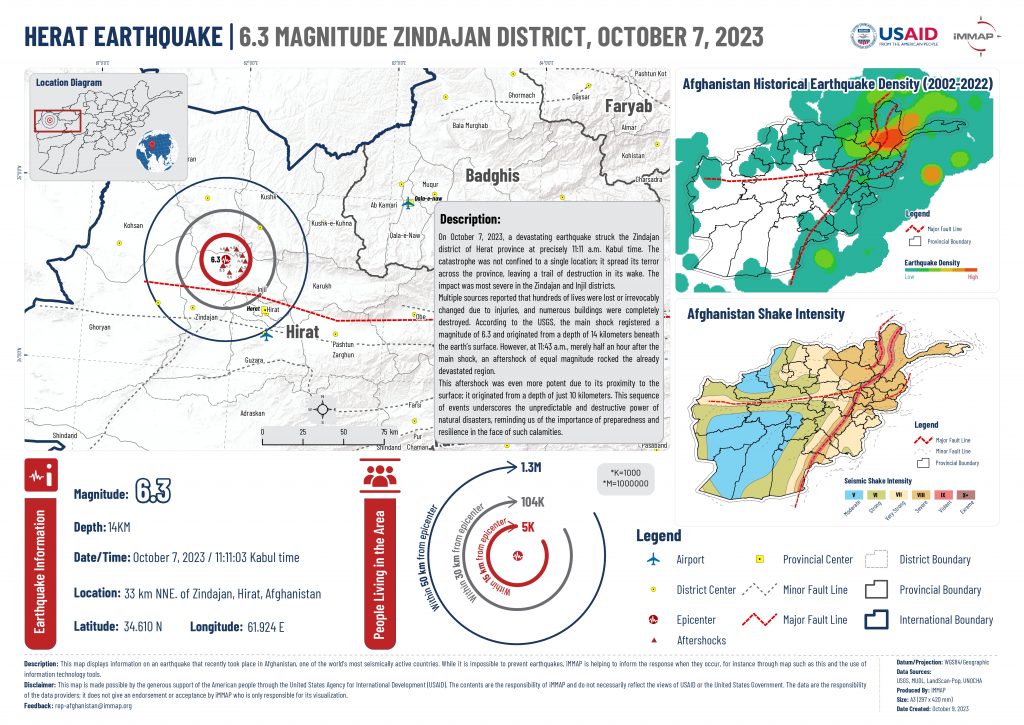
Herat Earthquake: Zindajan District Map
On October 7, 2023, a devastating earthquake struck the Zindajan district of Herat province, Afghanistan.
Read more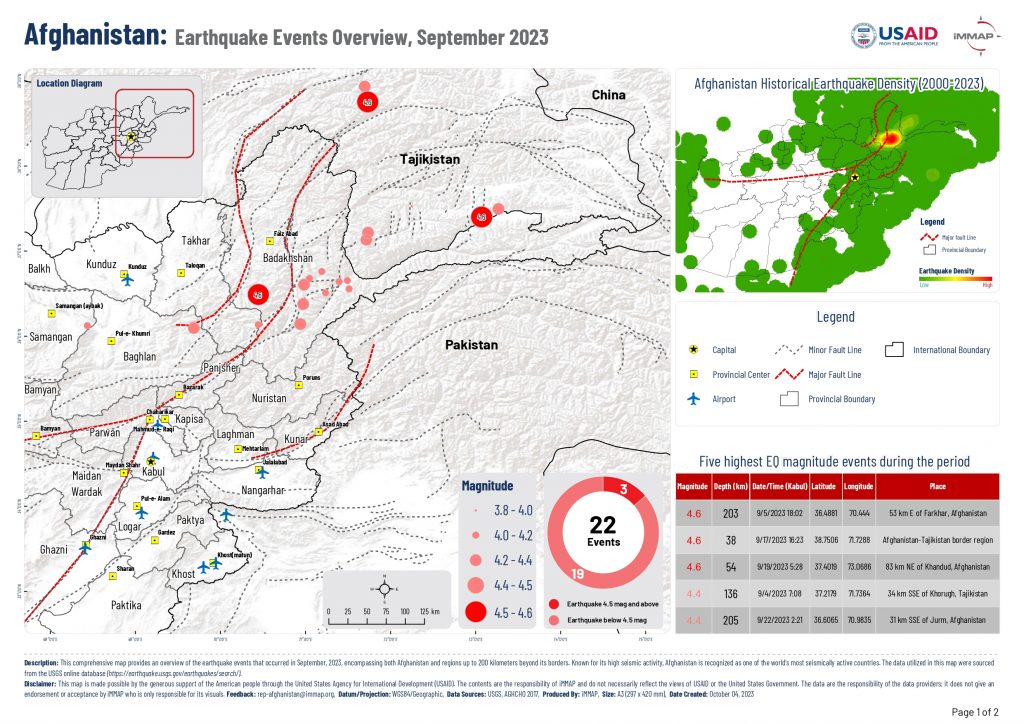
Afghanistan: Earthquake Events Overview (September 2023)
This map provides a detailed overview of earthquakes in Afghanistan and 200km beyond its borders. This includes magnitudes, epicenter locations, and dates of occurrences.
Read more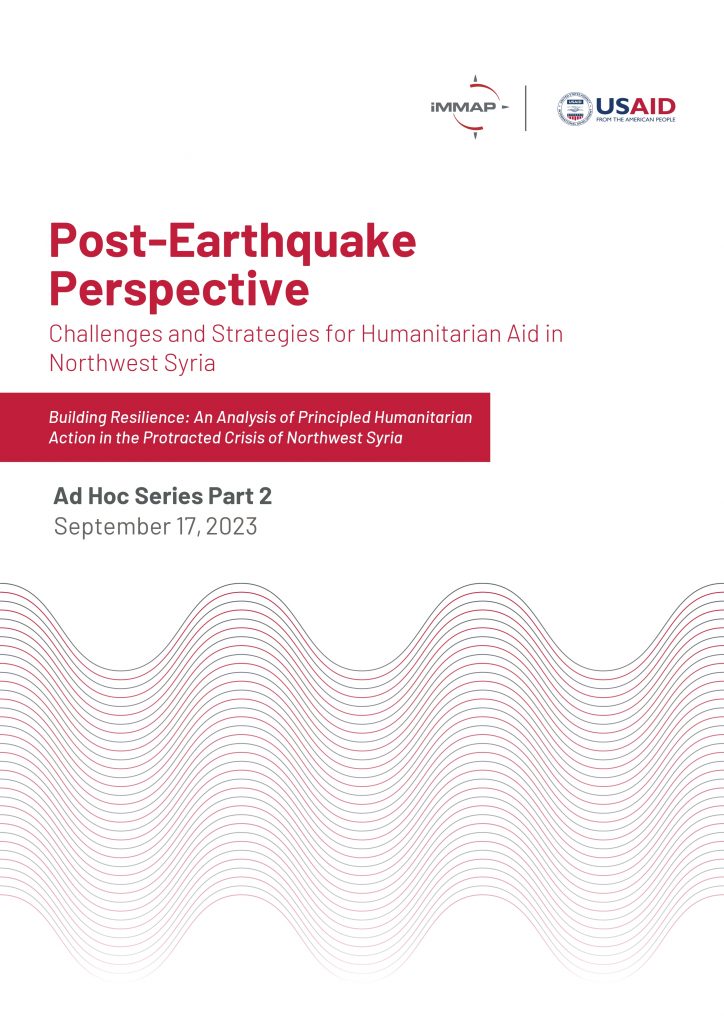
Post-Earthquake Perspective: Challenges and Strategies for Humanitarian Aid in Northwest Syria (Part 2)
This report, the second of a two-part series, focuses on highlighting structural issues in the current aid landscape, exemplified by gaps in the earthquake response. Its goal is to provide a comprehensive resource for better understanding aid operations, and to facilitate informed and actionable conversations between humanitarian actors, donors, government agencies and other stakeholders involved in Syria. The report aims to add to existing discussions surrounding possible paths forward for the humanitarian response in NWS, particularly in tackling increasing politicization and worsening needs amid an ongoing, protracted crisis.
Read more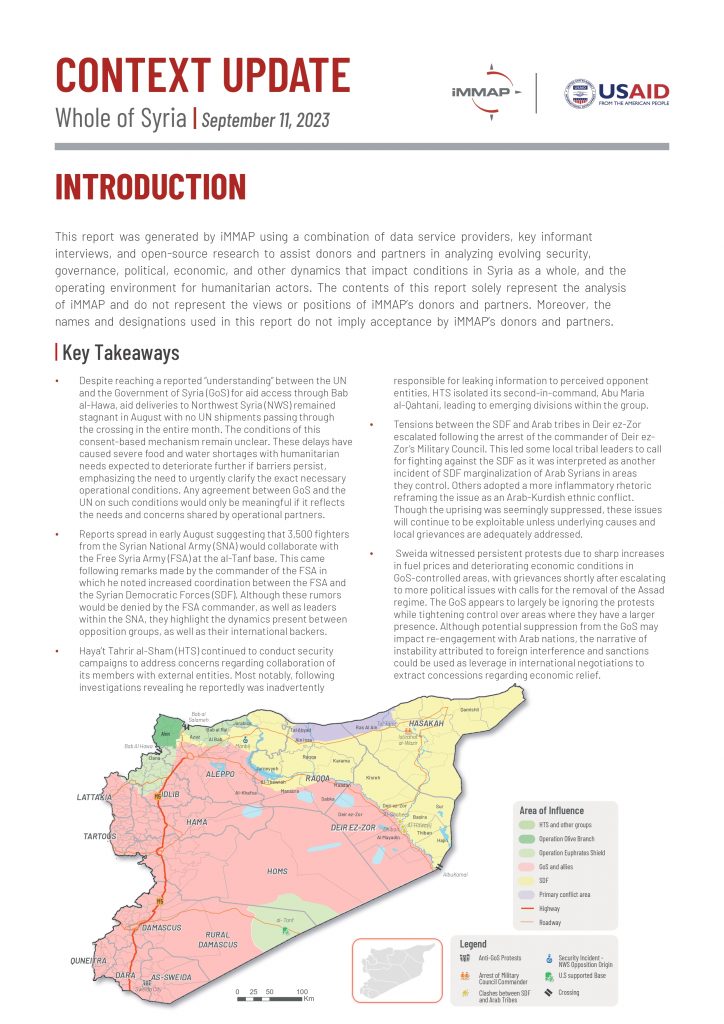
Context Update - Whole of Syria - August 2023
The month of August was marked by several developments in Syria, all of which underline the current challenges facing the country's various centers. Aid access to the NWS remains an urgent concern. Although the UN announced that it had reached an "agreement" with the Syrian government regarding access to aid via Bab al-Hawa, obstacles persisted in August. Delays and a lack of clarity surrounded the consent-based mechanism, resulting in a sharp reduction in aid deliveries. The humanitarian situation in the northwestern states deteriorated, with shortages of basic necessities such as bread and drinking water.
Read more
Wheat to Bread Market Assessment (Part 2) – Northeast Syria – August 2023
The main focus of this study is to further examine the availability and cost-effectiveness of inputs crucial for bread production, particularly wheat grains and flour.
Read more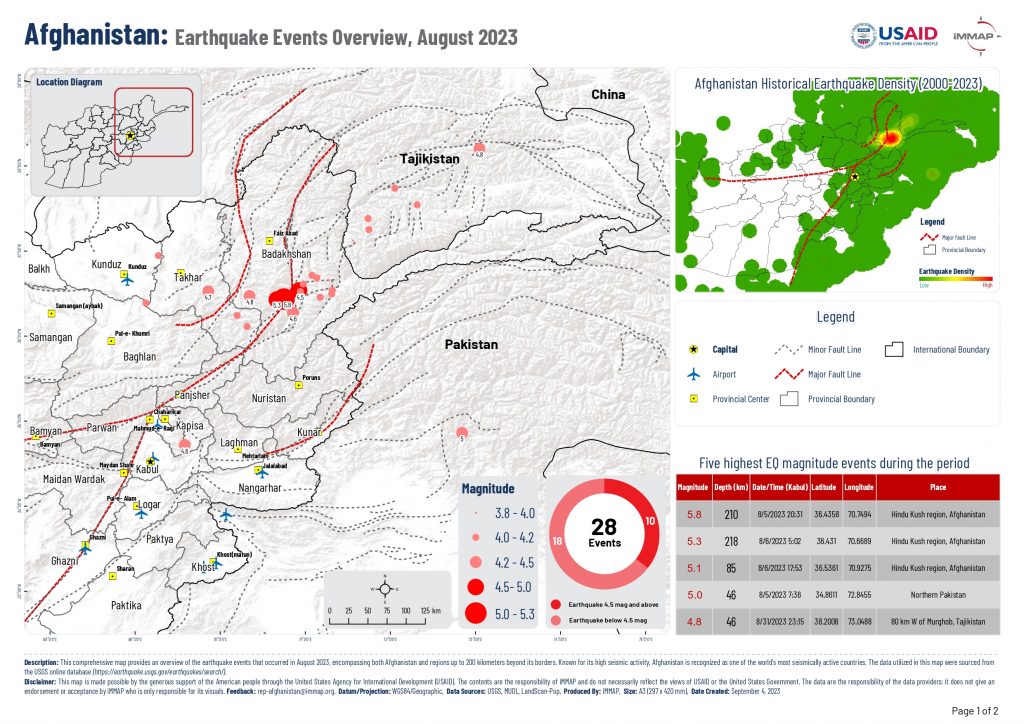
Afghanistan: Earthquake Events Overview (August 2023)
This map provides a detailed overview of earthquakes in Afghanistan and 200km beyond its borders. This includes magnitudes, epicenter locations, and dates of occurrences.
Read more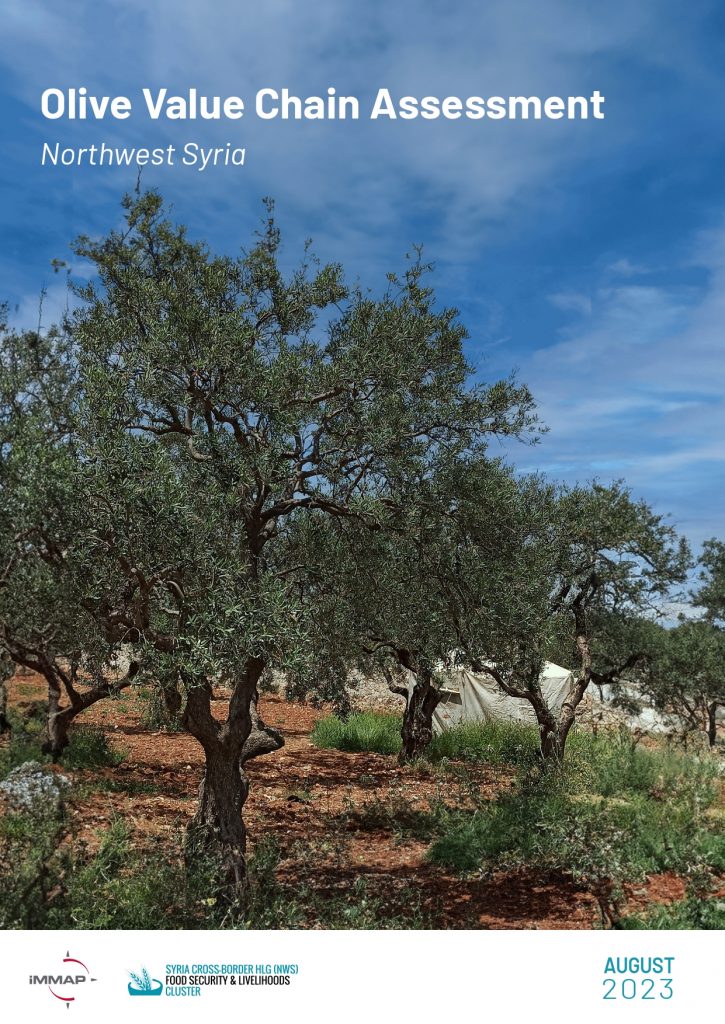
Olive Value Chain Assessment - Northwest Syria - August 2023
This study examines Northwest Syria's olive value chain, addressing challenges and opportunities. Despite its economic importance, conflict and climate pose risks. Utilizing a mixed-method approach, encompassing interviews with stakeholders from farmers to traders, the study analyzes phases like cultivation and marketing.
Read more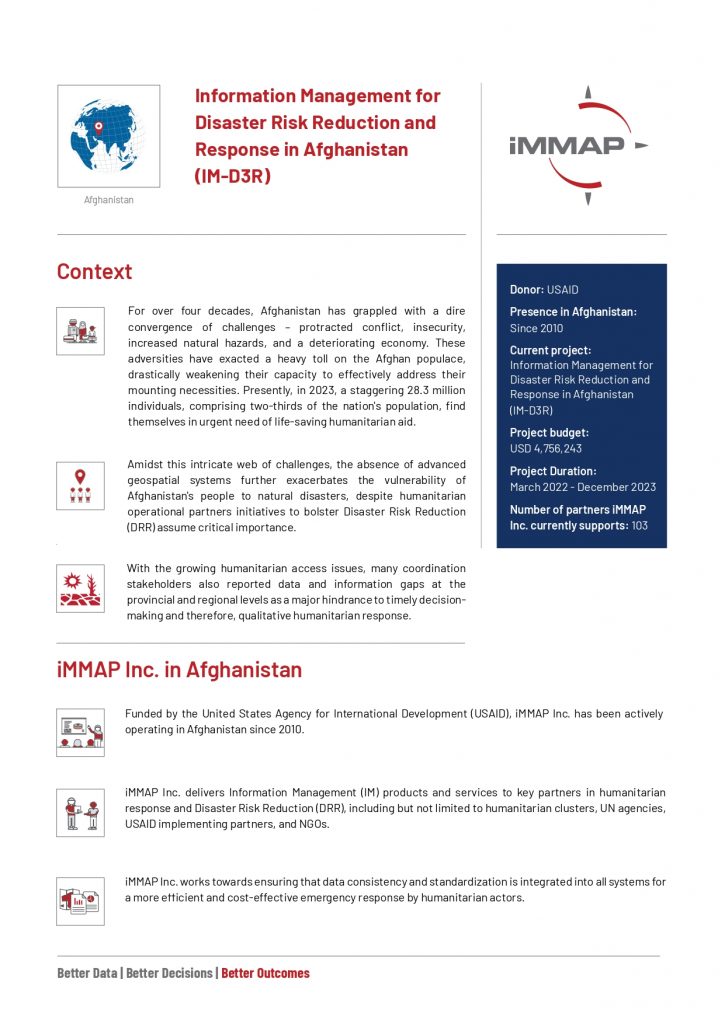
Information Management for Disaster Risk Reduction and Response in Afghanistan
iMMAP delivers Information Management (IM) products and services to key partners in humanitarian response and Disaster Risk Reduction (DRR), including but not limited to the humanitarian clusters, UN agencies, USAID implementing partners, and NGOs.
Read more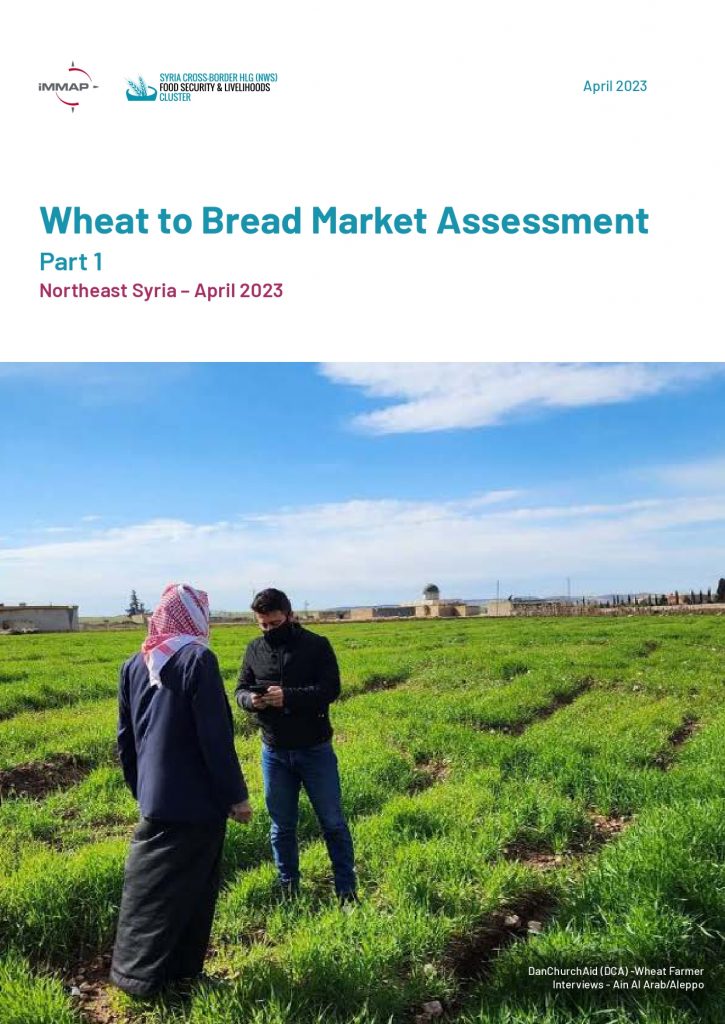
Wheat to Bread Market Assessment (Part 1) – Northeast Syria – April 2023
The evaluation of the wheat-to-bread market system focuses on the challenges and opportunities faced by wheat growers in northeastern Syria during the post-crop wheat season for the 2022-2023 season.
Read more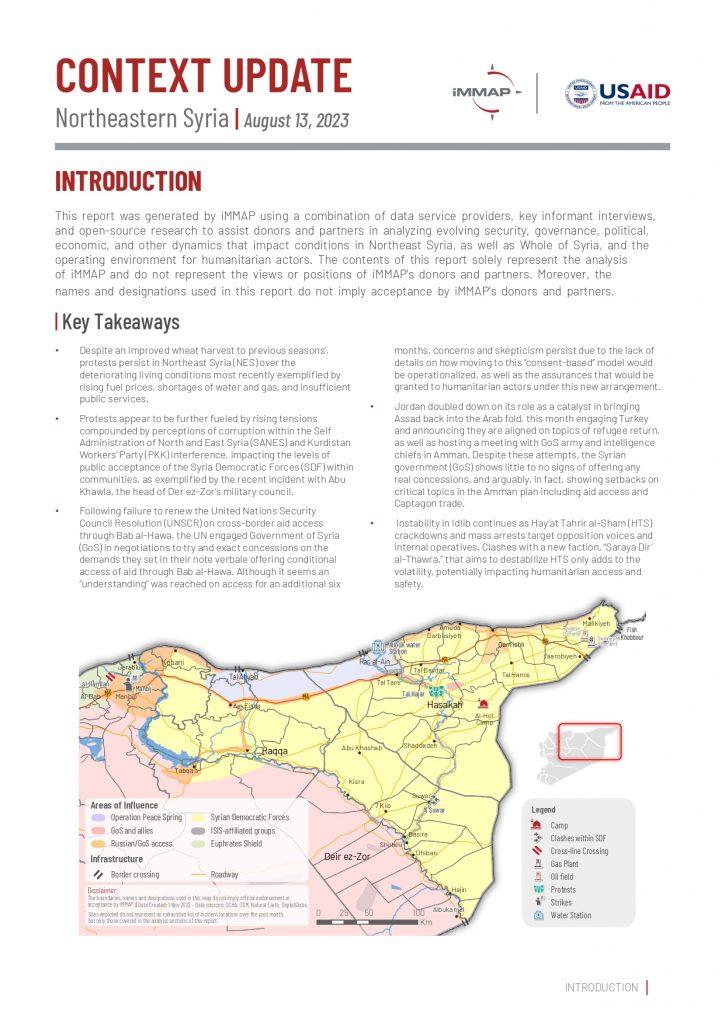
Northeast Syria – Context Update – July 2023
This report provides an overview of the current context in Northeast Syria as of July 2023, highlighting the ongoing challenges faced by the region, including conflict, displacement, and limited access to basic services. This context update also discusses the efforts of humanitarian organizations to address the needs of vulnerable communities. Overall, this report emphasizes the continued need for support and assistance to address the ongoing humanitarian crisis in Northeast Syria.
Read more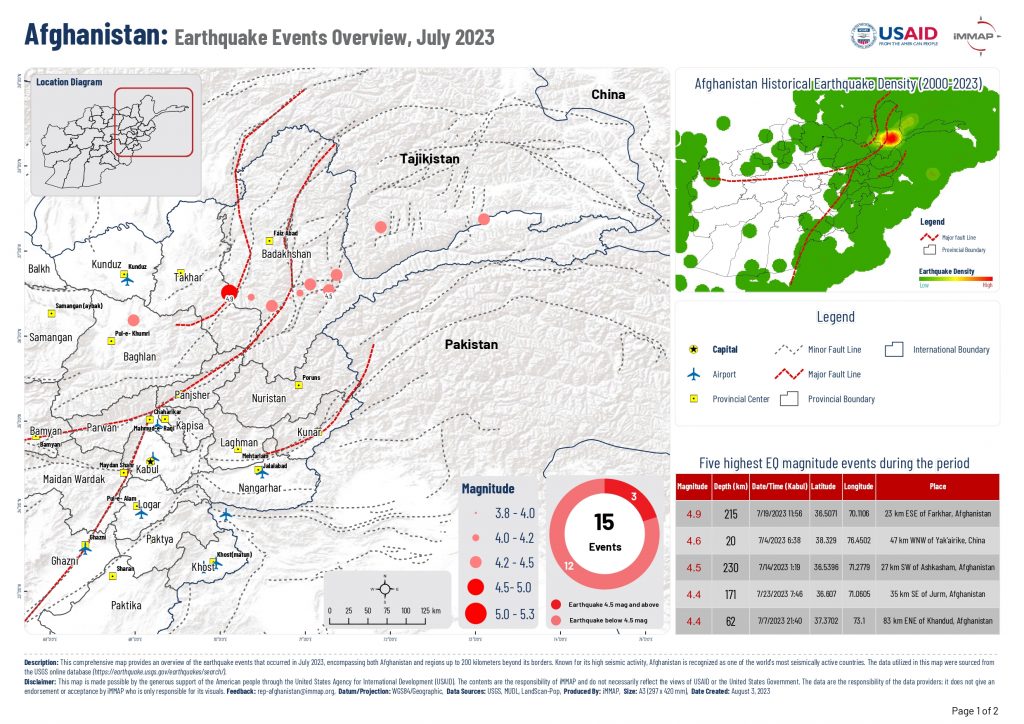
Afghanistan: Earthquake Events Overview (July 2023)
This map provides a detailed overview of earthquakes in Afghanistan and 200km beyond its borders. This includes magnitudes, epicenter locations and date of occurrences. The geographic visualization aims to provide a better understanding of the regions affected and the intensity of each seismic event. In addition, the first page provides a summary of earthquakes that occurred in July 2023, while the second page illustrates a cumulative overview of seismic events from January to July 2023.
Read more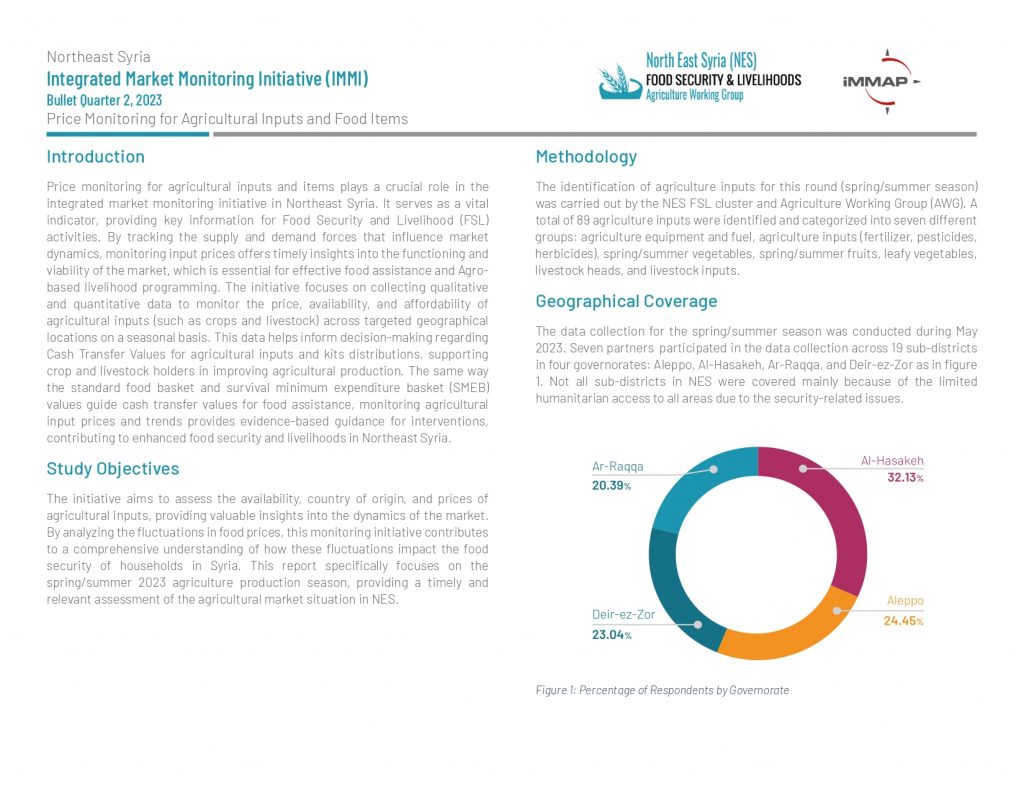
Northeast Syria: Integrated Market Monitoring Initiative - Q2 2023
Price monitoring for agricultural inputs and items plays a crucial role in the integrated market monitoring initiative in Northeast Syria. It serves as a vital indicator, providing key information for Food Security and Livelihood (FSL) activities. By tracking the supply and demand forces that influence market dynamics, monitoring input prices offers timely insights into the functioning and viability of the market, which is essential for effective food assistance and Agro-based livelihood programming. The initiative focuses on collecting qualitative and quantitative data to monitor the price, availability, and affordability of agricultural inputs (such as crops and livestock) across targeted geographical locations on a seasonal basis.
Read more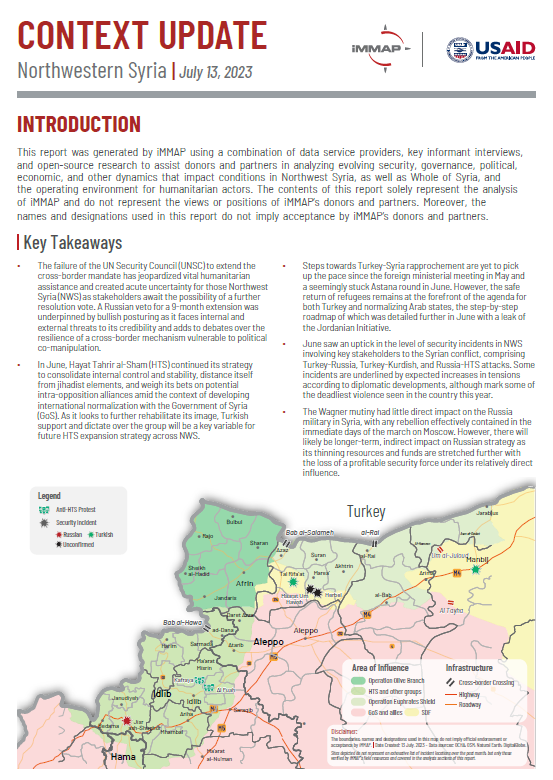
Northwestern Syria: Context Update - July 2023
This report was developed by iMMAP to assist donors and partners in analyzing evolving security, governance, political, economic, and other dynamics that impact conditions in Northwest Syria, as well as the Whole of Syria, and the operating environment for humanitarian actors. The contents of this report solely represent the analysis of iMMAP and do not represent the views or positions of iMMAP’s donors and partners. Moreover, the names and designations used in this report do not imply acceptance by iMMAP’s donors and partners.
Read more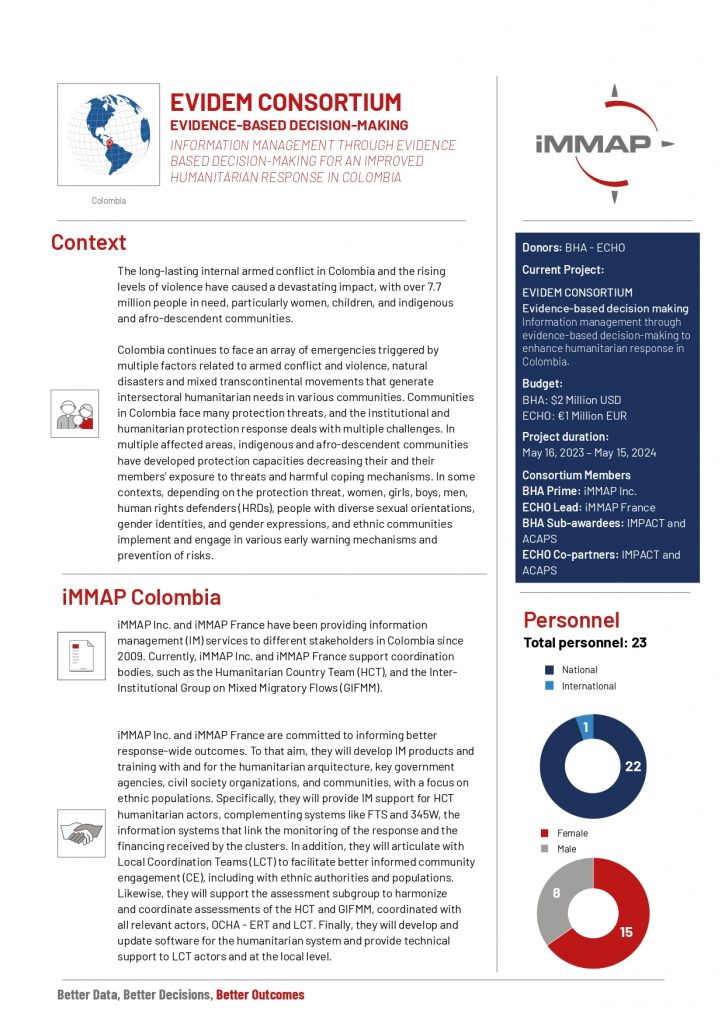
EVIDEM Consortium: Information Management Through Evidence-Based Decision-Making for an Improved Humanitarian Response in Colombia
EVIDEM Consortium: Information Management Through Evidence-Based Decision-Making for an Improved Humanitarian Response in Colombia
Read more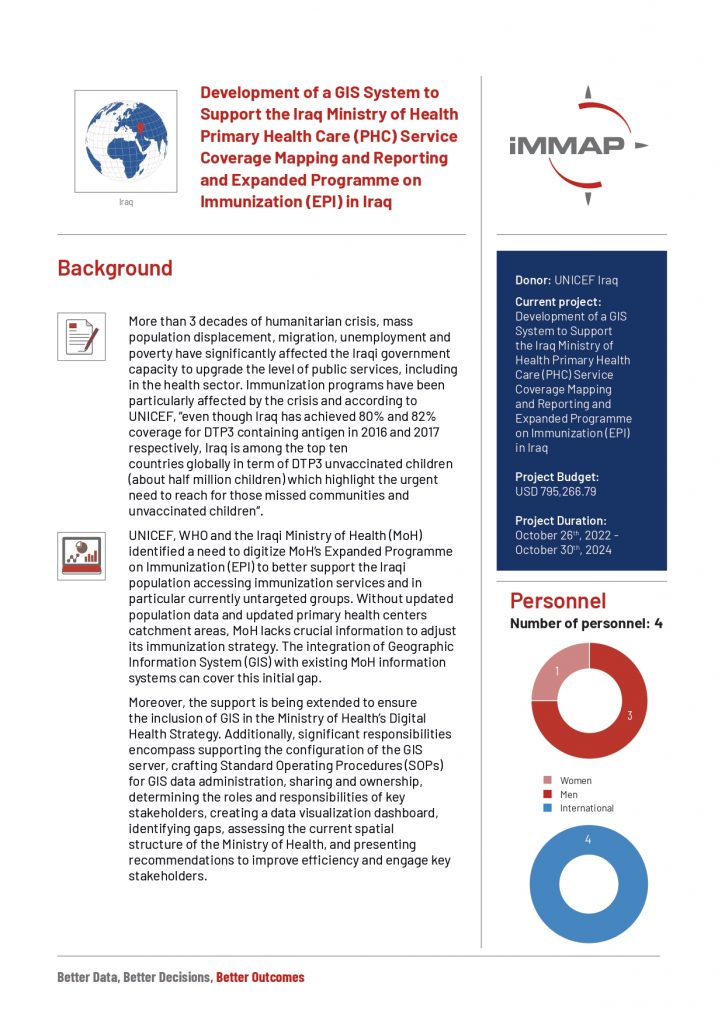
Development of a GIS System to Support the Iraq Ministry of Health Primary Health Care (PHC) Service Coverage Mapping and Reporting and Expanded Programme on Immunization (EPI) in Iraq
Development of a GIS System to Support the Iraq Ministry of Health Primary Health Care (PHC) Service Coverage Mapping and Reporting and Expanded Programme on Immunization (EPI) in Iraq
Read more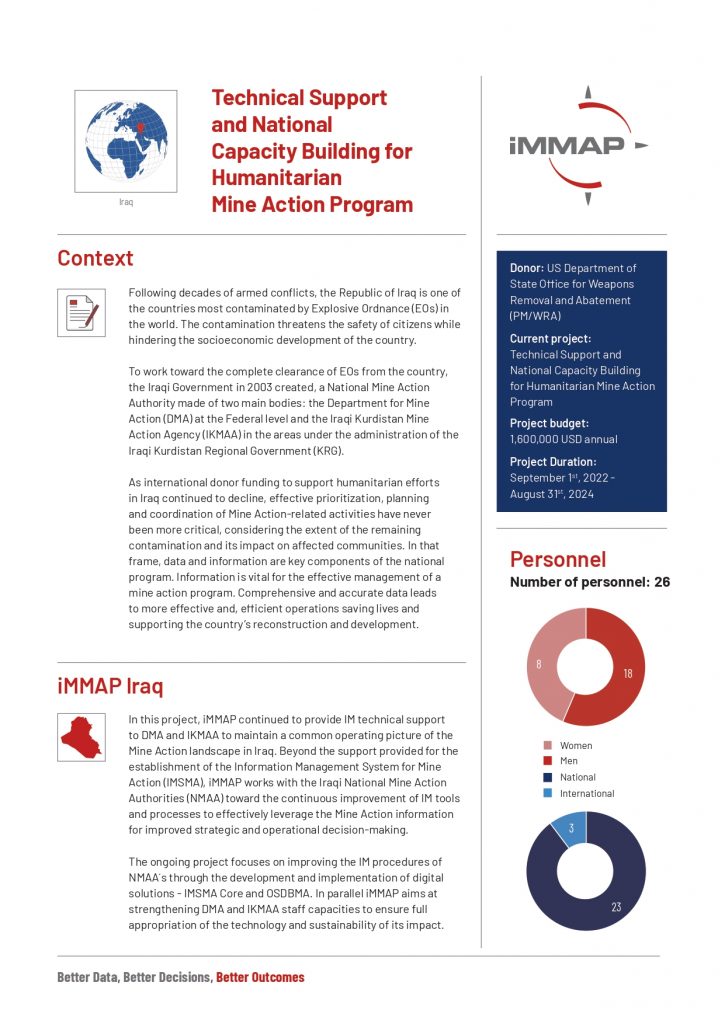
Technical Support and National Capacity Building for Humanitarian Mine Action Program
iMMAP provides ongoing technical support to the Iraqi government and its partners to establish a common operating picture to effectively task and manage EO clearance and mitigation activities. iMMAP focuses on improving the capacity of national staff members in order to provide better services to the humanitarian mine action (HMA) community, resulting in more effective and efficient methods of reducing EO hazards.
Read more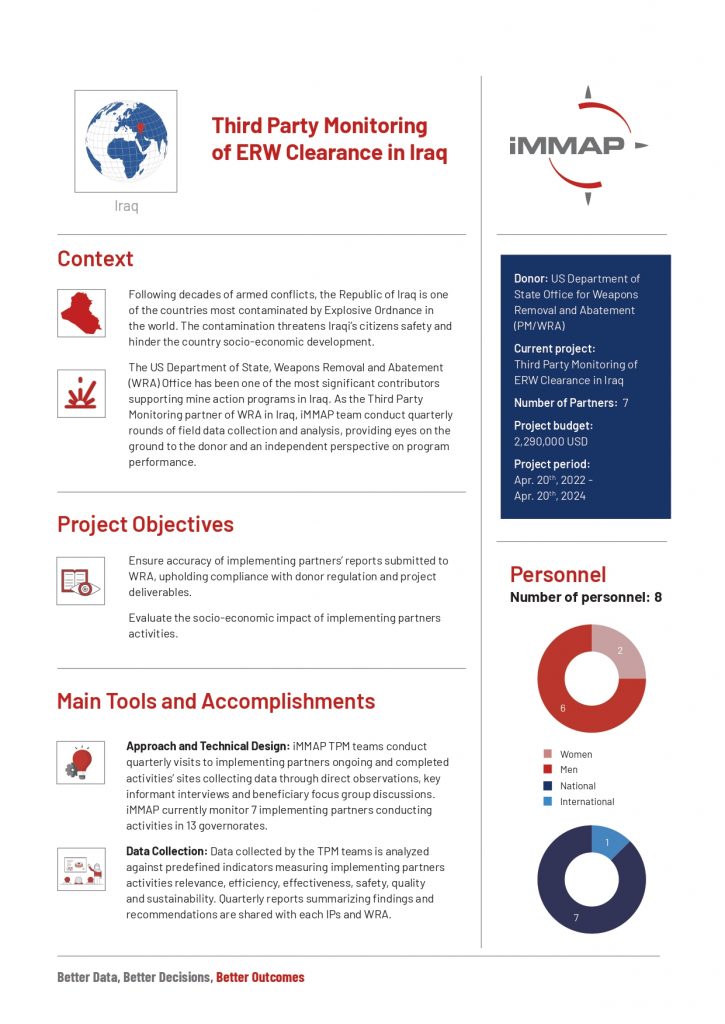
Third Party Monitoring of ERW Clearance in Iraq
Third Party Monitoring of ERW Clearance in Iraq
Read more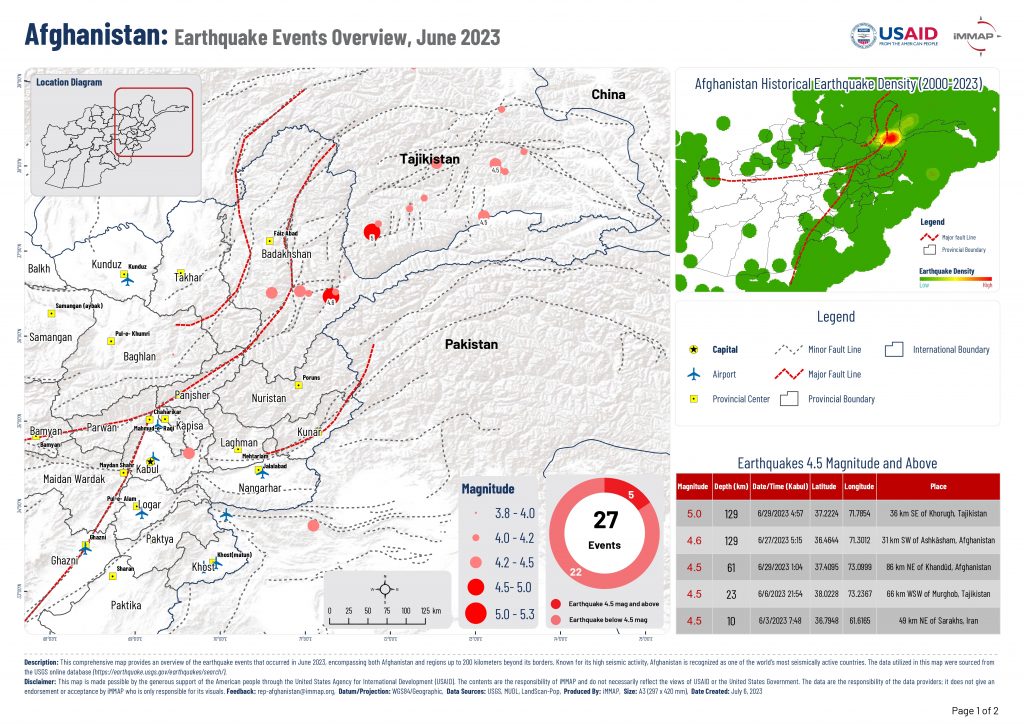
Afghanistan: Earthquake Events Overview (June 2023)
This map provides a detailed overview of earthquakes in Afghanistan and 200km beyond its borders. This includes magnitudes, epicenter locations and date of occurrences. The geographic visualization aims to provide a better understanding of the regions affected and the intensity of each seismic event. In addition, the first page provides a summary of earthquakes that occurred in June 2023, while the second page illustrates a cumulative overview of seismic events from January to May 2023.
Read more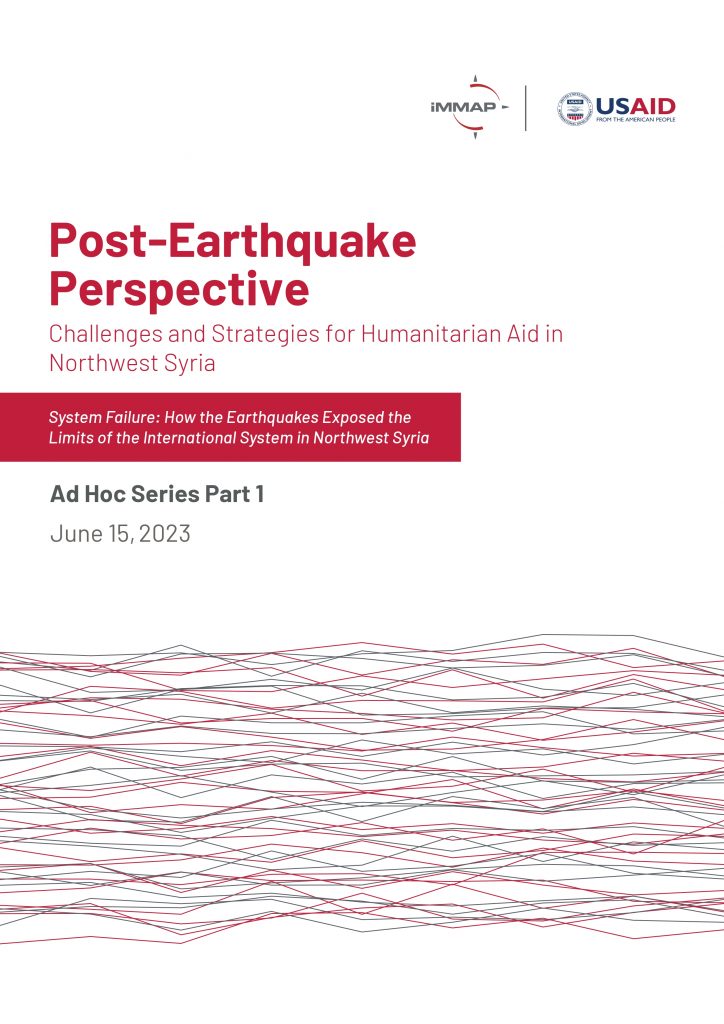
Post-Earthquake Perspective: Challenges and Strategies for Humanitarian Aid in Northwest Syria (Part 1)
This report, the first of a two-part series, focuses on highlighting structural issues in the current aid landscape, exemplified by gaps in the earthquake response. Its goal is to provide a comprehensive resource for better understanding aid operations, and to facilitate informed and actionable conversations between humanitarian actors, donors, government agencies and other stakeholders involved in Syria. It aims to enable actors to find more resilient and effective response mechanisms based on an understanding of existing limitations, humanitarian needs and lessons learned from previous experiences.
Read more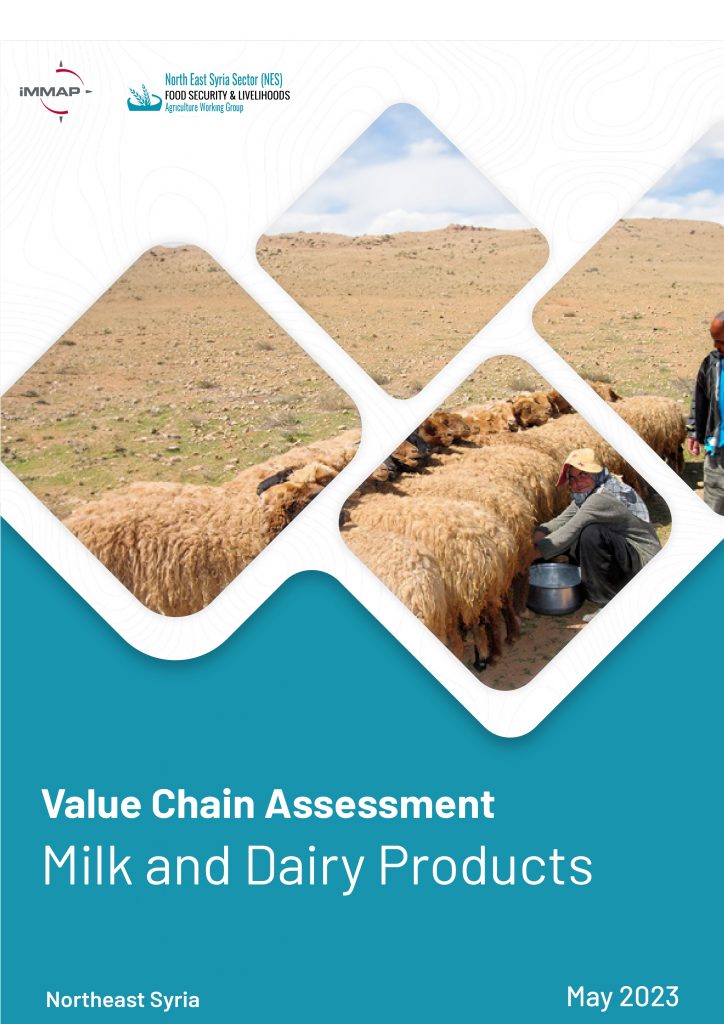
Value Chain Assessment of Milk and Dairy Products in Northeast Syria
Conflict and the COVID-19 pandemic have had a significant impact on the dairy sector in Syria, with a 47% drop in milk production between 2010 and 2019, leading to food insecurity and nutrition problems for many Syrians. In response, the Food Security and Livelihoods Cluster (FSL) in Northeast Syria (NES) and iMMAP assessed the dairy value chain in NES, focusing on input supply chain management and output markets for milk and dairy products in the region. The assessment aims to provide an in-depth analysis of the dairy value chain in Northeast Syria, including the current state of the sector, stakeholder challenges and potential opportunities for growth and development.
Read more
Context Update - Northeast Syria -May 2023
This report provides an overview of the current context in Northeast Syria as of May 2023, highlighting the ongoing challenges faced by the region, including conflict, displacement, and limited access to basic services. This context update also discusses the efforts of humanitarian organizations to address the needs of vulnerable communities. Overall, this report emphasizes the continued need for support and assistance to address the ongoing humanitarian crisis in Northeast Syria.
Read more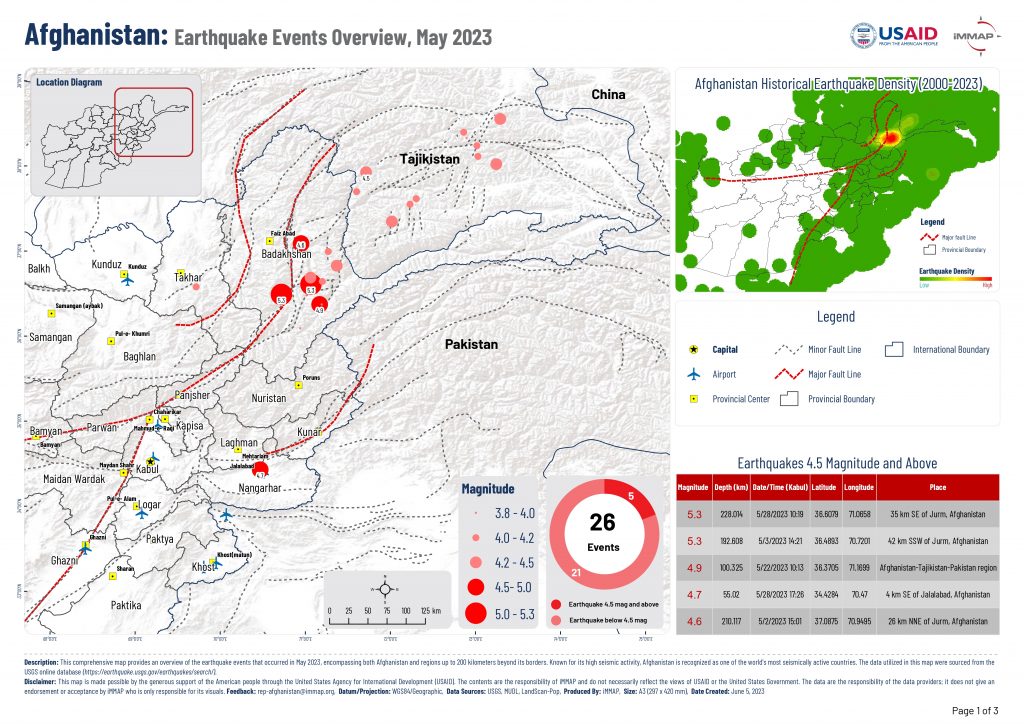
Afghanistan: Earthquake Events Overview (May 2023)
This comprehensive map provides an overview of the earthquake events that occurred in May 2023 and from January to May 2023, encompassing both Afghanistan and regions up to 200 kilometers beyond its borders. Known for its high seismic activity, Afghanistan is recognized as one of the world's most seismically active countries.
Read more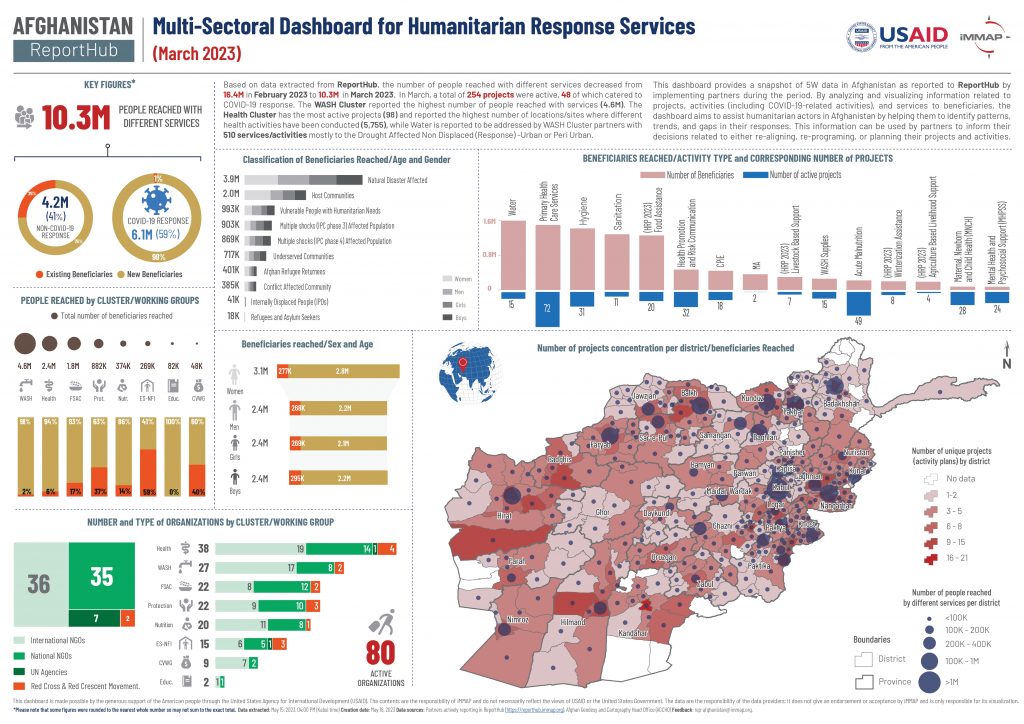
Afghanistan: Multi-Sectoral Dashboard for Humanitarian Response Services (March 2023)
This dashboard provides a snapshot of 5W data in Afghanistan as reported to ReportHub by implementing partners during the period. By analyzing and visualizing information related to projects, activities (including COVID-19-related activities), and services to beneficiaries, the dashboard aims to assist humanitarian actors in Afghanistan by helping them to identify patterns, trends, and gaps in their responses. This information can be used by partners to inform their decisions related to either re-aligning, re-programing, or planning their projects and activities.
Read more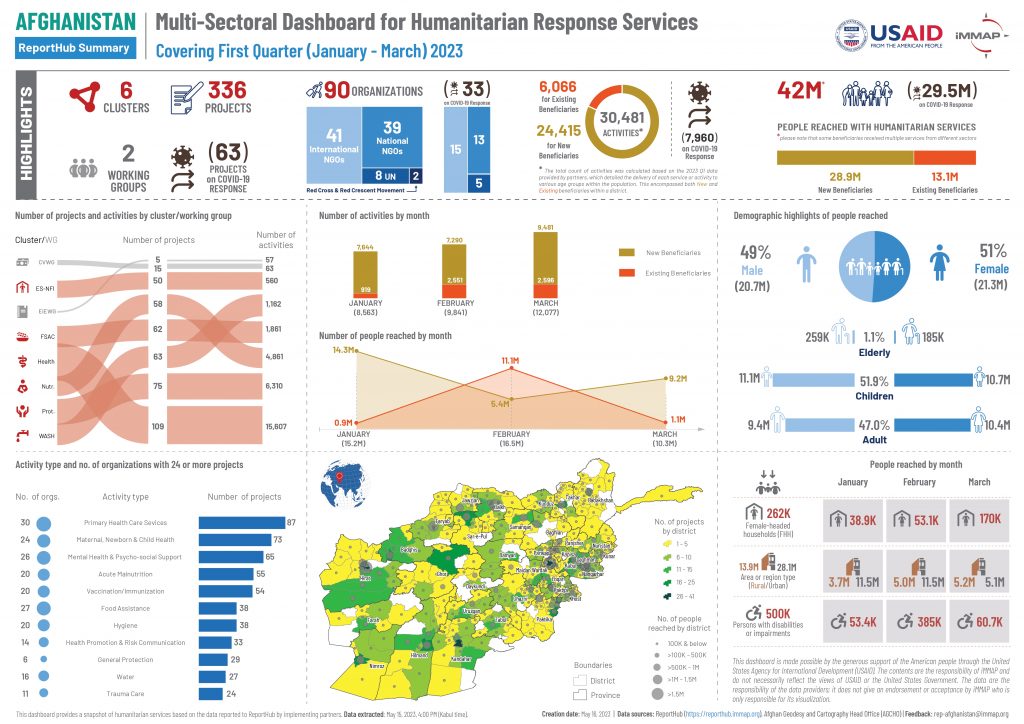
Afghanistan: Multi-Sectoral Dashboard for Humanitarian Response Services (Q1 2023)
The dashboard provides an extensive multi-sectoral overview of the humanitarian response services in Afghanistan. The product covers the first quarter of 2023 (January-March) and details the people reached by sectors, age, gender, and the actors who have been involved in the response at multi-sectoral level. By using the information in the dashboard, decision-makers will be able to plan, re-program, and re-align their succeeding months or their future projects. The data in the dashboard is sourced from ReportHub and submitted by implementing partners from multiple sectors.
Read more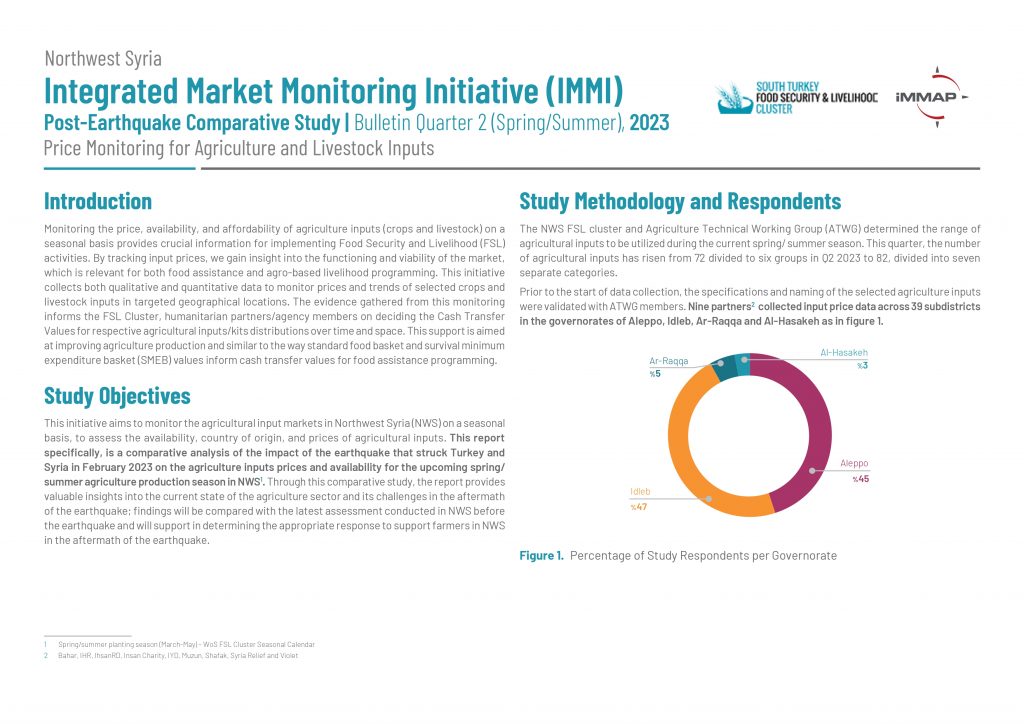
Integrated Market Monitoring Initiative - Northwest Syria (Post-Earthquake Comparative Study)
This initiative aims to monitor agricultural input markets in Northwest Syria (NWS) on a seasonal basis to assess the availability, country of origin, and prices of agricultural inputs. This report is a comparative analysis of the impact of the earthquake that struck Turkey and Syria in February 2023 on agricultural input prices and availability for the upcoming spring/summer agricultural season in NWS1. Through this comparative study, the report provides valuable insights into the current state of the agriculture sector and its post-earthquake challenges. The results are compared to the last assessment conducted in the NWS before the earthquake and help determine the appropriate actions to support farmers in the NWS after the earthquake.
Read more
Context Update - Northwest Syria - April 2023
This report provides an overview of the current context in Northwest Syria as of April 2023, highlighting the ongoing challenges faced by the region, including conflict, displacement, and limited access to basic services. This context update also discusses the efforts of humanitarian organizations to address the needs of vulnerable communities. Overall, this report emphasizes the continued need for support and assistance to address the ongoing humanitarian crisis in Northeast Syria.
Read more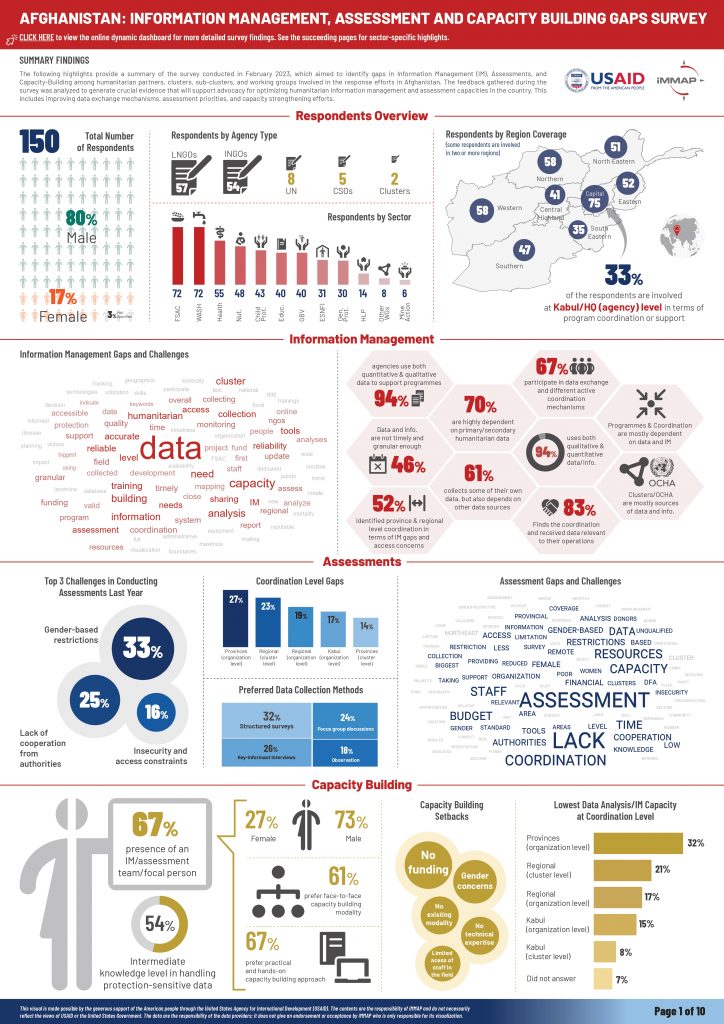
Afghanistan: Information Management Assessment and Capacity Building Gaps Survey
The following dashboard summarizes a survey conducted in February 2023 to identify gaps among humanitarian partners in Afghanistan. The survey aimed to gather feedback and generate evidence to support advocacy for enhancing humanitarian information management and assessment capacities in the country. This includes improving data exchange, assessment priorities, and capacity strengthening efforts.
Read more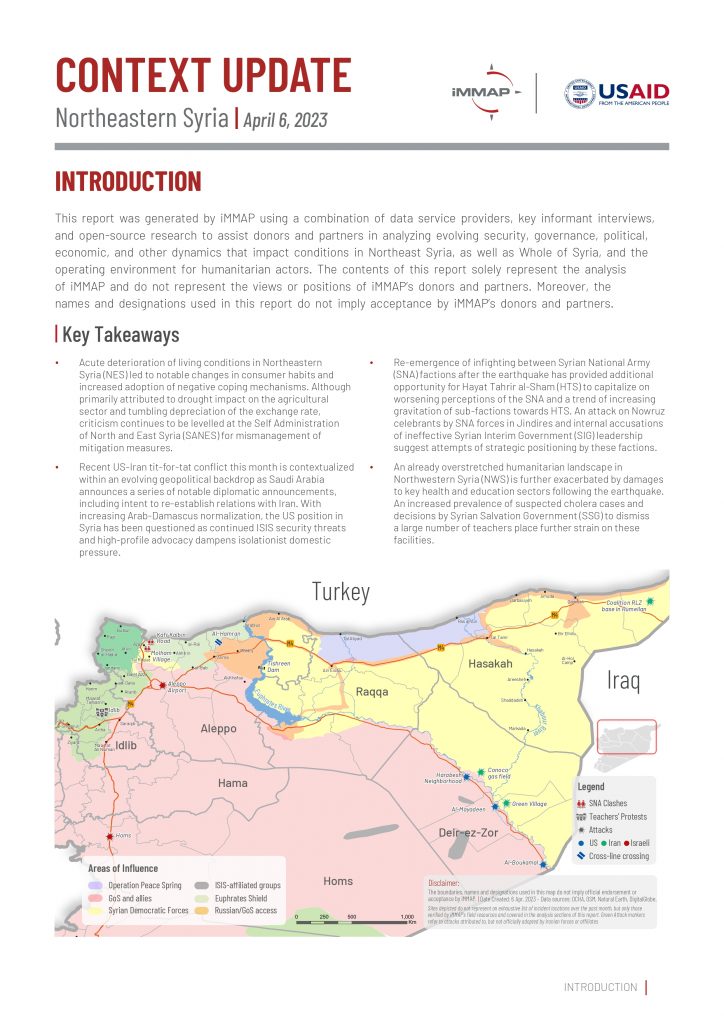
Context Update - Syria - March 2023
This report provides an overview of the current context in Northeast Syria as of March 2023, highlighting the ongoing challenges faced by the region, including conflict, displacement, and limited access to basic services. This context update also discusses the efforts of humanitarian organizations to address the needs of vulnerable communities. Overall, this report emphasizes the continued need for support and assistance to address the ongoing humanitarian crisis in Northeast Syria.
Read more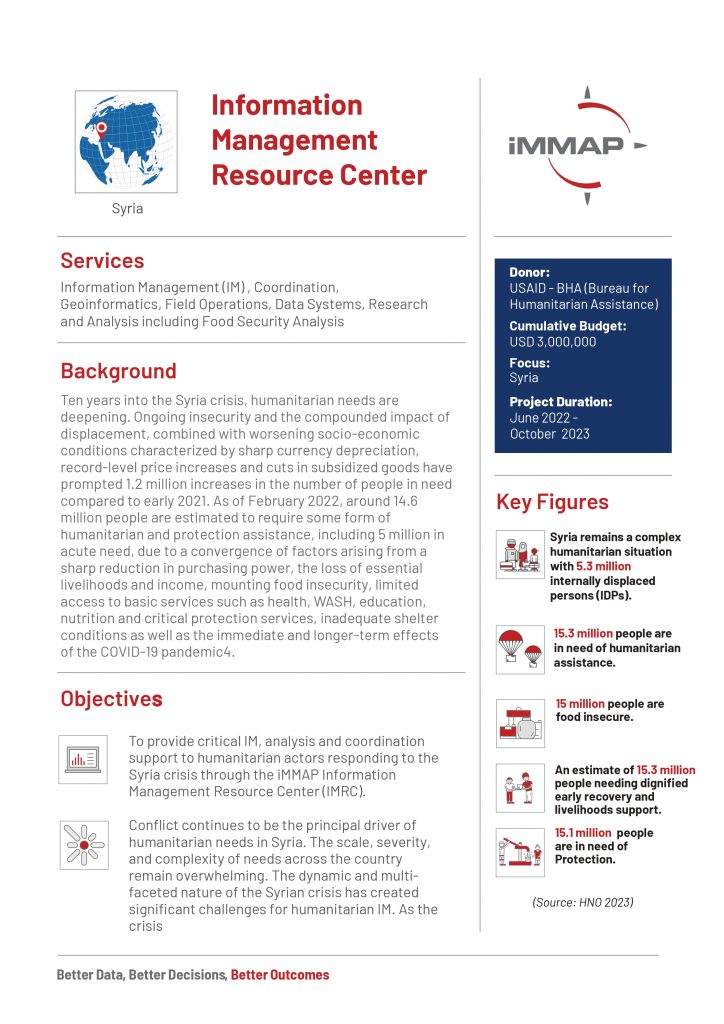
Information Management Resource Center (IMRC) in Syria
The Information Management Resource Center (IMRC) project is an initiative of the International Organization for Migration (IOM). It provides information management (IM) services to support the humanitarian response to the crisis in Syria. The project aims to improve IM by establishing a data-sharing platform, developing information management tools, and providing training and technical support to humanitarian organizations. The goal is to enhance coordination of aid efforts, monitor the situation on the ground, and provide assistance to those affected by the crisis.
Read more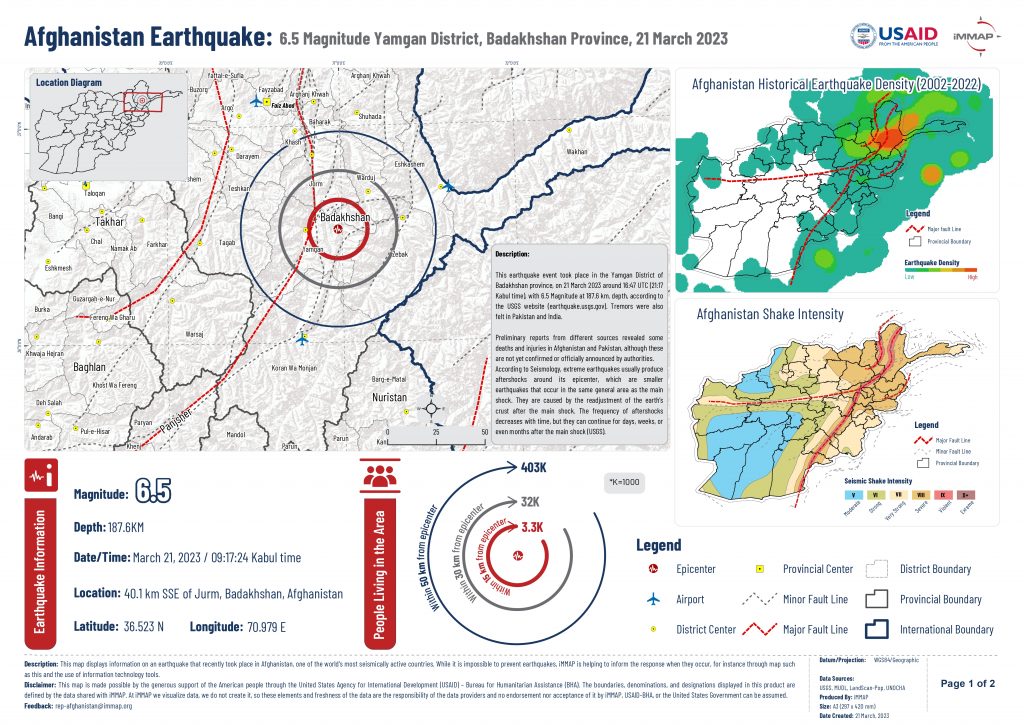
Afghanistan Earthquake: 6.5 Magnitude Yamgan District, Badakhshan Province, 21 March 2023
This earthquake event took place in the Yamgan District of Badakhshan province, on 21 March 2023 around 16:47 UTC (21:17 Kabul time), with 6.5 Magnitude at 187.6 km depth, according to the USGS website (earthquake.usgs.gov). Tremors were also felt in Pakistan and India. Preliminary reports from different sources revealed some deaths and injuries in Afghanistan and Pakistan, although these are not yet confirmed or officially announced by authorities. According to Seismology, extreme earthquakes usually produce aftershocks around its epicenter, which are smaller earthquakes that occur in the same general area as the main shock. They are caused by the readjustment of the earth’s crust after the main shock. The frequency of aftershocks decreases with time, but they can continue for days, weeks, or even months after the main shock (USGS).
Read more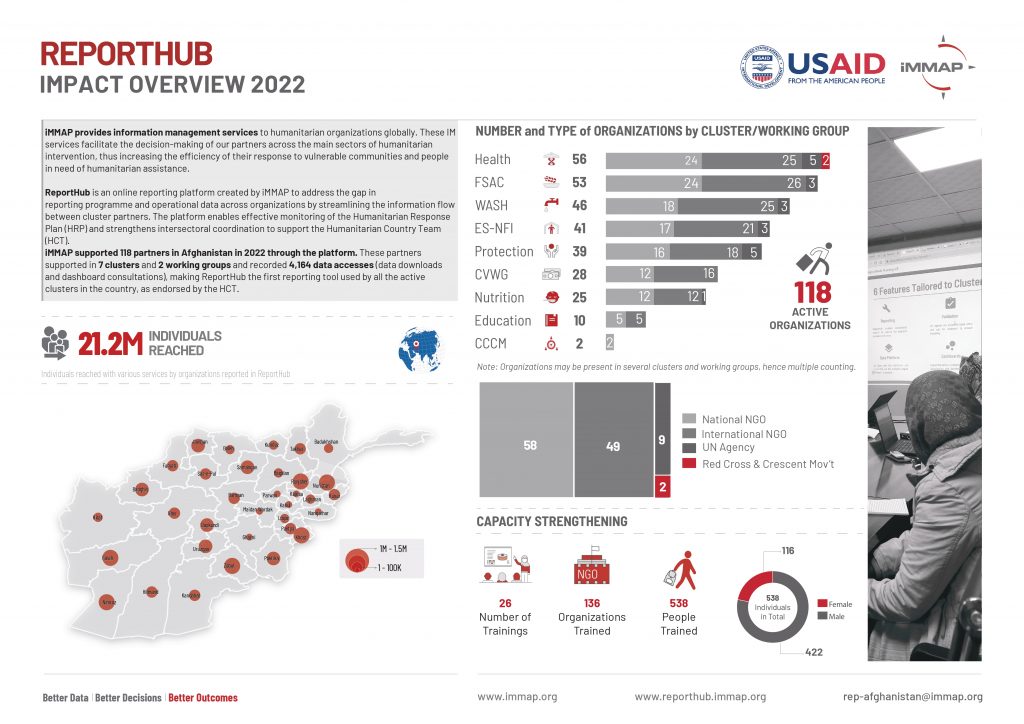
ReportHub Impact Overview - Afghanistan 2022
ReportHub is an online reporting platform created by iMMAP to address the gap in reporting programme and operational data across organizations by streamlining the information flow between cluster partners. The platform enables effective monitoring of the Humanitarian Response Plan (HRP) and strengthens intersectoral coordination to support the Humanitarian Country Team (HCT). iMMAP supported 118 partners in Afghanistan in 2022 through the platform. These partners supported in 7 clusters and 2 working groups and recorded 4,164 data accesses (data downloads and dashboard consultations), making ReportHub the first reporting tool used by all the active clusters in the country, as endorsed by the HCT.
Read more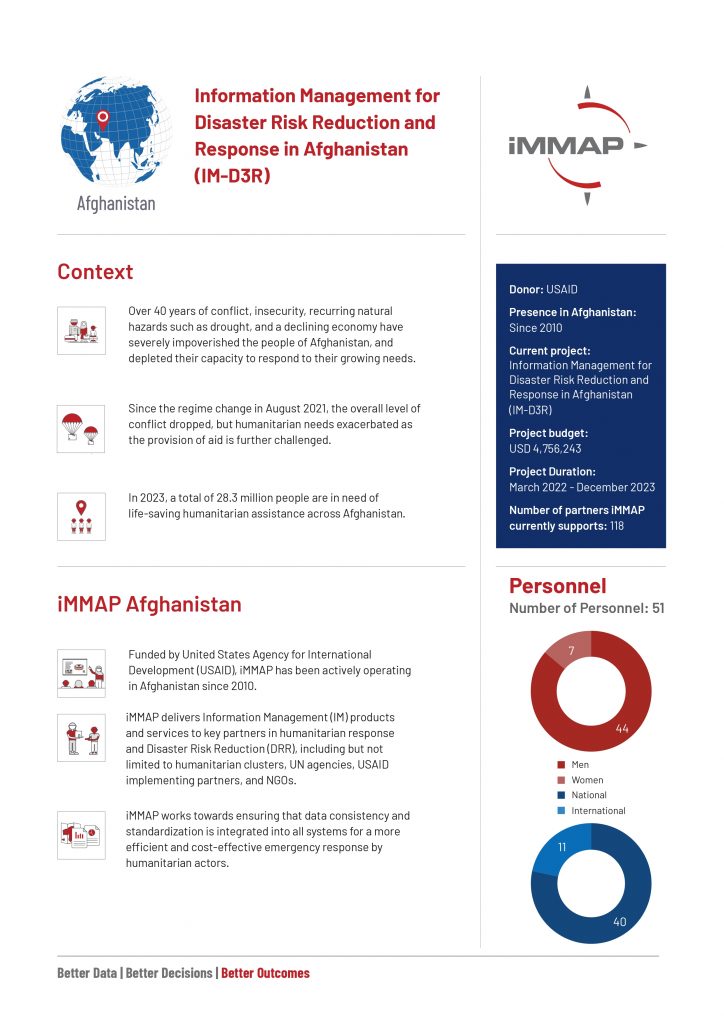
Information Management for Disaster Risk Reduction and Response in Afghanistan
iMMAP delivers Information Management (IM) products and services to key partners in humanitarian response and Disaster Risk Reduction (DRR), including but not limited to the humanitarian clusters, UN agencies, USAID implementing partners, and NGOs.
Read more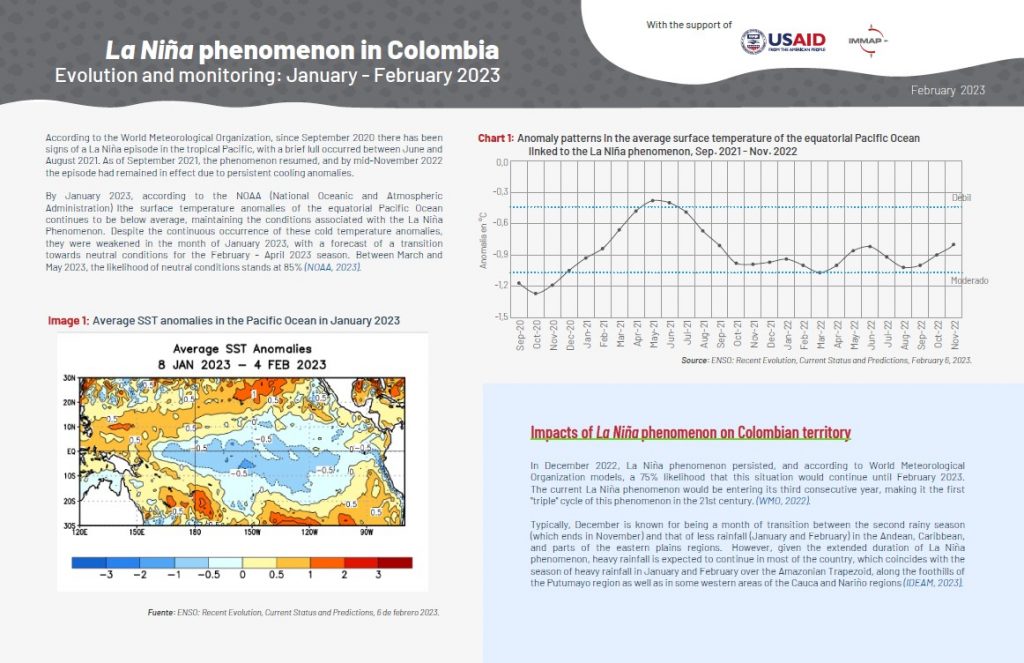
La Niña phenomenon in Colombia - Dashboard
In Colombia, the effects of La Niña are marked by a significant amount of rainfall and temperature drop in various regions of the country. Typically, December tends to be the month of transition between the second rainy season (which ends in November) and reduced rainfall (January and February) in the Andean, the Caribbean regions, and parts of the eastern plains. This following report highlights the situation and evolution of La Nina and how it impacted the Colombian territories between January and February 2023.
Read more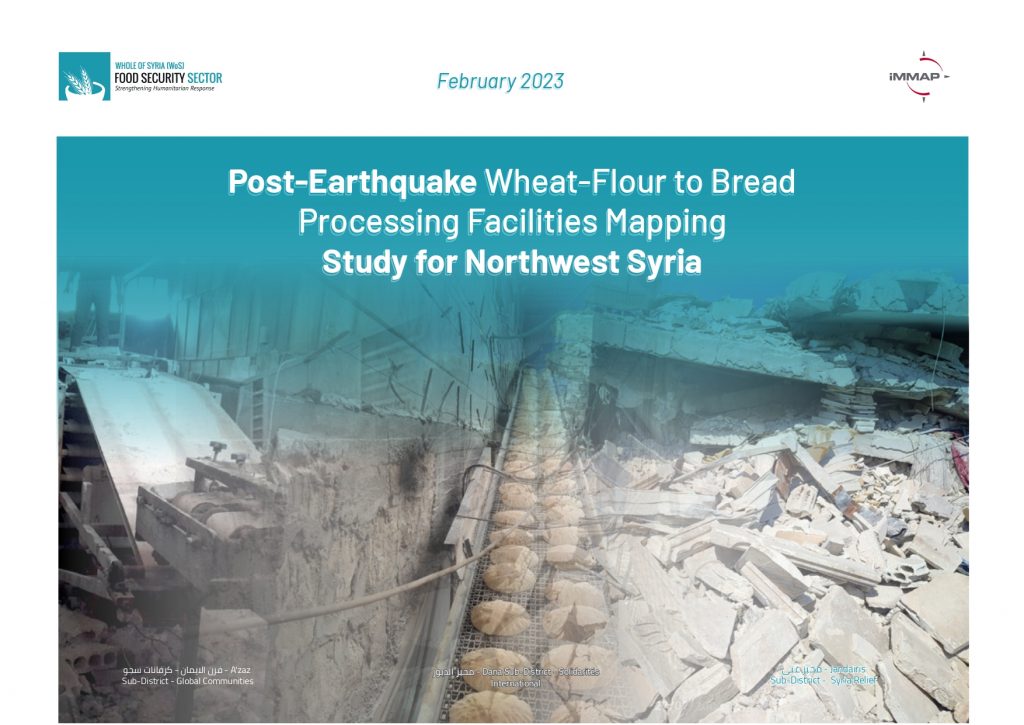
Post-Earthquake Mapping of Wheat-Flour to Bread Facilities in Northwest Syria
This study maps and monitors wheat-flour to bread processing and production facilities in both public and private sectors across Northwest Syria (NWS). It was conducted after the earthquake that hit Turkey and NW Syria on 6th February 2023, with the aim of assessing its impact on bread production facilities and the availability of bread in the region. The study's findings provide valuable insights into the current state of bread production facilities and can help inform future relief efforts. The study is produced in collaboration with USAID_BHA partners, NWS Food Security and Livelihood (FSL) Cluster members, Implementing Partners (IPs), and NWS Bread and Bakery Technical Working Group (BBTWG).
Read more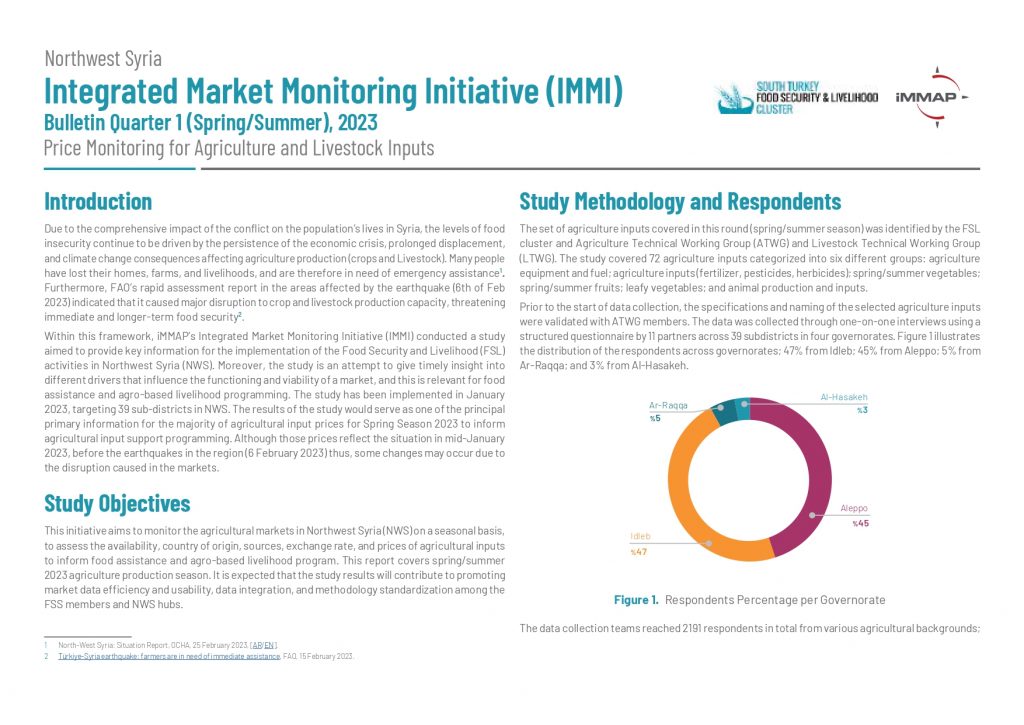
Integration Market Monitoring Initiative – Northeast Syria - Q1 2023
iMMAP's Integrated Market Monitoring Initiative (IMMI) conducted a study in January 2023 to provide information for implementing Food Security and Livelihood (FSL) activities in Northwest Syria (NWS). The study aims to give timely insight into different drivers that influence the viability of a market, which is relevant for food assistance and agro-based livelihood programming. The study targeted 39 sub-districts in NWS, and the results will serve as the primary information for agricultural input prices for Spring Season 2023 to inform agricultural input support programming. However, some changes may occur due to disruptions caused by earthquakes in the region in February 2023.
Read more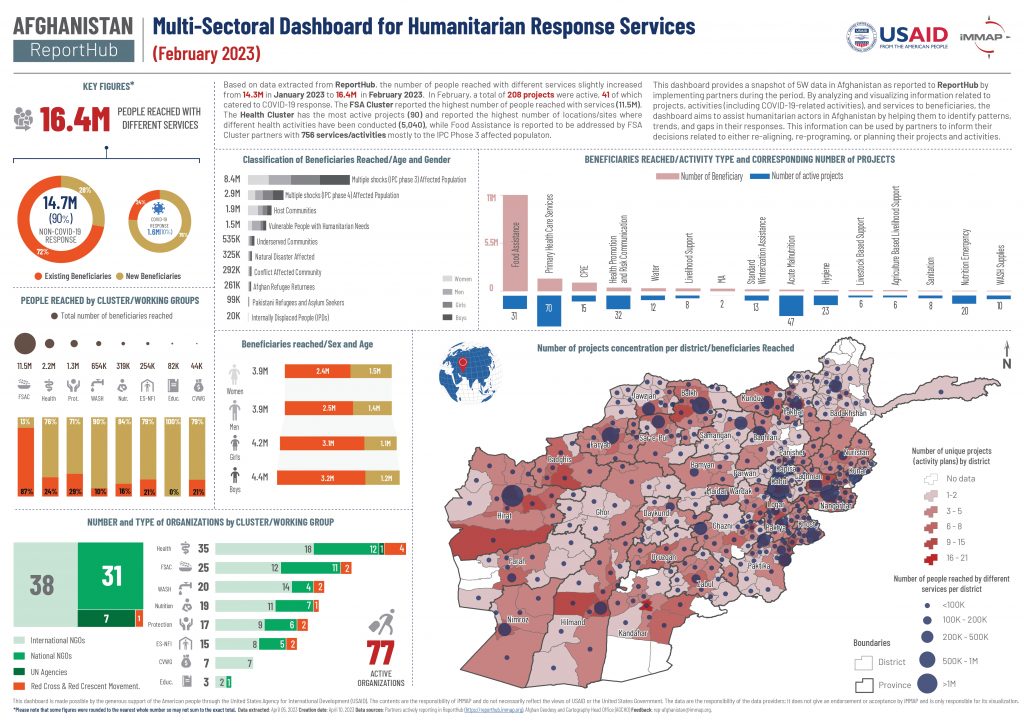
Afghanistan: ReportHub Multi-Sectoral Dashboard for Humanitarian Response Services (February 2023)
The ReportHub dashboard provides an overview of 5W data in Afghanistan as of February 2023, as reported by implementing partners. Through analysis and visualization of information on projects, activities (including COVID-19-related activities), and beneficiary services, the dashboard aims to help humanitarian actors in Afghanistan identify patterns, trends, and gaps in their responses. ReportHub is a platform that aggregates and visualizes data for humanitarian organizations. This information can be used by partners to inform their decisions about reorienting, reprogramming or planning their projects and activities.
Read more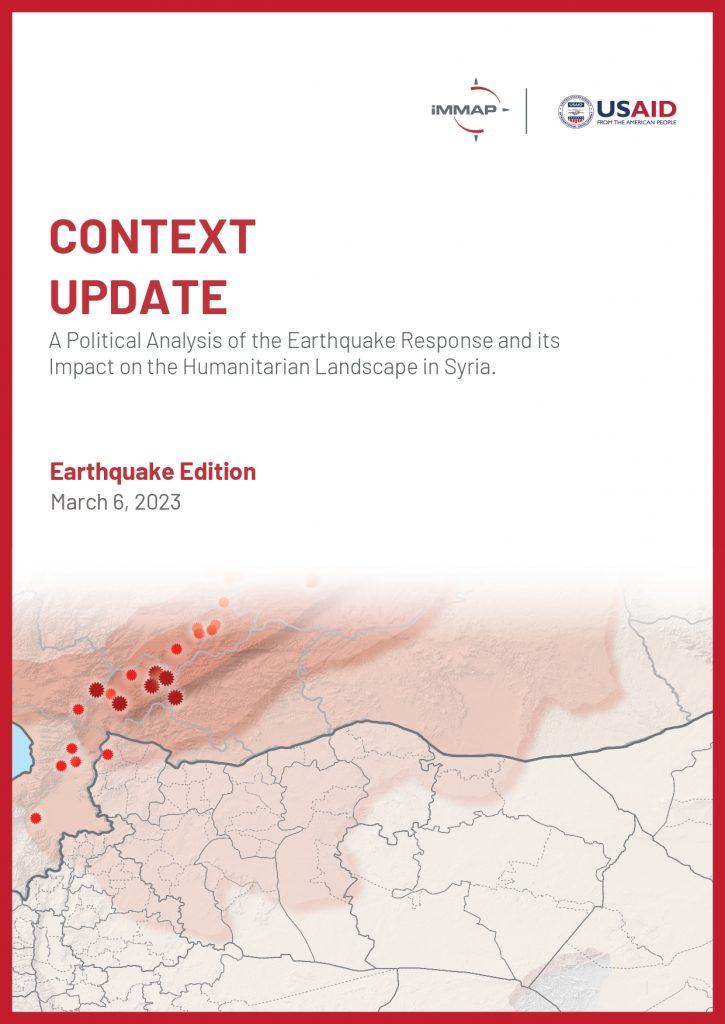
Context Update - Syria - February 2023
This report was generated by iMMAP using a combination of data service providers, key informant interviews, and open-source research to assist donors and partners in analyzing evolving security, governance, political, economic, and other dynamics that impact conditions in Northeast Syria, Northwest Syria, and Whole of Syria, as well as the operating environment for humanitarian actors. The contents of this report solely represent the analysis of iMMAP and do not represent the views or positions of iMMAP’s donors and partners. Moreover, the names and designations used in this report do not imply acceptance by iMMAP’s donors and partners.
Read more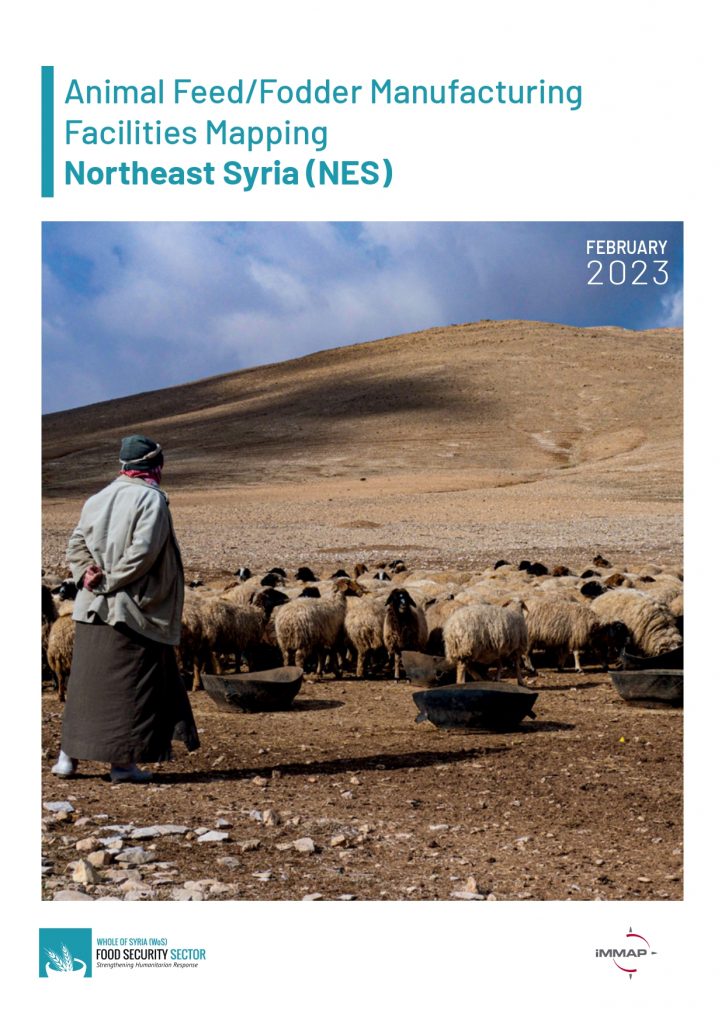
Northeast Syria: Animal Feed and Fodder Manufacturing Facility Mapping Report
The study aimed to collect data on animal feed and fodder facilities in Northeast Syria. It explores the operational capacity and commercialization of the livestock feed and fodder sector. The interviews were conducted using a semi-structured questionnaire developed by iMMAP in coordination with various organizations.
Read more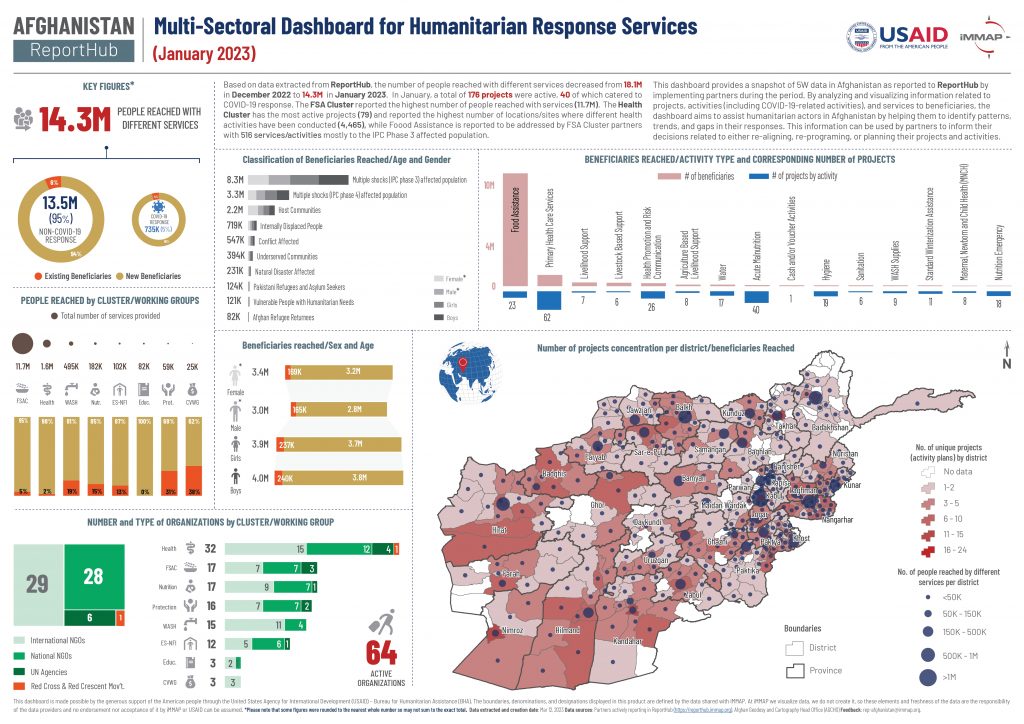
Afghanistan: ReportHub Multi-Sectoral Dashboard for Humanitarian Response Services (January)
The ReportHub dashboard provides an overview of 5W data in Afghanistan as of January 2023, as reported by implementing partners. Through analysis and visualization of information on projects, activities (including COVID-19-related activities), and beneficiary services, the dashboard aims to help humanitarian actors in Afghanistan identify patterns, trends, and gaps in their responses. ReportHub is a platform that aggregates and visualizes data for humanitarian organizations. This information can be used by partners to inform their decisions about reorienting, reprogramming or planning their projects and activities.
Read more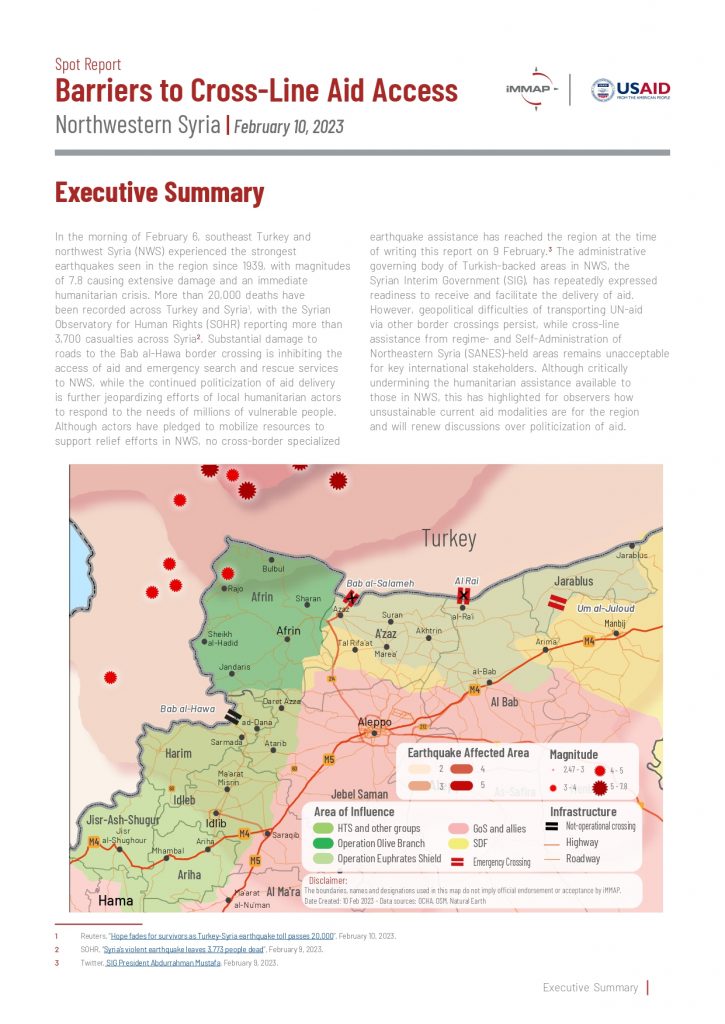
Earthquake - Barriers to Cross-Line Aid Access in Northwest Syria
Following the earthquakes that have caused extensive damage, and tragic loss of life across large areas of Turkey, and Syria, Northwestern Syria, local populations and humanitarian actors continue their relief efforts. However, hard-hit areas in Northwestern Syria (NWS) continue to be particularly vulnerable, largely due to the challenges faced in delivering aid to them through cross-border modalities. These challenges present a continuation of a pattern in which humanitarian aid into the area has been politicized. In our spot-report, we provide a brief on the contextual background that lead to the current challenges in delivering aid to NWS.
Read more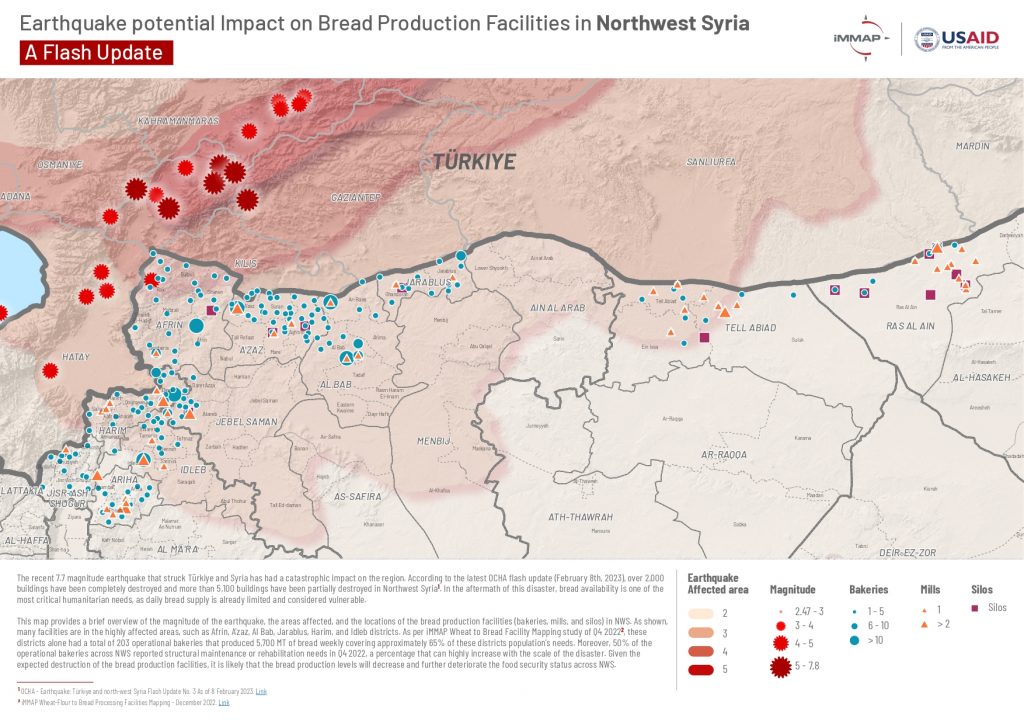
Earthquake potential impact on Bread Production Facilities in Northwest Syria
Food Security Flash Update: The recent earthquake that struck Türkiye and Syria has had a catastrophic impact on the region. In the aftermath of this disaster, bread availability is one of the most critical humanitarian needs, as daily bread supply is already limited and considered vulnerable.
Read more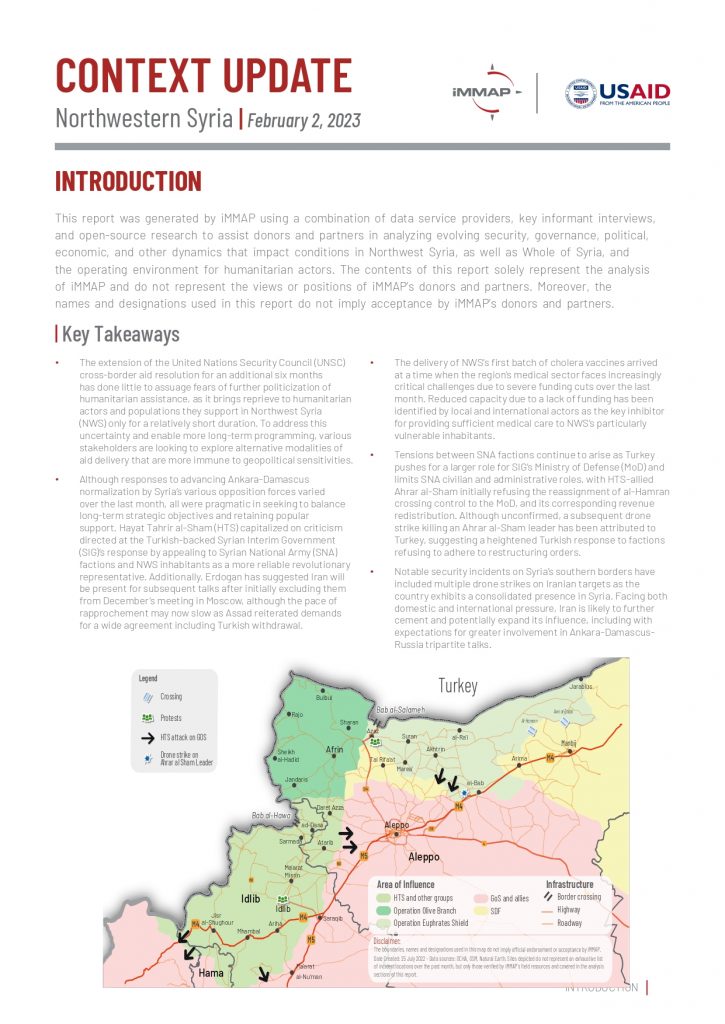
Context Update - Northwest Syria - January 2023
This report was generated by iMMAP using a combination of data service providers, key informant interviews, and open-source research to assist donors and partners in analyzing evolving security, governance, political, economic, and other dynamics that impact conditions in Northeast Syria, as well as Whole of Syria, and the operating environment for humanitarian actors. The contents of this report solely represent the analysis of iMMAP and do not represent the views or positions of iMMAP’s donors and partners. Moreover, the names and designations used in this report do not imply acceptance by iMMAP’s donors and partners.
Read more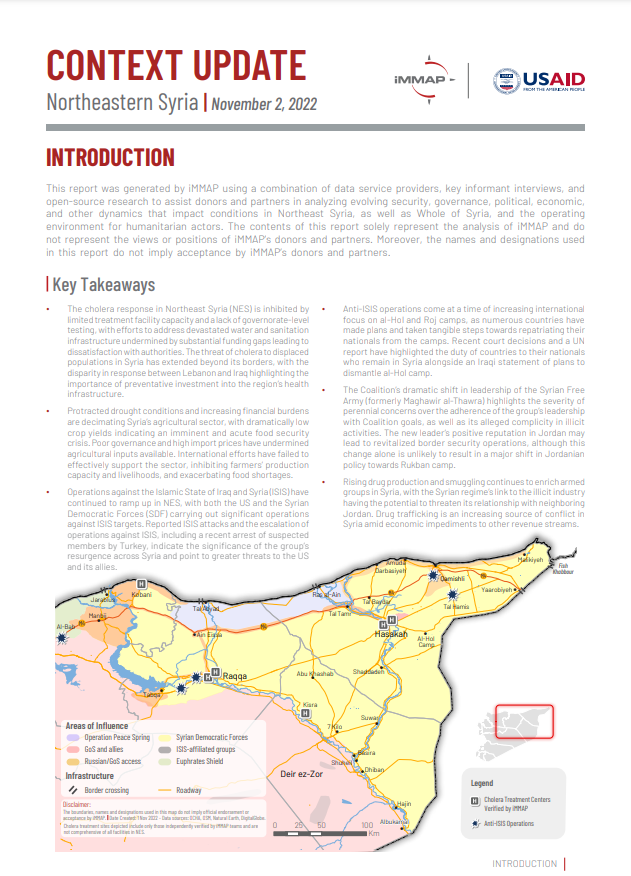
Context Update - Northeast Syria - January 2023
This report was generated by iMMAP using a combination of data service providers, key informant interviews, and open-source research to assist donors and partners in analyzing evolving security, governance, political, economic, and other dynamics that impact conditions in Northeast Syria, as well as Whole of Syria, and the operating environment for humanitarian actors. The contents of this report solely represent the analysis of iMMAP and do not represent the views or positions of iMMAP’s donors and partners. Moreover, the names and designations used in this report do not imply acceptance by iMMAP’s donors and partners.
Read more
Northwest Syria Wheat-to-Bread Summary Report (Q4 December 2022)
In collaboration with USAID_BHA partners, NWS Food Security and Livelihood (FSL) Cluster members and Implementing Partners (IPs) as well as NWS Bread and Bakery Technical Working Group (BBTWG) members, iMMAP conducted a regular mapping and monitoring exercise of the public and private wheat-flour to bread processing and production facilities across NWS.
Read more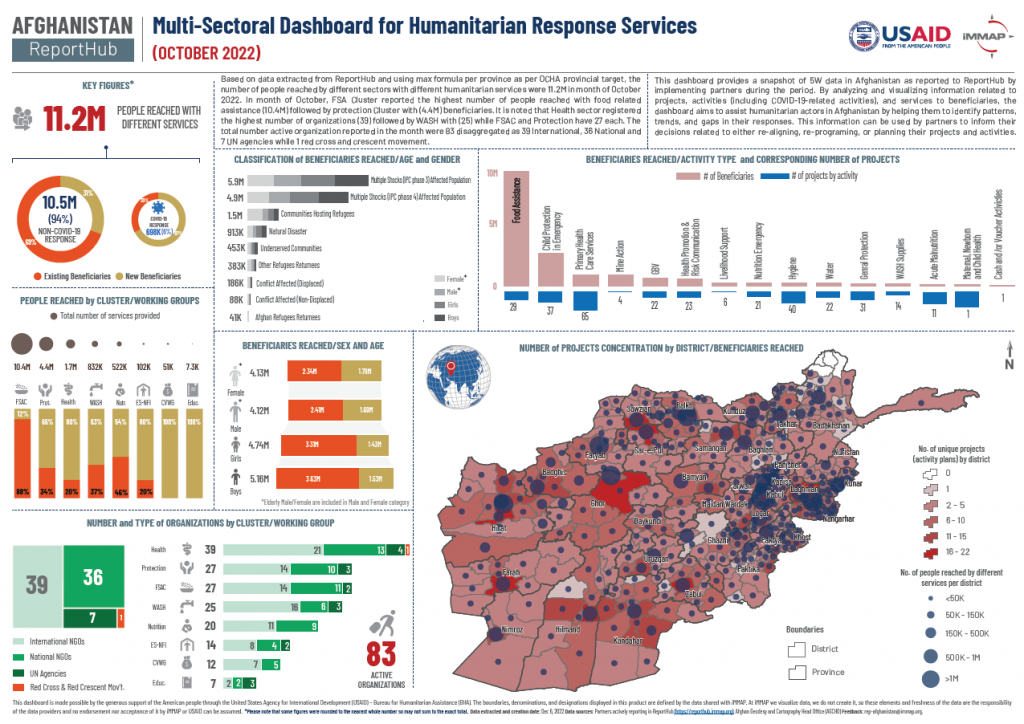
Afghanistan: Multi-Sectoral Dashboard for Humanitarian Response Services (October 2022)
The Multi-Sectoral Dashboard for Humanitarian Response Services provides a snapshot and overview of the information reported to ReportHub in Afghanistan by implementing partners compiled in October 2022. iMMAP’s ReportHub is an online reporting platform that addresses the gap in reporting operational data across organizations by streamlining the information flow between clusters, working groups, partners, and the Humanitarian Country Team in support of the Humanitarian Response Plan.
Read more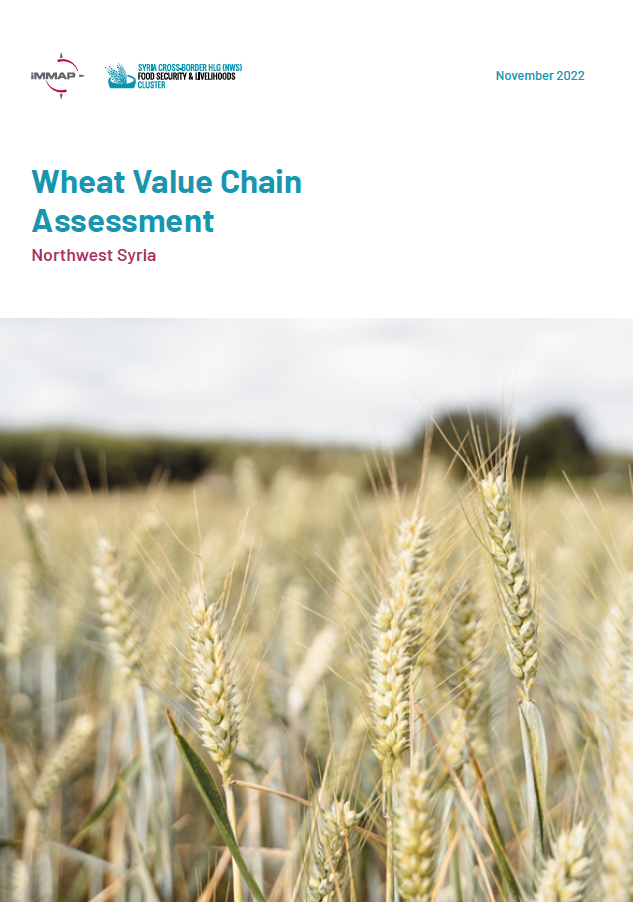
Wheat Value Chain Assessment in Northwest Syria – November 2022
Wheat is the most critical food crop in Syria, as it is essential to the production of bread that is the primary staple food in the country. Since 2011, multiple humanitarian actors have been providing wheat production support and flour assistance procured in the region and inside Syria, and cash and voucher assistance. The consequent conflict events, loss of agricultural institutions, inflation, increase in fuel price, currency depreciation, shortage of manpower due to low wages, and high frequency of extreme weather events like floods, frost and drought scenarios, and the introduction of imported flour are all major factors in diminishing returns from the local production of wheat. Many farmers in Syria have abandoned wheat production and switched to cash crops in the face of various challenges limiting the farmer’s capacity for wheat crop production.
Read more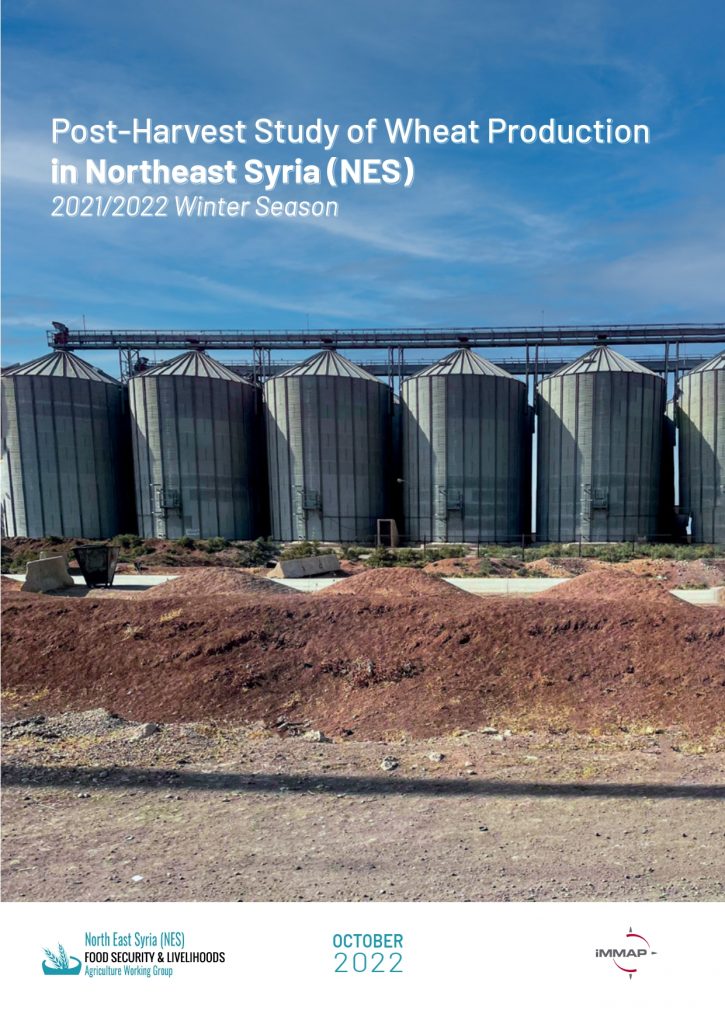
Post-Harvest Study of Wheat Production in Northeast Syria (NES)
Wheat bread has been referred to as the stuff of life and is considered a fundamental diet element for hundreds of millions around the world. In fact, the significance of wheat worldwide as the main food can be perceived by stylized wheat spike in the logo of the Food and Agriculture Organization of the United Nation. Syria is a country that heavily relies on wheat to feed its population; in fact, wheat is considered a strategic crop strongly influencing food security.
Read more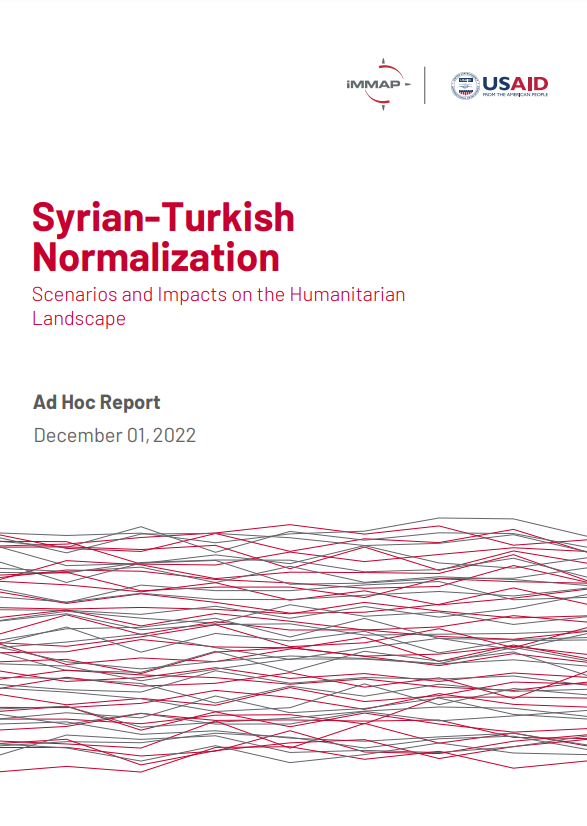
Ad-Hoc Report, Syrian-Turkish Normalization
This report was generated by iMMAP using a combination of data service providers, key informant interviews, and open-source research to assist donors and partners in analyzing evolving security, governance, political, economic, and other dynamics that impact conditions in Northeast Syria, as well as Whole of Syria, and the operating environment for humanitarian actors. The contents of this report solely represent the analysis of iMMAP and do not represent the views or positions of iMMAP’s donors and partners. Moreover, the names and designations used in this report do not imply acceptance by iMMAP’s donors and partners.
Read more
Context Update - Northwestern Syria November 2022
This report was generated by iMMAP using a combination of data service providers, key informant interviews, and open-source research to assist donors and partners in analyzing evolving security, governance, political, economic, and other dynamics that impact conditions in Northeast Syria, as well as Whole of Syria, and the operating environment for humanitarian actors. The contents of this report solely represent the analysis of iMMAP and do not represent the views or positions of iMMAP’s donors and partners. Moreover, the names and designations used in this report do not imply acceptance by iMMAP’s donors and partners.
Read more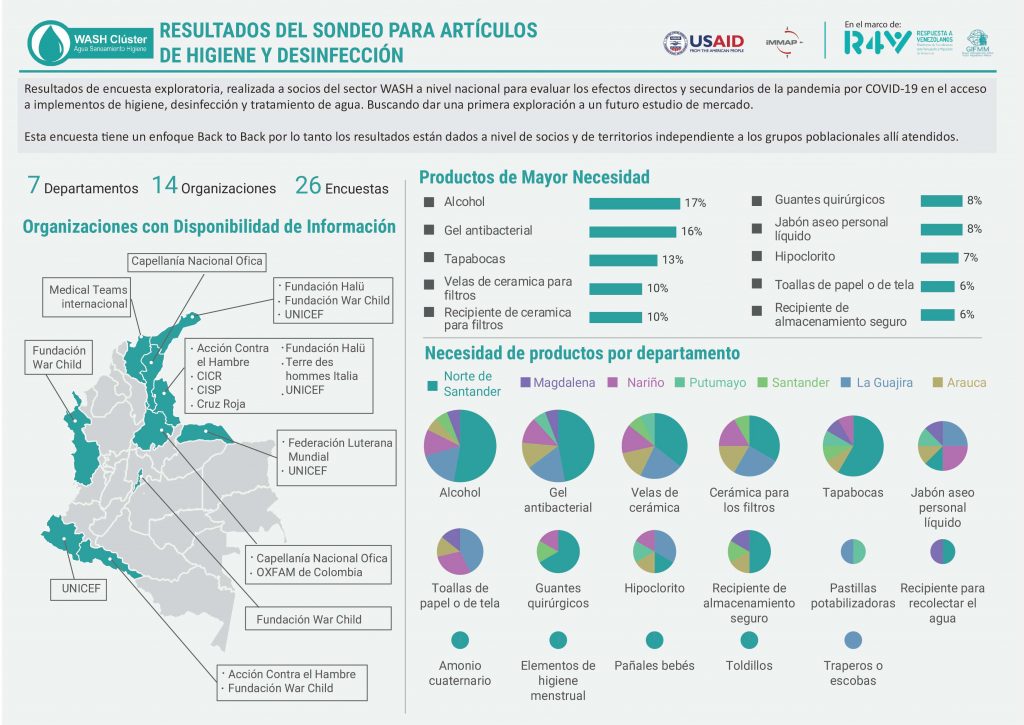
Colombia: Survey results for hygiene and disinfection items
Results of an exploratory survey, conducted with WASH partners nationwide to assess the direct and secondary effects of the COVID-19 pandemic on access to hygiene, disinfection and water treatment supplies. Seeking to provide a first exploration for a future market study.
Read more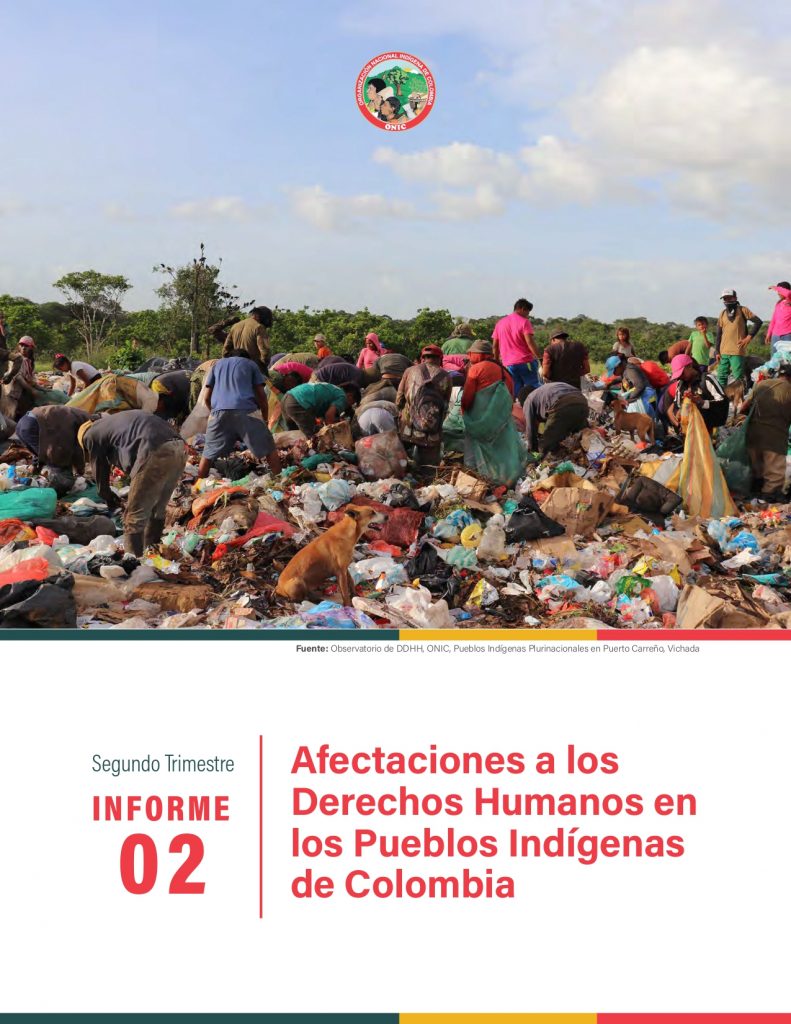
Human rights violations among indigenous peoples in Colombia - Q2 2022
The Human Rights Observatory recorded, during the second quarter of 2022, a total of 203 victimizing events, with 422,866 indigenous people affected by actions that violate Human Rights and IHL, belonging to 29 Indigenous Peoples.
Read more
Context Update - Northeast Syria October 2022
This report was generated by iMMAP using a combination of data service providers, key informant interviews, and open-source research to assist donors and partners in analyzing evolving security, governance, political, economic, and other dynamics that impact conditions in Northeast Syria, as well as Whole of Syria, and the operating environment for humanitarian actors. The contents of this report solely represent the analysis of iMMAP and do not represent the views or positions of iMMAP’s donors and partners. Moreover, the names and designations used in this report do not imply acceptance by iMMAP’s donors and partners.
Read more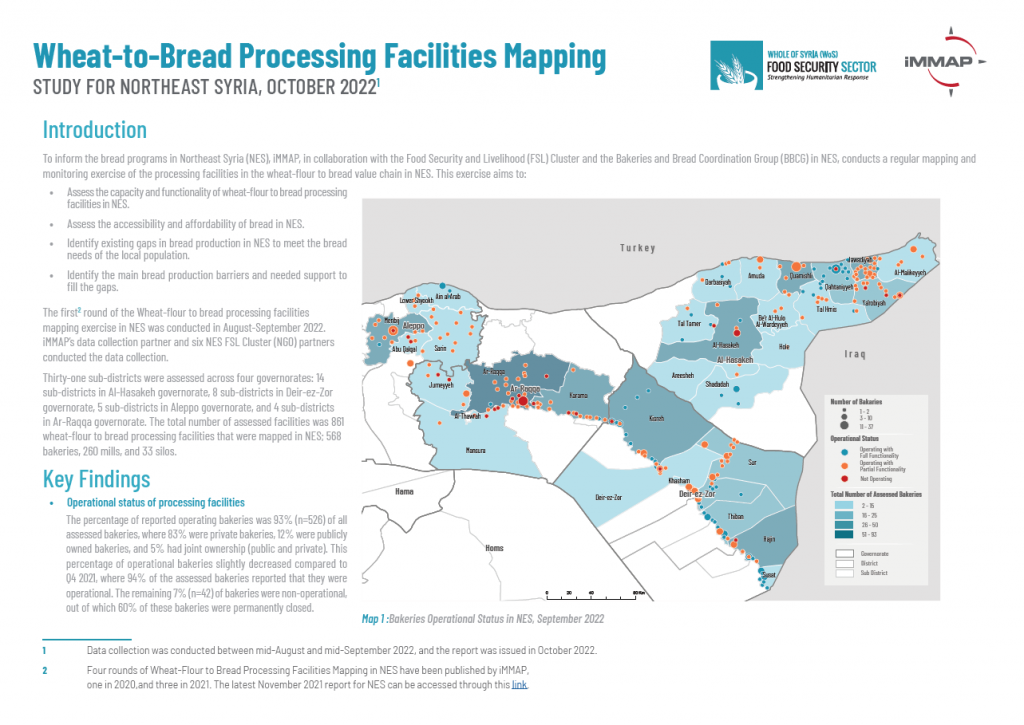
Wheat-to-Bread Processing Facilities Mapping – (Q3) October 2022, Northeast Syria
To inform the bread programs in Northeast Syria (NES), iMMAP, in collaboration with the Food Security and Livelihood (FSL) Cluster and the Bakeries and Bread Coordination Group (BBCG) in NES, conducts a regular mapping and monitoring exercise of the processing facilities in the wheat-flour to bread value chain in NES.
Read more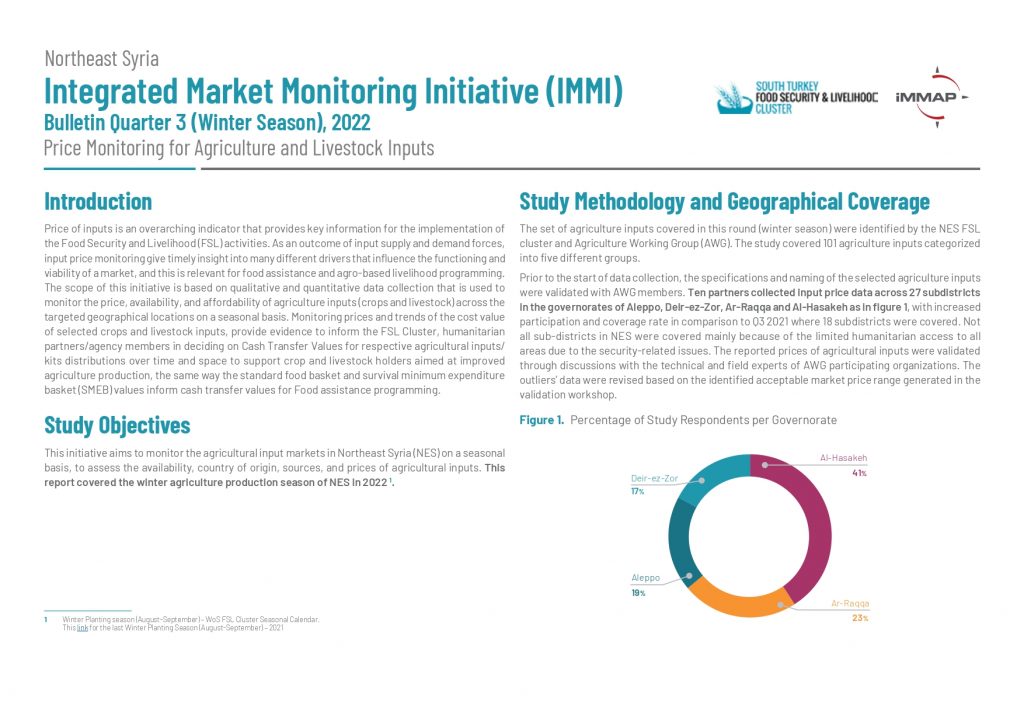
Integrated Market Monitoring Initiative – Northeast Syria - Q3 2022
This initiative aims to monitor the agricultural input markets in Northeast Syria (NES) on a seasonal basis, to assess the availability, country of origin, sources, and prices of agricultural inputs. This report covered the winter agriculture production season of NES in 2022
Read more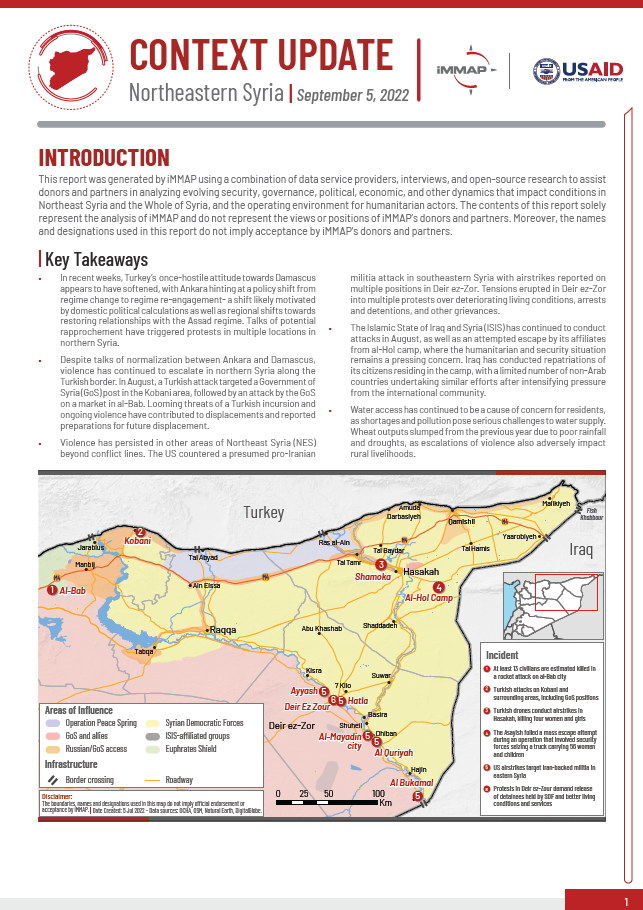
Context Update - Northeast Syria August 2022
This report was generated by iMMAP using a combination of data service providers, interviews, and open-source research to assist donors and partners in analyzing evolving security, governance, political, economic, and other dynamics that impact conditions in Northeast Syria and the Whole of Syria, and the operating environment for humanitarian actors. The contents of this report solely represent the analysis of iMMAP and do not represent the views or positions of iMMAP’s donors and partners. Moreover, the names and designations used in this report do not imply acceptance by iMMAP’s donors and partners.
Read more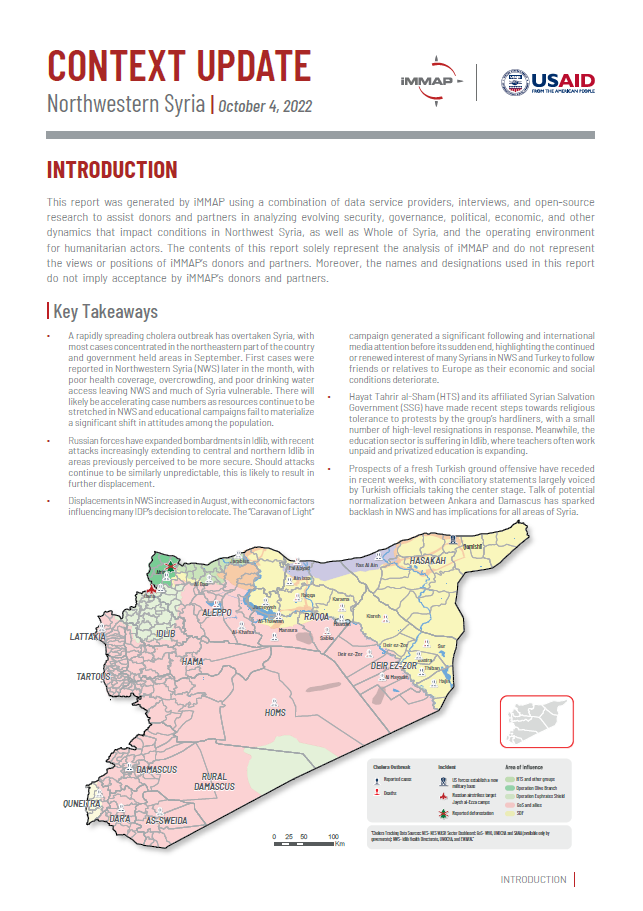
Context Update - Northwest Syria Sept 2022
This report was generated by iMMAP using a combination of data service providers, interviews, and open source research to assist donors and partners in analyzing evolving security, governance, political, economic, and other dynamics that impact conditions in Northwest Syria, as well as Whole of Syria, and the operating environment for humanitarian actors. The contents of this report solely represent the analysis of iMMAP and do not represent the views or positions of iMMAP’s donors and partners. Moreover, the names and designations used in this report do not imply acceptance by iMMAP’s donors and partners.
Read more
Integrated Market Monitoring Initiative (IMMI) Bulletin Quarter 3 (Winter Season), 2022
This initiative aims to monitor the agricultural input markets in Northwest Syria (NWS) on a seasonal basis, to assess the availability, country of origin, and prices of agricultural inputs. This report covers the winter agriculture production season of NWS in 2022.
Read more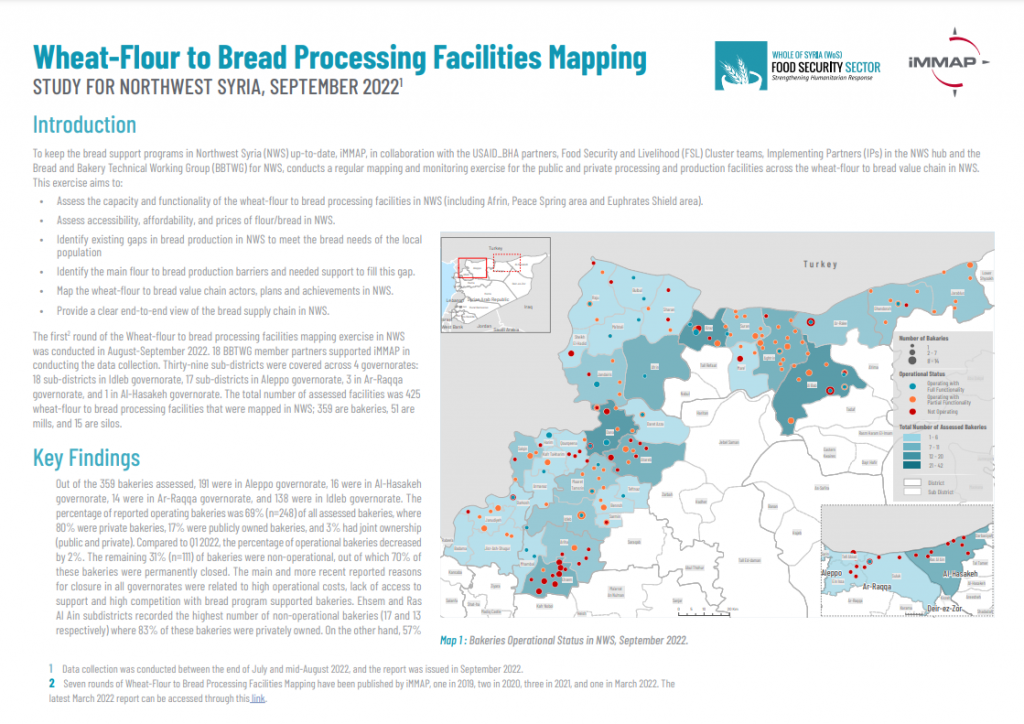
Northwest Syria Wheat to Bread Processing Facilities Mapping - Round 2 Q3 2022
To keep the bread support programs in Northwest Syria (NWS) up to date, iMMAP, in collaboration with the USAID-BHA partners, Food Security and Livelihood (FSL) Cluster teams, Implementing Partners (IPs) in the NWS hub and the Bread and Bakery Technical Working Group (BBTWG) for NWS, conducts a regular mapping and monitoring exercise for the public and private processing and production facilities across the wheat-flour to bread value chain in NWS.
Read more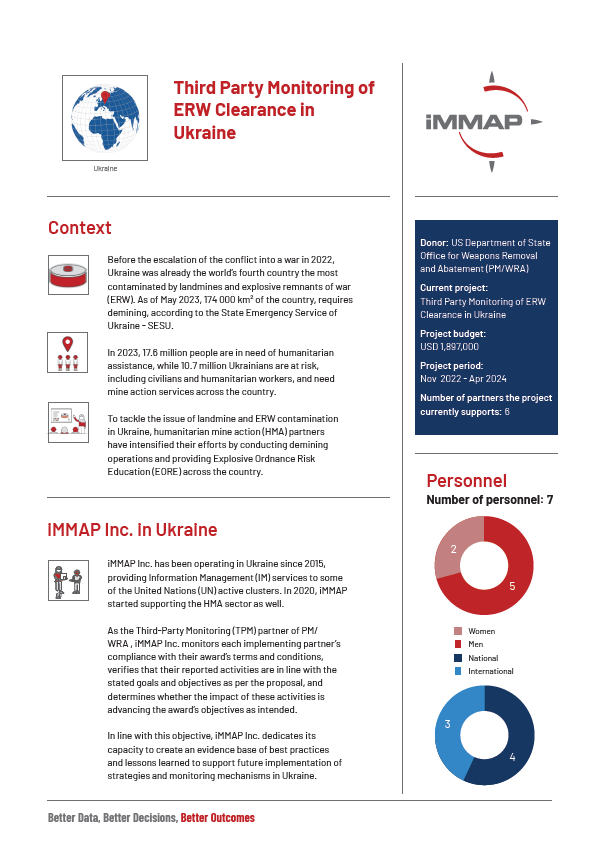
Third Party Monitoring of Explosive Remnants of War (ERW) Clearance in Ukraine
This project focuses on third-party monitoring (TPM) of explosive remnants of war (ERW) clearance activities in Ukraine as part of humanitarian mine action efforts. The objective of the project is to improve the accountability, transparency and quality control of the demining process while addressing implementation challenges. The project presents case studies and recommendations for improving the effectiveness of the TPM program. Due to the ongoing conflict and resulting humanitarian crisis in Ukraine, iMMAP has deployed personnel to support UN agencies and partner organizations in their humanitarian efforts, including through enhancing information management processes and providing data-driven response activities.
Read more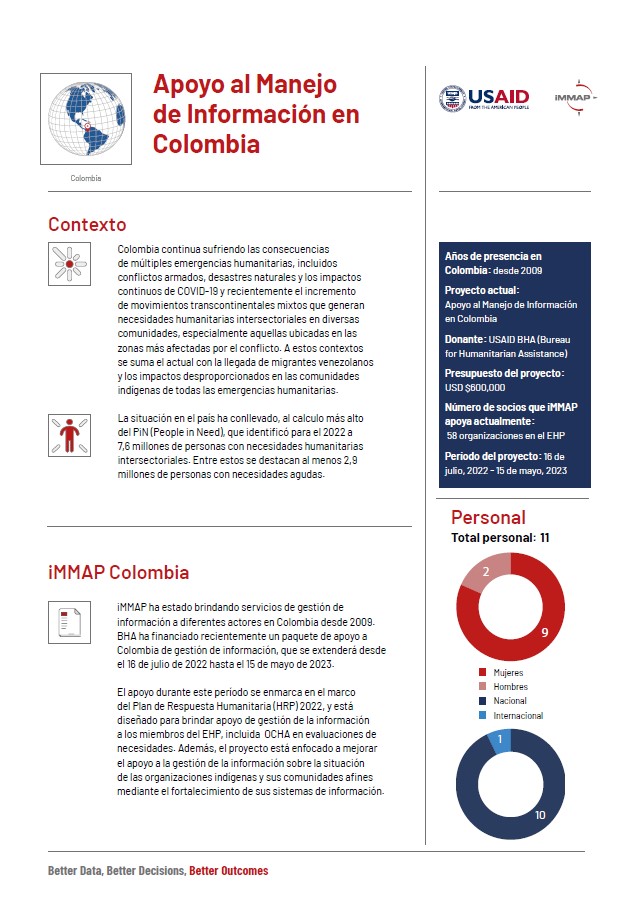
Apoyo al Manejo de Información en Colombia
Colombia está sufriendo las consecuencias de múltiples emergencias humanitarias, incluidos conflictos armados, desastres naturales y los impactos continuos de COVID-19.
Read more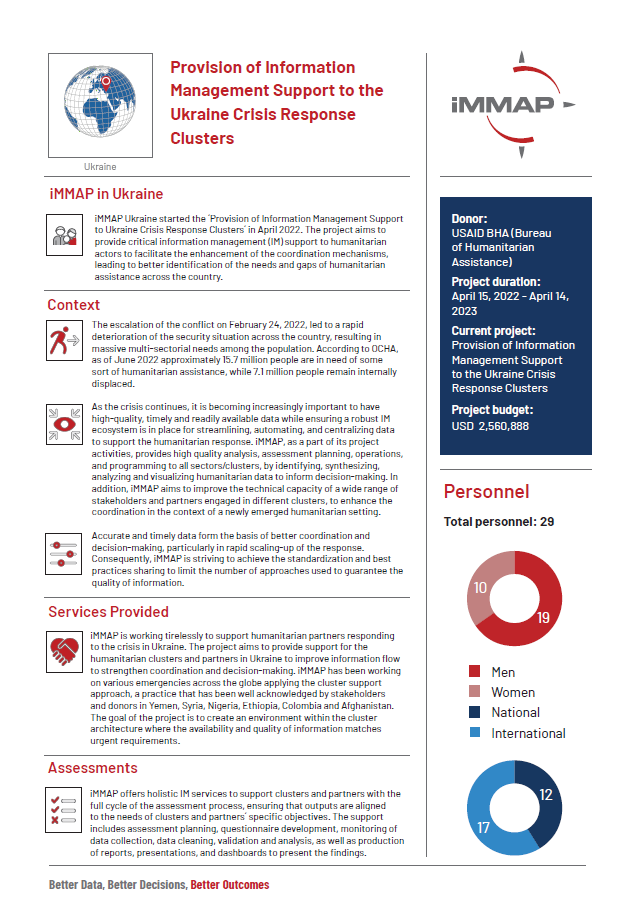
Provision of Information Management Support to the Ukraine Crisis Response Clusters
iMMAP Ukraine started the ´Provision of Information Management Support to Ukraine Crisis Response Clusters´ in April 2022. The project aims to provide critical information management (IM) support to humanitarian actors to facilitate the enhancement of the coordination mechanism leading to better identification of the needs and gaps of humanitarian assistance across the country.
Read more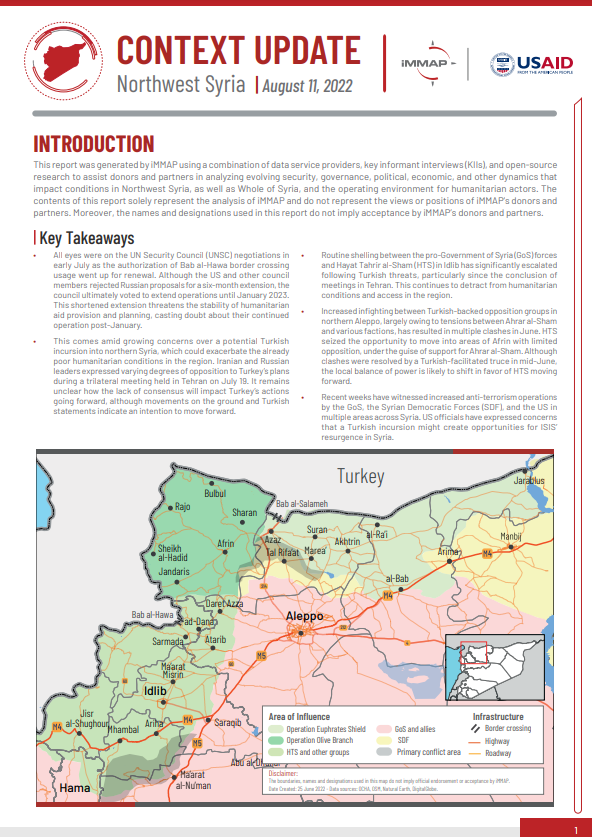
Context Update - Northwest Syria July 2022
Context Update Report from iMMAP’s Research and Analysis Unit on Northwest Syria (NWS) for July 2022. This update covers the outcome of the UNSC renewal vote for cross-border operations via Bab al-Hawa, continued threats on northern Syria by Turkey and its allies, infighting, and dynamics between Turkish-backed opposition groups and Hayat Tahrir al-Sham (HTS), and escalation of violence in Idlib, among other topics.
Read more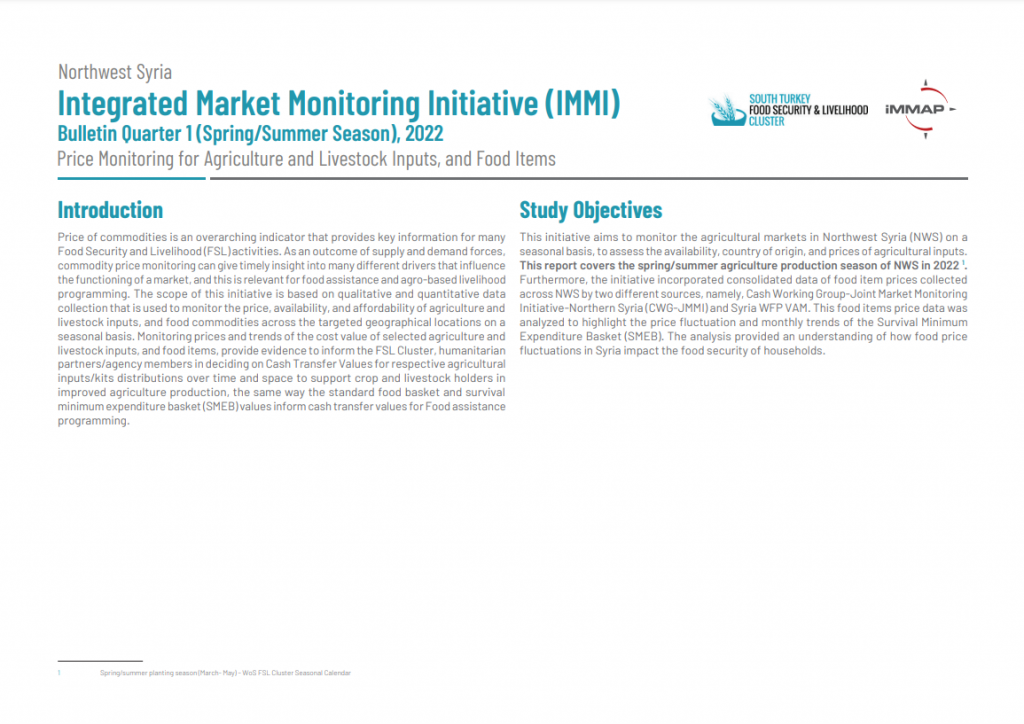
Integrated Market Monitoring Initiative (IMMI) Bulletin Quarter 1 (Spring/Summer Season), 2022
The initiative aims to monitor the agricultural input markets in Northwest Syria (NWS) on a seasonal basis, to assess the availability, country of origin, and prices of agricultural inputs. This report covered the Spring/Summer agriculture production season of NWS in Q1 2022.
Read more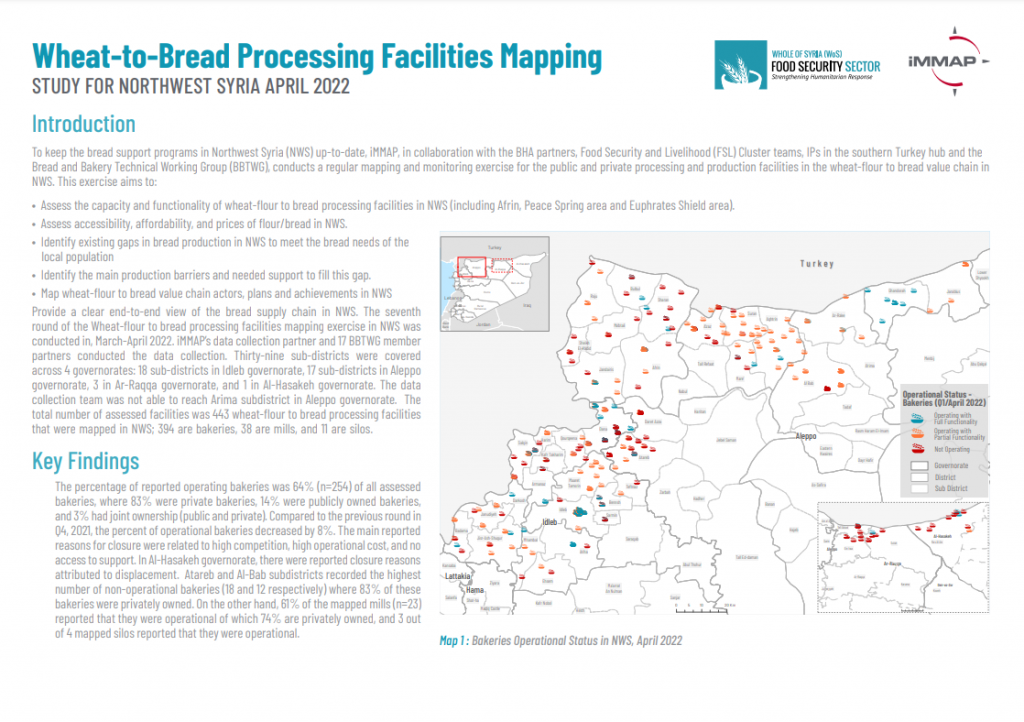
Wheat-to-Bread Processing Facilities Mapping Study for Northwest Syria April 2022
The latest wheat-flour to bread processing facilities mapping study examined the status of 444 bread processing facilities across northwest Syria. The study took an in-depth assessment of their functionality, productivity, and the major concerns and challenges they face. It also gives insight into the current costs and access to bread in the region as experienced by bread program participants.
Read more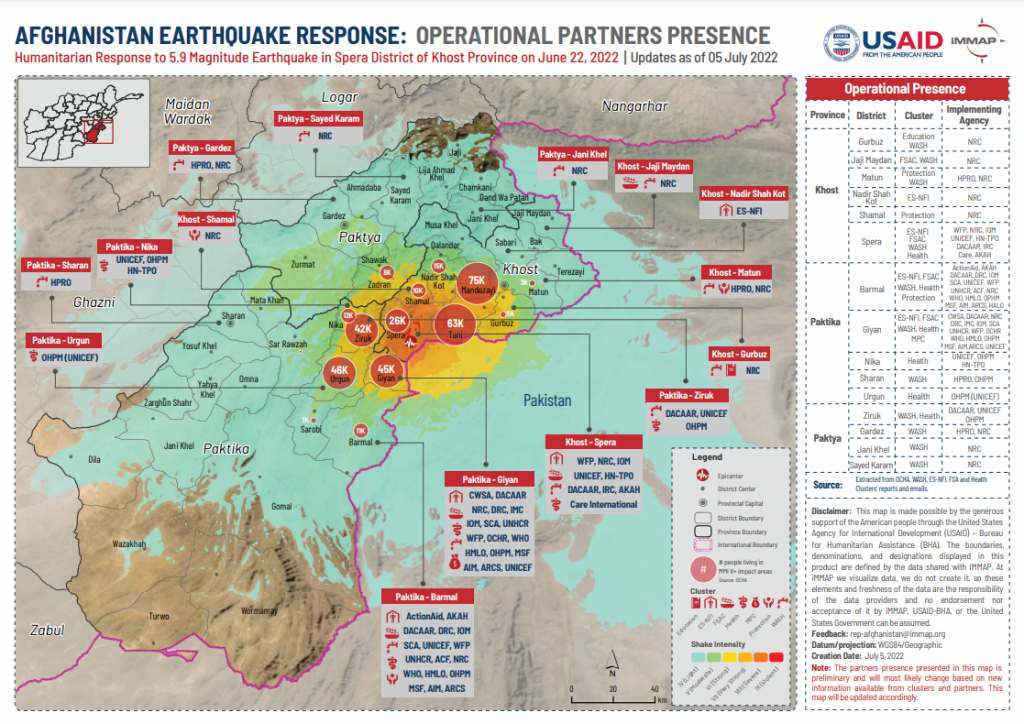
Afghanistan Earthquake: 5.9 Magnitude Earthquake in Spera District of Khost Province on June 22, 2022, Updates as of 05 July 2022
AFGHANISTAN EARTHQUAKE RESPONSE: OPERATIONAL PARTNERS PRESENCE Humanitarian Response to 5.9 Magnitude Earthquake in Spera District of Khost Province on June 22, 2022, Updates as of 05 July 2022
Read more
Afghanistan Earthquake: 5.9 Magnitude Earthquake in Spera District of Khost Province on June 22, 2022, Update 02: as of 13 July 2022
AFGHANISTAN EARTHQUAKE RESPONSE: OPERATIONAL PARTNERS PRESENCE Humanitarian Response to 5.9 Magnitude Earthquake in Spera District of Khost Province on June 22, 2022, Update 02: as of 13 July 2022
Read more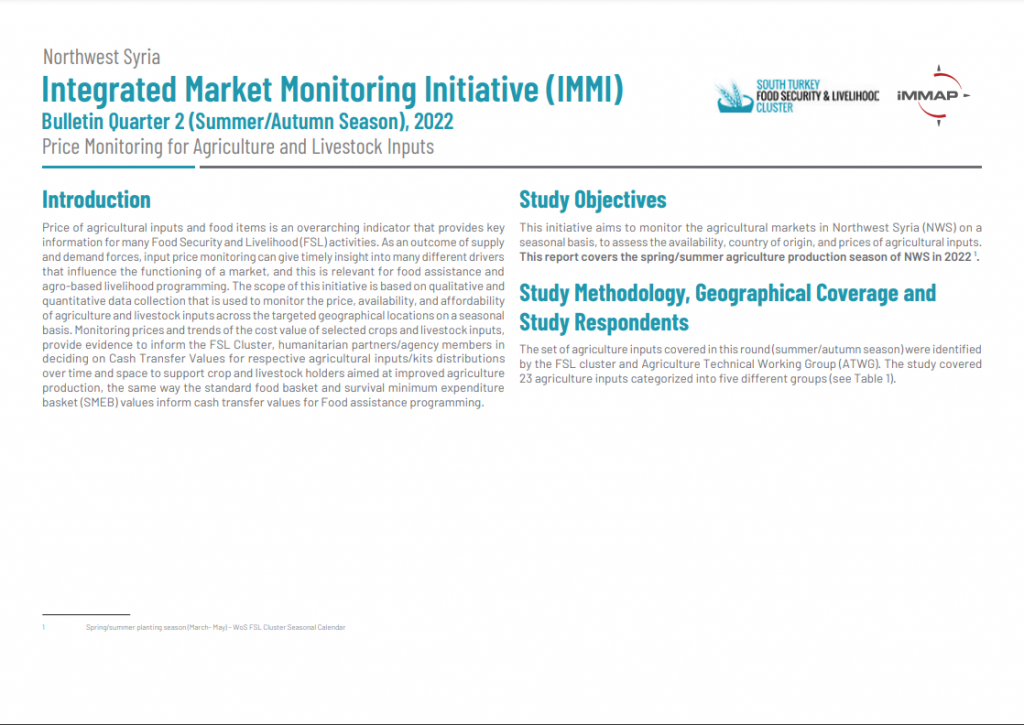
Northwest Syria : Integrated Market Monitoring Initiative (IMMI) Quarter 2 2022 Summer/Autumn Season
The initiative aims to monitor the agricultural input markets in Northwest Syria (NWS) on a seasonal basis, to assess the availability, country of origin, and prices of agricultural inputs. This report covered the Summer/Autumn agriculture production season of NWS in 2022.
Read more
Afghanistan Earthquake: 5.9 Magnitude Spera District of Khost Province June 22, 2022
This earthquake epicentre took place in the Spera district of Khost province, on June 22, 2022, at 1:24 am Kabul time. The preliminary report from different sources shows that hundreds of people were dead and injured, and many houses were destroyed in the eastern provinces, especially in Khost, Paktika, and Nangarhar, this earthquake was also felt in the capital of the country. According to the USGS the earthquake was 5.9 magnitude at a depth of 10km.
Read more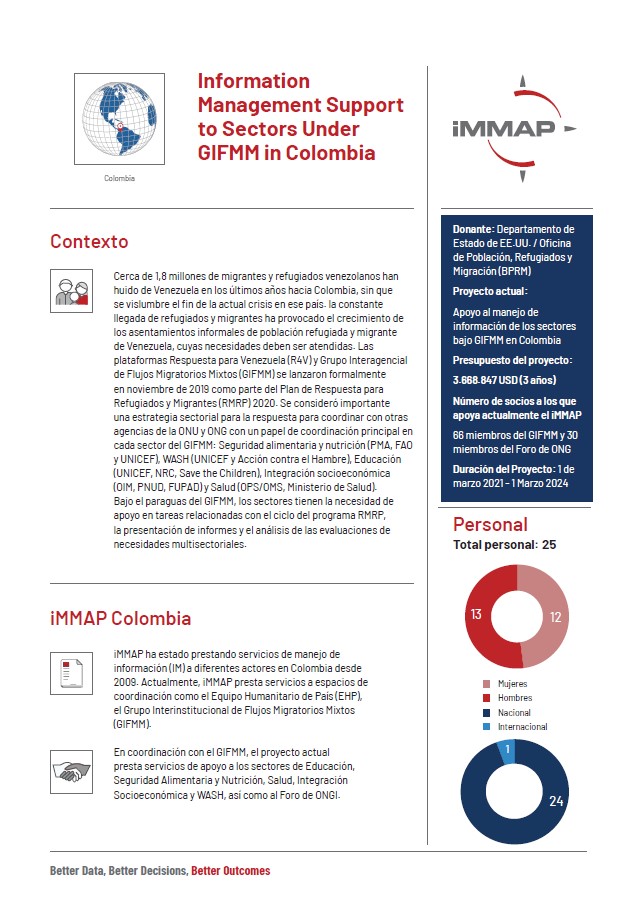
Information Management Support to Sectors Under GIFMM in Colombia [In Spanish]
Casi 1,8 millones de migrantes y refugiados venezolanos han huido de Venezuela en los últimos años hacia Colombia, sin que se vislumbre el fin de la crisis actual.
Read more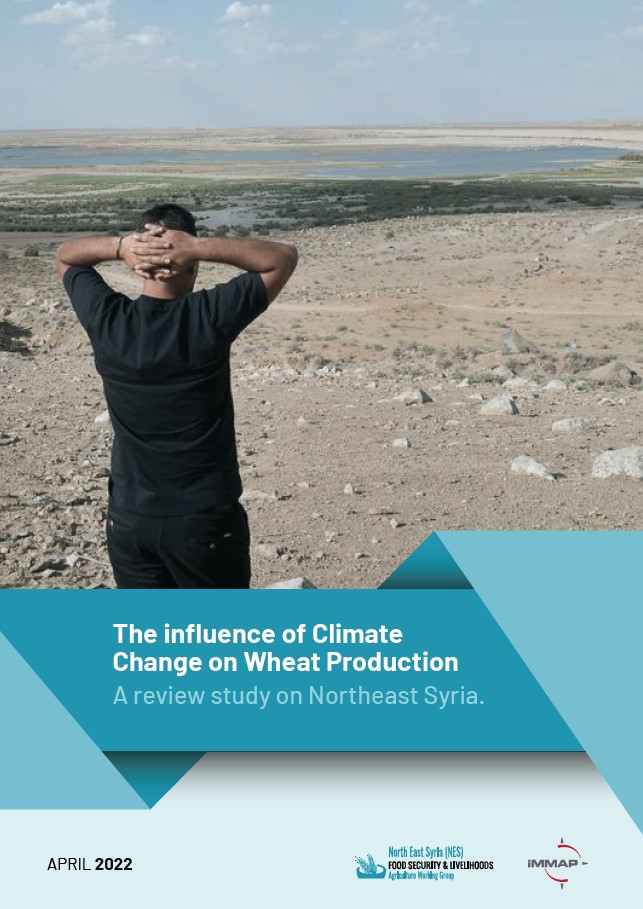
Climate Change and Its Influence on Wheat Production: A Review Study on Northeast Syria
The report explores the impact of climate change on wheat production across northeast Syria (NES). The study heavily relies on secondary data collection and analysis, including literature review based on original research articles and reports produced by humanitarian partners in Syria and the international community.
Read more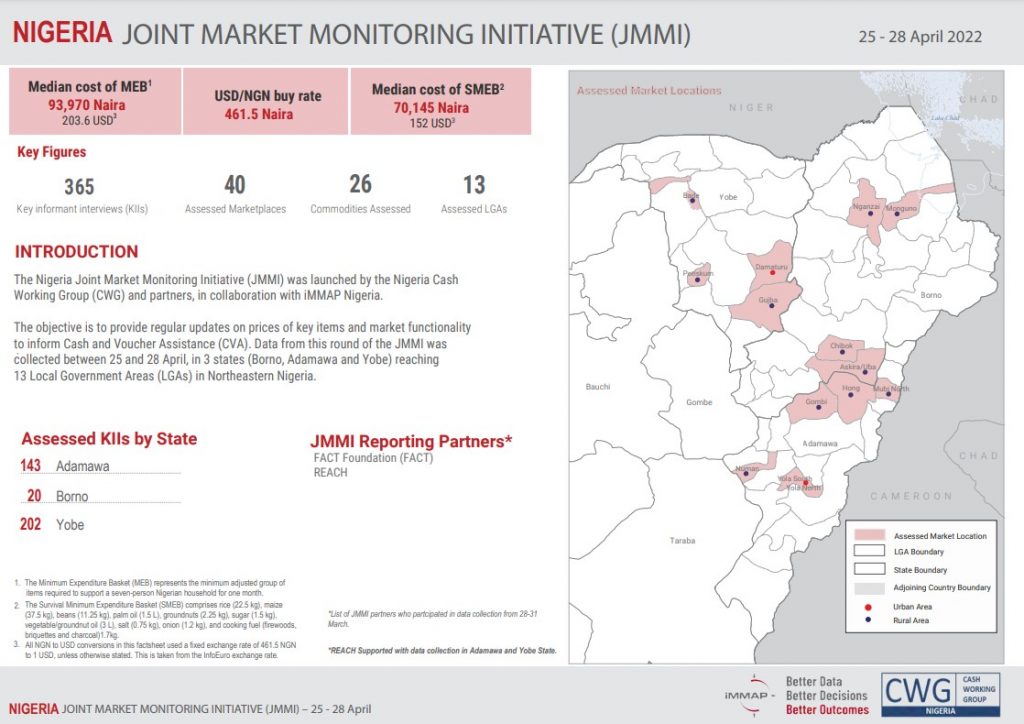
Factsheets Joint Market Monitoring Initiative (JMMI) in Nigeria
The Nigeria Joint Market Monitoring Initiative (JMMI) was launched by the Nigeria Cash Working Group (CWG) and partners, in collaboration with iMMAP Nigeria. The objective is to provide regular updates on prices of key items and market functionality to inform Cash and Voucher Assistance (CVA).
Read more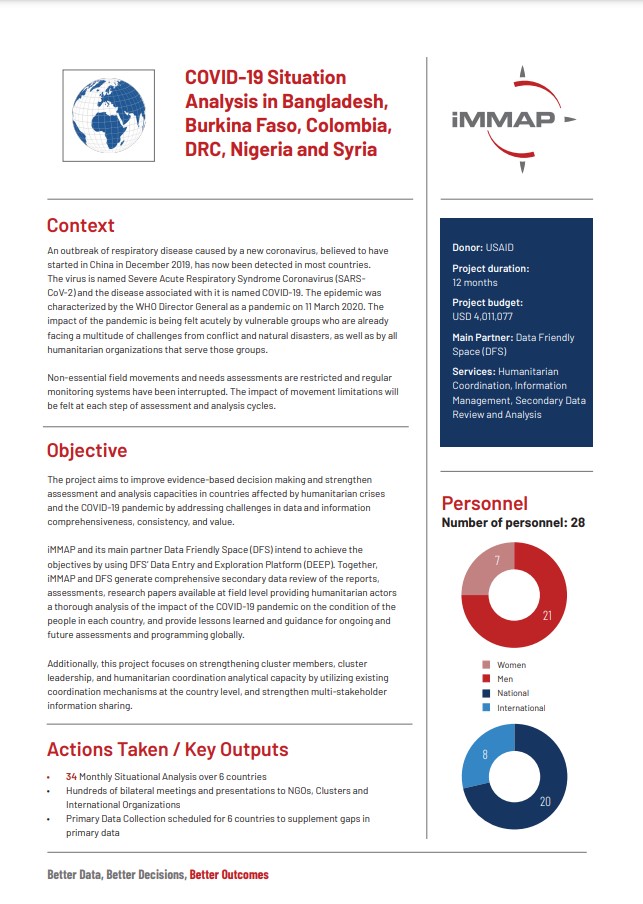
COVID-19 Situation Analysis in Bangladesh, Burkina Faso, Colombia, DRC, Nigeria and Syria
The project aims to improve evidence-based decision making and strengthen assessment and analysis capacities in countries affected by humanitarian crises and the COVID-19 pandemic by addressing challenges in data and information comprehensiveness, consistency, and value.
Read more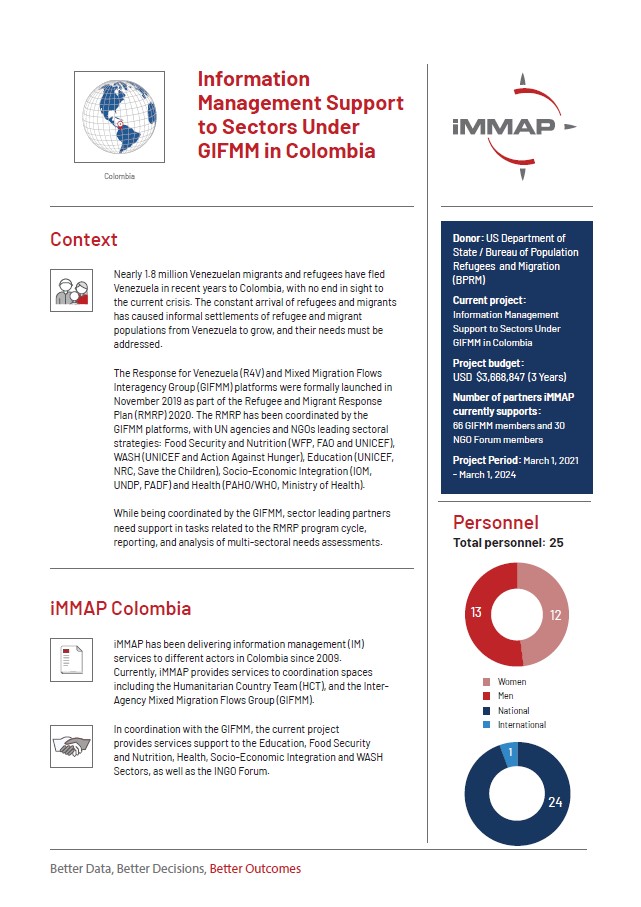
Information Management Support to Sectors Under GIFMM in Colombia
The platforms Response for Venezuelas (R4V) and Inter-Agency Mixed Migration Flows Group (GIFMM) were formally launched in November 2019 as part of the Refugee and Migrant Response Plan (RMRP) 2020. A sectoral strategy for the response was considered important in the current context, in order to coordinate with other UN agencies and NGOs with a lead coordination role in each sector
Read more
Information Management Support to Colombia
iMMAP has been providing information management (IM) services to different actors in Colombia since 2009, with the most recent financing by USAID BHA of an Information Management Support package to Colombia between 16 December 2019 and 15 March 2021
Read more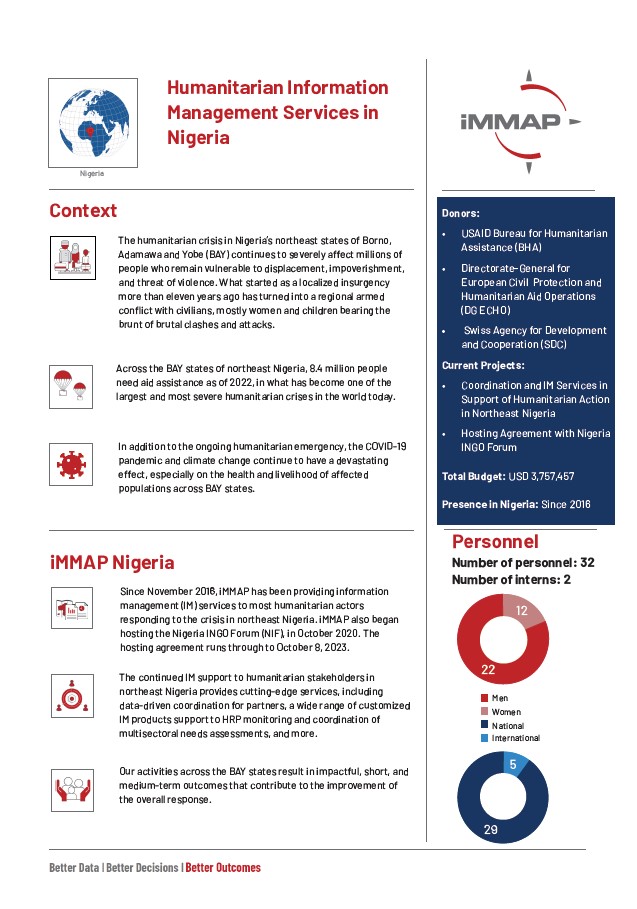
Information Management Services in Support of Humanitarian Action in Nigeria
The humanitarian crisis in Nigeria’s northeast states of Borno, Adamawa and Yobe (BAY) continues to severely affect millions of people who remain vulnerable to displacement, impoverishment, and threat of violence. What started as a localized insurgency more than eleven years ago has turned into a regional armed conflict with civilians, mostly women and children bearing the brunt of brutal clashes and attacks.
Read more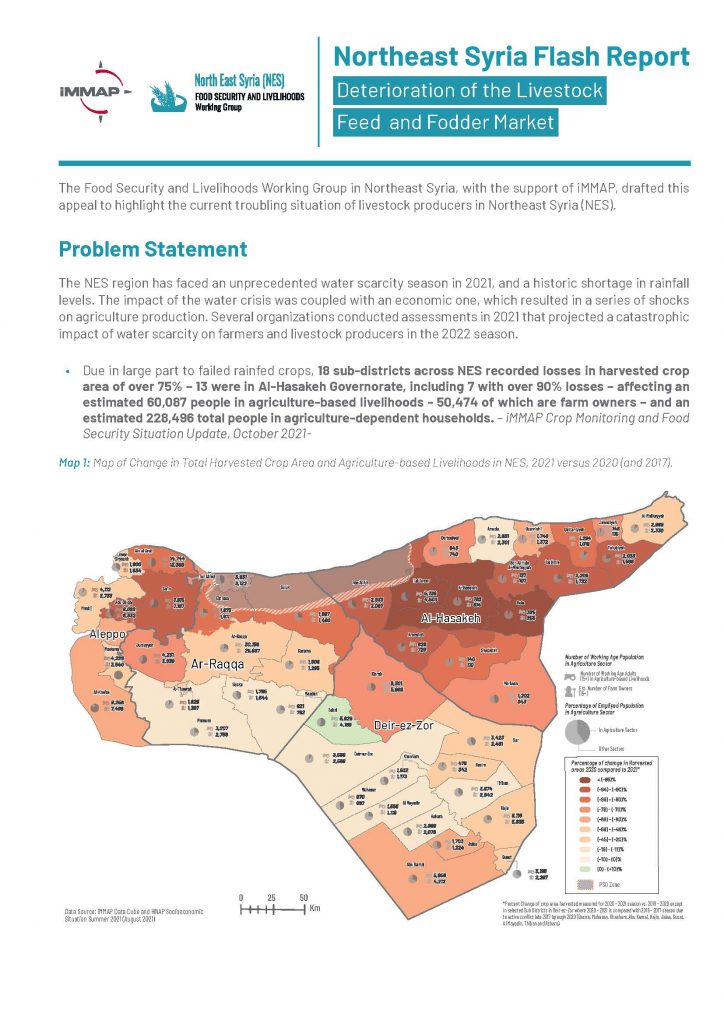
Northeast Syria Flash Report: Deterioration of the Livestock Feed and Fodder Market
In 2021, northeast Syria suffered from unprecedented water scarcity, which significantly affected its livestock market. This report further explores the aftermath and overarching impact, including the affected stakeholders and households, and provides recommendations to alleviate the hardships and revive a struggling market.
Read more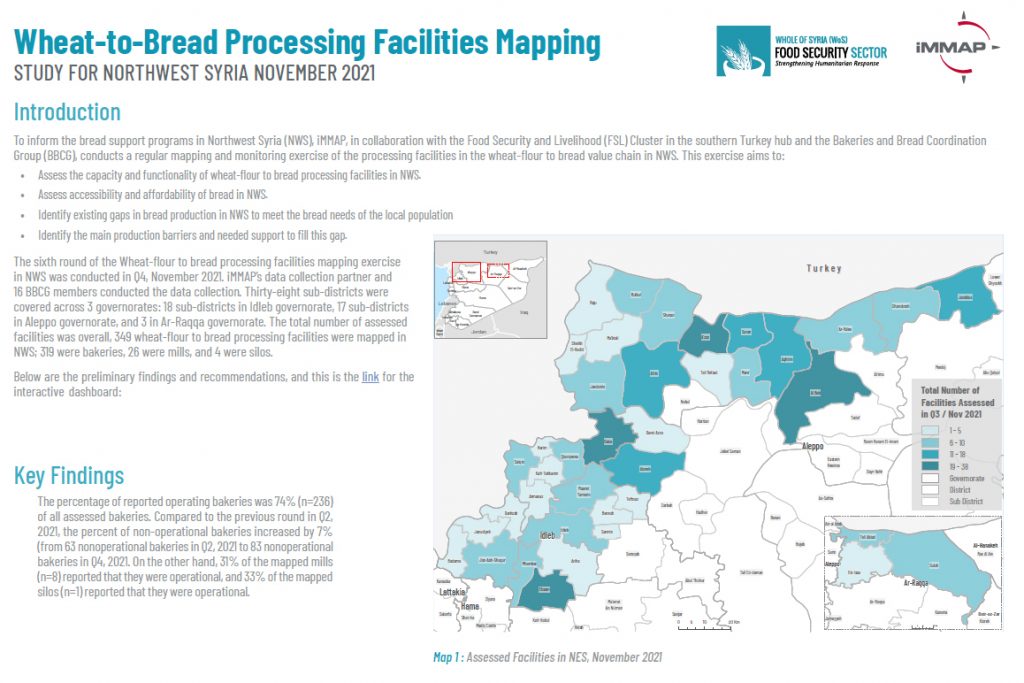
Wheat-to-Bread Processing Facilities Mapping Study for Northwest Syria
The latest wheat-flour to bread processing facilities mapping study examined the status of 349 bread processing facilities across northwest Syria. The study took an in-depth assessment of their functionality, productivity, and the major concerns and challenges they face. It also gives insight into the current costs and access to bread in the region as experienced by bread program participants.
Read more
Factsheets Mapping Wheat-Flour to Bread Processing Facilities in Northwest Syria (November 2021)
A catalog of factsheets highlighting the status and availability of various wheat-to-bread processing facilities across different districts and sub-districts in northwest Syria during the final quarter of 2021.
Read more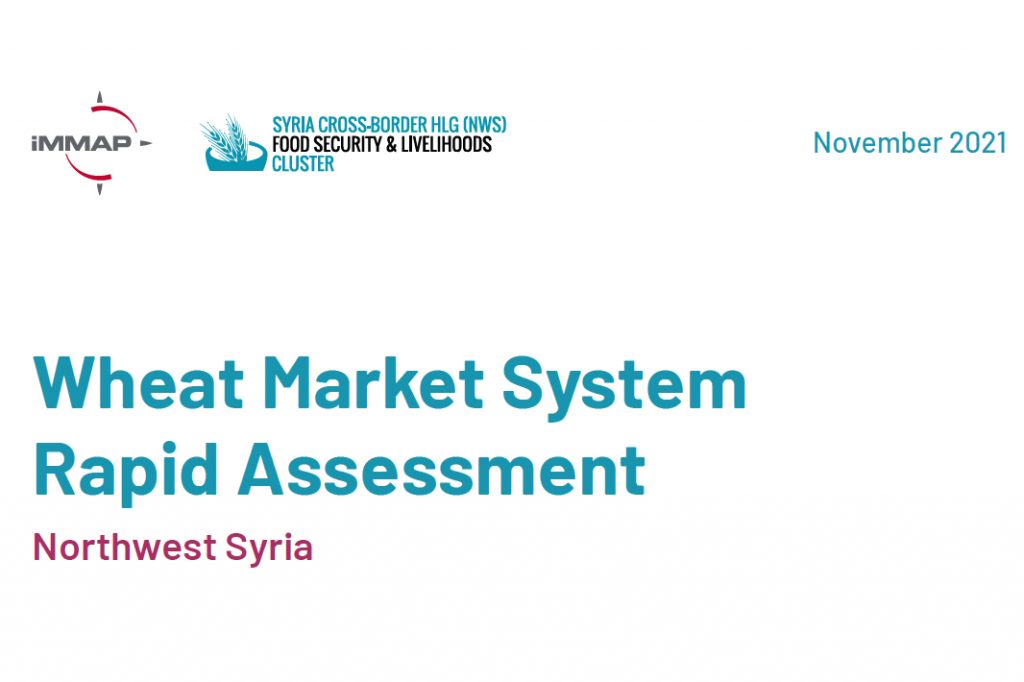
Wheat Market System Rapid Assessment for Northwest Syria
The study provides an overarching assessment of the realities and constraints facing wheat production across northwest Syria. Among the aspects examined, include the total rainfall, availability of critical inputs such as fuel and chemicals, and amount of land cultivated with wheat. Two hundred and sixty-four study respondents based in northwest Syria, comprising traders and farmers, were interviewed for the purpose of this study
Read more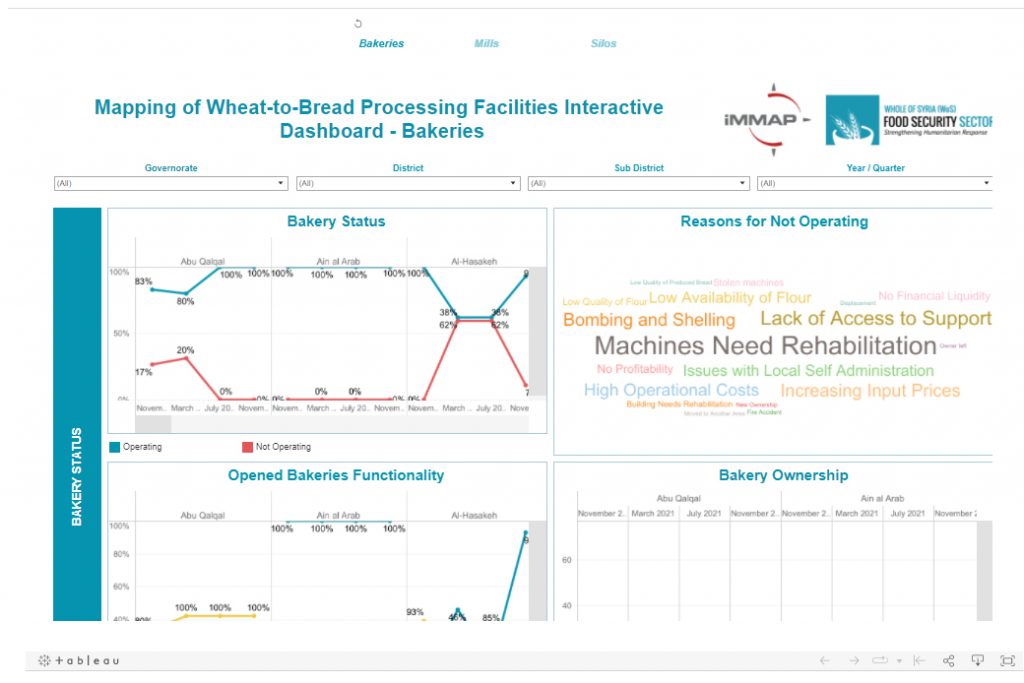
Mapping of Northeast Syria’s Wheat-to-Bread Processing Facilities Interactive Dashboard
Designed specifically for the November 2021 edition of the Wheat-to-Bread Processing Facilities Mapping Study for Northeast Syria, the dashboard gives a visual look at the findings uncovered by the study in question. Divided by bread processing facility type, the dashboard highlights various aspects investigated by the study, including functionality, status, bread production rate, and ownership of bread processing facilities.
Read more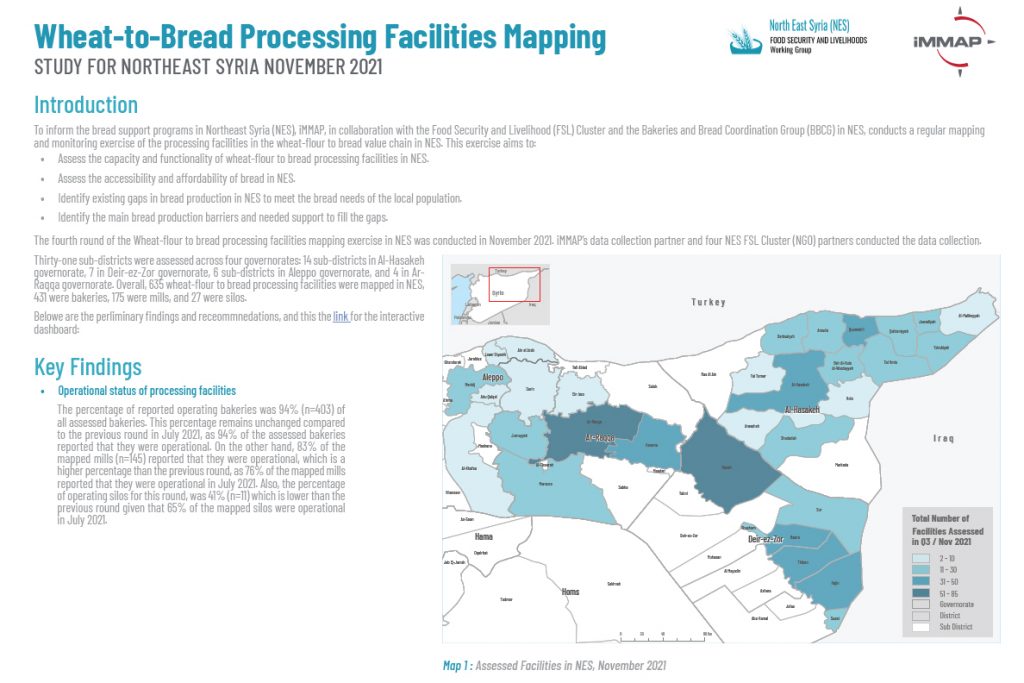
Wheat-to-Bread Processing Facilities Mapping Study for Northeast Syria
The latest wheat-flour to bread processing facilities study examined the state of 635 bread processing facilities across northeast Syria. The study took an in-depth assessment of their functionality, productivity, and the major concerns and challenges they face. It also gives insight into the current costs and access to bread in the region.
Read more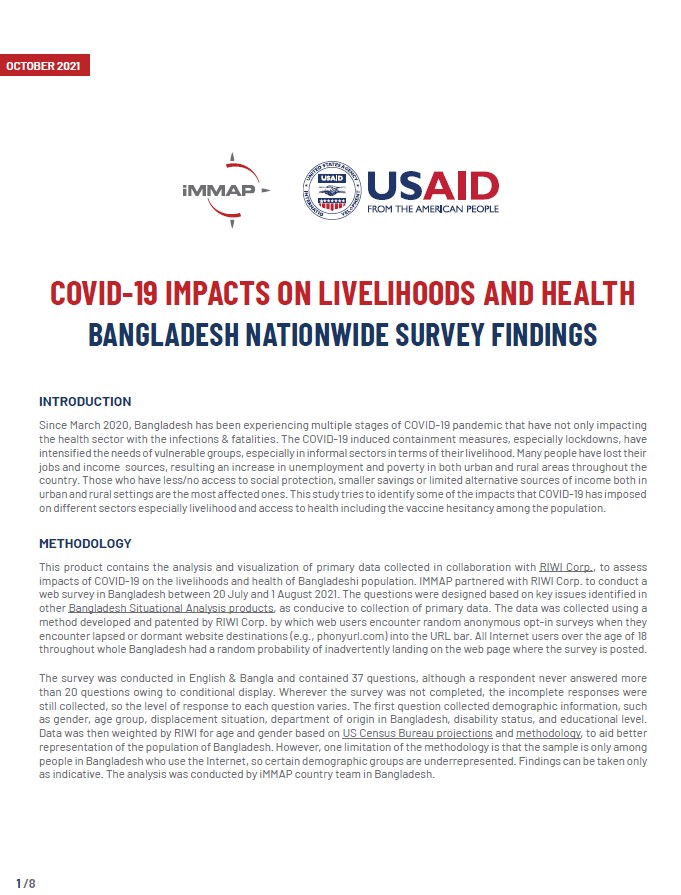
COVID-19 Impacts on Livelihoods and Health - Bangladesh Nationwide Survey Findings, October 2021
COVID-19 Impacts on Livelihoods and Health - Bangladesh Nationwide Survey Findings, October 2021
Read more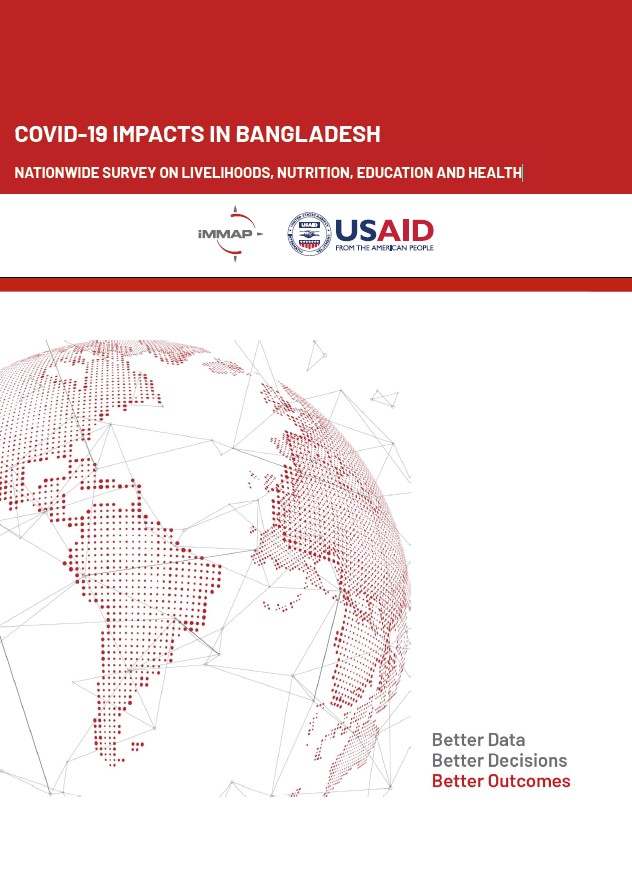
COVID-19 Impacts in Bangladesh Nationwide Survey on Livelihoods, Nutrition, Education and Health
COVID-19 Impacts in Bangladesh Nationwide Survey on Livelihoods, Nutrition, Education and Health
Read more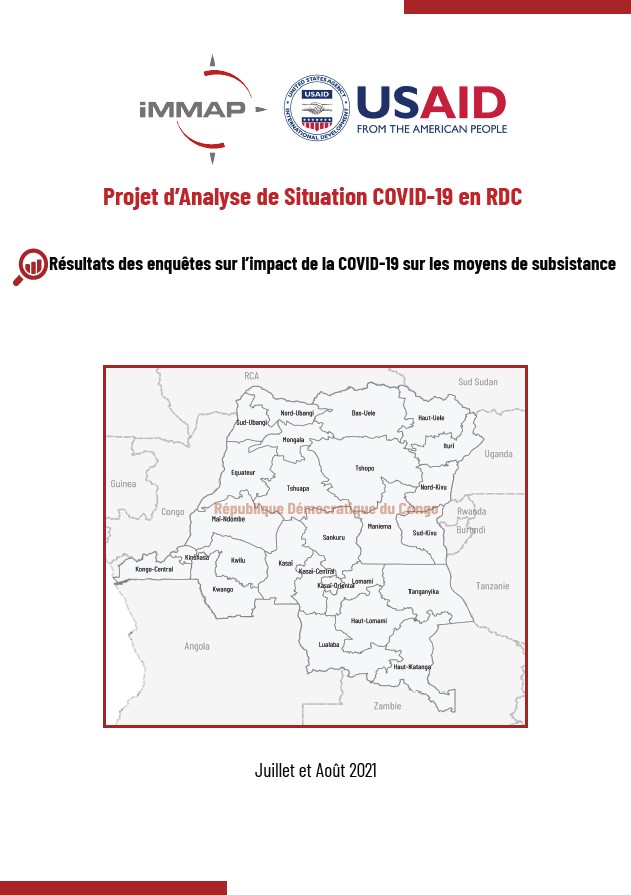
COVID-19 Situation Analysis Project in DRC : Results of surveys on the impact of COVID-19 on livelihoods (July - August 2021)
COVID-19 Situation Analysis Project in DRC : Results of surveys on the impact of COVID-19 on livelihoods (July - August 2021)
Read more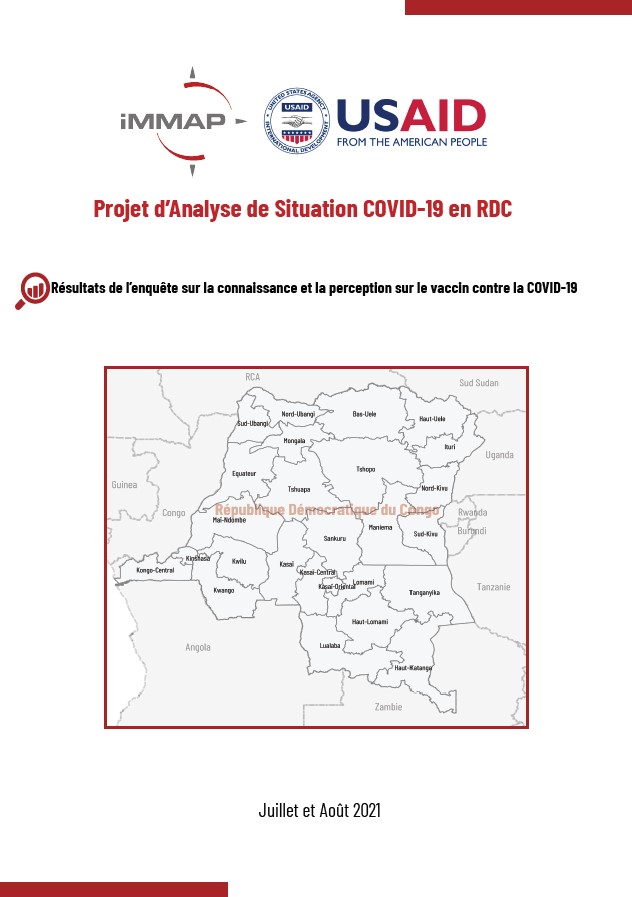
COVID-19 Situation Analysis Project in DRC : Results of the survey on knowledge and perception of the vaccine against COVID-19 (July - August 2021)
COVID-19 Situation Analysis Project in DRC : Results of the survey on knowledge and perception of the vaccine against COVID-19 (July - August 2021)
Read more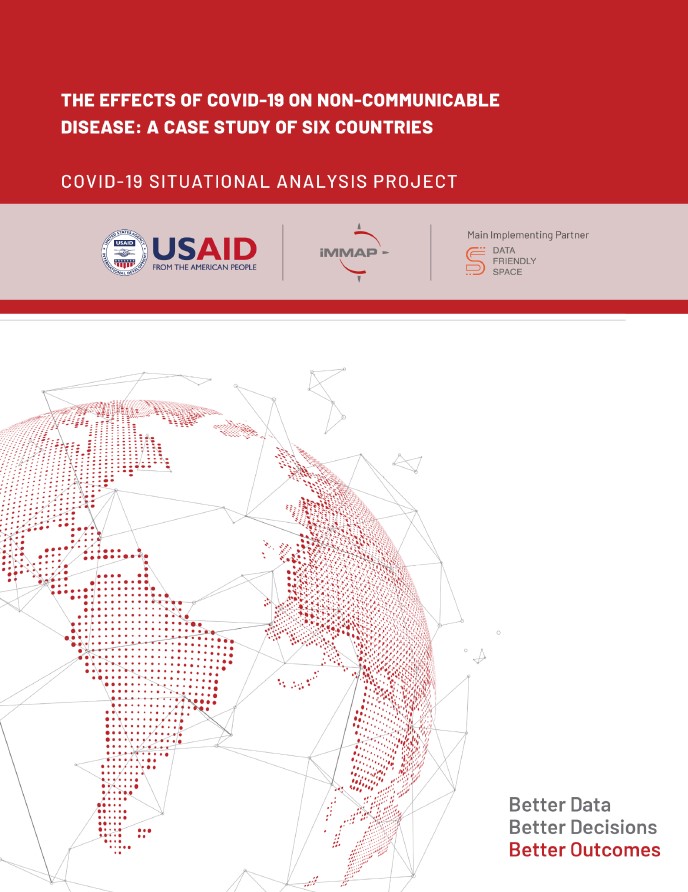
The Effects of COVID-19 on Non-Communicable Disease: A Case Study of Six Countries
The research revealed the need to collect data about the NCDs in all situations and integrate these services in all health levels and in all situations, especially during disasters and emergencies.
Read more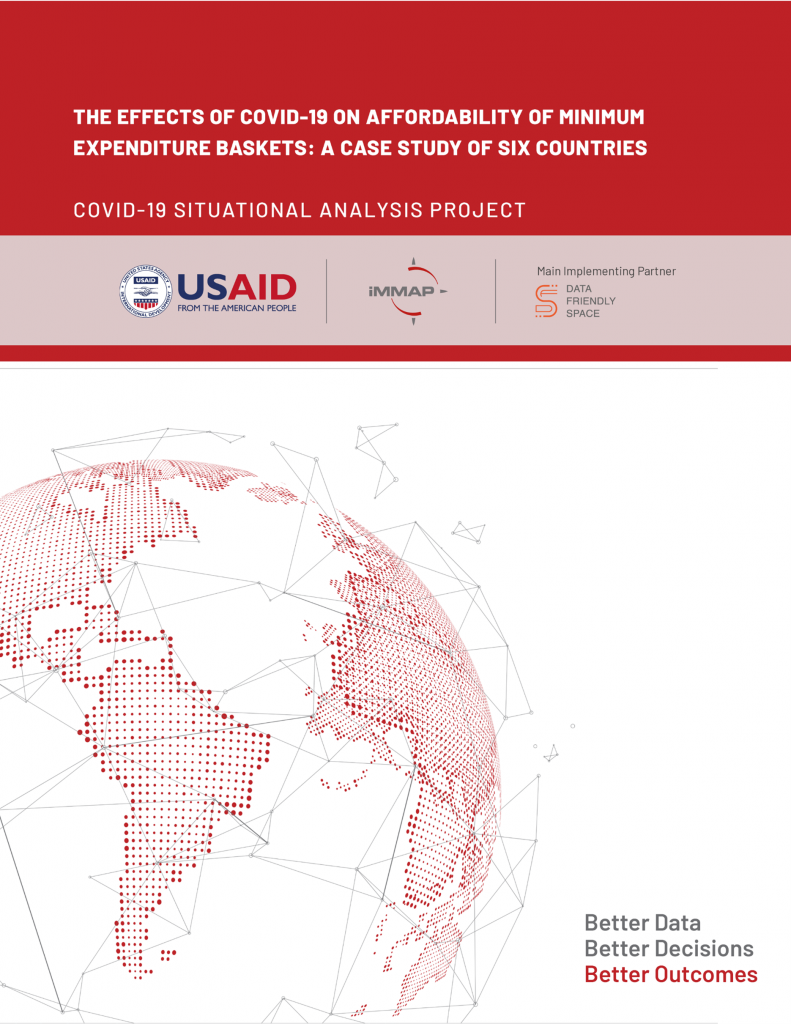
The Effects of COVID-19 on Afordability of Minimum Expenditure Basket: A Case Study of Six Countries
iMMAP/DFS The objective of the evaluation was to understand the effects of COVID-19 on the affordability of Minimum Expenditure Baskets (MEB) in the six countries: Bangladesh, Burkina Faso, Colombia, Democratic Republic of Congo (DRC), Nigeria and Syria.
Read more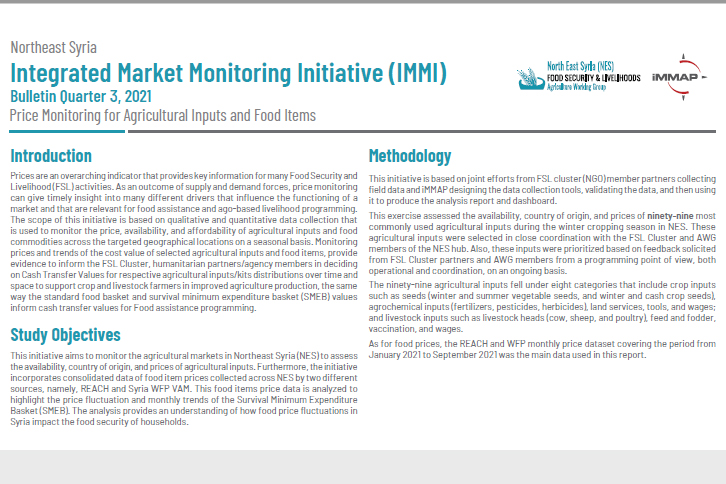
Integrated Market Monitoring Initiative (IMMI) Bulletin of Northeast Syria - Quarter 3, 2021
This study monitored and assessed the prices for agriculture inputs and food commodities in northeast Syria with the aim of providing a clearer understanding of how agricultural inputs and food price fluctuations in Syria affect a household’s overall food security and livelihood restoration.
Read more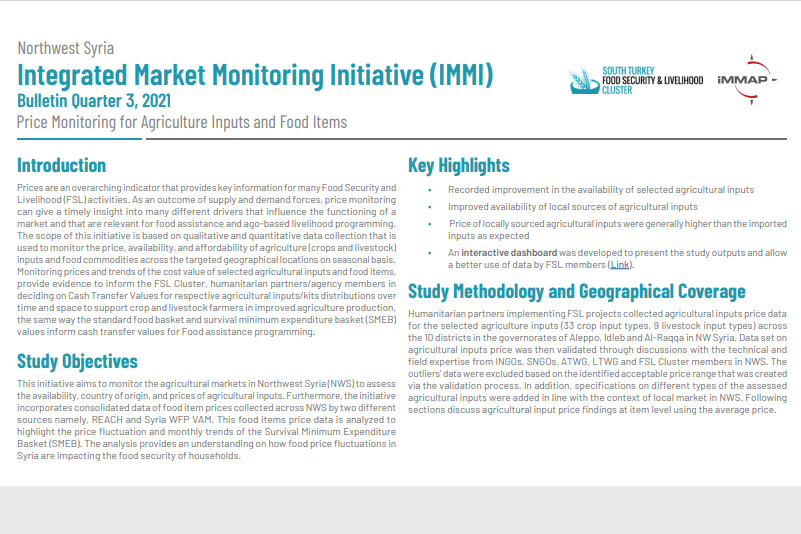
Integrated Market Monitoring Initiative (IMMI) Bulletin of Northwest Syria - Quarter 3, 2021
This study monitored and assessed the prices for agriculture inputs and food commodities in northwest Syria with the aim of providing a clearer understanding of how agricultural inputs and food price fluctuations in Syria affect a household’s overall food security and livelihood restoration.
Read more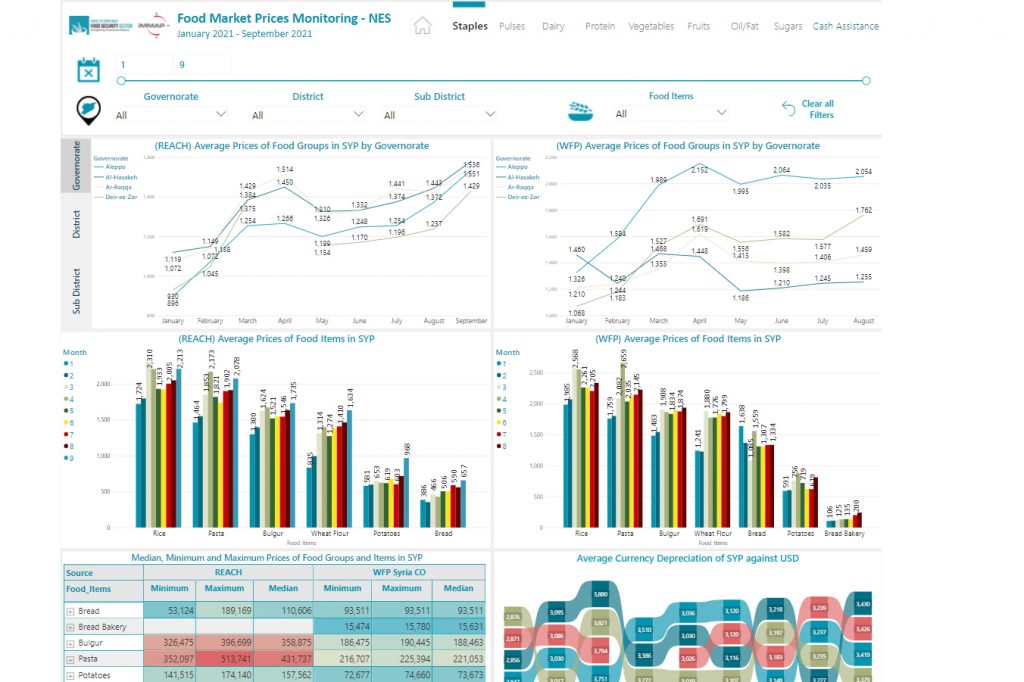
Northeast Syria Food Market Prices Monitoring Interactive Dashboard
In collaboration with the Whole of Syria Food Security and Livelihoods Sector, iMMAP developed a dashboard that tracks the prices and currency depreciation of various food commodities across northeast Syria.
Read more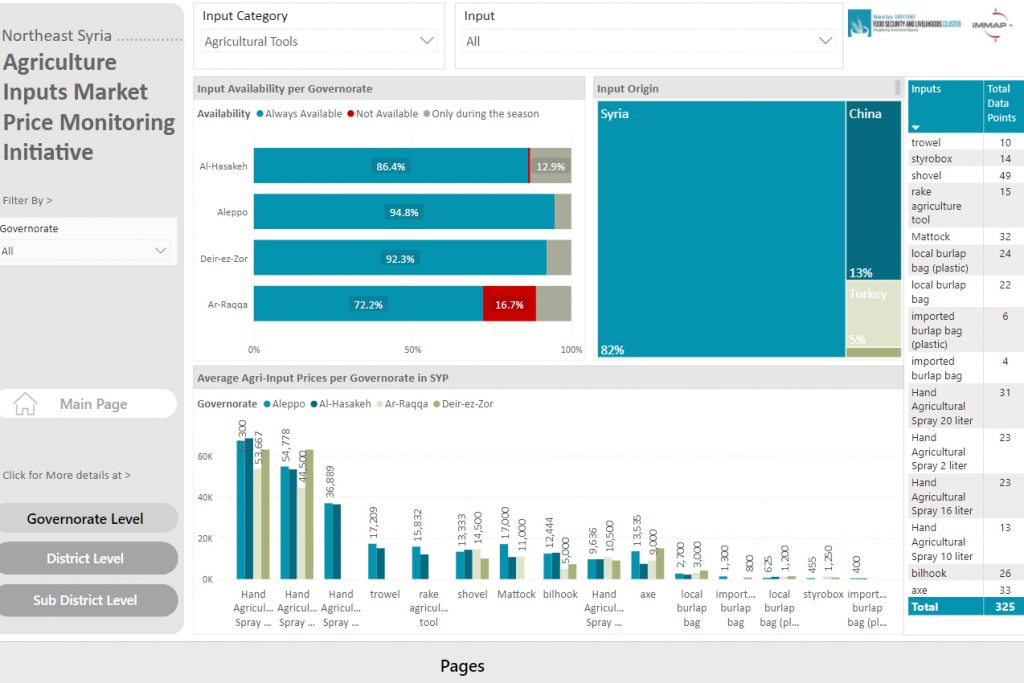
Northeast Syria Agriculture Input Price Monitoring Initiative Interactive Dashboard
In collaboration with the Whole of Syria Food Security and Livelihoods Sector, iMMAP developed a dashboard uncovering the availability, origin, and prices of various agriculture inputs across northeast Syria.
Read more
Lessons Learned: Wash Sector - COVID-19 Situational Analysis Project
iMMAP/DFS Lessons Learned: Wash Sector - COVID-19 Situational Analysis Project
Read more
Lessons Learned: Food Security - COVID-19 Situational Analysis Project
iMMAP/DFS Lessons Learned: Food Security - COVID-19 Situational Analysis Project
Read more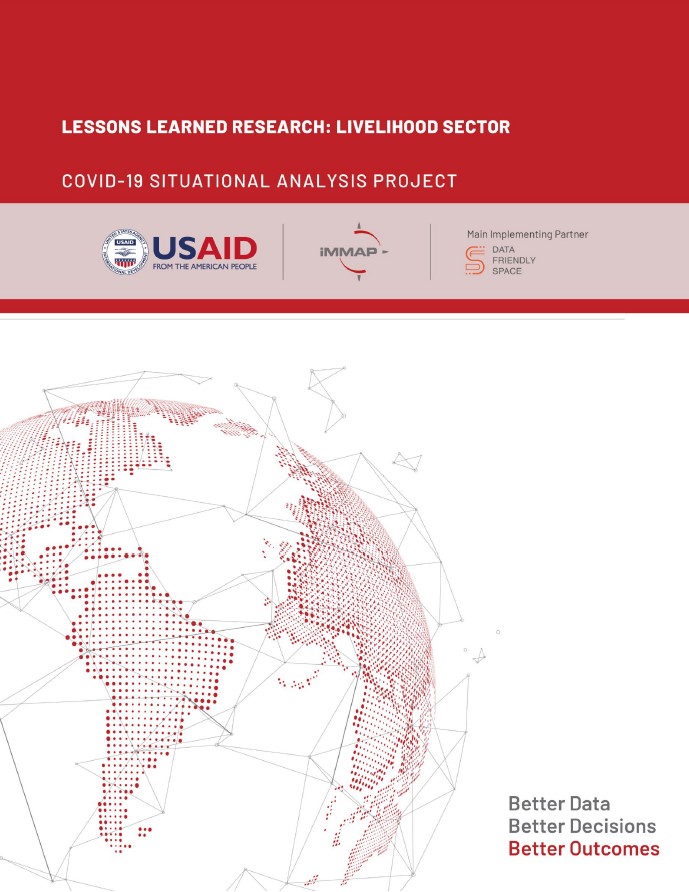
Lessons Learned: Livelihood Sector - COVID-19 Situational Analysis Project
iMMAP/DFS Lessons Learned: Livelihood Sector - COVID-19 Situational Analysis Project
Read more
Lessons Learned: Protection Sector - COVID-19 Situational Analysis Project
iMMAP/DFS Lessons Learned: Protection Sector - COVID-19 Situational Analysis Project
Read more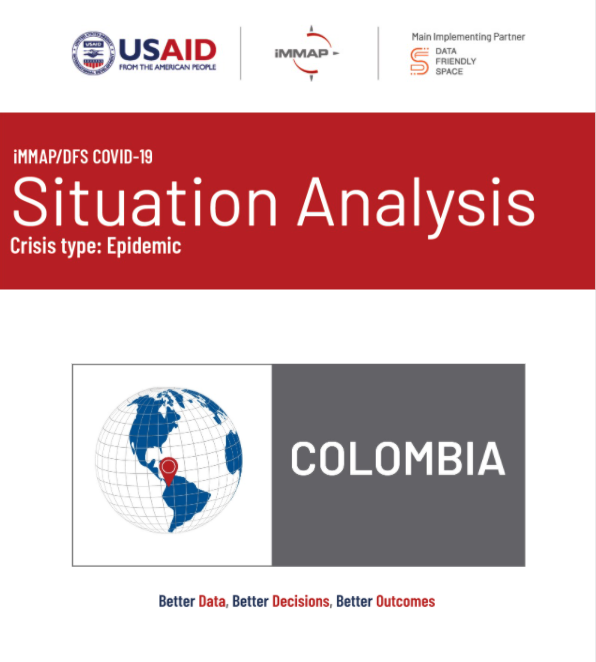
Colombia October 2021 Impact of COVID-19 on Children and Adolescents
A Thematic Report on the Impact of COVID-19 on Children and Adolescents in October 2021.
Read more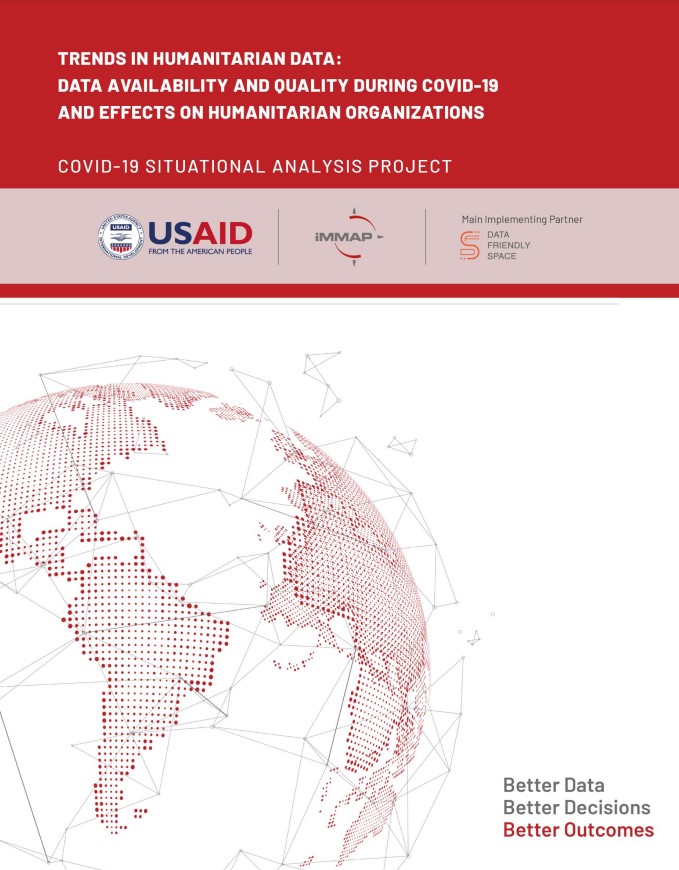
Trends in Humanitarian Data : Data Availability and Quality During COVID-19 and Effects on Humanitarian Organizations - COVID-19 Situational Analysis Project
iMMAP/DFS Trends in Humanitarian Data : Data Availability and Quality During COVID-19 and Effects on Humanitarian Organizations - COVID-19 Situational Analysis Project
Read more
Analysis of the adaptation, innovation and coping mechanisms of humanitarian organizations in the context of limited access to information during the COVID-19 pandemic - COVID-19 Situational analysis project
iMMAP/DFS Analysis of the adaptation, innovation and coping mechanisms of humanitarian organizations in the context of limited access to information during the COVID-19 pandemic - COVID-19 Situational analysis project
Read more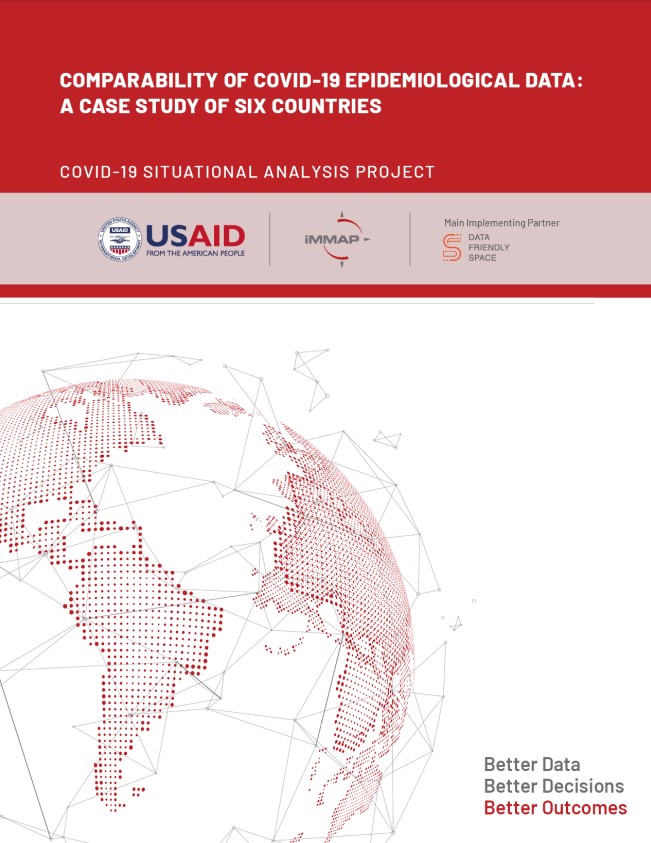
Comparability of COVID-19 Epidemiological Data: A case study of six countries
iMMAP/DFS Comparability of COVID-19 Epidemiological Data: A case study of six countries COVID-19 Situational Analysis Project
Read more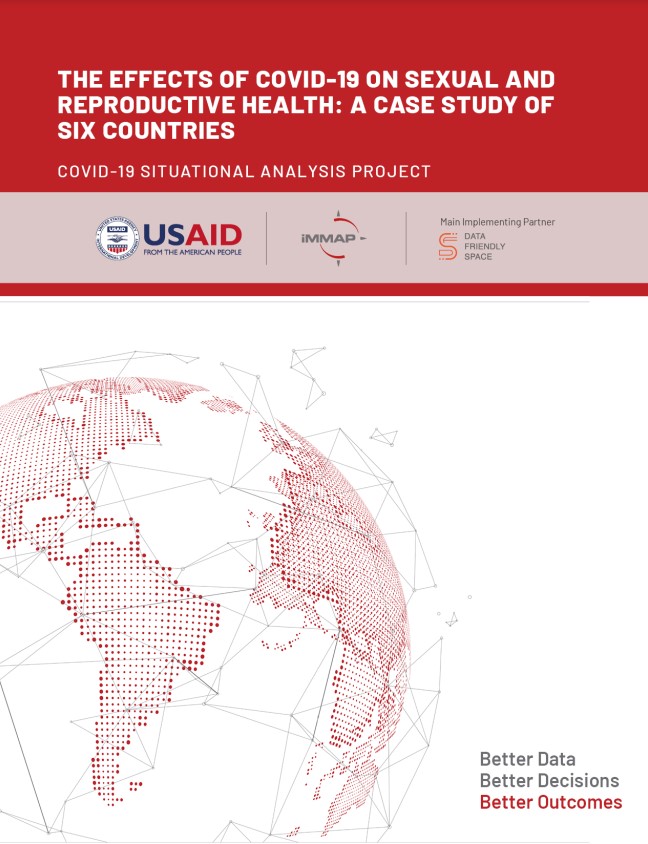
The effects of COVID-19 on Sexual and Reproductive Health: A Case Study of Six Countries
iMMAP/DFS The effects of COVID-19 on Sexual and Reproductive Health: A Case Study of Six Countries COVID-19 Situational Analysis Project
Read more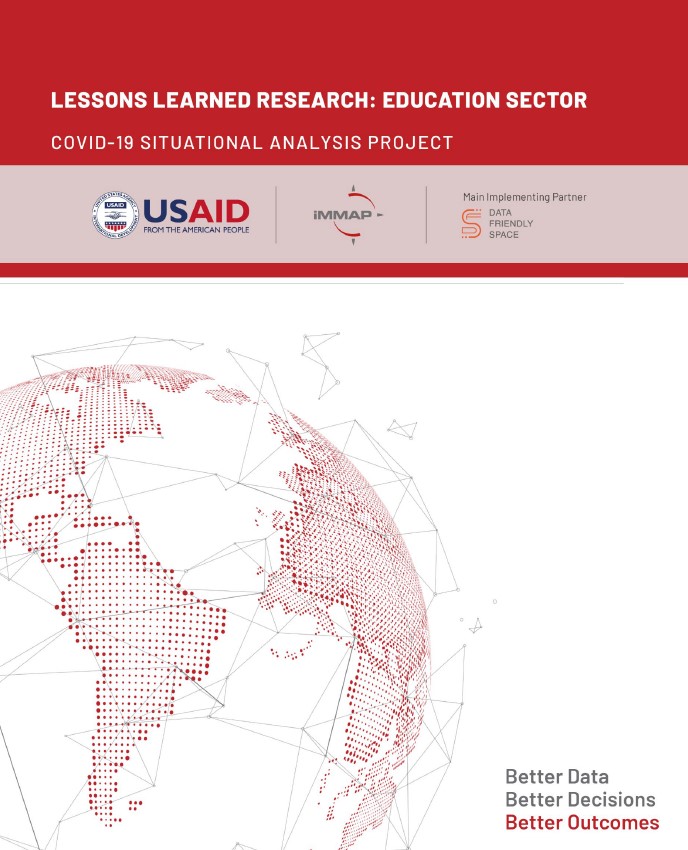
Lessons Learned: Education Sector
iMMAP/DFS Lesson Learned Research: Education Sector COVID-19 Situational Analysis Project
Read more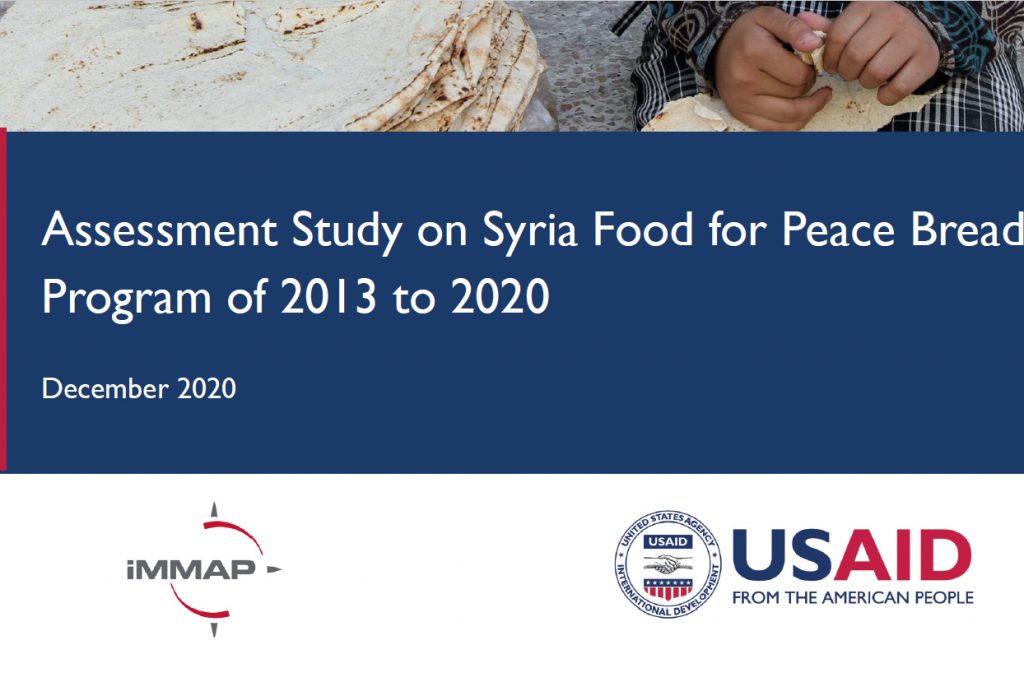
Assessment Study on Syria Food for Peace Bread Program of 2013 to 2020
This study assessed the effectiveness, sustainability, impact of the outcomes, and intended or unintended consequences of the USAID Food for Peace’s Bread Program in Syria from 2013 to 2020
Read more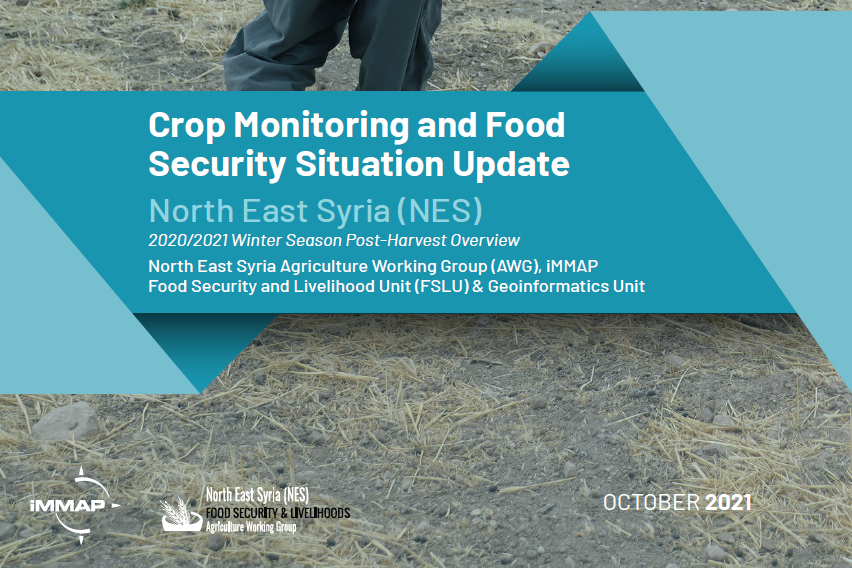
Crop Monitoring and Food Security Situation Update in North East Syria
Using the iMMAP Data Cube and field based-ground truthing, the 30-plus page study report presents the impact and results of water scarcity on the 2020-2021 winter cropping season across northeast Syria.
Read more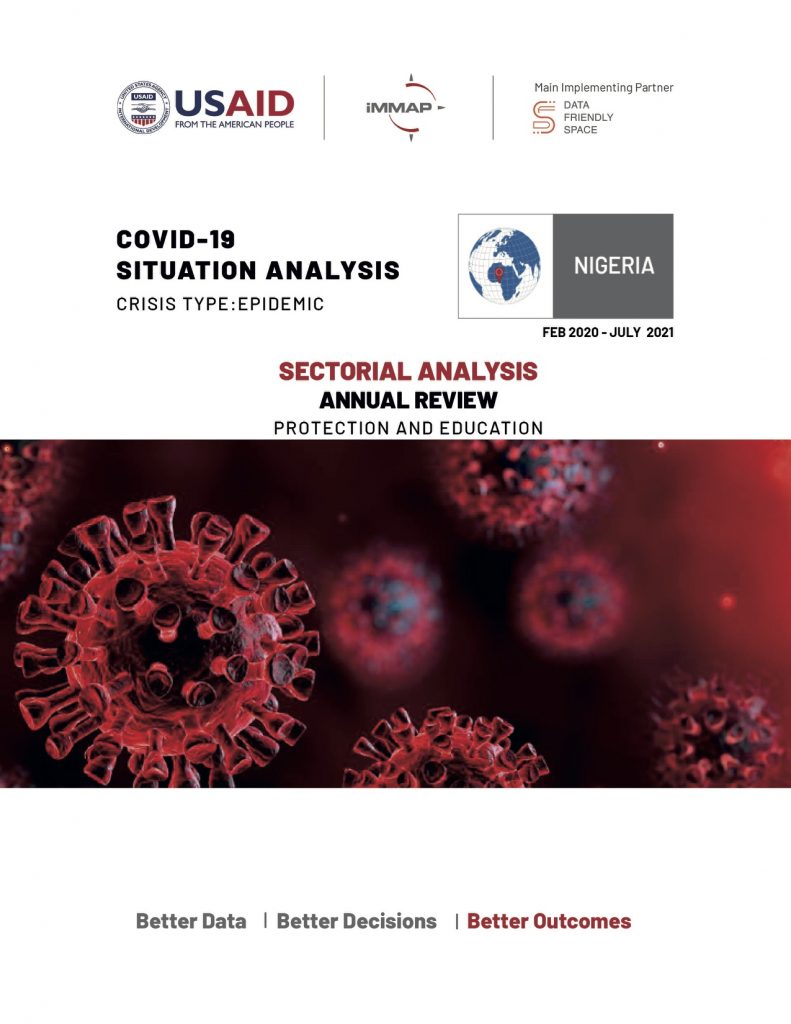
Nigeria: iMMAP/DFS COVID-19 Situation Analysis - Protection and Education Annual Review (Feb 2020 - July 2021)
iMMAP/DFS Nigeria COVID-19 Situation Annual Review Sectorial Analysis Protection and Education, February 2020 – July 2021
Read more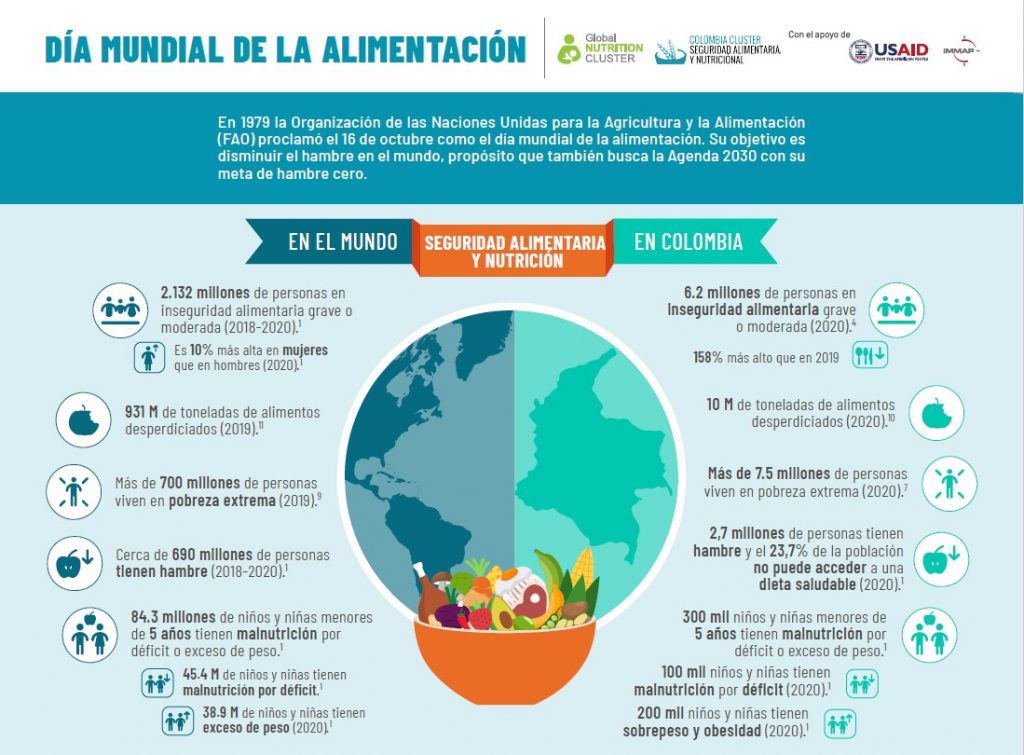
Food Security and Nutrition Situation in Colombia
In 1979 the Food and Agriculture Organization of the United Nations (FAO) proclaimed 16 October as World Food Day. Its objective is to reduce hunger in the world, a goal also pursued by the 2030 Agenda with its goal of zero hunger.
Read more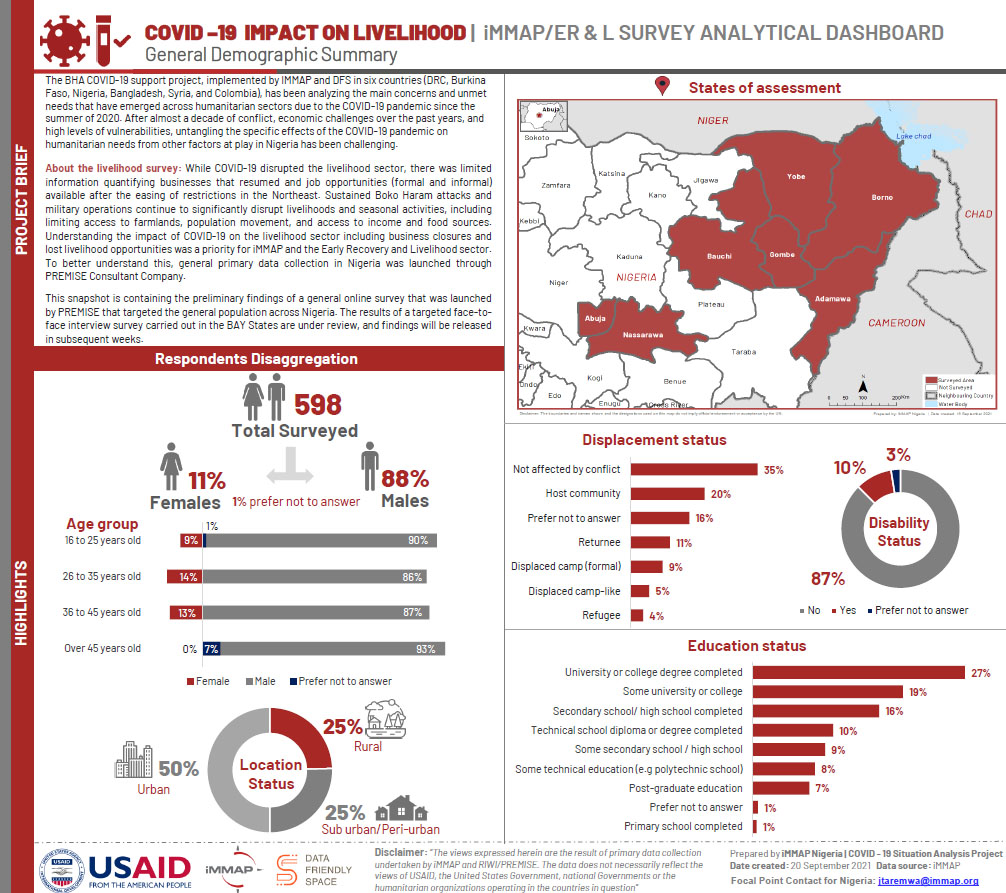
iMMAP/DFS Nigeria COVID-19 Impact on Livelihood
iMMAP/DFS Nigeria COVID-19 Impact on Livelihood General Demographic and Findings Summary (September 2021)
Read more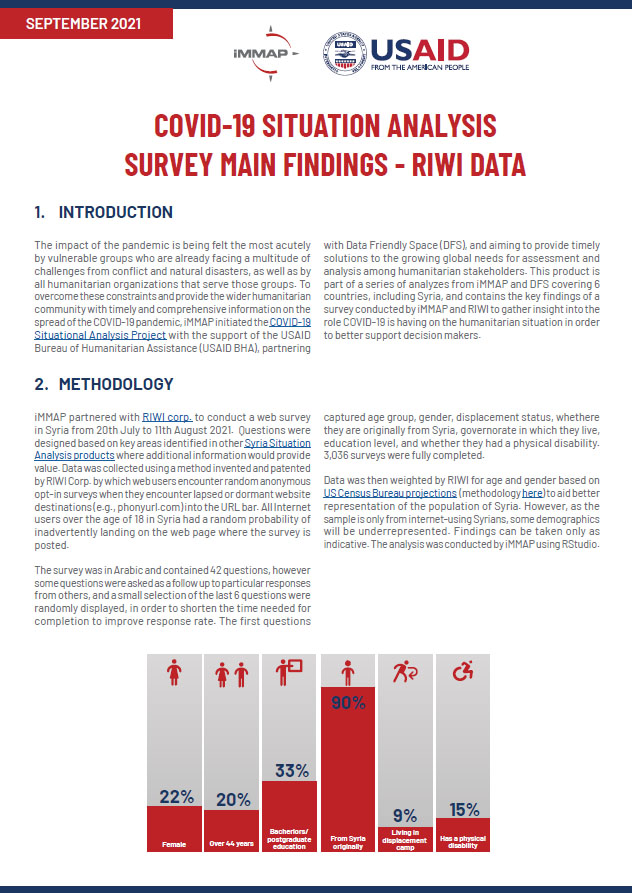
Syria COVID-19 Situation Analysis Survey Main Findings - Riwi Data
Syria Covid-19 Situation Analysis Survey Main Findings - Riwi Data
Read more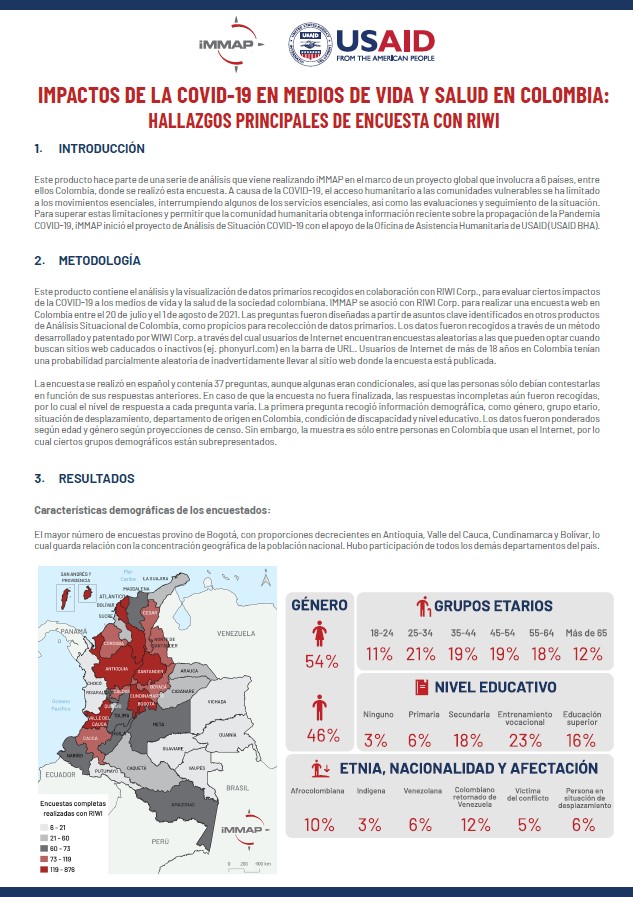
Impacts of COVID-19 on Livelihoods and Health in Colombia: RIWI Survey Main Findings
Impacts of COVID-19 on Livelihoods and Health in Colombia: RIWI Survey Main Findings (July 2020 - August 2021)
Read more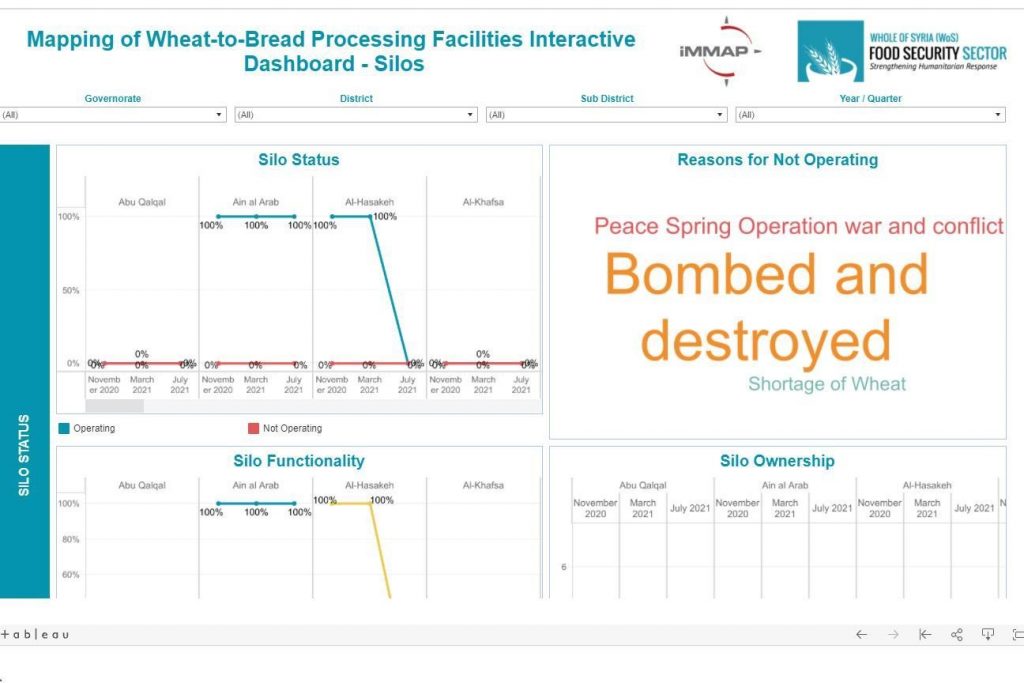
Mapping of Wheat-Flour to Bread Processing Facilities Interactive Dashboard
In collaboration with the Whole of Syria Food Security Sector, iMMAP developed a dashboard uncovering the ownership status, functionality, and operationality of the assessed bakeries, silos and mills across northeast Syria.
Read more
Wheat-Flour to Bread Processing Facilities Mapping Study for Northeast Syria (July 2021)
Carried out in July 2021, this Quarter 2 bakery and bread processing facilities mapping study is a follow-up to the initial Quarter 1 study conducted in March 2021.
Read more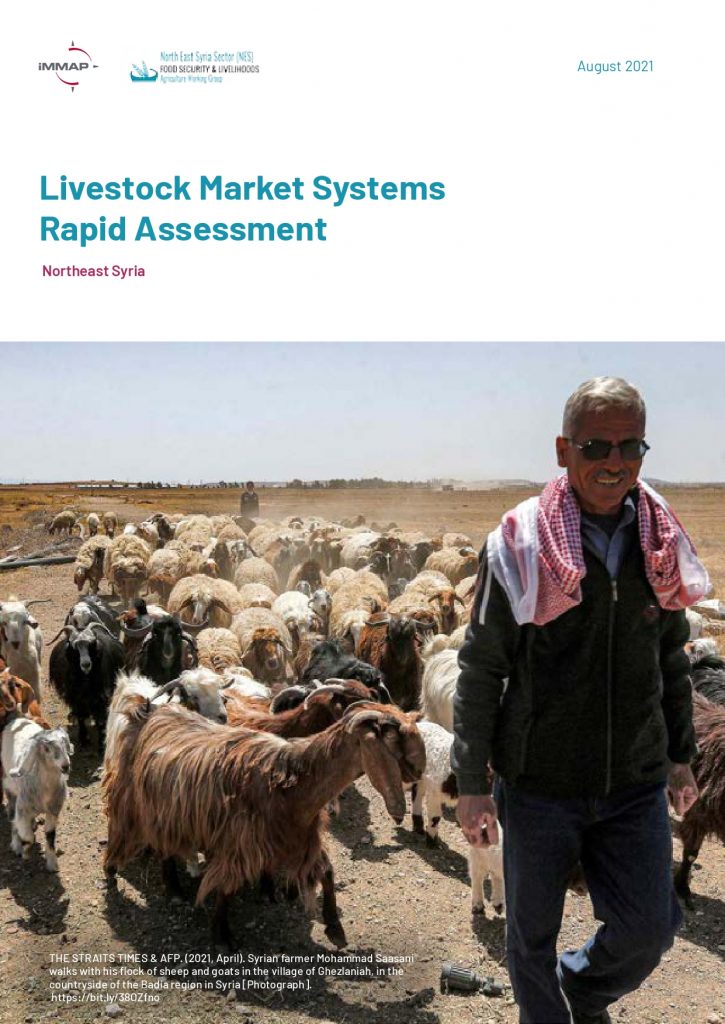
Livestock Market Systems Rapid Assessment in Northeast Syria
Through a desk review analysis and key informant interviews with 38 stakeholders across 19 sub-districts in northeast Syria (NES), this assessment provides a better understanding of the significance of livestock to livestock based- livelihoods, low rainfall induced water scarcity and its impact on livestock production systems, and unpacks the potential logistical challenges crippling the livestock value chain across northeast Syria.
Read more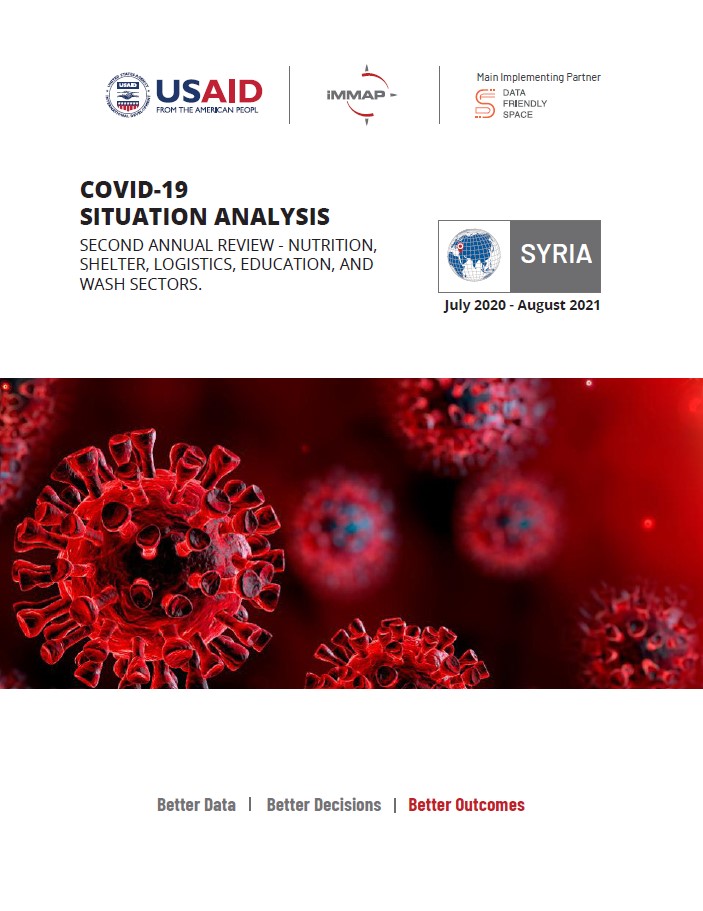
COVID-19 Situational Analysis Annual Review Report for Syria, Second Annual Review - Nutrition, Shelter, Logistics, Education, and Wash Sectors (July 2020-August 2021)
Syria COVID-19 Situational Analysis Annual Review Report, Second Annual Review - Nutrition, Shelter, Logistics, Education, and Wash Sectors (July 2020-August 2021)
Read more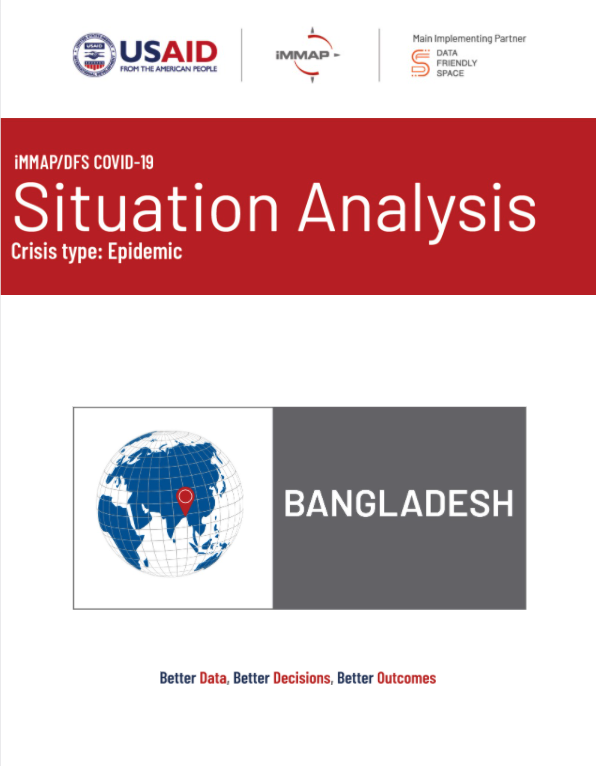
COVID-19 Situation Analysis Report for Bangladesh, July 2021 - September 2021
Bangladesh COVID-19 Situation report July 2021 - September 2021
Read more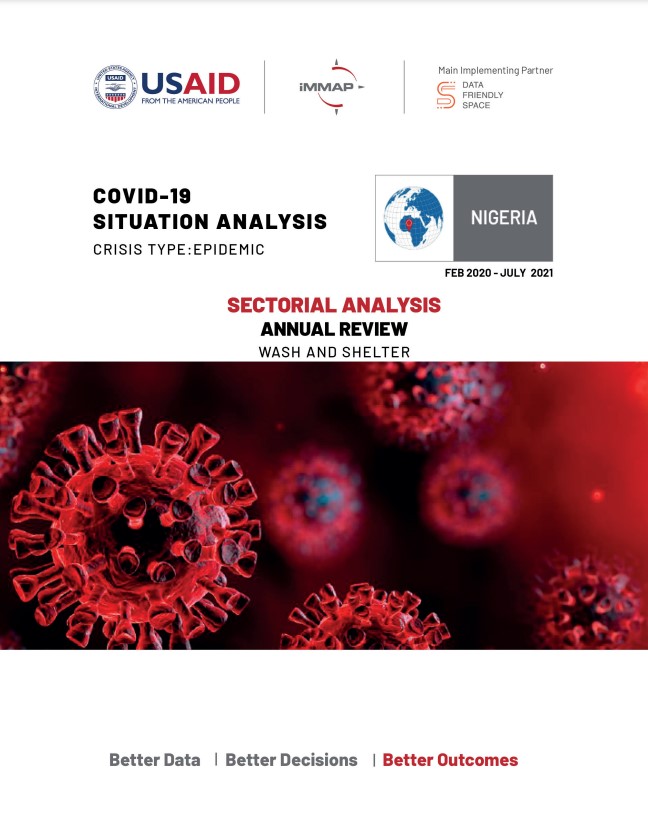
iMMAP/DFS Nigeria COVID-19 Situation Annual Review Sectorial Analysis Report Wash And Shelter, February 2020 – July 2021
Nigeria COVID-19 Situation Annual Review Sectorial Analysis Report Wash And Shelter, Feb 2020 – July 2021
Read moreCOVID-19 Situational Analysis Annual Report for Burkina Faso Sectoral Analysis, March 2020 - July 2021
Burkina Faso COVID-19 Situational Analysis Annual Report Sectoral Analysis, March 2020 - July 2021
Read more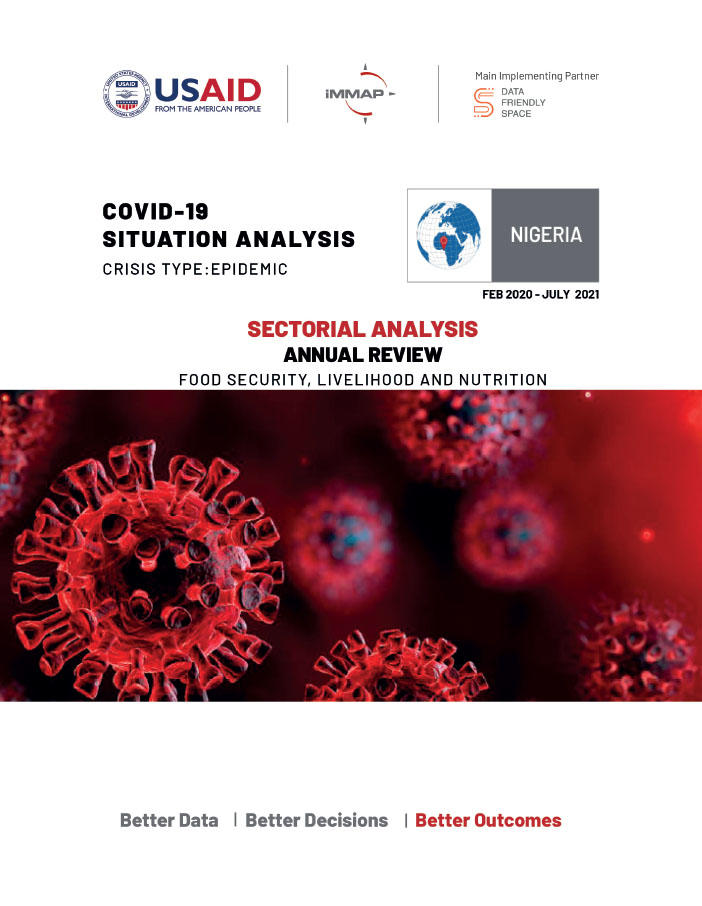
COVID-19 Situation Annual Review Report for Nigeria : Sectorial Analysis, February 2020 – July 2021
Nigeria COVID-19 Situation Annual Review Sectorial Analysis Report, Feb 2020 – July 2021
Read more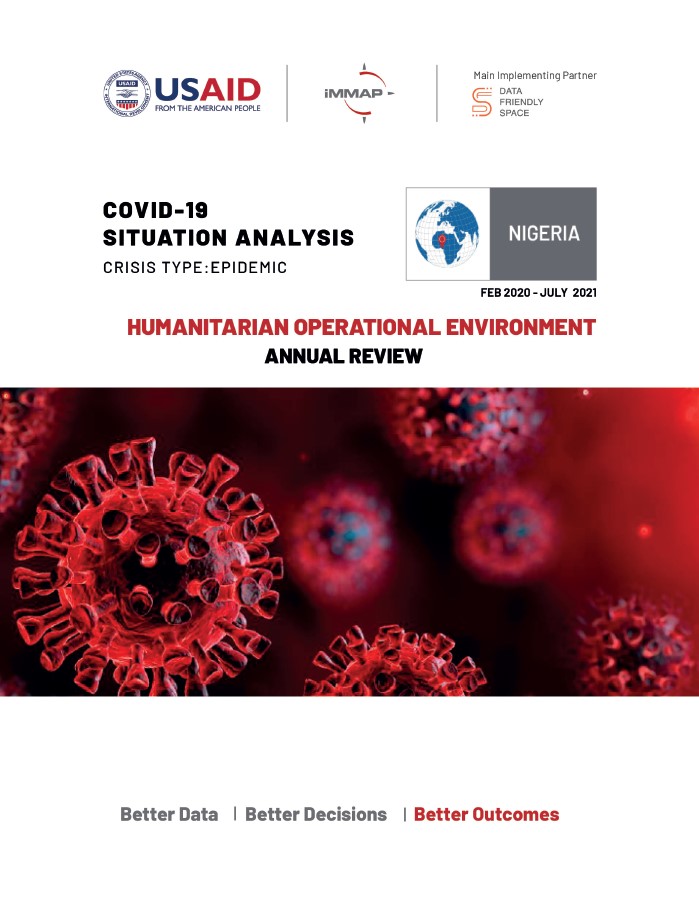
COVID-19 Situation Annual Review Report for Nigeria : Humanitarian Operational Environment Report, February 2020 – July 2021
Nigeria COVID-19 Situation Annual Review Humanitarian Operational Environment Report, Feb 2020 – July 2021
Read more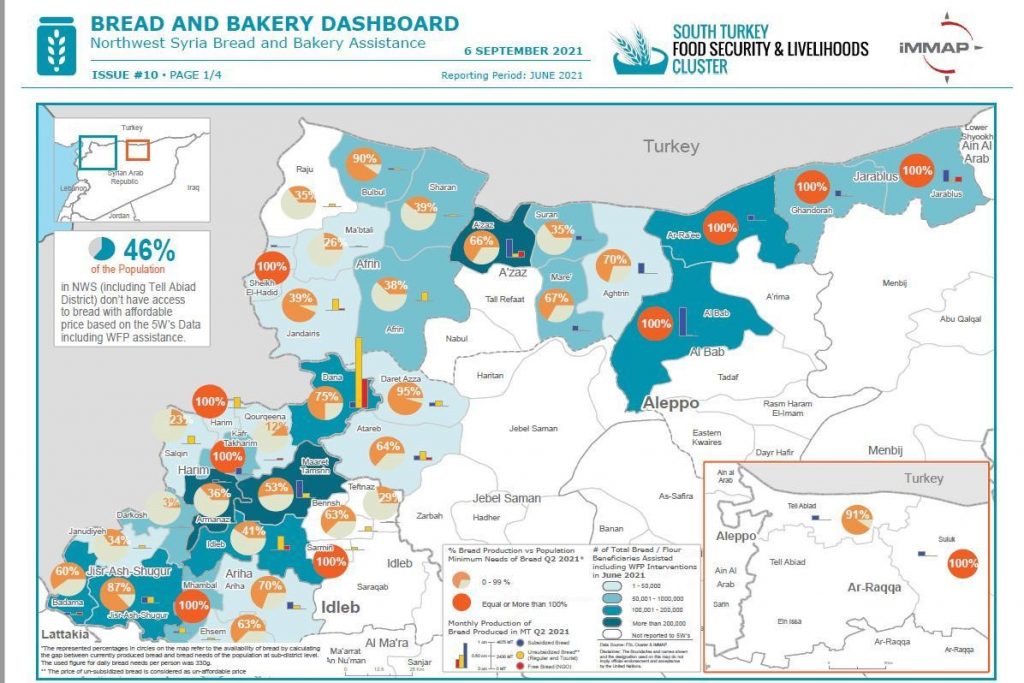
Bread and Bakery Dashboard Covering Northwest Syria (June 2021)
In collaboration with the South Turkey Food Security and Livelihoods Cluster, iMMAP developed a dashboard uncovering the production levels and amount of assisted Syrians with bread and flour interventions during the second quarter of 2021.
Read more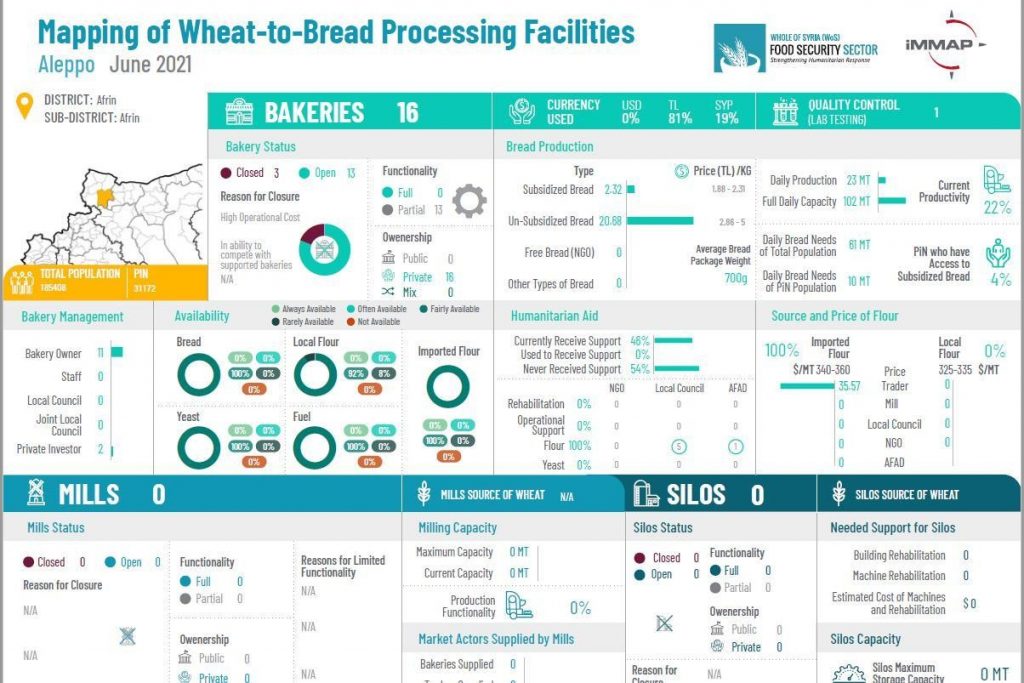
Factsheets Mapping Wheat-Flour to Bread Processing Facilities in Northwest Syria (June 2021)
A catalog of factsheets highlighting the status and availability of various wheat-to-bread processing facilities across different districts and sub-districts in northwest Syria during the second quarter of 2021.
Read more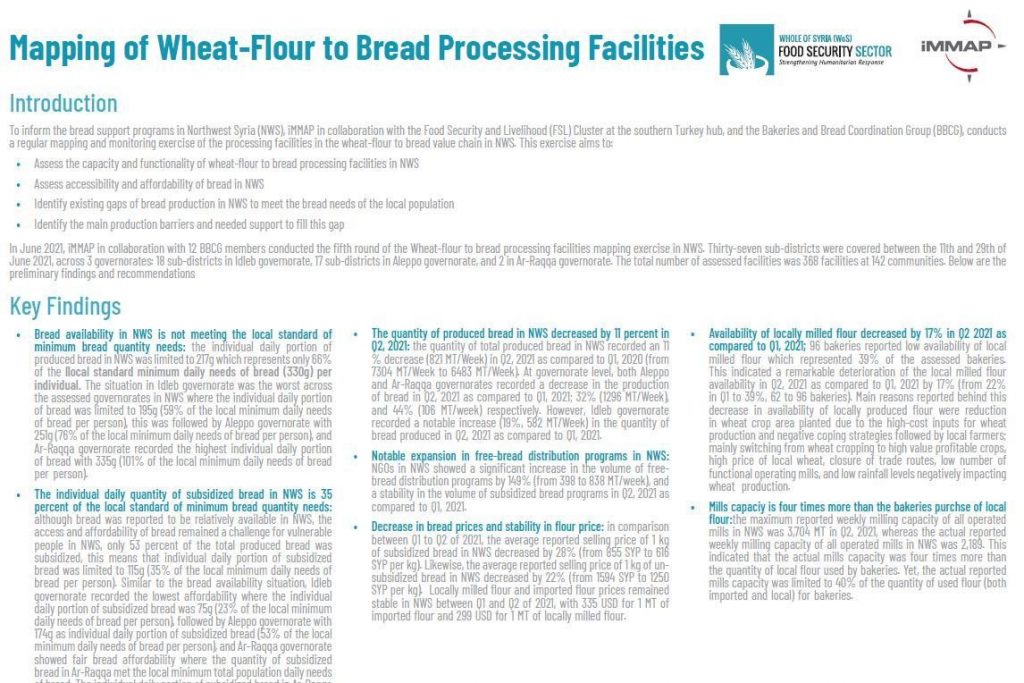
Wheat-Flour to Bread Processing Facilities Mapping Study Summary for Northwest Syria (June 2021)
Carried out in the second quarter of 2021, this bakery and bread processing facilities mapping study summary highlights the status of 368 bakeries across 37 sub-districts in northwest Syria.
Read more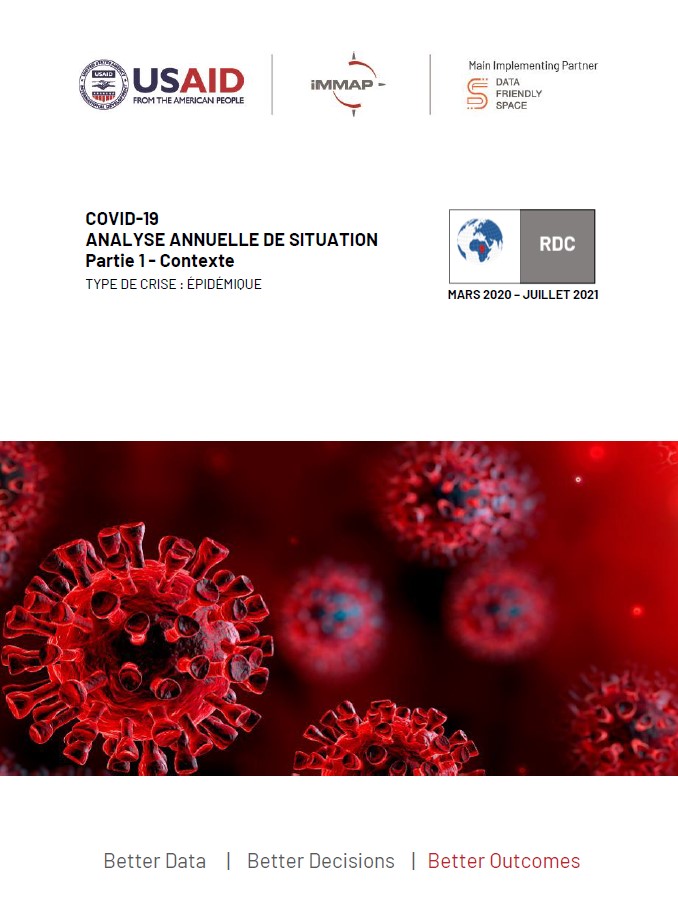
COVID-19 Situational Analysis Annual Report for DRC: Part 1 – Context
Democratic Republic of Congo COVID-19 Situational Analysis Annual Report : Part 1 – Context, March 2020 - July 2021
Read more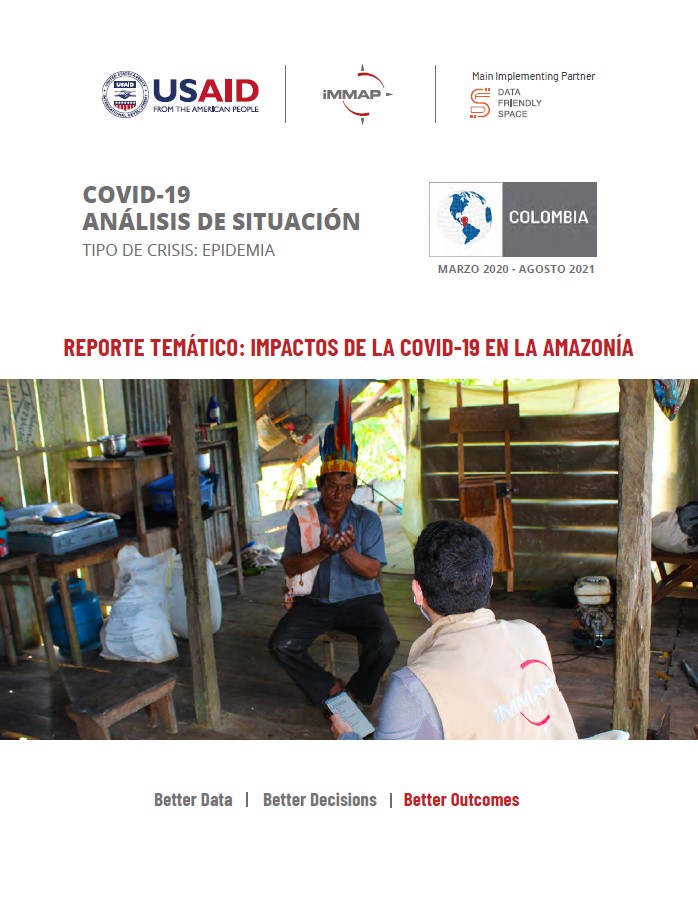
Colombia COVID-19 Situational Analysis Thematic Report: Impacts of the pandemic on the Amazonas Region
Colombia COVID-19 Situational Analysis Thematic Report: Impacts of the pandemic on the Amazonas Region (March 2020 - August 2021)
Read more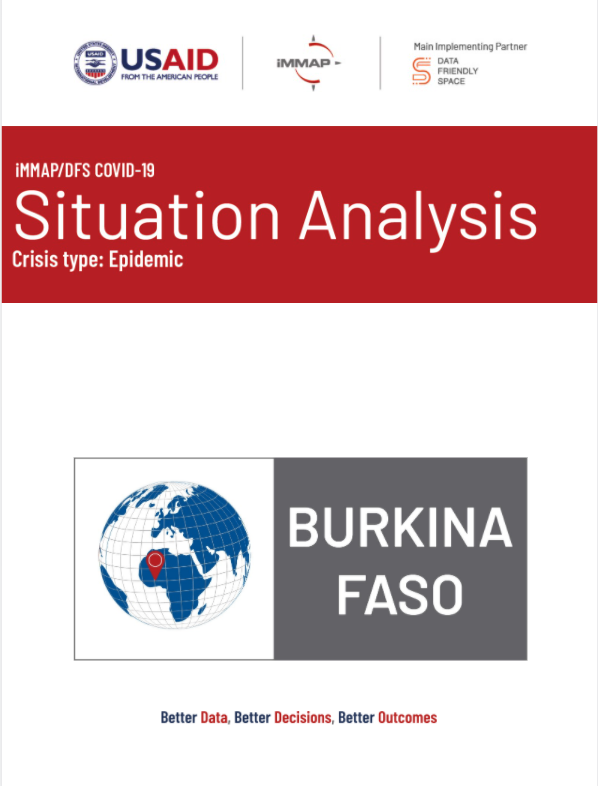
June 2021: COVID-19 Situation Analysis Report
Burkina Faso COVID-19 Situation report June 2021
Read more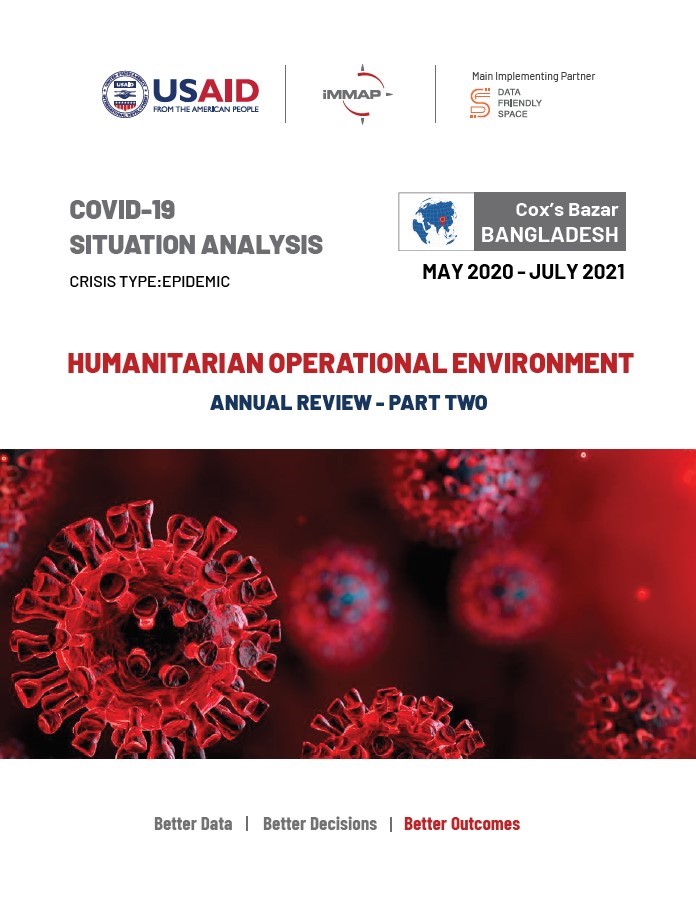
COVID-19 Situation Annual Review, Part Two: Humanitarian Operational Environment Report, May 2020 – July 2021
Bangladesh COVID-19 Situation Annual Review, Part Two: Humanitarian Operational Environment Report, May 2020 – July 2021
Read more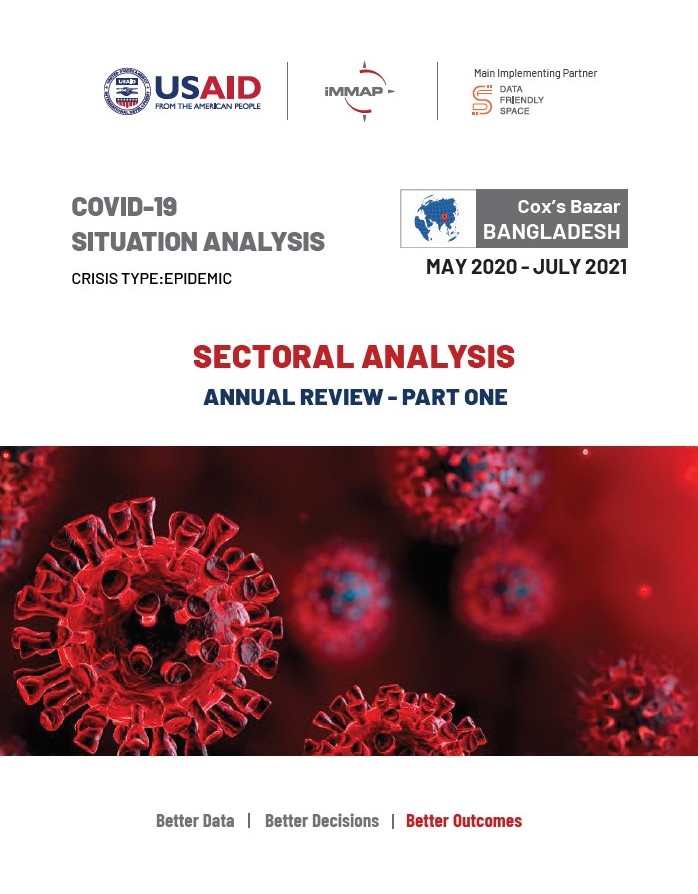
COVID-19 Situation Annual Review, Part One: Sectoral Analysis Report, May 2020 – July 2021
Bangladesh COVID-19 Situation Annual Review, Part One: Sectoral Analysis Report, May 2020 – July 2021
Read more
COVID-19 Situational Analysis Annual Review Report (July 2020-July 2021)
Colombia COVID-19 Situational Analysis Annual Review Report (July 2020-July 2021)
Read more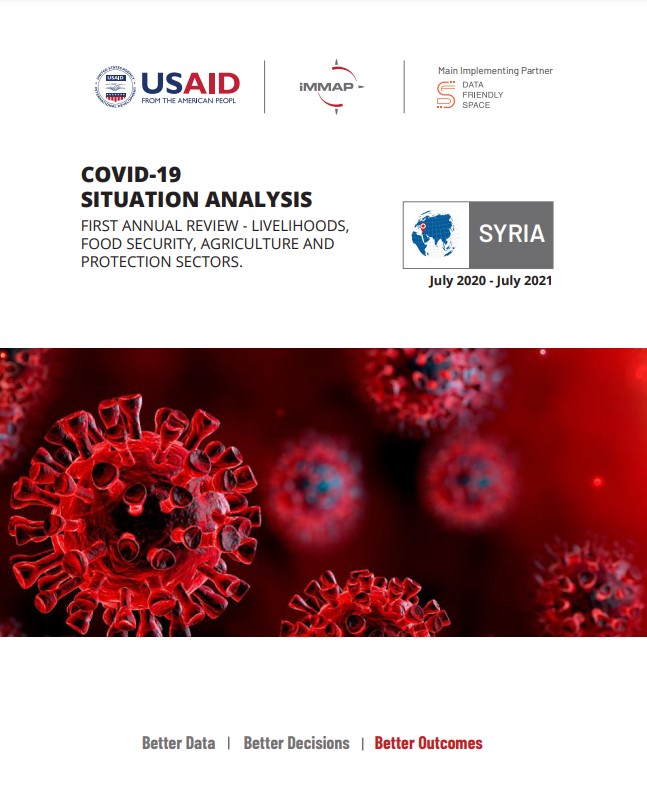
COVID-19 Situational Analysis Annual Review Report for Syria, First Annual Review - Livelihoods, Food Security, Agriculture and Protection Sectors (July 2020-July 2021)
Syria COVID-19 Situational Analysis Annual Review Report, First Annual Review - Livelihoods, Food Security, Agriculture and Protection Sectors (July 2020-July 2021)
Read more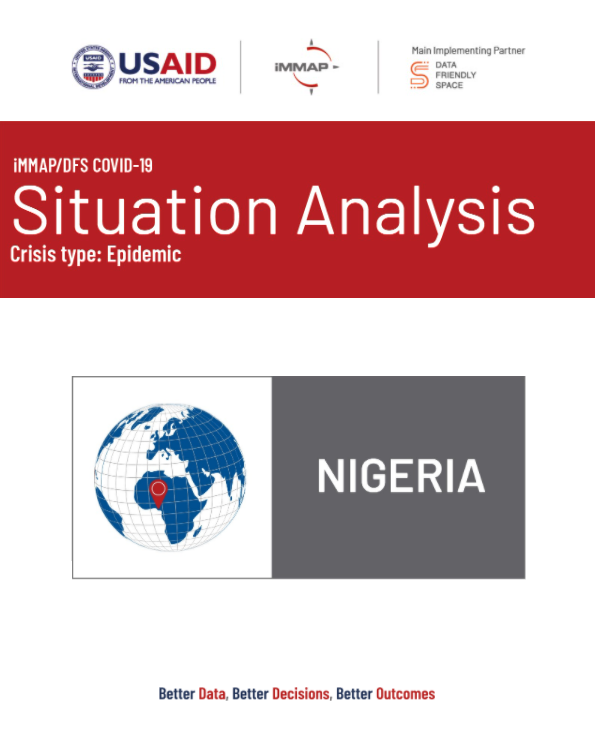
June 2021: COVID-19 Situation Analysis Report
Nigeria COVID-19 situation analysis report June 2021
Read more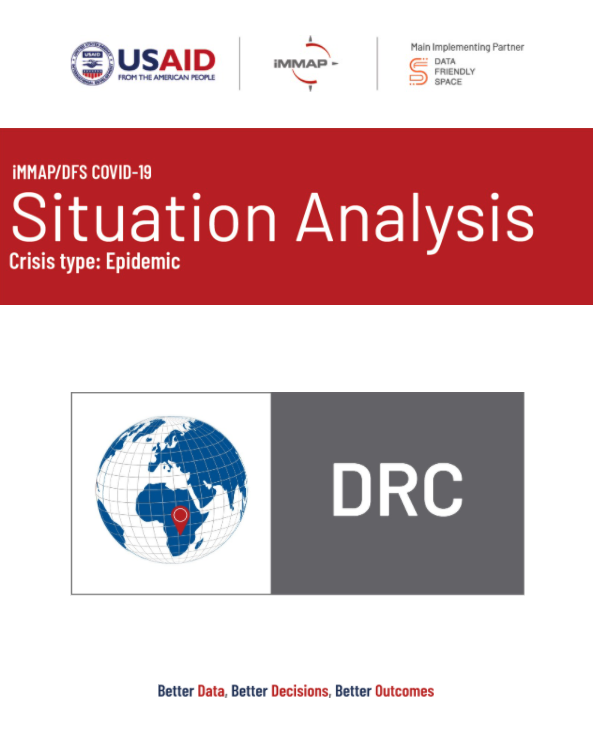
DRC COVID-19 Risk Analysis (August 2020-July 2021)
Democratic Republic of Congo COVID-19 Risk Analysis (August 2020-July 2021)
Read more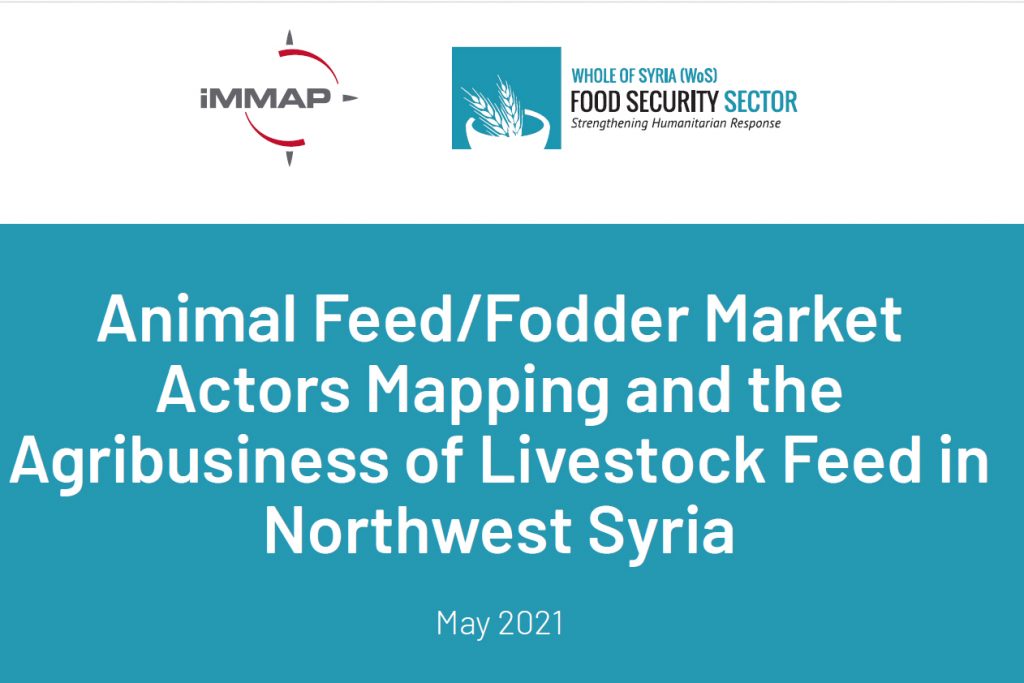
Animal Feed/Fodder Market Actors Mapping and the Agribusiness of Livestock Feed in Northwest Syria
A study that explored animal feed and fodder market actors across northwest Syria, highlighting their overall functionality and stocking/sales capacity, along with the current practices and challenges of the primary agribusiness actors involved in the animal feed and fodder value chain.
Read more
May 2021: COVID-19 Situation Analysis Report
Burkina Faso COVID-19 Situation report May 2021
Read more
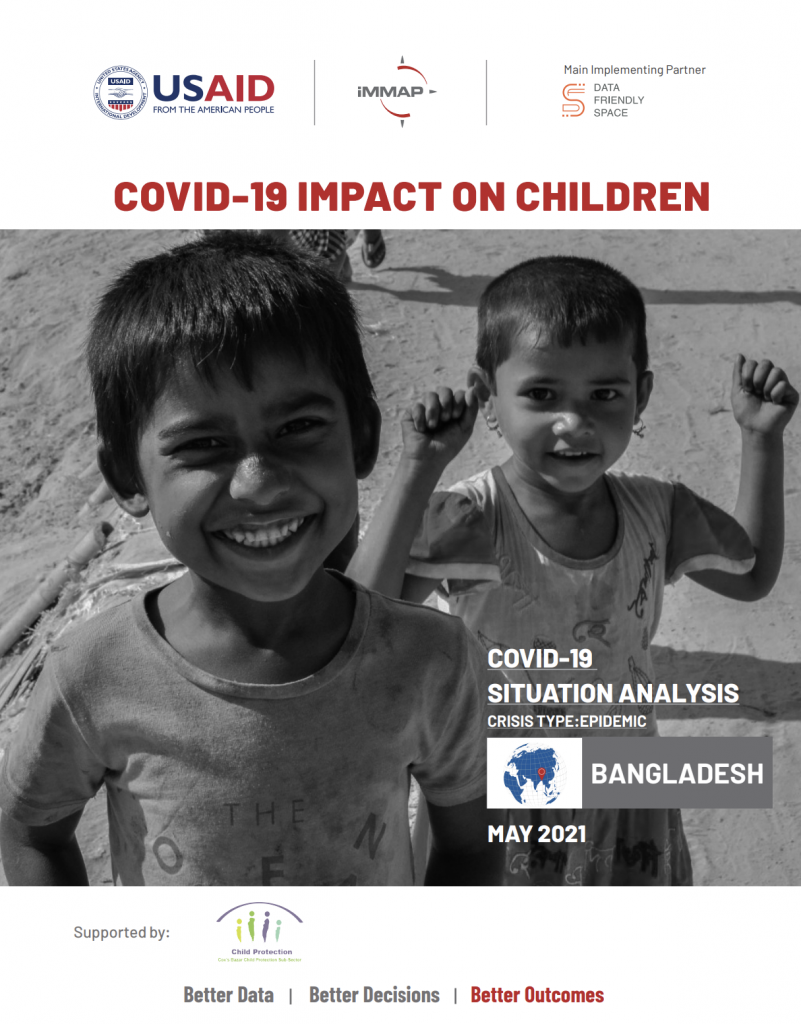
COVID-19 Impact on Children: iMMAP Bangladesh Thematic Report for May 2021
iMMAP Bangladesh Thematic Report for May 2021
Read more

May 2021: COVID-19 Situation Analysis Report
Democratic Republic of Congo COVID-19 Situation report May 2021
Read more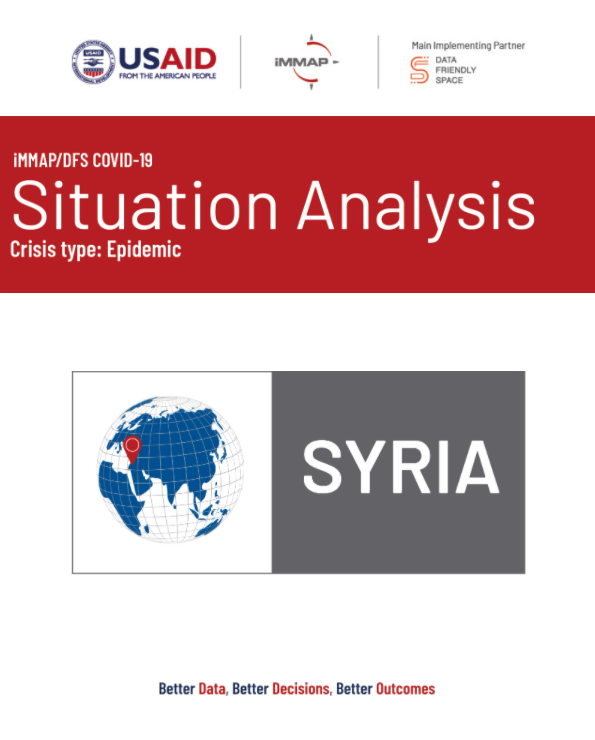
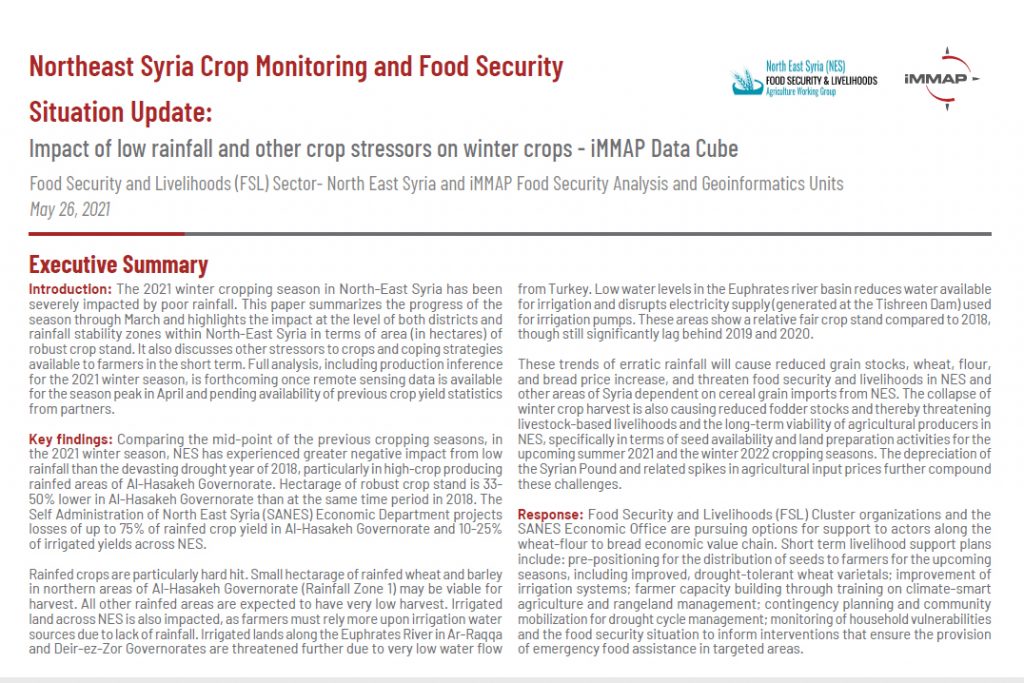
Northeast Syria Crop Monitoring and Food Security Situation Update
A brief report that explores the impact of low rainfall and stressors like electricity shortages and the poor quality of agricultural inputs on the cultivation of crops during the winter season in northeast Syria.
Read more
Factsheets Mapping Wheat-to-Bread Processing Facilities in Northwest Syria
A catalog of factsheets highlighting the status and availability of various wheat-to-bread processing facilities across different districts and sub-districts in northwest Syria.
Read more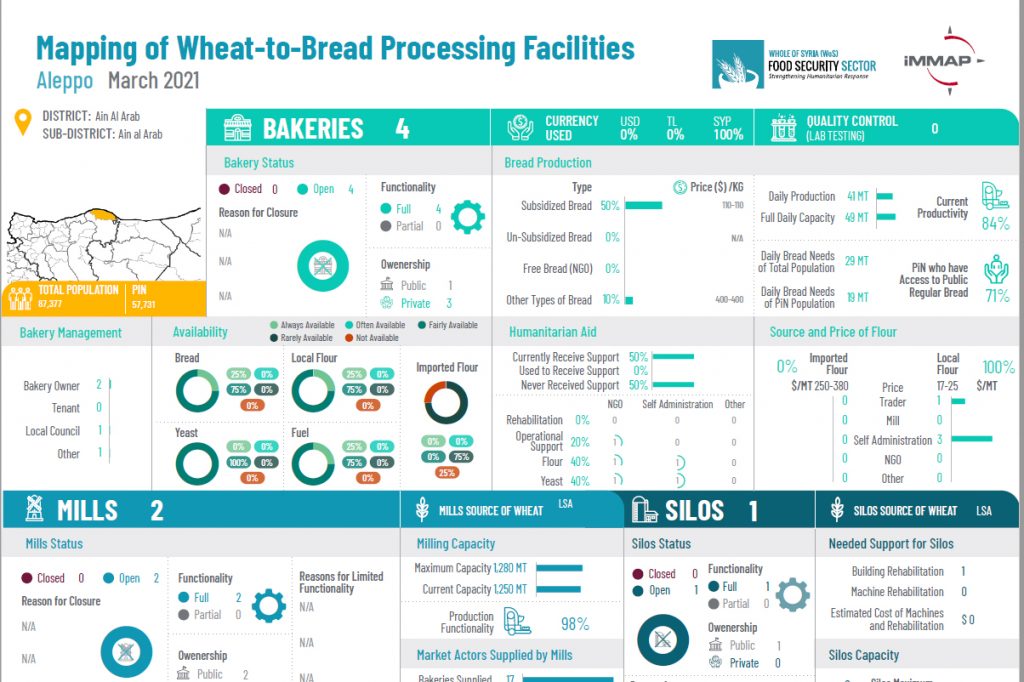
Factsheets Mapping Wheat-to-Bread Processing Facilities in Northeast Syria
A catalog of factsheets highlighting the status and availability of various wheat-to-bread processing facilities across different districts and sub-districts in northeast Syria.
Read more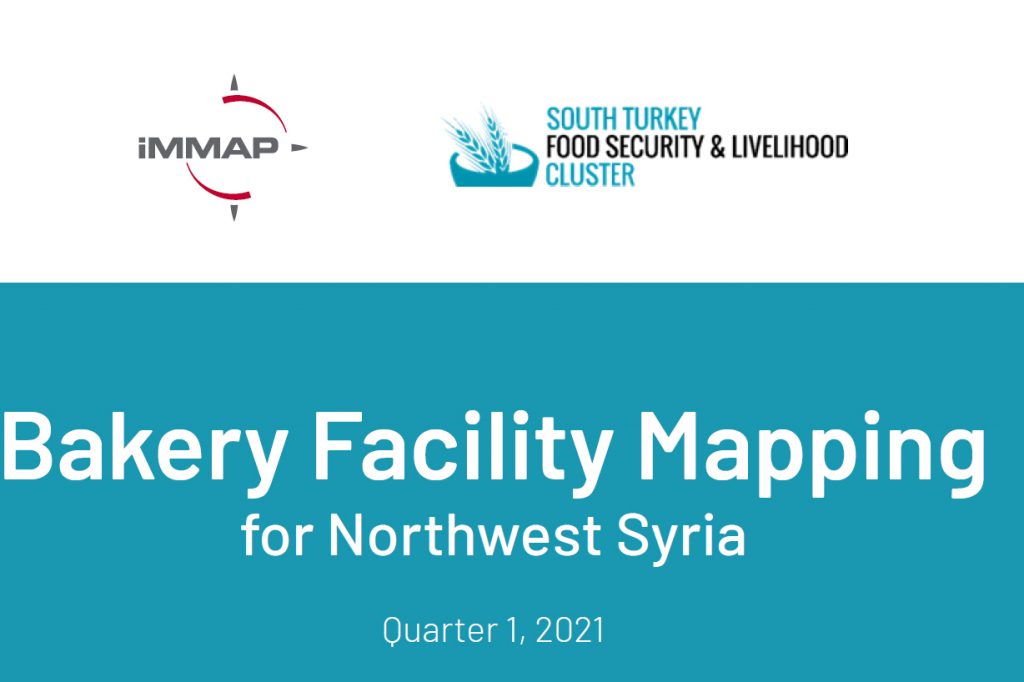
Bakery Facilities Mapping Study for Northwest Syria
Carried out in the first quarter of 2021, this mapping study assesses and highlights the status of 347 bakeries across 18 sub-districts in northwest Syria.
Read more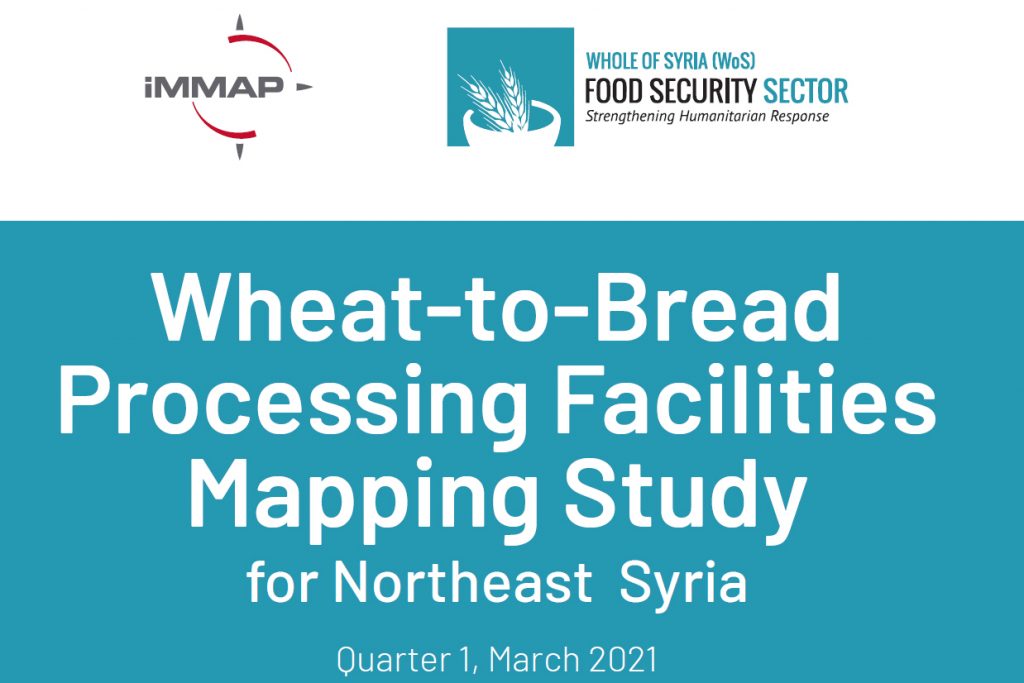
Wheat-to-Bread Processing Facilities Mapping Study for Northeast Syria
Carried out in the first quarter of 2021, this study assesses and highlights the status of over 700 wheat-to-bread processing facilities across 14 different sub-districts in northeast Syria
Read more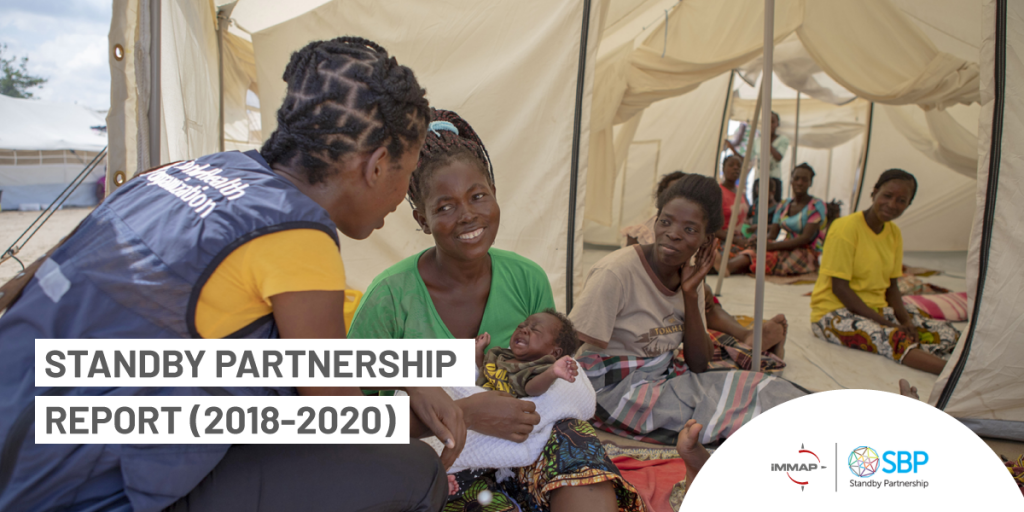
STANDBY PARTNERSHIP REPORT (2018-2020)
With the support from USAID, since 2012 iMMAP has been an official Standby Partner to United Nations agencies, providing skilled and experienced human resources in humanitarian emergencies.
Read more
April 2021: COVID-19 Situation Analysis Report
Democratic Republic of Congo COVID-19 Situation report April 2021
Read more
April 2021: COVID-19 Situation Analysis Report
Colombia COVID-19 Situation report April 2021
Read more
April 2021: COVID-19 Situation Analysis Report
Burkina Faso COVID-19 Situation report April 2021
Read more
April 2021: COVID-19 Situation Analysis Report
Bangladesh COVID-19 Situation report April 2021
Read more
April 2021: COVID-19 Situation Analysis Report
Nigeria COVID-19 Situation report April 2021
Read more

Colombia: tracking of venezuelan migrant population connections in Facebook
IMMAP locates Venezuelan migrants in Latin America through the use of Facebook advertising data. using Facebook's advertising data api. showing the connections of users showing the connections of users who used to live in Venezuela and now live abroad. now live abroad.
Read more
March 2021: COVID-19 Situation Analysis Report
Nigeria COVID-19 Situation report March 2021
Read more

March 2021: COVID-19 Situation Analysis Report
Colombia COVID-19 Situation report March 2021
Read more
March 2021: COVID-19 Situation Analysis Report
Democratic Republic of Congo COVID-19 Situation report March 2021
Read more
March 2021: COVID-19 Situation Analysis Report
Burkina Faso COVID-19 Situation report March 2021
Read more
March 2021: COVID-19 Situation Analysis Report
Bangladesh COVID-19 Situation report March 2021
Read more
February 2021: COVID-19 Situation Analysis Report
Colombia COVID-19 Situation report February 2021
Read more
February 2021: COVID-19 Situation Analysis Report
Bangladesh COVID-19 Situation report February 2021
Read more
February 2021: COVID-19 Situation Analysis Report
Syria COVID-19 Situation report February 2021
Read more
February 2021: COVID-19 Situation Analysis Report
Democratic Republic of Congo COVID-19 Situation report February 2021
Read more
February 2021: COVID-19 Situation Analysis Report
Burkina Faso COVID-19 Situation report February 2021
Read more
February 2021: COVID-19 Situation Analysis Report
Nigeria COVID-19 Situation report February 2021
Read more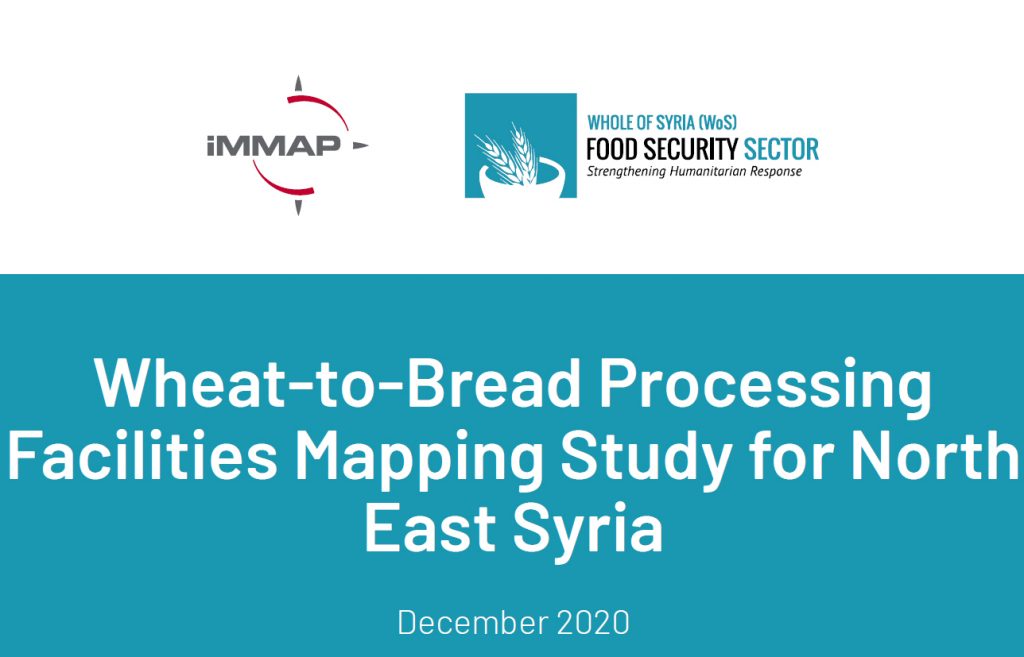
Wheat-to-Bread Processing Facilities Mapping Study for North East Syria
Wheat-to-Bread Processing Facilities Mapping Study for North East Syria
Read more




COVID-19 Situation Analysis Report
Democratic Republic of Congo COVID-19 Situation report January 2021
Read more
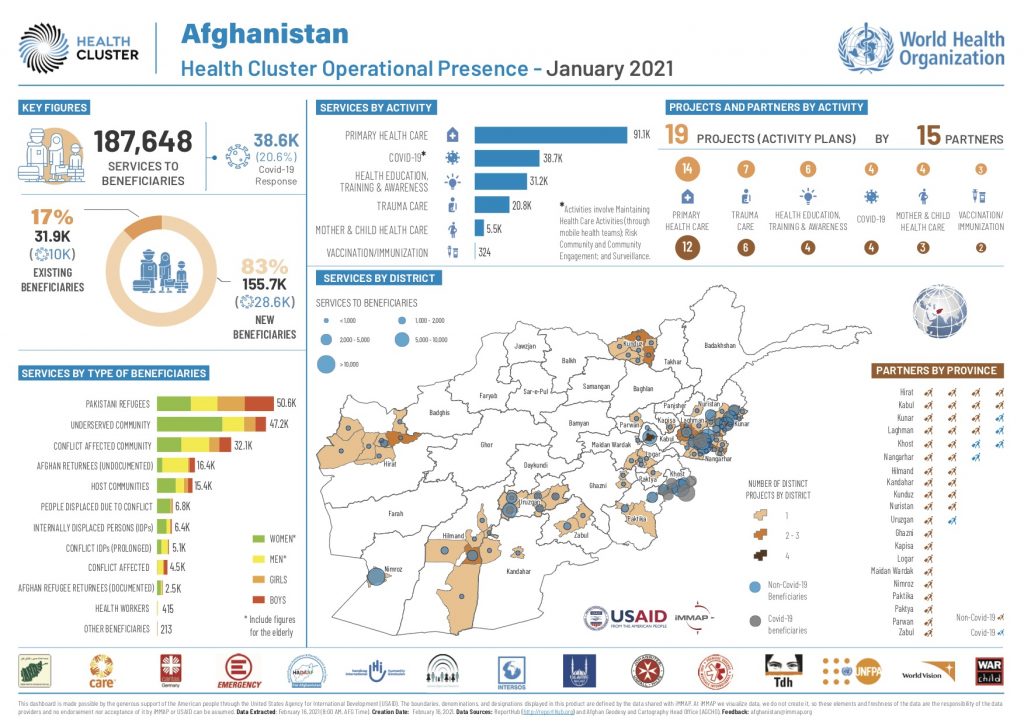
Health Cluster Operational Presence, January 2021
Health Cluster Operational Presence - January 2021, based on data reported to ReportHub in Afghanistan by Health Cluster implementing partners.
Read more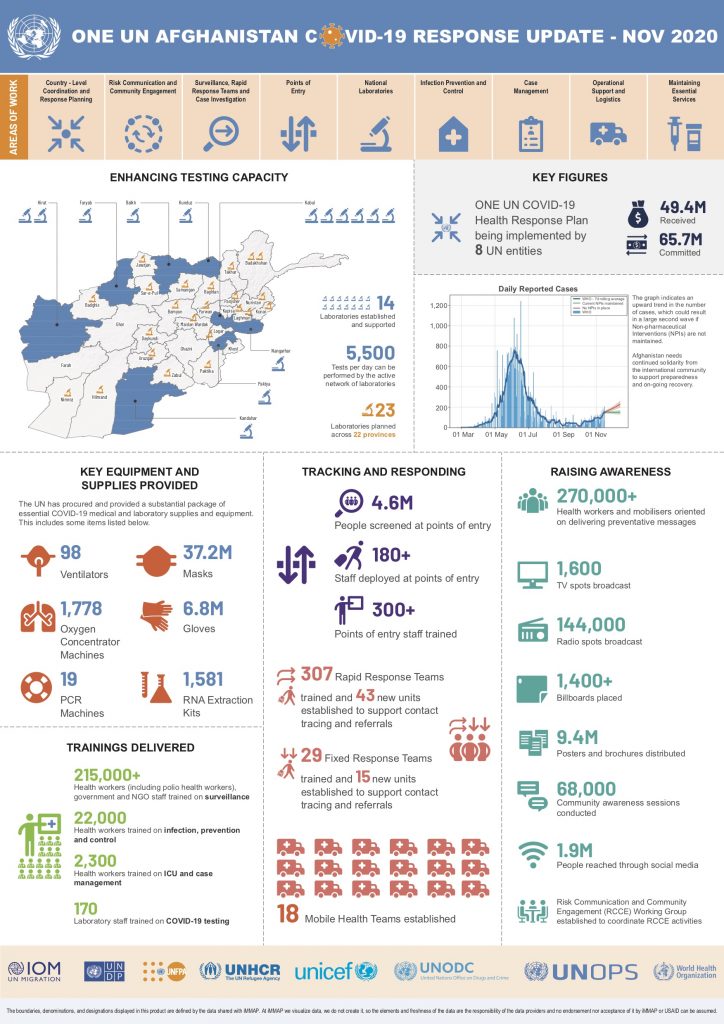
One UN Afghanistan COVID-19 Response Update, November 2020
One UN Afghanistan COVID-19 Response Update - November 2020. Produced for the Health Cluster in Afghanistan.
Read more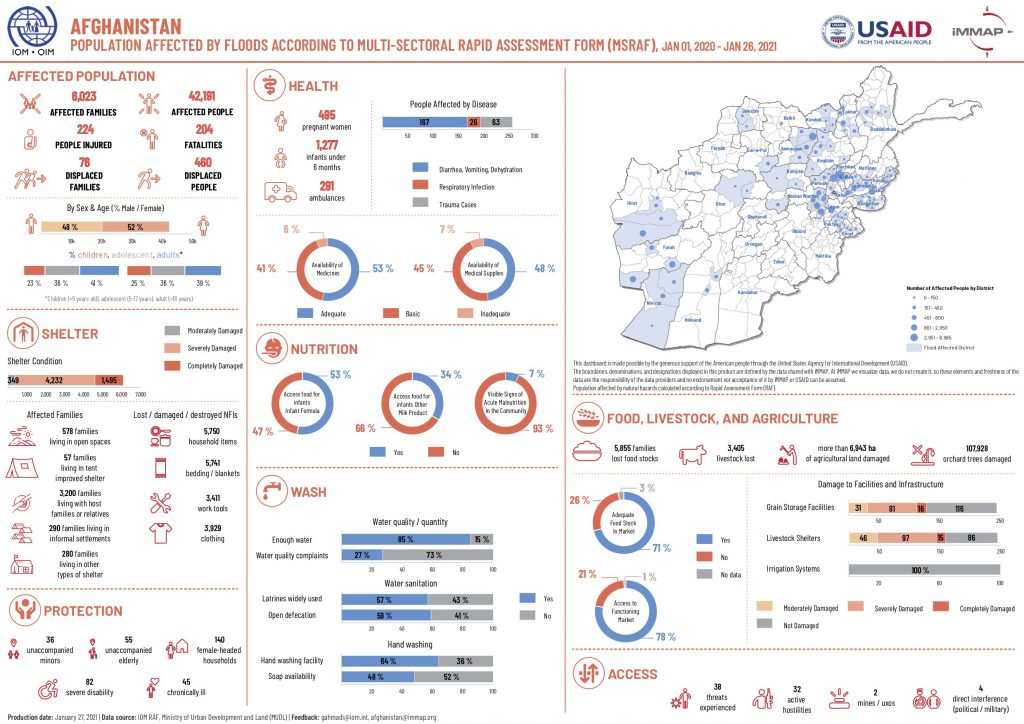
Population Affected by Floods According to MSRAF, January 1, 2020 to January 26, 2021
Afghanistan Population Affected by Floods According to Multi-Sectoral Rapid Assessment Form (MSRAF), JAN 01, 2020 - JAN 26, 2021. Produced for IOM in Afghanistan.
Read more
Multi-Sectoral Dashboard for Humanitarian Response Services (January - December 2020)
Multi-Sectoral Dashboard for Humanitarian Response Services (January - December 2020), based on data reported to ReportHub in Afghanistan by implementing partners.
Read more
Multi-Sectoral Dashboard for Humanitarian Response Services (January 2021)
Multi-Sectoral Dashboard for Humanitarian Response Services (January 2021), based on data reported to ReportHub in Afghanistan by implementing partners.
Read more


COVID-19 Situation Analysis Report
Democratic Republic of Congo COVID-19 Situation report December 2020
Read more





COVID-19 Situation Analysis Report
Democratic Republic of Congo COVID-19 Situation report November 2020
Read more


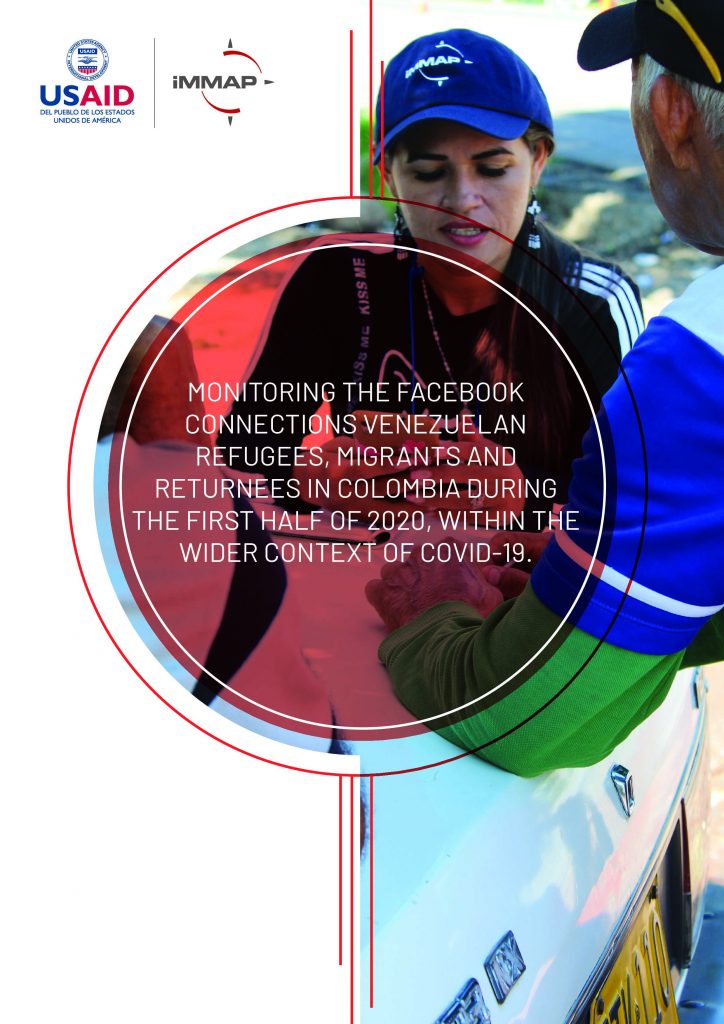
Colombia: The impact of covid-19 on Venezuelan refugees, migrants and returnees from Venezuela in Colombia
Due to the spread of SARS-COV-2 and the mandatory isolation measures, it can be assumed that both mixed migration flows and internet access of this population changed. An important aspect is the closure of the Colombian-Venezuelan border in March, which has hindered binational migration flows.
Read more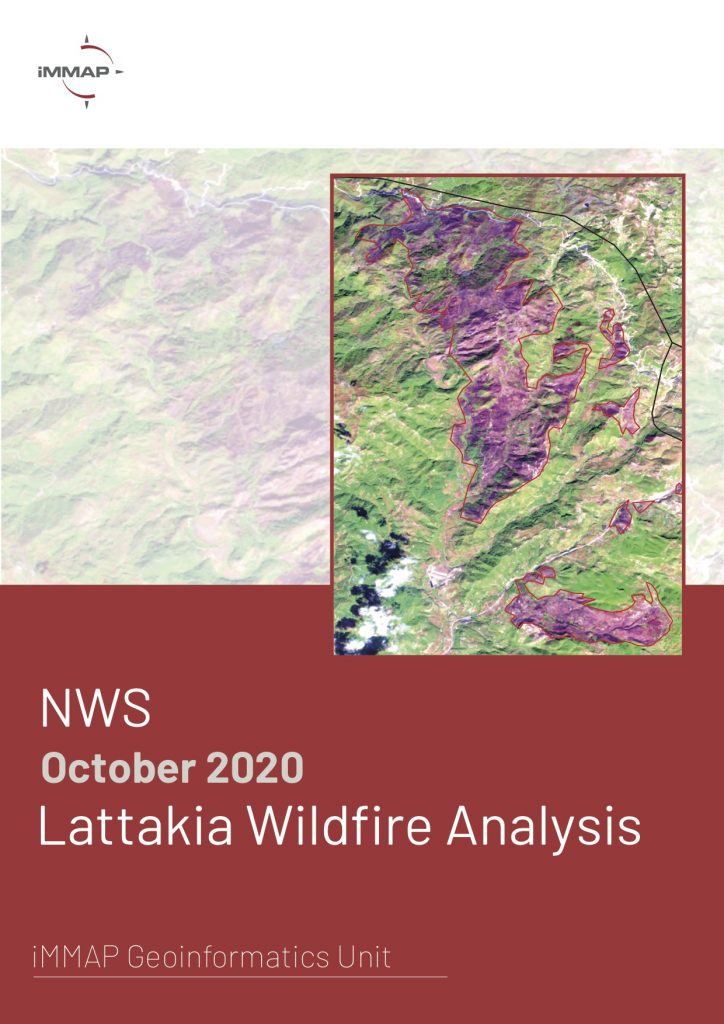
Lattakia Wildfire Analysis
A comprehensive geospatial analysis of the wildfires that enveloped the Syrian governorate of Lattakia during the months of September and October 2020.
Read more
Recorded Explosive Ordnance Risk Education (EORE) Activities in Iraq - DMA ( 1 January - 27 August 2020)
Progress and reach of Explosive Ordnance Risk Education (EORE) activities in Iraq from January 1 to August 27, 2020
Read more
Recorded Explosive Ordnance (EO) Clearance Activities in Iraq - DMA (1 January - 27 August 2020)
Progress and location of explosive ordnance clearance activities in Iraq, January 1 to August 27, 2020
Read more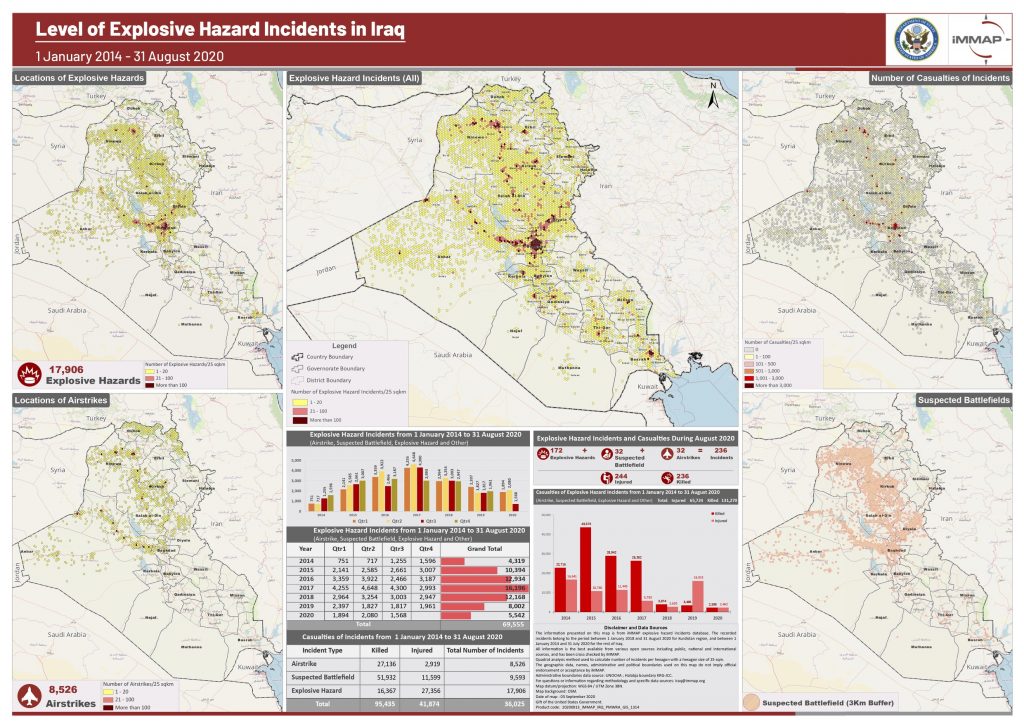
Level of Explosive Hazard Incidents in Iraq ( 1 January 2014 - 31 August 2020)
Summary of explosive hazard incidents in Iraq from January 1, 2014 to August 31, 2020
Read more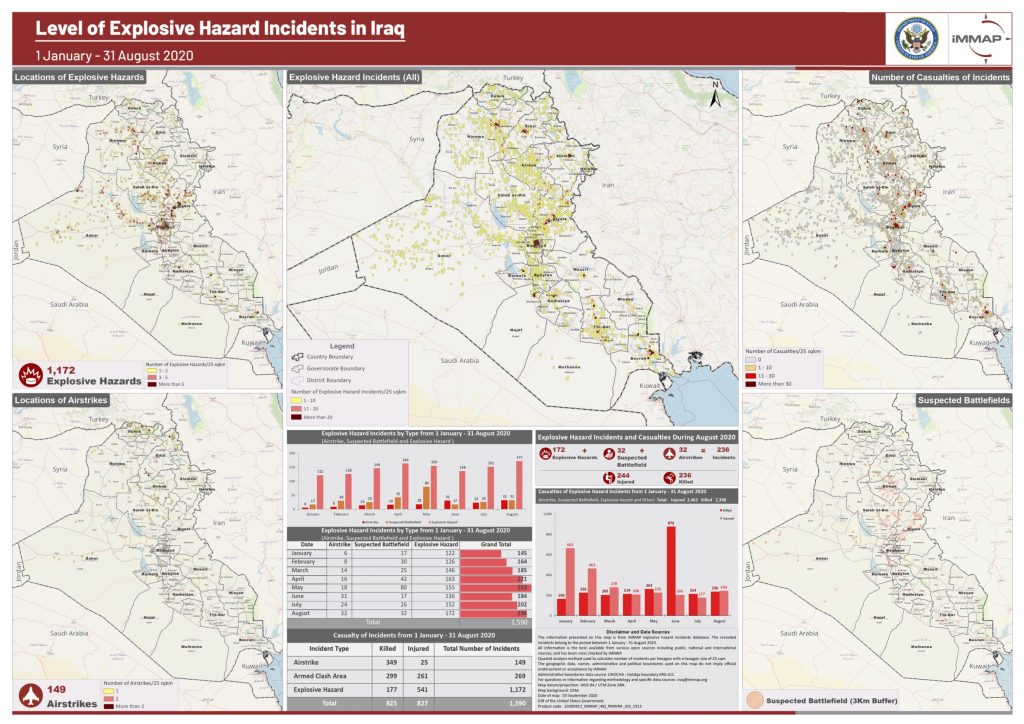
Level of Explosive Hazard Incidents in Iraq (January - August 2020)
Summary of explosive hazard incidents in Iraq from January 1 to August 31, 2020
Read more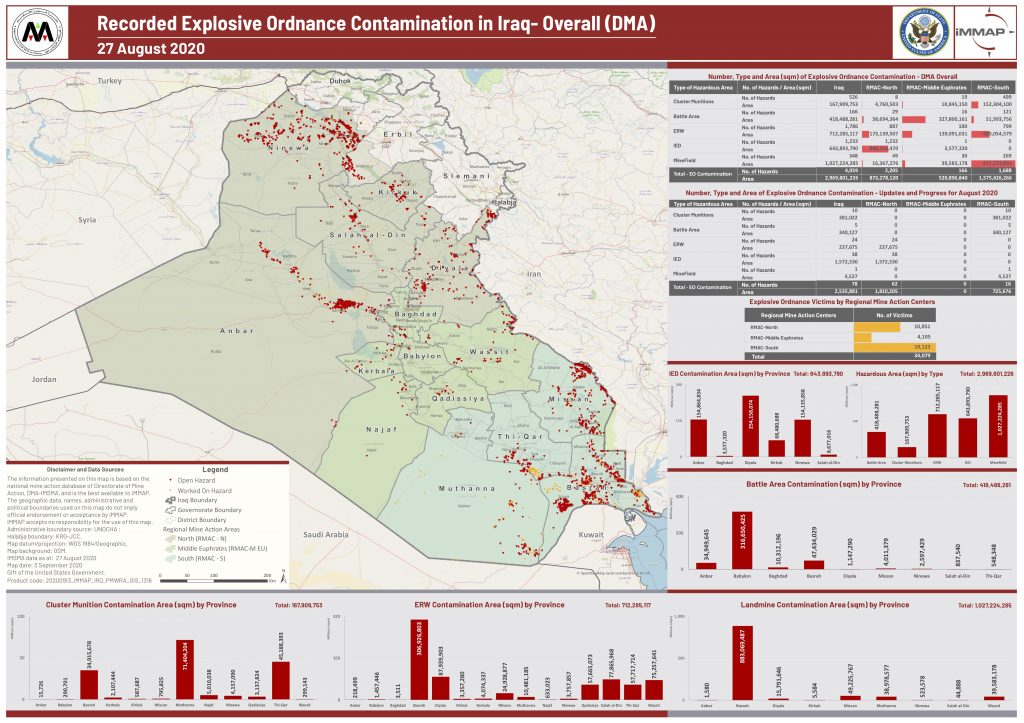
Recorded Explosive Ordnance Contamination in Iraq - DMA - August 2020
Statistical overview and spatial data of explosive ordnance contamination levels in Iraq
Read more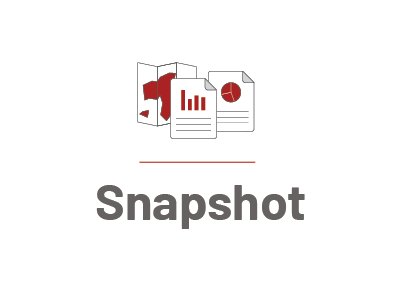
COVID-19 Situation Analysis
COVID-19 Situation Analysis in Syria, Burkina Faso, Nigeria, DRC, Colombia, and Bangladesh
Read more
Level of Explosive Hazard Incidents in Iraq
Summary of explosive hazard incidents in Iraq from January to July 2020
Read more
Recorded Explosive Ordnance Risk Education (EORE) Activities in Iraq - DMA
Progress and reach of Explosive Ordnance Risk Education (EORE) activities in Iraq from January to August 2020
Read more
Recorded Explosive Ordnance (EO) Clearance Activities in Iraq - DMA
Progress and location of explosive ordnance clearance activities in Iraq, Jan – July 2020
Read more
Recorded Explosive Ordnance Contamination in Iraq - DMA
Statistical overview and spatial data of the explosive ordnance contamination levels in Iraq
Read more
Level of Explosive Hazard Incidents in Iraq
Summary of explosive hazard incidents in Iraq from January 2014 to July 2020
Read more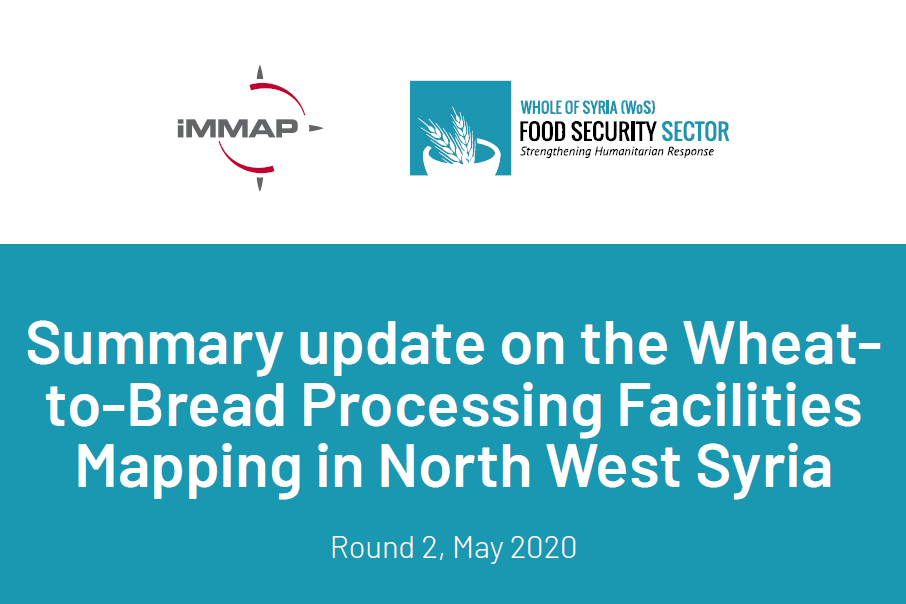
Summary Update on the Wheat-to-Bread Processing Facilities Mapping in Northwest Syria
A brief, but educative follow-up report on the state of wheat-to-bread processing facilities in the northwestern Syria governorates of Aleppo and Idleb.
Read more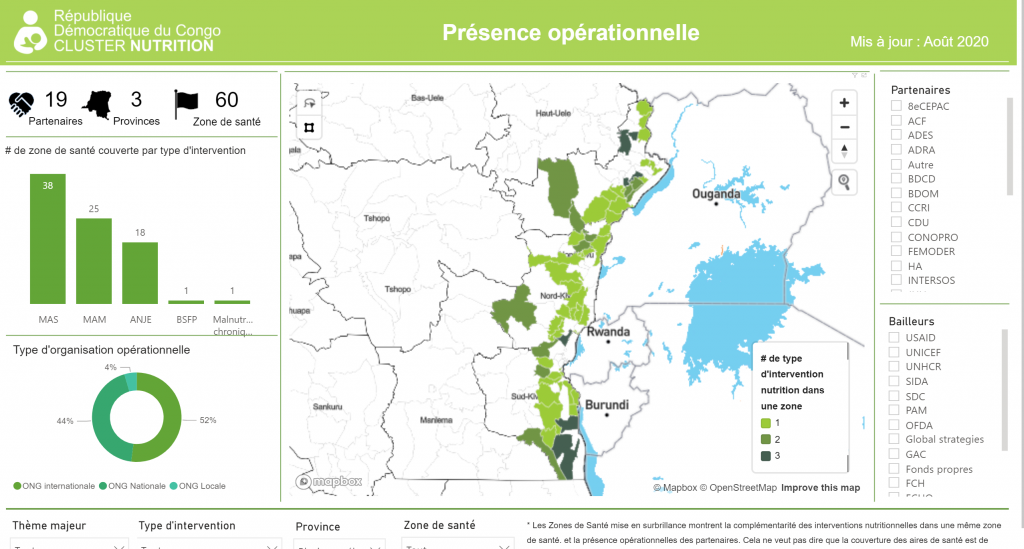
DRC Nutrition Sub Cluster 4W: Operational Presence and Activities in Eastern DRC
iMMAP helped to inform partners about activities in North Kivu province through the POWER BI developed by the DRC Nutrition Cluster
Read more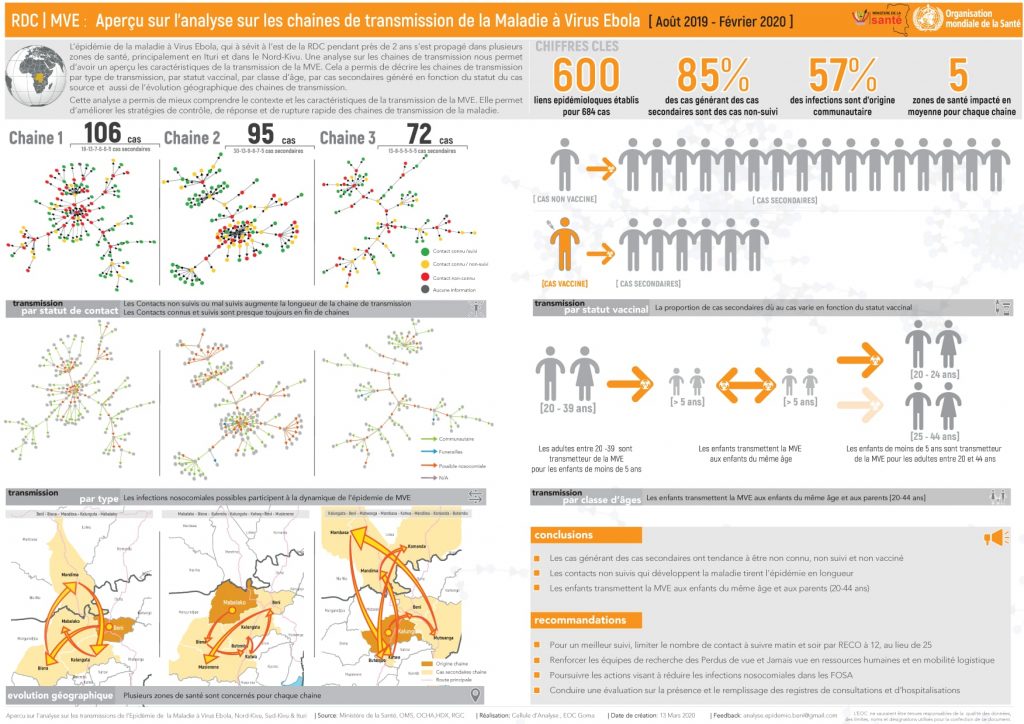
DRC: Ebola Virus Disease Chains of Transmission Poster
EVD Chains of Transmission Poster: August 2019 - February 2020
Read more
DRC: Ebola Virus Disease Chains of Transmission
EVD Contact Tracing: August 2019 - February 2020
Read more

COVID-19 Multi-Sectoral Country Plan - District Coverage Overview
(April, May and June 2020)
Read more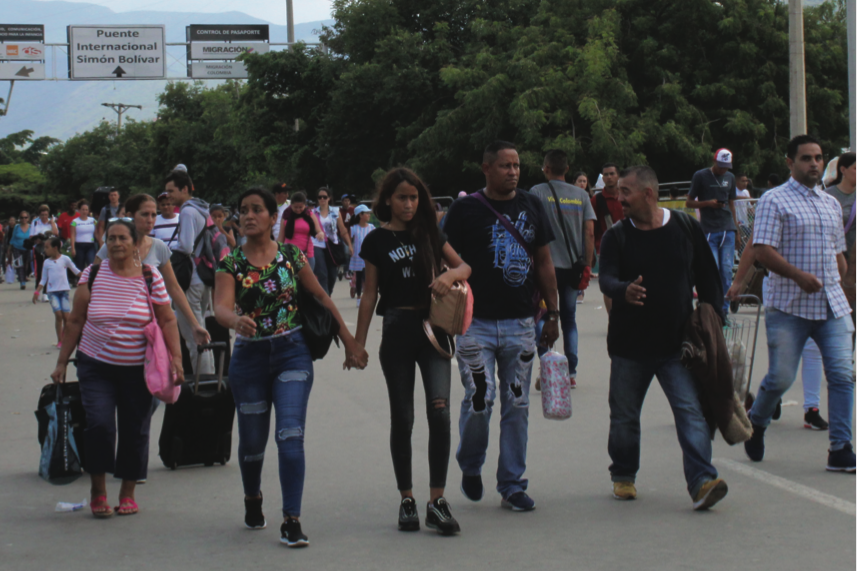
Tracking Venezuelan migrant and refugee populations through Facebook
iMMAP tracks the movement of Venezuelan refugees and migrants around Latin America on a biweekly basis by analyzing Facebook's Marketing API, based on the monthly behavior of users.
Read more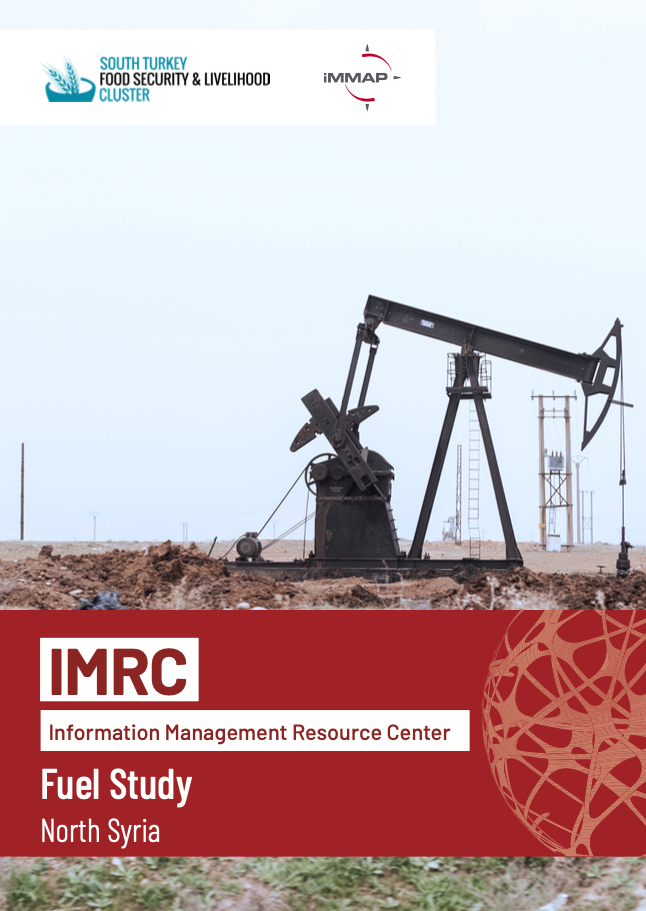
Fuel Study of North Syria
A six-month study designed to enhance the understanding of the fuel market system in northwest Syria, identify local dynamics, the impact of the crisis, and the main coping strategies adopted by various market actors.
Read more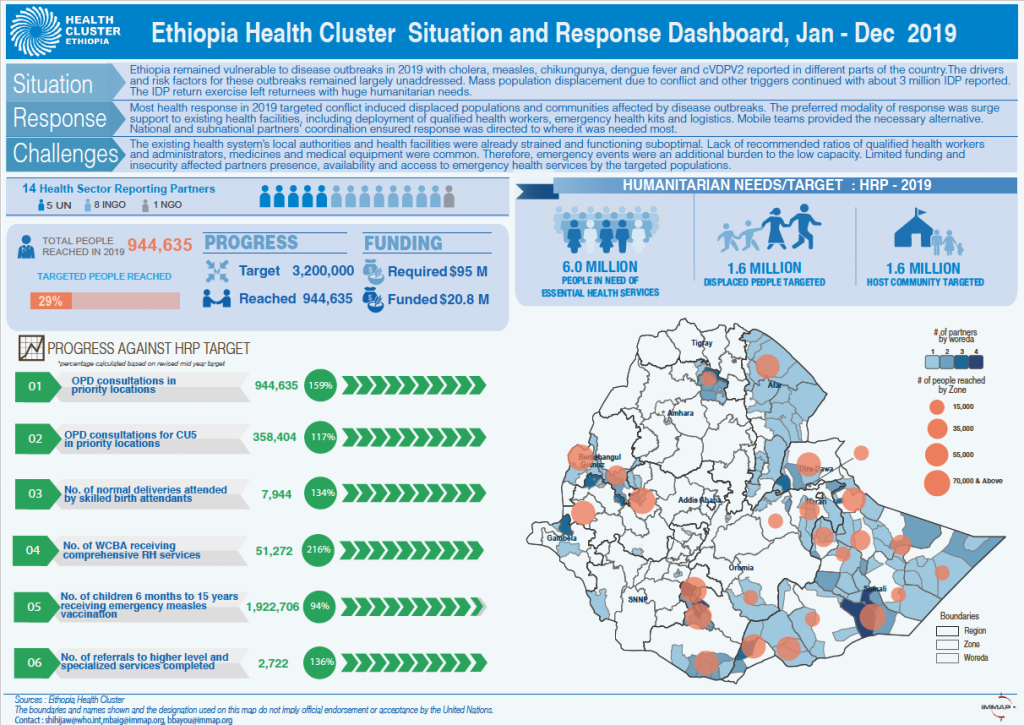
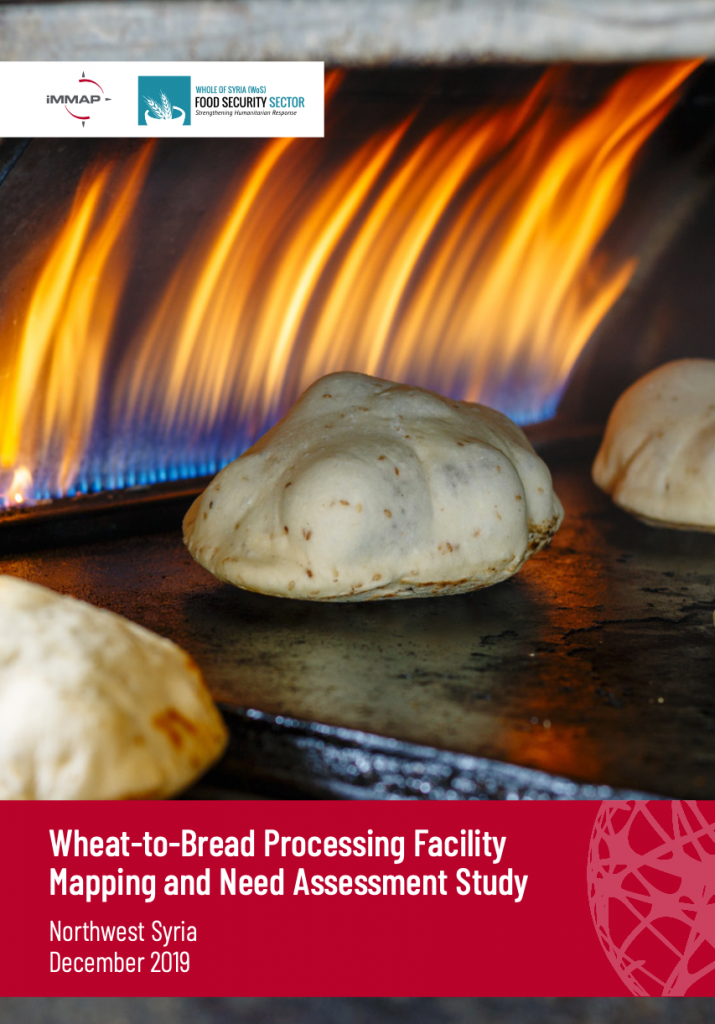
Wheat-to-Bread Value Chain Market System Mapping
Focused on northwest Syria, this study identifies linkages between chain actors in the wheat-to-bread value chain, unearthing bottlenecks, market gaps and opportunities to support bread programs in northwest Syria
Read more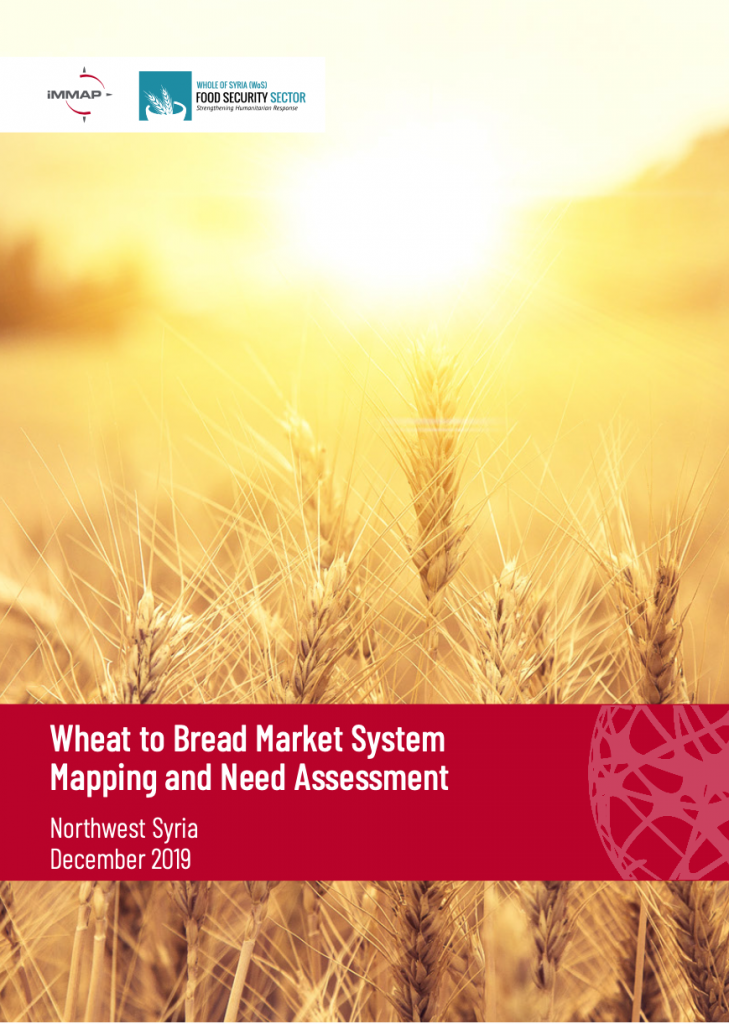
Wheat-to-Bread Facility Mapping and Need Assessment
An in-depth study of the market dynamics and processing facilities in the wheat-flour to bread value chain in the northwestern Syrian cities of Idleb, Hama and Aleppo.
Read more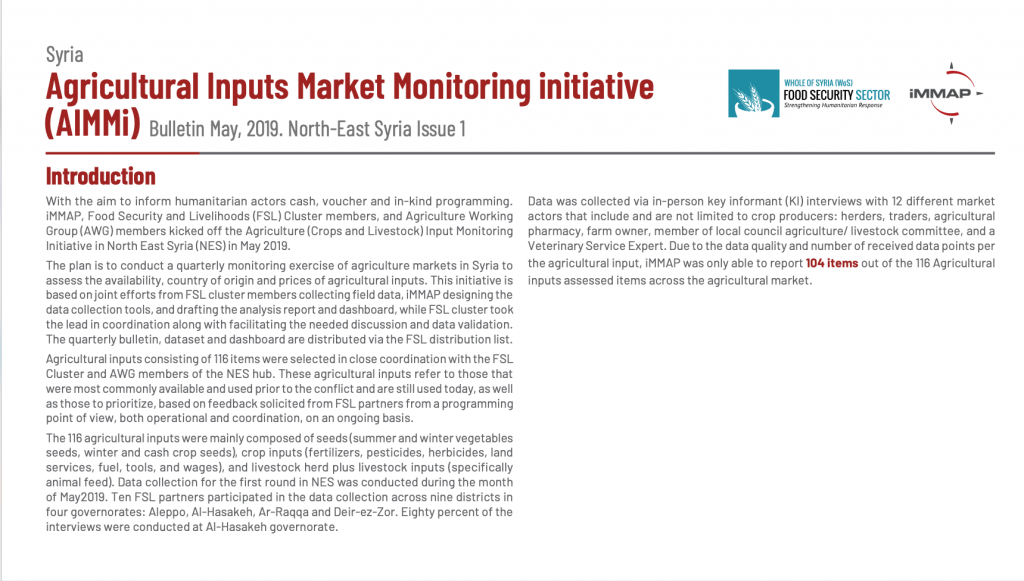
Agricultural Inputs Market Monitoring Initiative Bulletin
The Agricultural Inputs Market Monitoring Initiative (AIMMi) is an assessment of the availability, origin and prices of 104 agricultural resources throughout May 2019 in northeast Syria (NES)
Read more
Stand-by Partnership Programme
Information Management Surge Capacity Support to the United Nations
Read more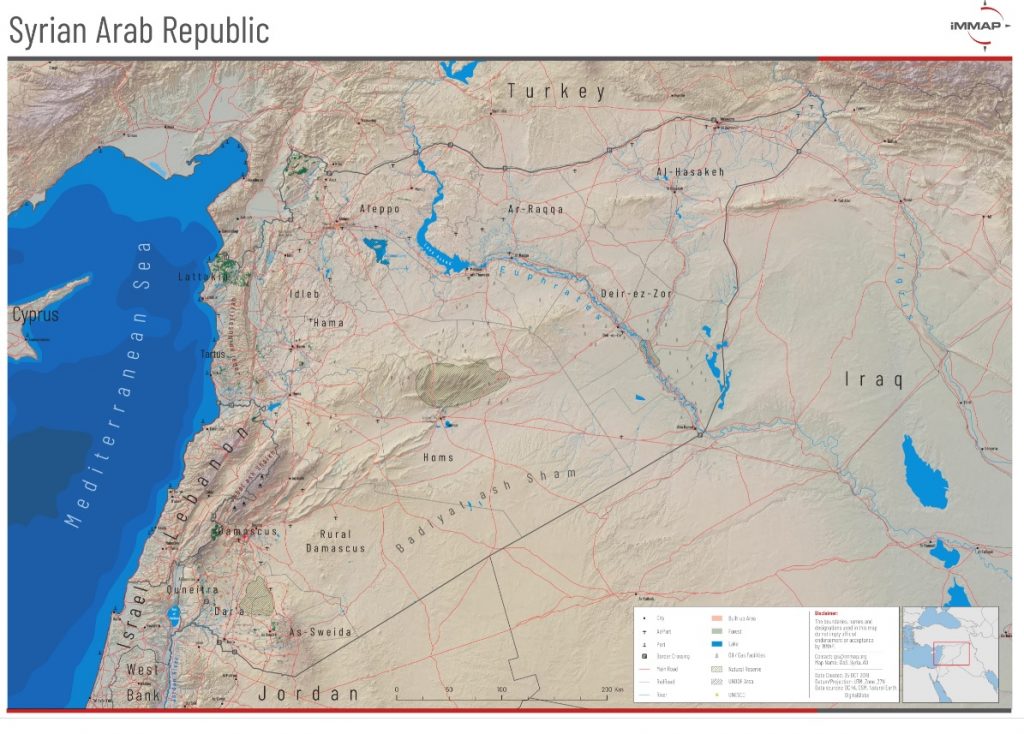
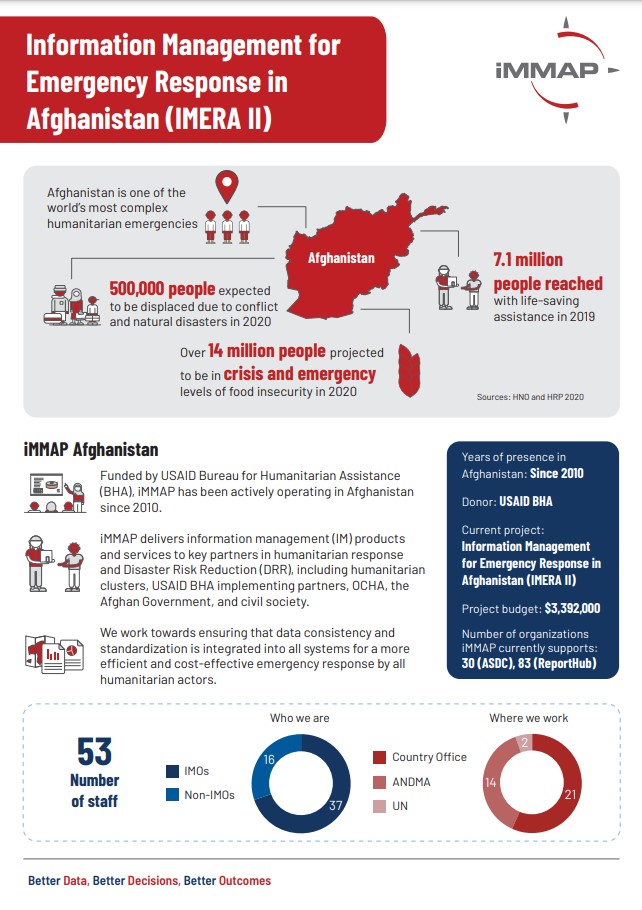
Information Management for Emergency Response in Afghanistan (IMERA II)
Humanitarian Information Management Services in Afghanistan
Read more
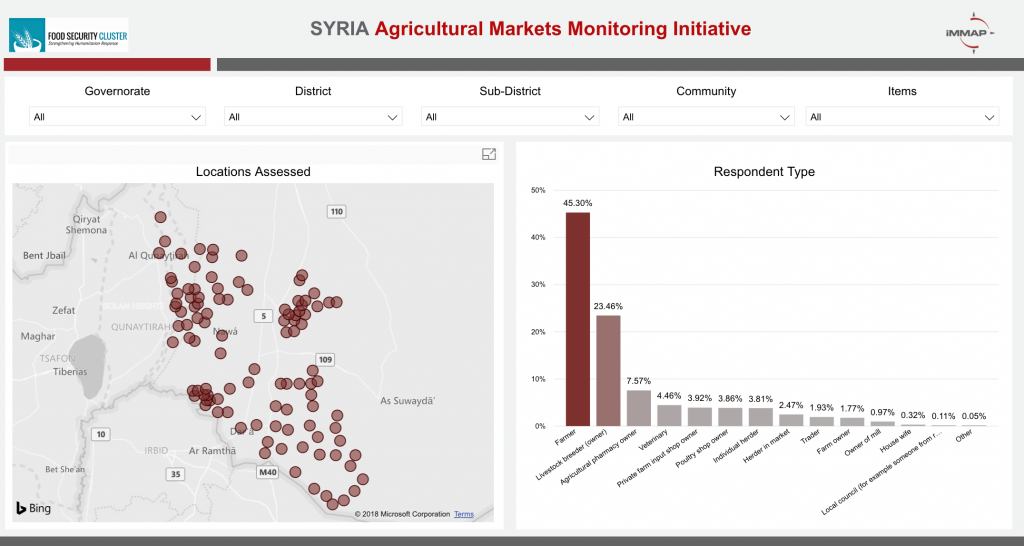
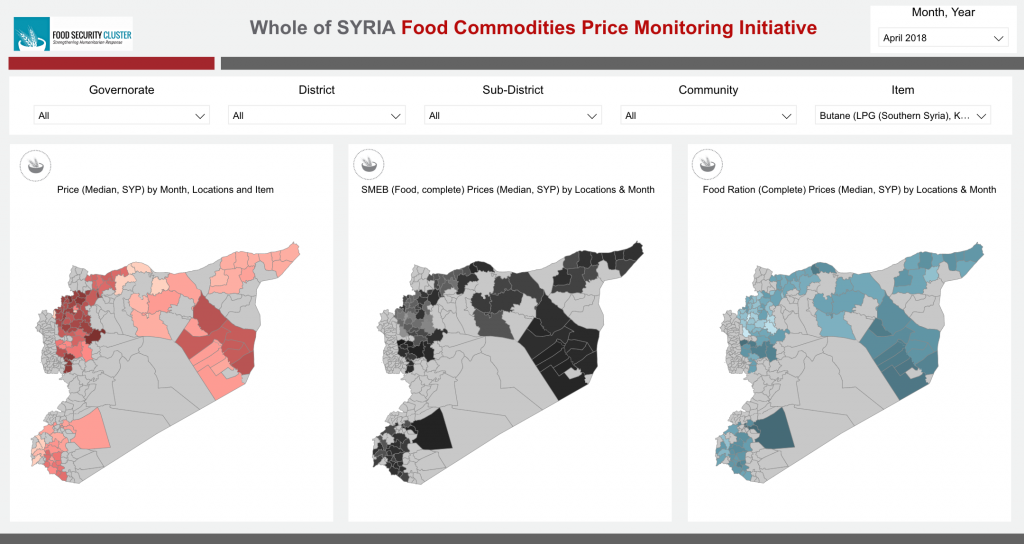
Syria: Whole of Syria Food Commodities Price Monitoring Initiative
Food Commodities Price Monitoring
Read more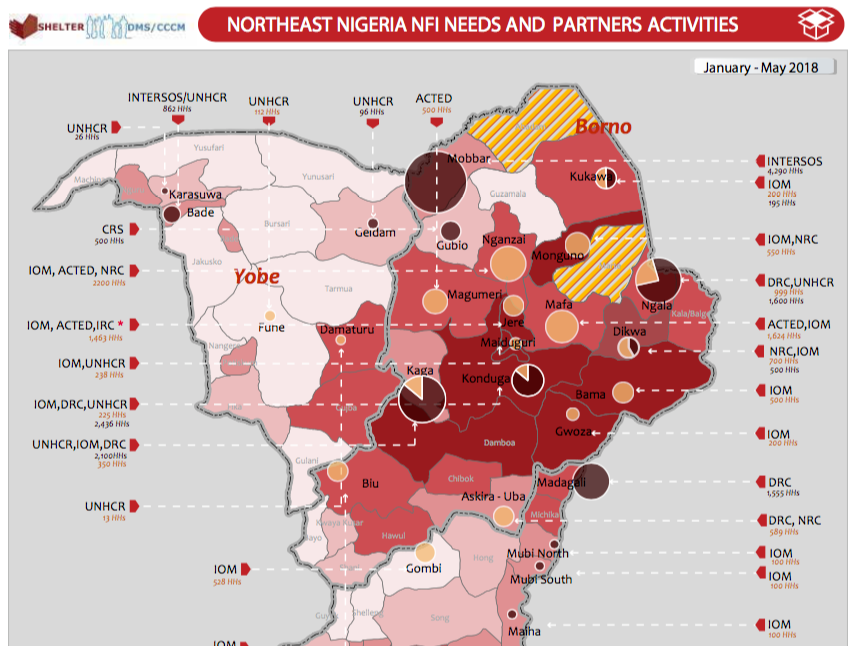
Nigeria: Shelter, CCCM, NFI Gaps Analysis and Partner Activities
Shelter, CCCM, NFI Gaps Analysis
Read more
Nigeria: Shelter, CCCM, NFI Factsheet HRP Monitoring Dashboard
Shelter, CCCM, NFI Factsheet
Read more
Nigeria: Shelter, CCCM, NFI Gaps and Partners Operational Presence - May 2018
Shelter, CCCM, NFI Gaps and Operational Presence
Read more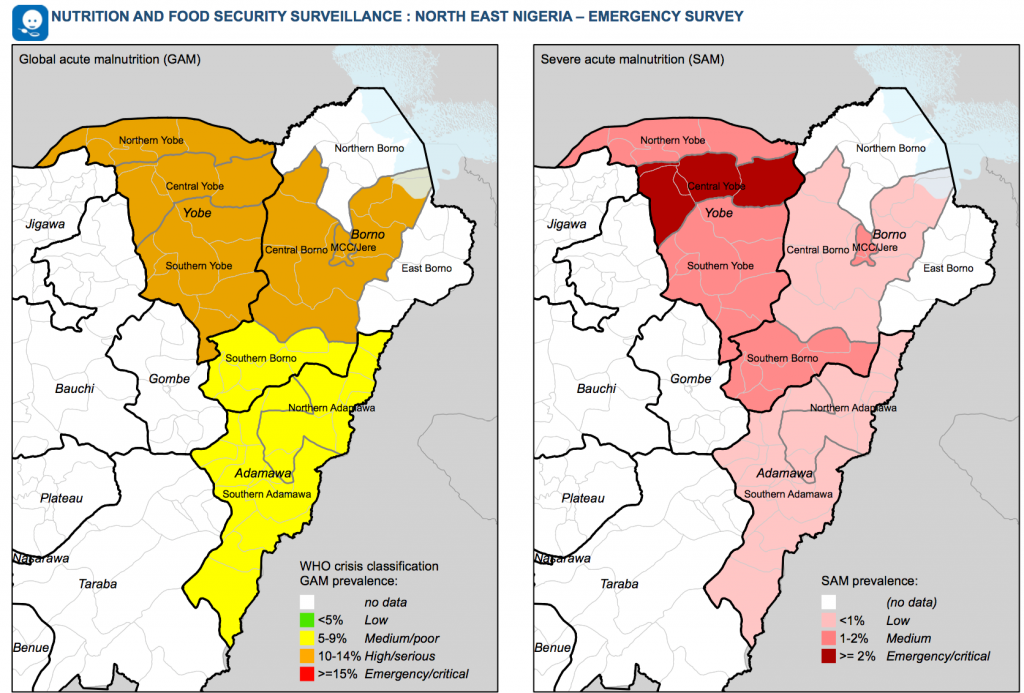
Nigeria: Nutrition and Food Security Surveillance Analysis Emergency Survey - July 2018
Nutrition and Food Security Emergency Survey
Read more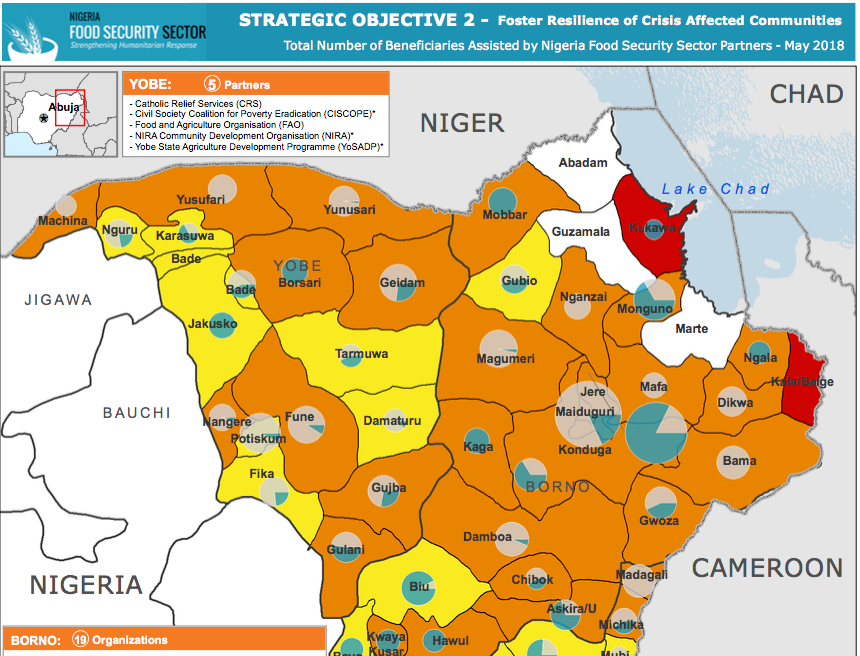
Nigeria: Food Security Sector Gap Analysis Dashboard - May 2018
Food Security Sector Gap Analysis
Read more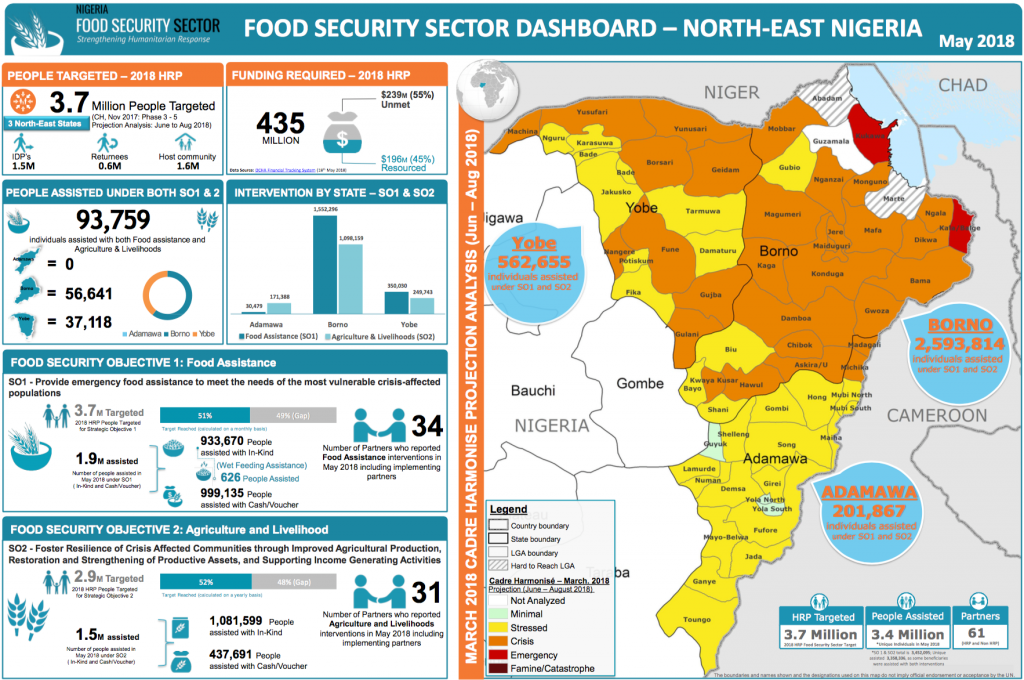
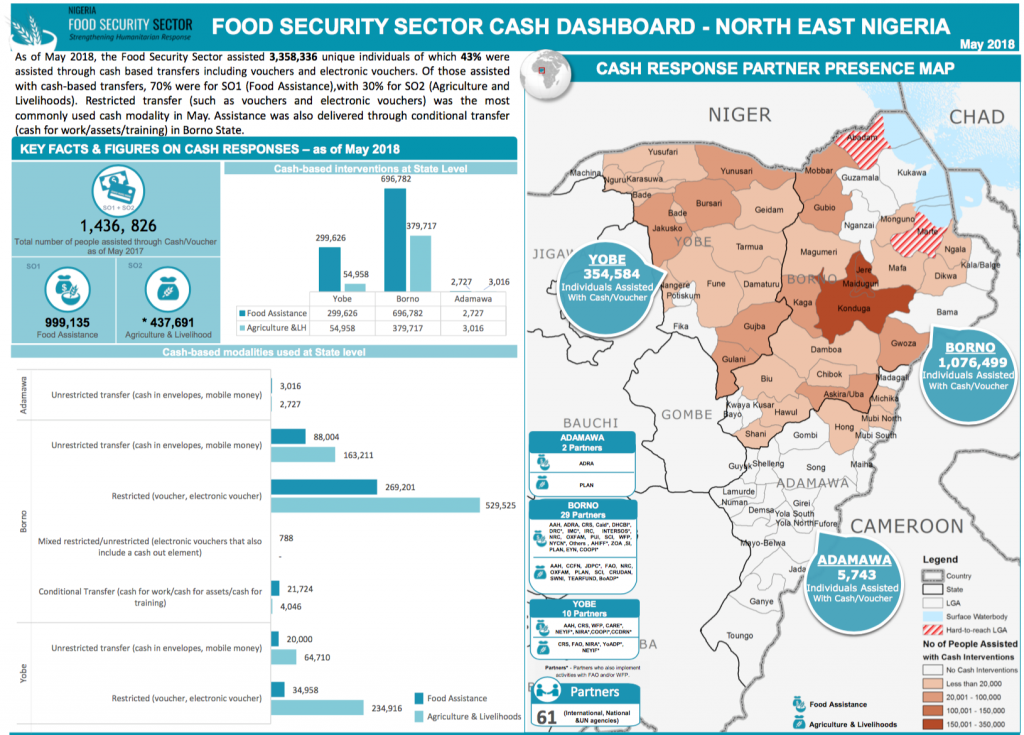
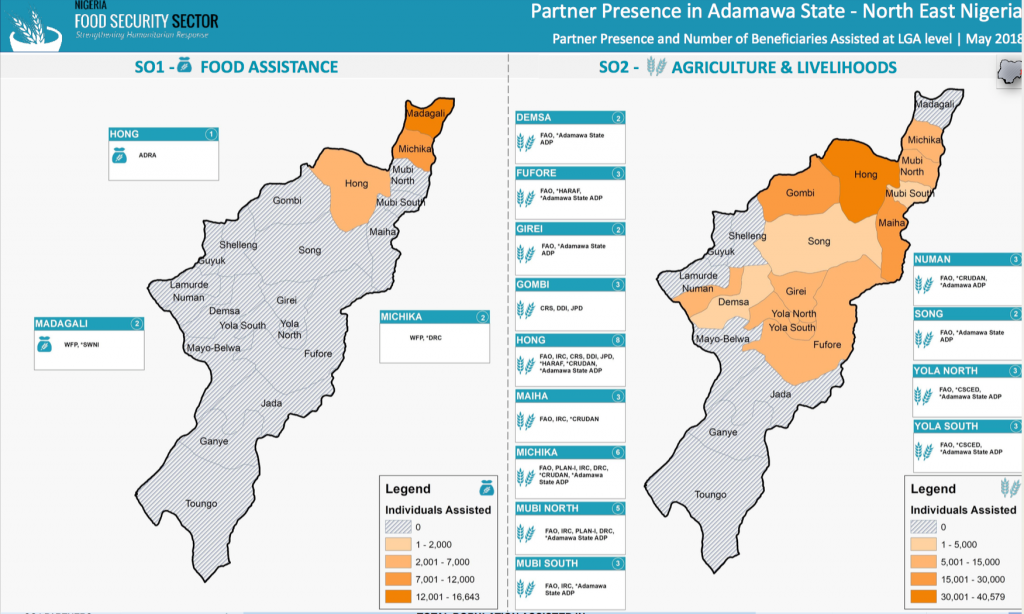
Nigeria: Food Security Partners Operational Presence in Adamawa State-June 2018
Food Security Partners Operational Presence
Read more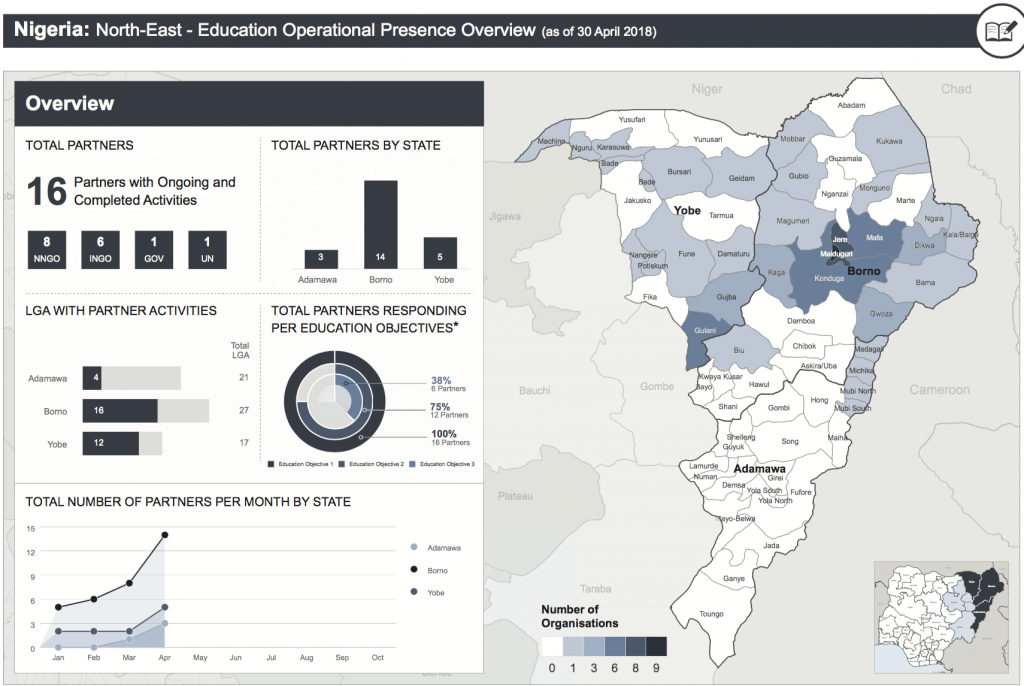
Nigeria: Northeast, Education Partners Operational Presence - April 2018
Education Partners Operational Presence
Read more
Nigeria: Child Protection Subsector Borno State Operational Presence Map - May 2018
Child Protection Subsector Operational Presence
Read more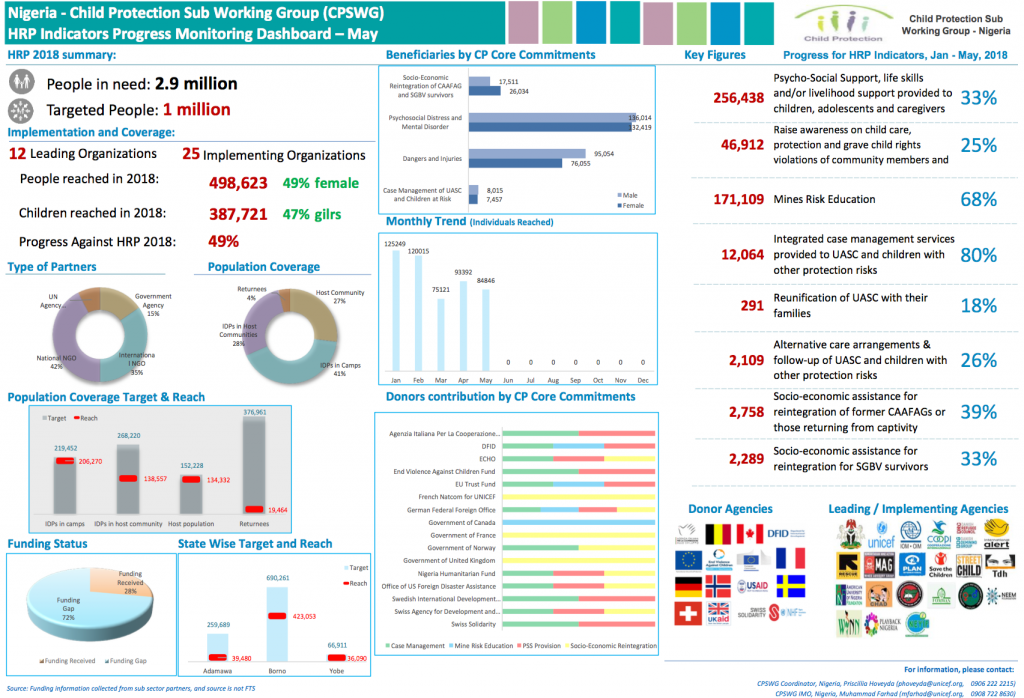
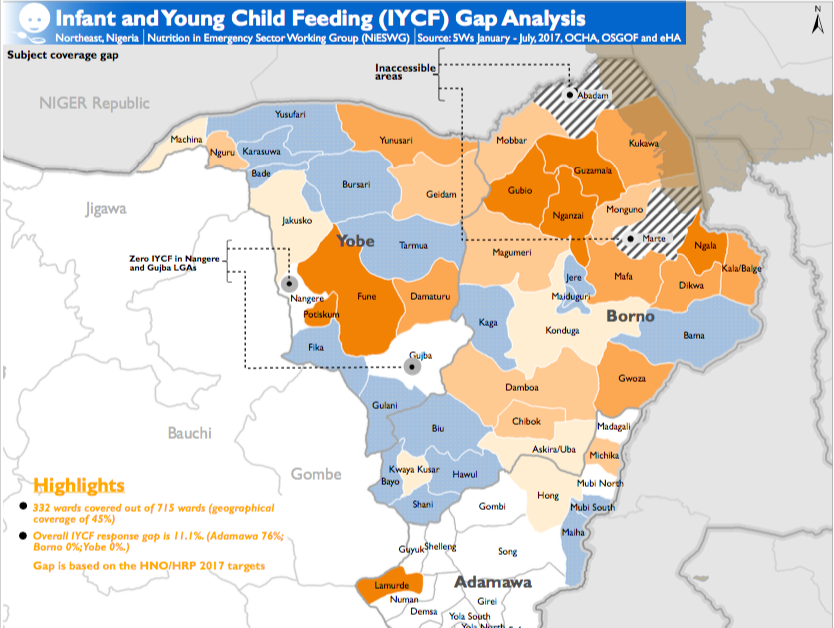
Nigeria: Nutrition Infant and Young Children Feeding Gap Analysis -July 2017
Nutrition Gap Analysis
Read more
RFSAN: Mean Maximum Temperature Variability Long Term Average
Regional Food Security Analysis Network.
Read more
Afghanistan: Protection Cluster Operational Presence 2018
Afghanistan Protection Cluster 2018.
Read more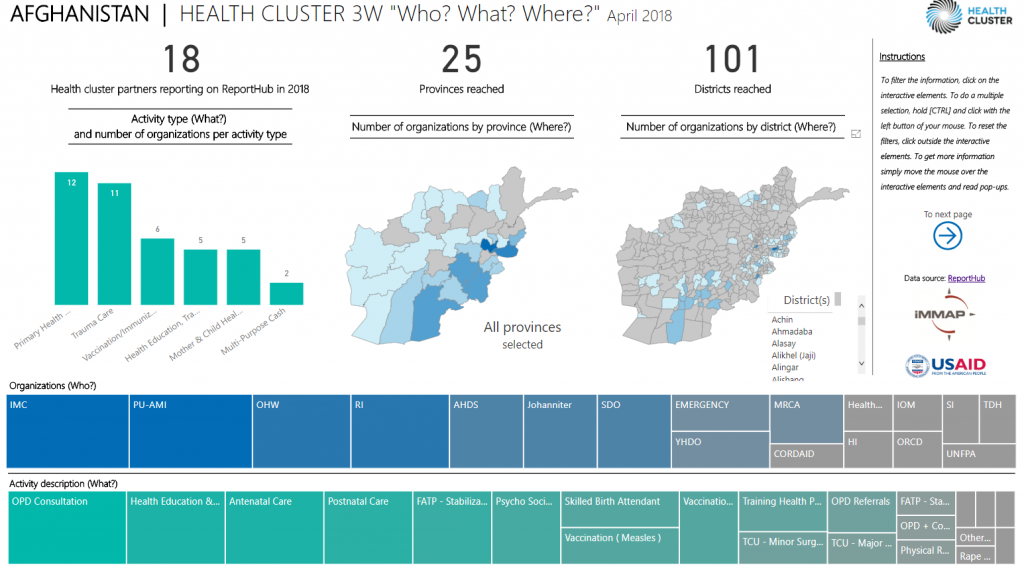
Afghanistan: Health Cluster 3W Dashboard - April 2018
Afghanistan Health Cluster 3W PB Dashboard.
Read more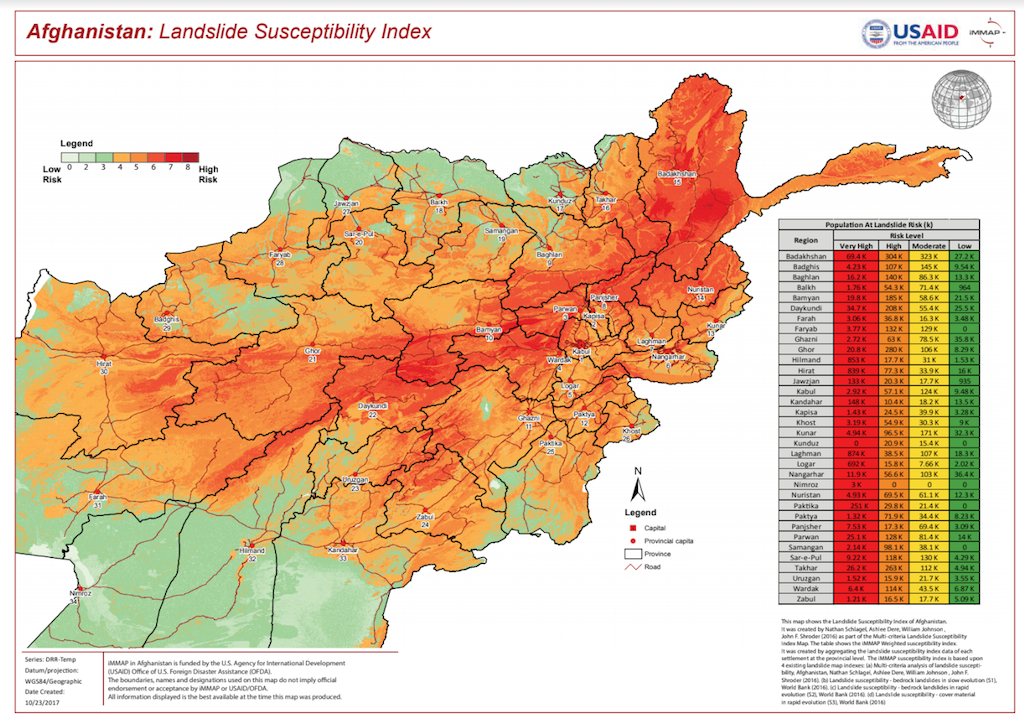
Afghanistan: Landslide Susceptibility Index
Landslide susceptibility in different regions.
Read more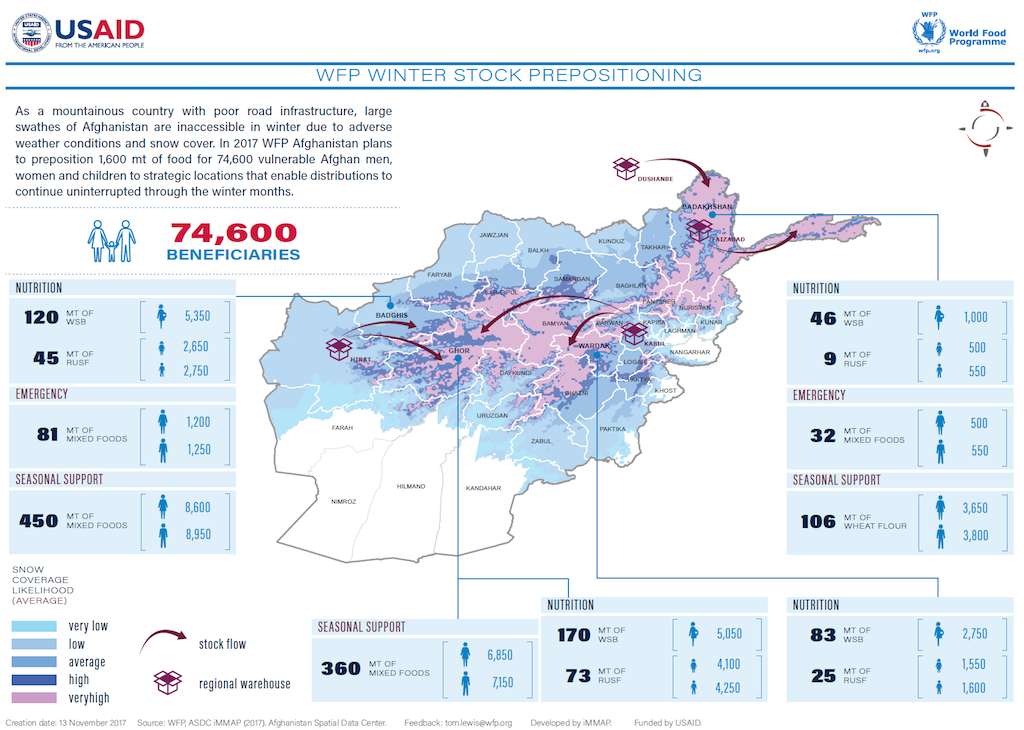
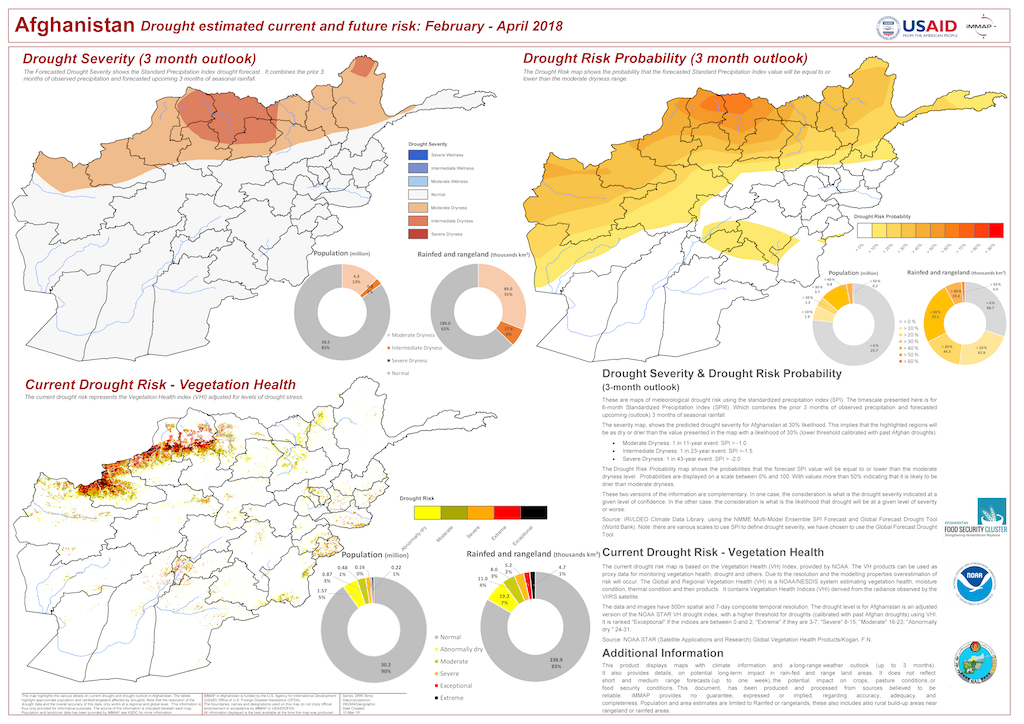

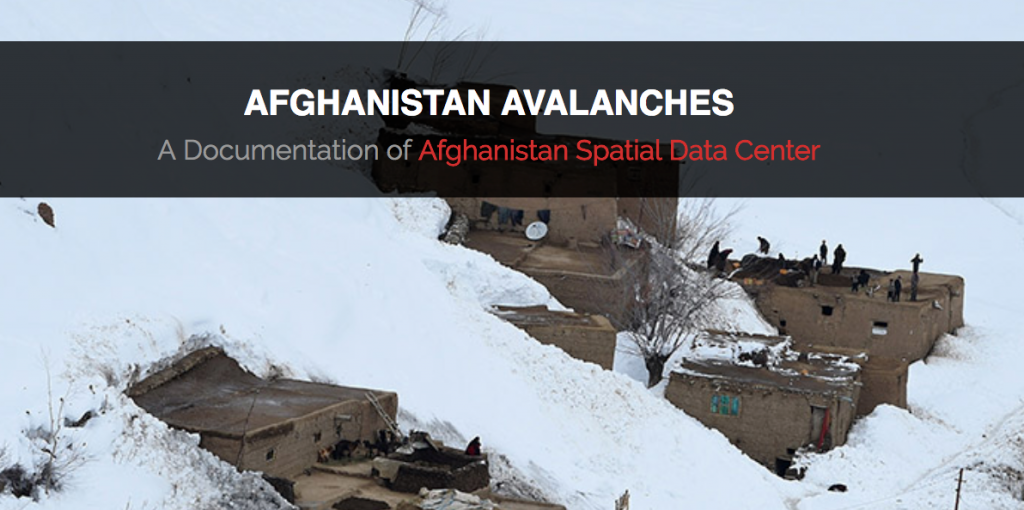

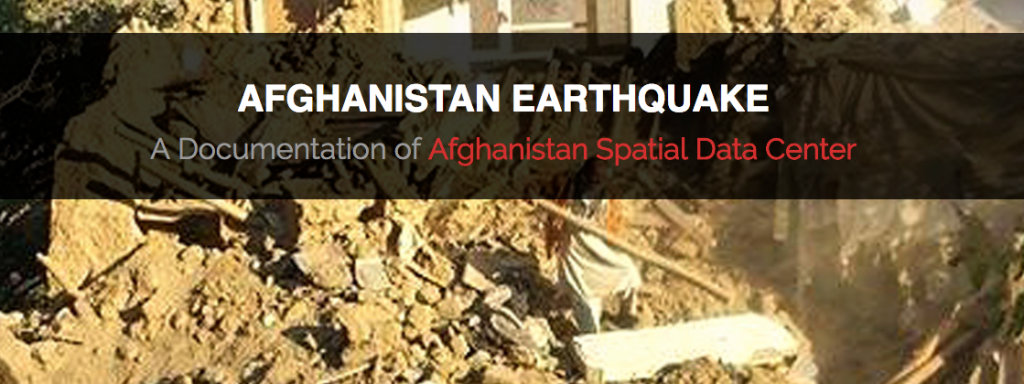
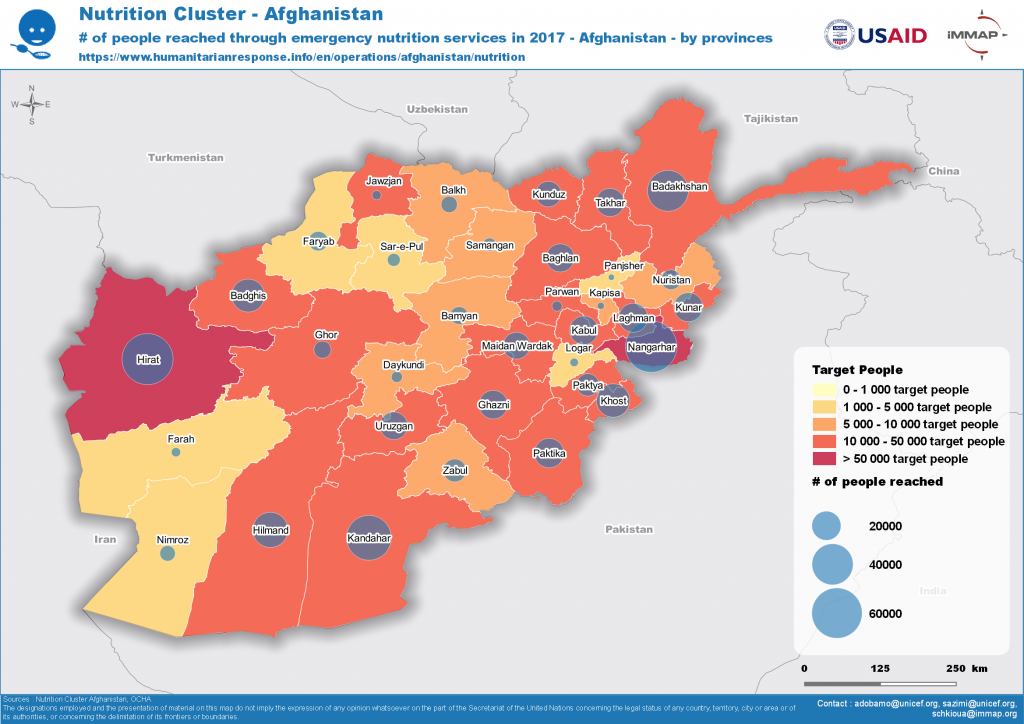
Afghanistan: Nutrition Cluster Emergency Nutrition Services Dashboard - 2017
People reached through emergency nutrition services.
Read more


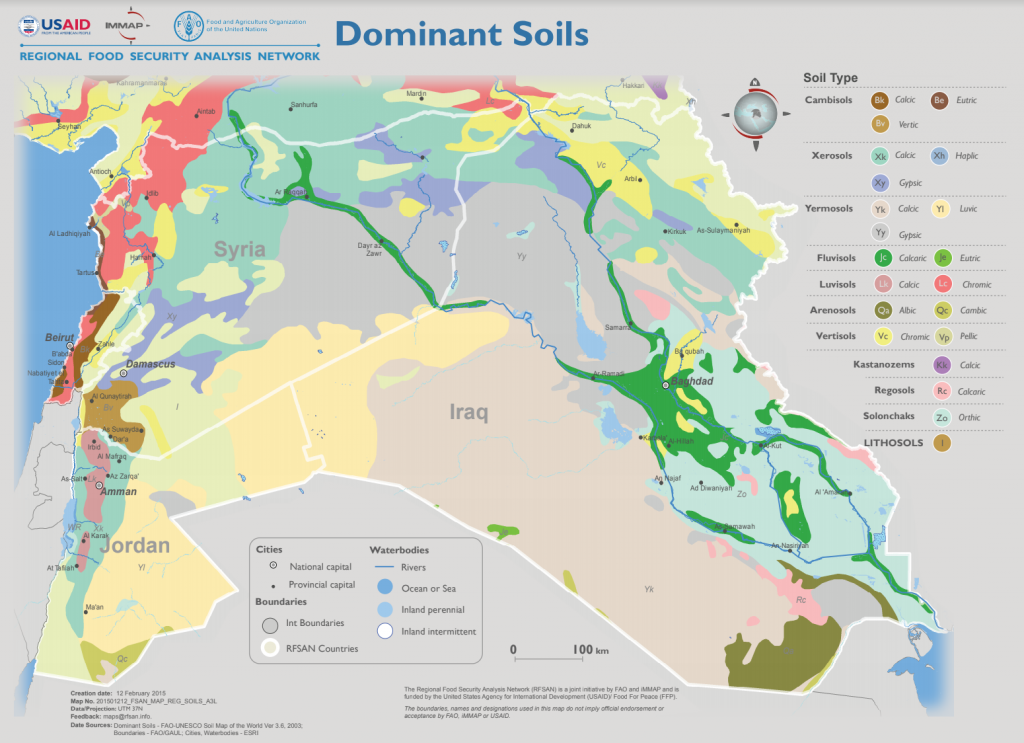


Syria: Regional Food Security Analysis Conflict, Cropland and Food Prices
Security incidents and food prices changes.
Read more
Syria: Regional Food Security Analysis Network, Fires and Cropland in Syria
Fires and Cropland in Syria.
Read more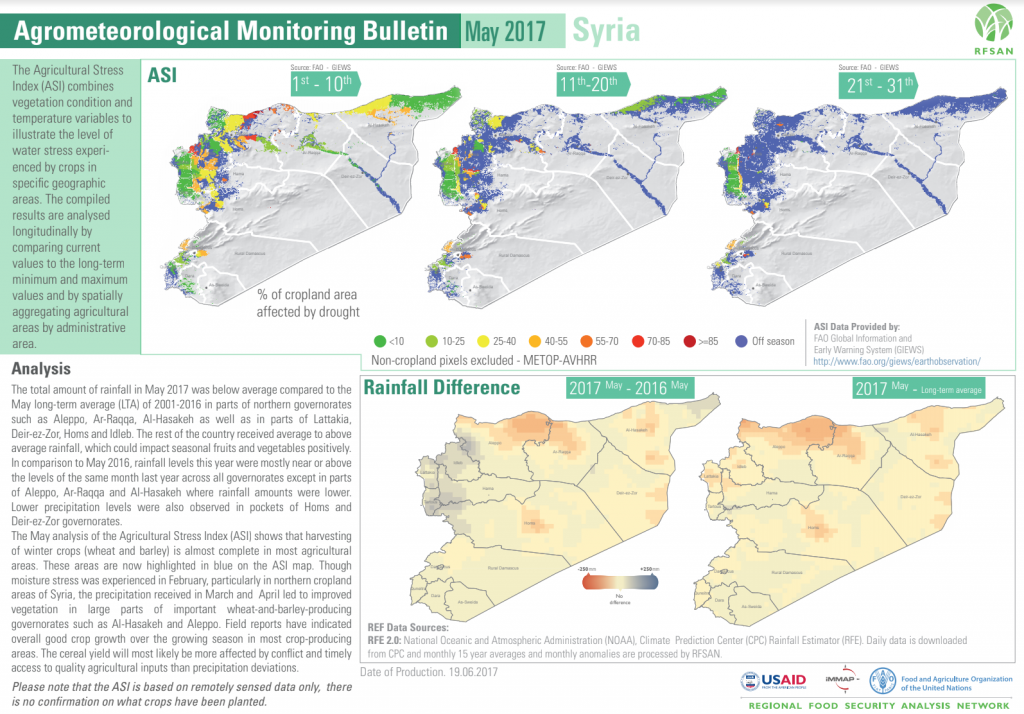
Syria: Agrometeorological Monitoring Bulletin - May 2017
RFSAN Agrometeorological Monitoring Bulletin.
Read more
RFSAN: Rainfall Anomaly in the Middle East - Dec 2016
Rainfall Anomaly in the Middle East Dec 2016
Read more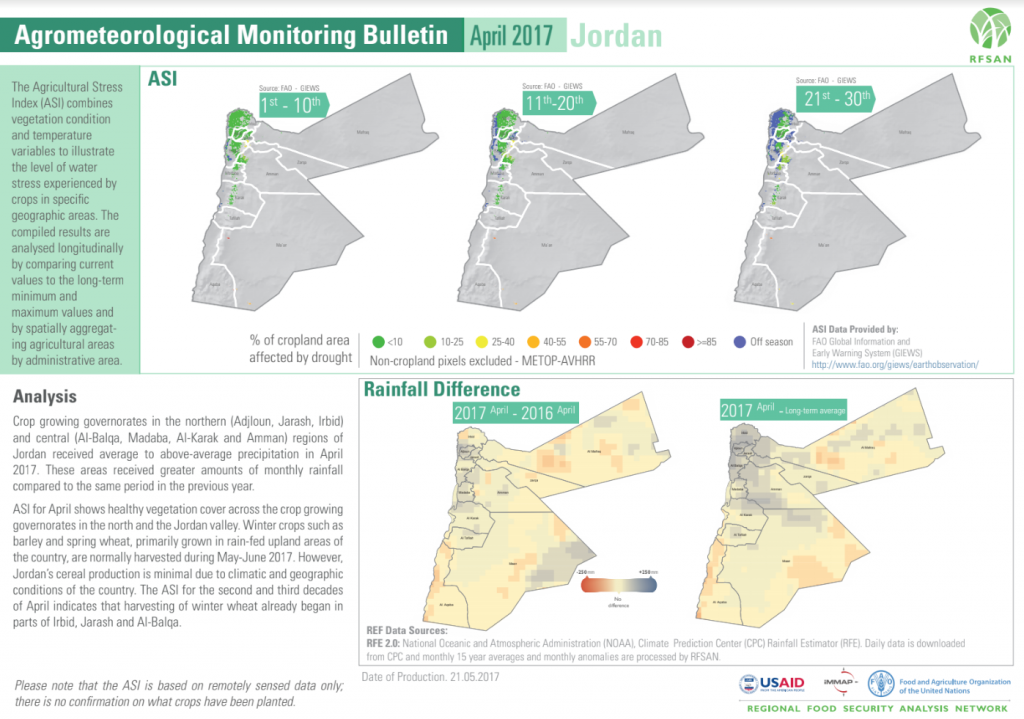
Jordan: Agrometeorological Monitoring Bulletin - April 2017
Agrometeorological Monitoring Bulletin April 2017
Read more
Colombia: Patrón de Desplazamiento Expulsión por Año
Patrón de Desplazamiento Expulsión por Año
Read more
Colombia: Emergencia Invernal en Agricultura. Número de Productores Afectados
Productores afectados.
Read more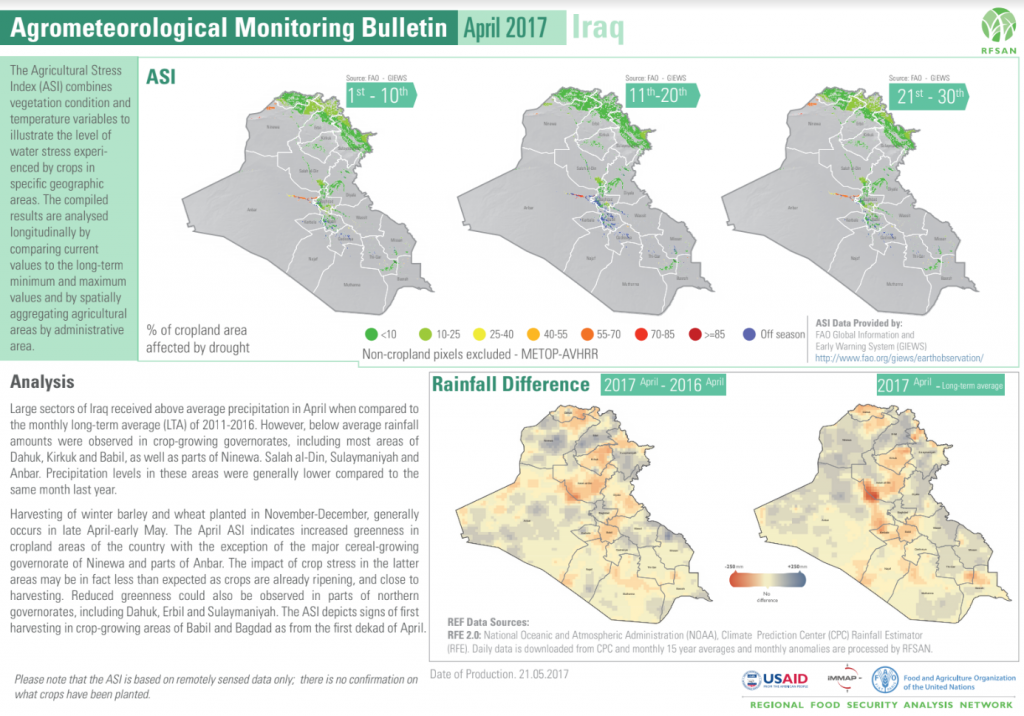
Iraq: Agrometeorological Monitoring Bulletin - April 2017
Regional Food Security Analysis Network.
Read more
Iraq: Agrometeorological Monitoring Bulletin - February 2017
Regional Food Security Analysis Network.
Read more
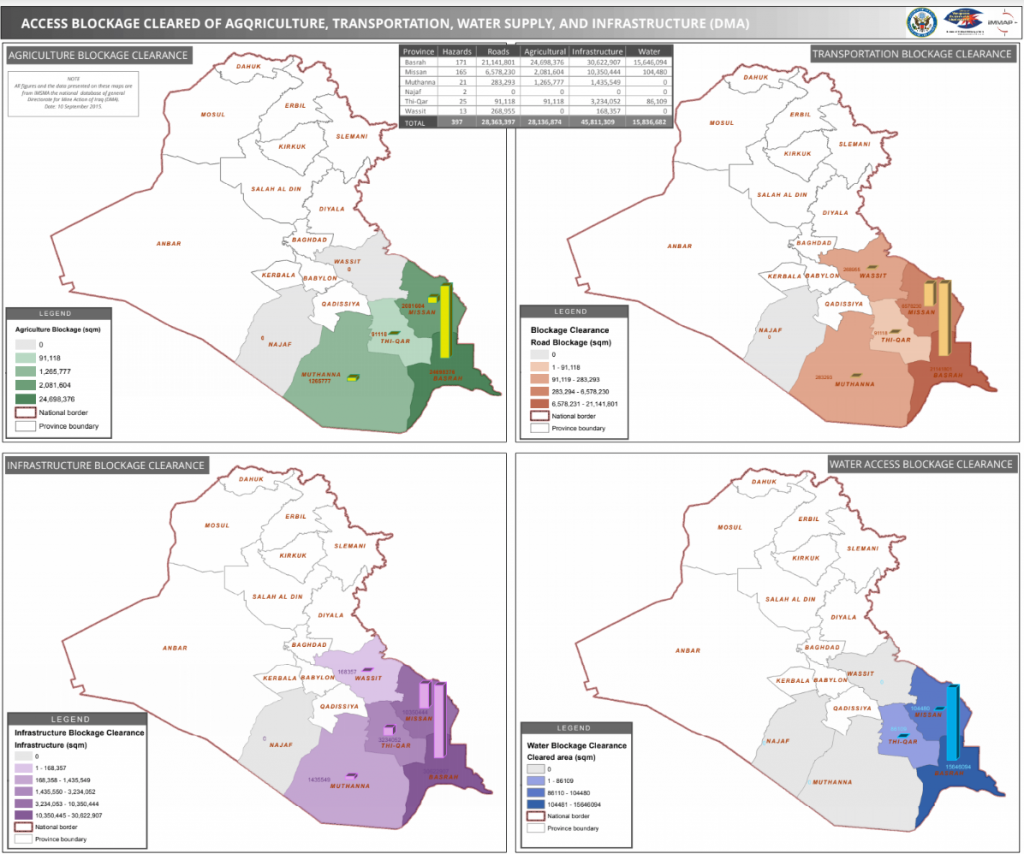
Iraq: Access Blockage Cleared of Agriculture, Transportation, Water Supply, and Infrastructure
Directorate of Mine Action - DMA.
Read more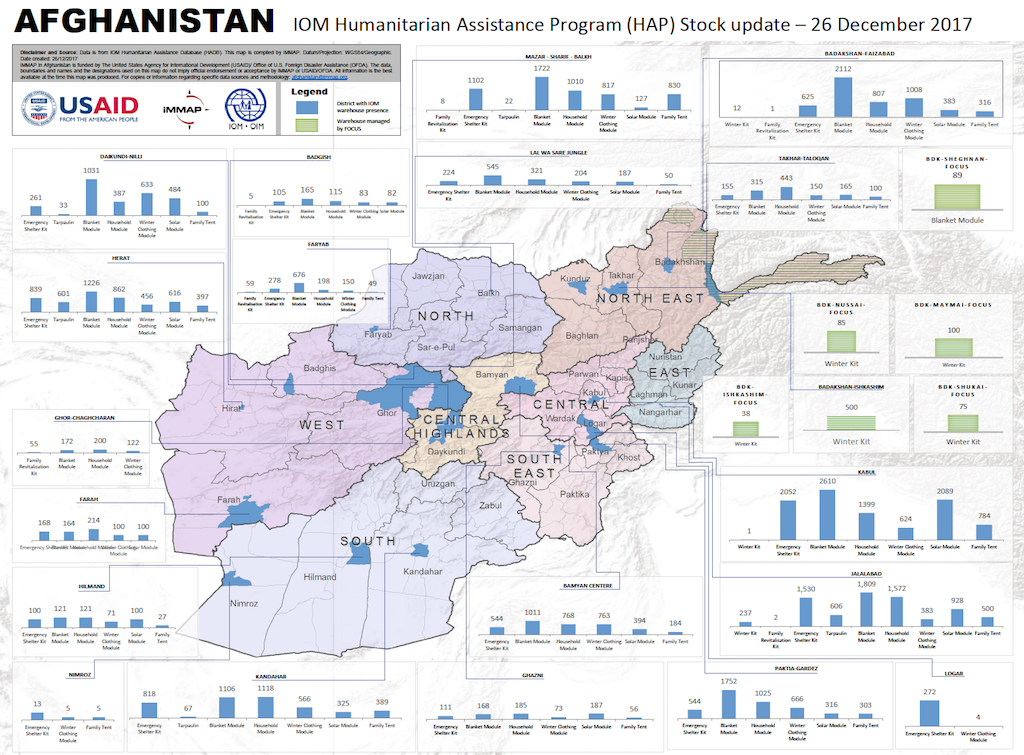
Afghanistan: IOM Humanitarian Assistance Program Stock Update - 26 Dec 2017
IOM Humanitarian Assistance Program -HAP
Read more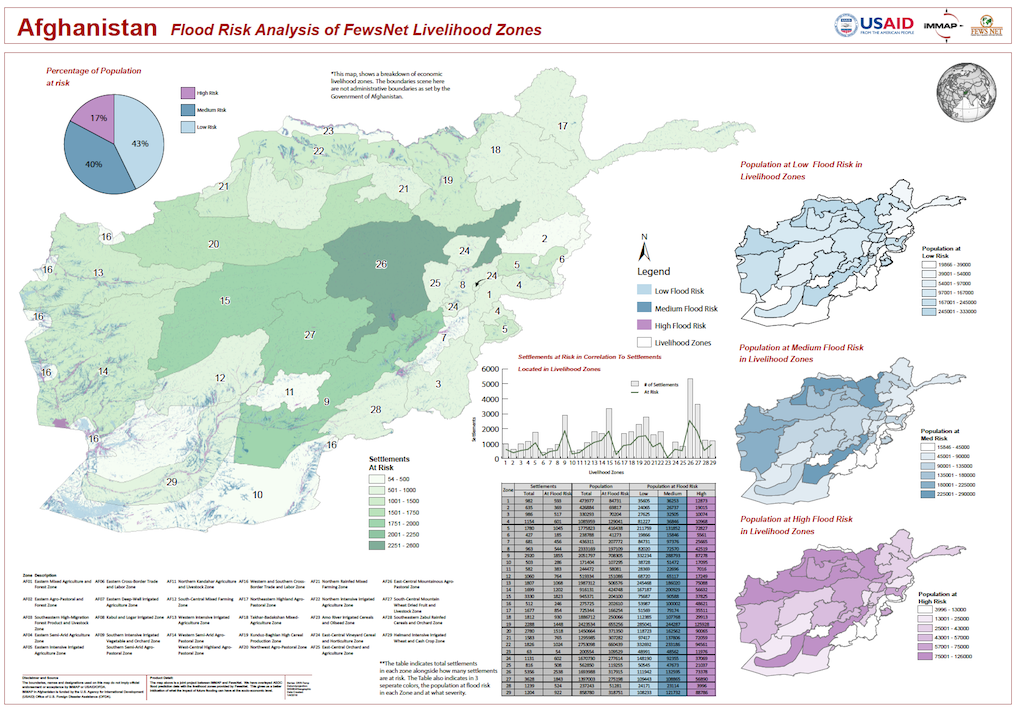
Afghanistan: Flood Risk Analysis of FewsNet Livelihood Zones
Disaster Risk Reduction -DRR.
Read more
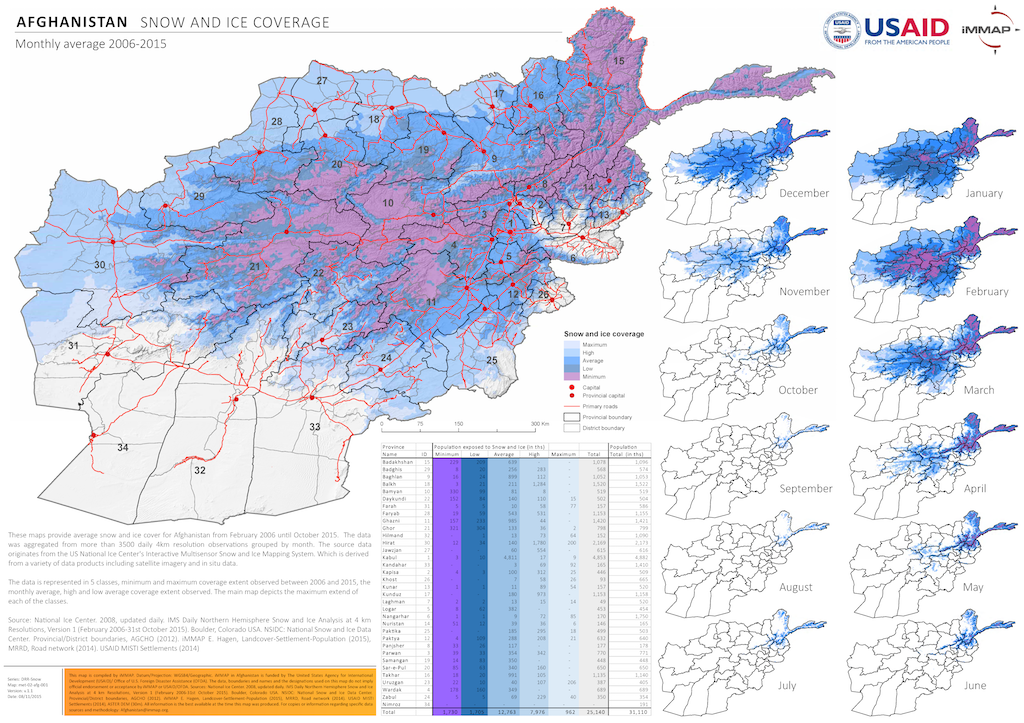
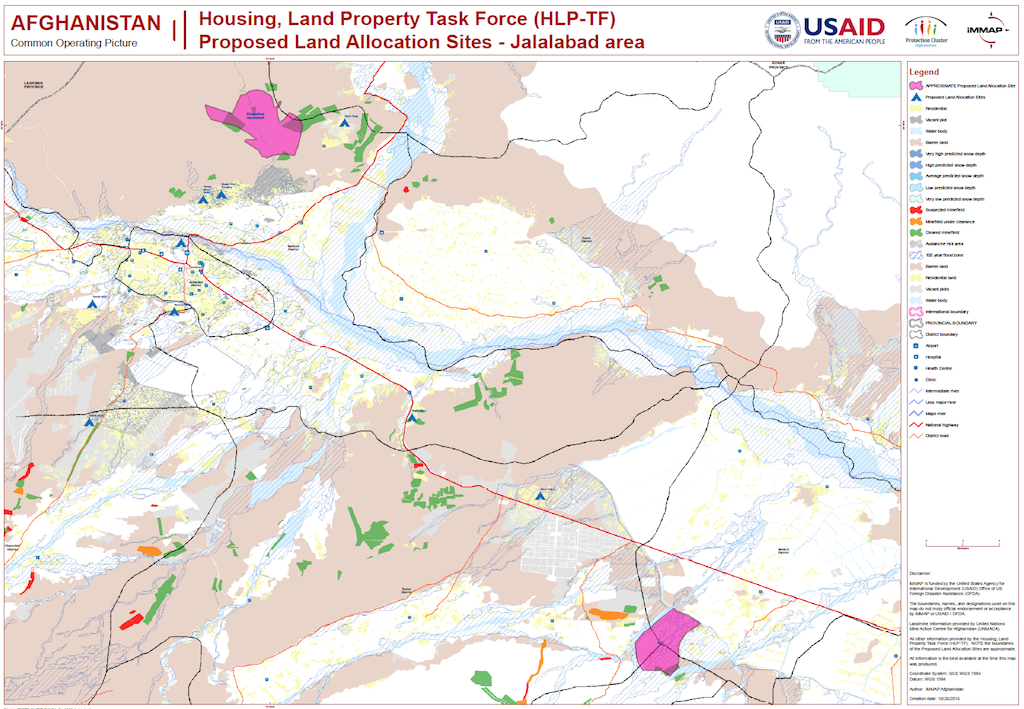
Afghanistan: Housing, Land Property Task Force
Proposed land allocation sites - Jalalabad area.
Read more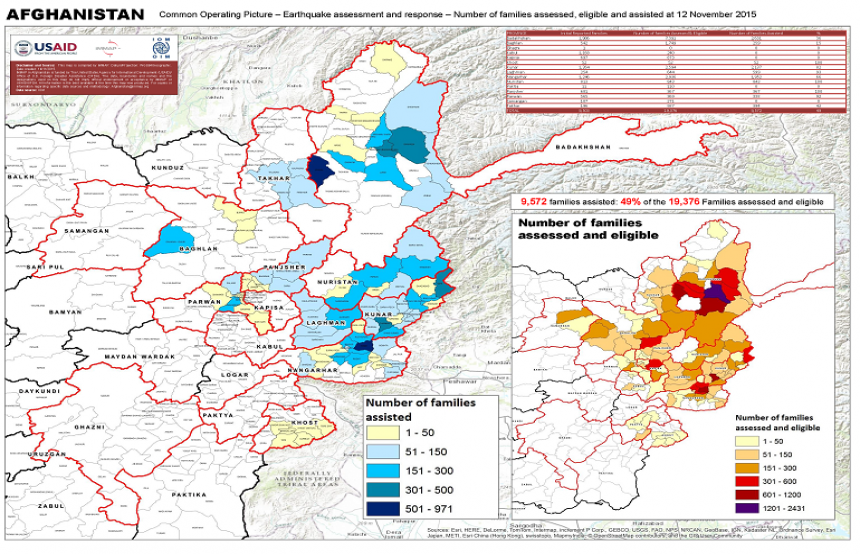
Afghanistan: Common Operating Picture Earthquake Assessment Response
Number of families assessed, eligible, and assisted.
Read more
